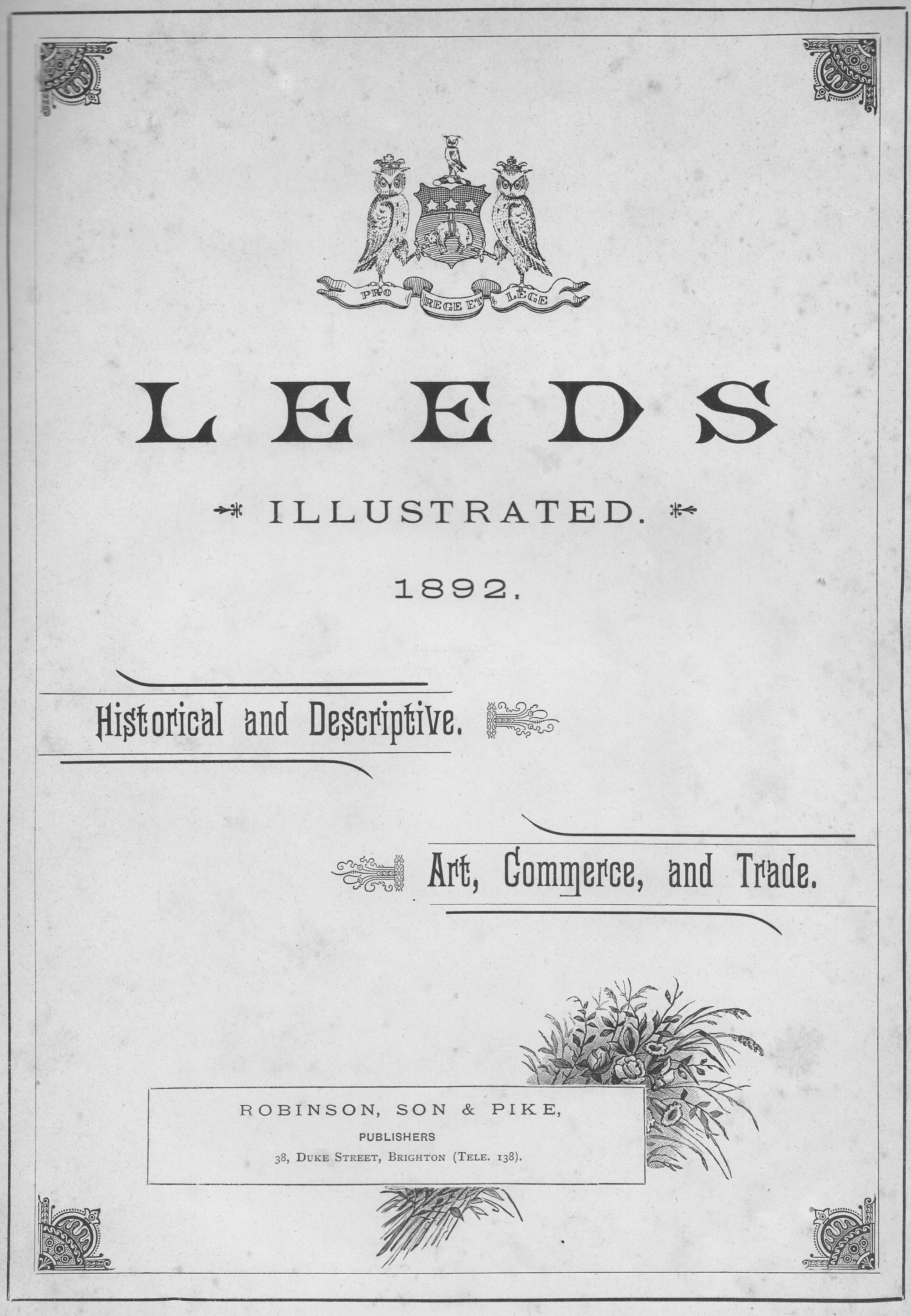
LEEDS ILLUSTRATED.
1892.
Historical and Descriptive.
Art, Commerce, and Trade.
ROBINSON, SON AND PIKE. 38, DUKE STREET, BRIGHTON (TELE. 138)

LEEDS.
THOSE who incline to the doctrine of pre-ordination either as affecting the destinies of men, nations, or cities might find a not uninteresting study in the relative positions occupied to-day by those centres of habitation that flourished and exercised a paramount influence upon their fellows in bygone ages; and vice versa, in the rank those places which now represent the industry and activity of the world, held in the far-off days referred to.
It will be found, we think, as a very general rule, that the leaders of to-day are not those of yesterday, and that those towns and cities round which the halo of the past shines in brightest glory, have now to rely very largely on their old-world reputation for any importance they may at present possess. The cause of this is largely to be found in the fact that the ecclesiastical power has long since ceased to wield any great influence in things temporal. Feudalism also has disappeared from our midst, and whatever traces of these old systems remain, are fast disappearing into the unknown. Their ancient and historic strongholds have naturally shared their fate, and now form mere picturesque landmarks in our national history, while the towns built up by the more enlightened members of later generations have progressed with giant strides, and, if the record of their growth be somewhat unexciting and uneventful from a romantic point of view, it is because they are established on a basis of more solid prosperity, the will and exertion of the people.
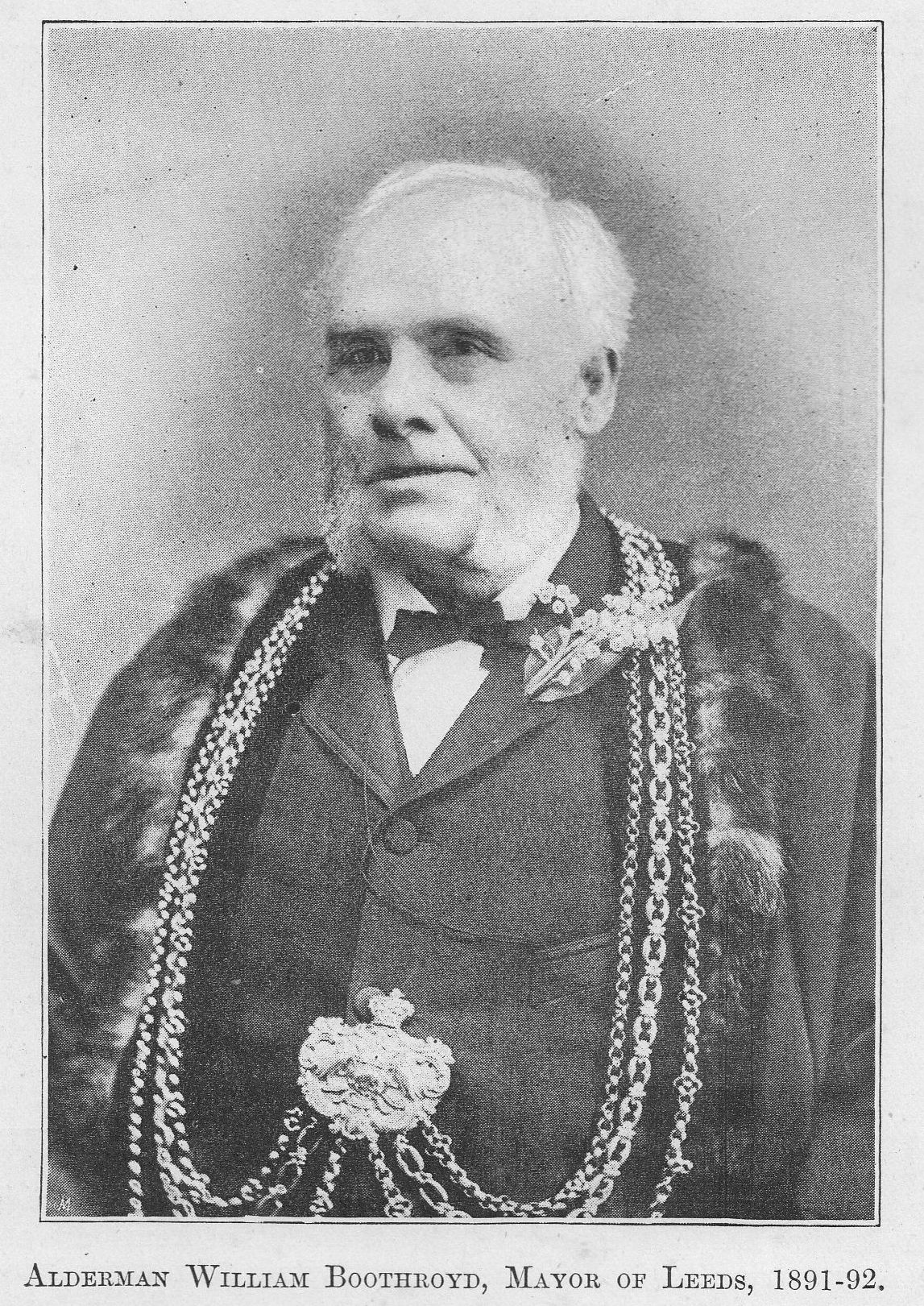
There have been other causes doubtless: advantage of situation, mineral resources, accidental benefits conferred by the opening up of railways, etc., but it is a curious fact, that, with perhaps the single exception of London, no town that in the “good old days,” when might alone was right, can be said to have had a determining voice in the conduct of national affairs, stands in the very front rank of English towns or cities to-day.
LEEDS is undoubtedly an example of this: with a population according to the census of 1891, of 867,506, she ranks sixth among the towns of Great Britain, and as a manufacturing centre stands equally high. Her growth during the present century has been especially remarkable, for we find on referring to the census taken in 1801, that the number of inhabitants was 30,669, a difference of 336,837 in 90 years.

It is, indeed, entirely from a modern standpoint that we must regard the town, if we wish to fully realise its importance.
Put briefly, the Leeds of to-day is a busy, smoke-begrimed proletarian town, possessed of immense trade, immense wealth, and over a third, of a million inhabitants. As regards the Leeds of yesterday and day before, there is little of importance to chronicle, at any rate from the picturesque historian’s point of view. The sumptuary, tilt and tournamental element is well-nigh wanting in her annals: her streets are not known to have been hallowed by the footsteps of the noble or the illustrious, and persons who would find within her boundaries some obvious traces “of an age that is long since past,” are fain to avail themselves of the steam cars and proceed to Kirkstall. We are, indeed, told on very creditable authority that the neighbourhood of Loidis, or Leeds, was one of the earliest homes of Christianity. We learn, further, that in 1197, the Manor of Leeds, together with that of Irnham, was “mortgaged to the Jews” for £26 per annum, whilst the plague carried off nearly one-fifth of the population in 1645, and King Charles stayed some nights at Red Hall in 1646. But these latter items are of little more than local interest, and do not tend to impress one with too great an idea of the prowess, chivalry or political I power of the old-time Leodiensians.
It is not till we turn to that least romantic of romantic matters, viz., trade, that Leeds begins to shine. So far as can be ascertained, she owes her very existence as a town to the fact that she offered a suitable field for the primitive operations of the young giant, Labour. It is more than possible that the people of the ancient Caer Loidis Coil were not altogether unacquainted with the art of metal working. Several finds of rude, iron-bladed implements have served to give colour to this theory, and the old bell pits which exist on either side of Call Lane make it pretty nearly certain that mining was carried on there so far back as the time of the Roman occupation. When Doomsday Book was compiled, Leeds had at least at mill. At the end of the eleventh century the number had been considerably increased, and cloth making and coal mining were being actively engaged in. The reign of Elizabeth, however, witnessed the true inception of the town’s commercial greatness, and notwithstanding the fact that since that day internal disagreement, temporary suspensions of trade, and other misfortunes have overtaken her, the even tenor of her way to power and prosperity has been practically unchecked.
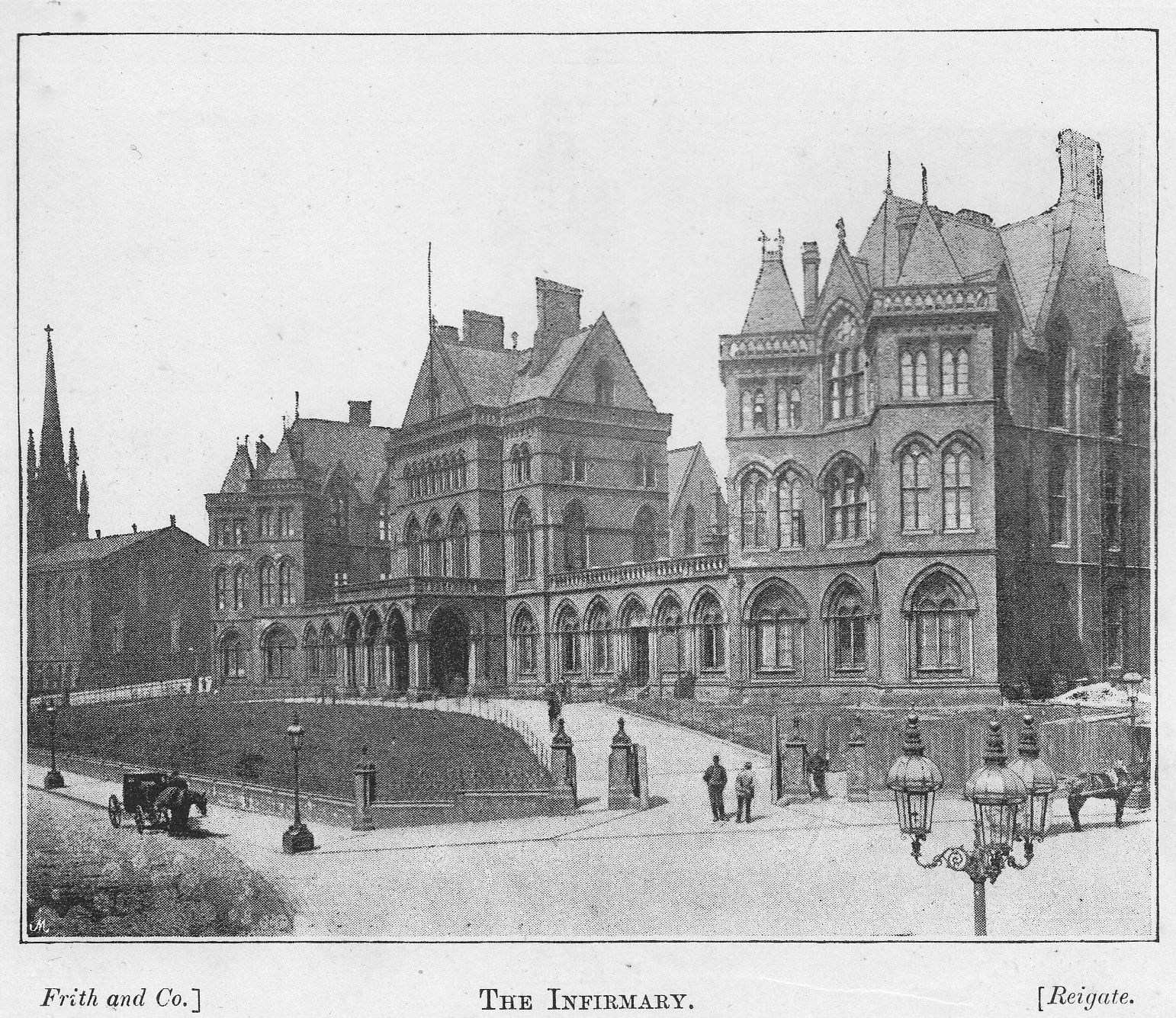
A BIRD’S-EYE VIEW.
Lining both banks of the Aire for a distance of over four miles, and taking up the whole of the amphitheatre formed by the low hills to the north, south and west, Leeds accommodates her 367,000 inhabitants easily, and without exhibiting any of the indications of an overcrowded city. In fact, the whole tendency of the place — and it has grown tremendously during the last half-century — is towards extension rather than concentration. It has been true that in the town proper there is a lack of open spaces, and that few of the streets are devoid of an abrupt and unaccountable twist, which has gained for them the epithet “dog-legged;” but as opportunity offers these defects are being gradually remedied, and the general street arrangement is such that the heart of Leeds is probably one of the most conveniently ordered city districts in England. A radius of half a mile from the junction of Boar Lane with Briggate and Duncan Street, includes the whole of the principal thoroughfares, public buildings, institutions and places of amusement, and the termini of the main arteries of communication with the suburbs. As the Bank is to the Metropolis so is Boar Lane End to Leeds. Within five minutes’ walk to the left of this point are the three great rail way stations, the Post Office, the Town Hall, the Municipal buildings, the School Board Offices, the Exchange, the Banks, the Infirmary, the clubs, the newspaper offices, the haunts and offices of the professional classes, the offices of the big business houses, the best hotels and restaurants, the best shops, and the fashionable town promenades; whilst within as easy access on the right are the markets, the Corn Exchange, the river-wharves, the Parish Church, the Grand Theatre and the Dispensary. Briggate, with its six offshoots, Boar Lane, Commercial Street, Upperhead Row, Duncan Street, Kirkgate and Lowerhead Row, all within a stone’s throw of each other, may be said to constitute the via urbis of the Woollen Capital, and it is here that the traffic and bustle incidental to city life are most strikingly exemplified.
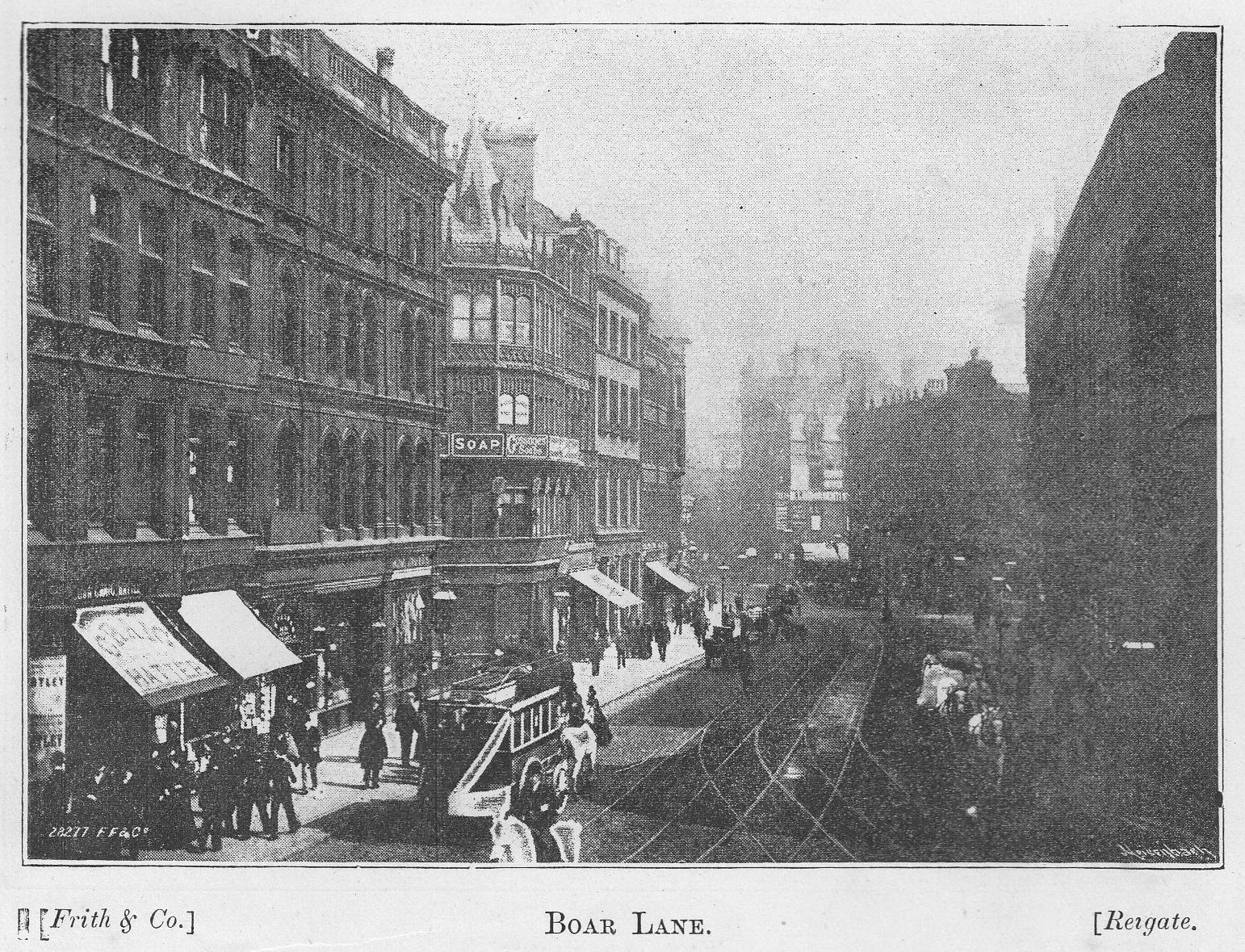
Outside a rough circle, inscribed so as to include such features of the town as we have already enumerated, we come across a broad belt of country where industry, smoke, and the dull leviathans that wait upon Capital, rule the roost. Away to the east and south-east are the countless mills, factories, forges and foundries of East Leeds and Hunslet, whilst to the south and south-west, the grimy arms of Holbeck, New Wortley and West Leeds, complete the Titanic picture. Probably the last place in the world to wax poetic in, is dear old dirty money- getting Leeds; and yet, for the adventurous, she has sights which the City of the Seven Hills itself cannot afford. To see Leeds aright one must clamber to the top of some architectural eminence in the heart of the town, and it must be at dusk of a December afternoon or dark of early evening. Look south, and if the atmosphere be anything like clear, there will be unfolded unto you a panorama that only a Dante or a Dore, or maybe a Tuefelsdroch, could portray. Beyond the plexus of lamps, and streets, and roofs, and spires immediately below you, looms a sweeping crescent of weird lights and uncertain shadows, crowned with smoke and blackness, and ringed round with a lurid aureole that makes the clouds look fire. If you be arithmetically inclined, you may count the long lines of twinkling lights which thread the labyrinthine wilderness mapped out before you, or speculate as to the cubic feet of gas that are being consumed in the illumination of the many-windowed factories dotted everywhere over the landscape. Anon a momentary burst of flame from some blast furnace will give you glimpses of the chaotic detail hidden in the darkness beneath; or some hitherto obscure forge will be suddenly flooded with a yellow glare, and over the roar of the town you will hear the bang and thud of the great hammers as they are brought down to beat texture into a block of glowing metal. And when you have looked, and wondered, and ruminated, and moralised, and possibly caught cold, enough, you may descend from your eyrie with the satisfaction of knowing that you have seen Leeds as a philosopher ought to see it.
The suburbs of Leeds, though not endowed with any great natural beauty, are by no means unattractive. A diversified expanse of country bounded by Kirkstall and Roundhay, and including the suburbs of Headingly, Meanwood and Chapeltown, practically embraces the whole of the better-class residential districts. Headingly and Chapeltown are by far the largest and most fashionable of these, Meanwood and Roundhay the prettiest, and Kirkstall about the least favoured. All, however, offer the advantages of healthy situation and semi-rural quiet, with charming alternations of hill and dale, and woodland and park-like scenery. During the last twenty- five years the growth of residential property in these neighbourhoods has been most marked. Taste, luxury and wealth are apparent on every hand, villa after villa, and mansion after mansion testify to the gold-producing capabilities of the smoke and din we have just left behind us; and, withal, the sweet incidence of nature has been so little interfered with, that suburban Leeds might not inaptly be instanced as the nineteenth-century architype of the bye-gone city in the wood — the Caer Loidis Coil of our ancestors.
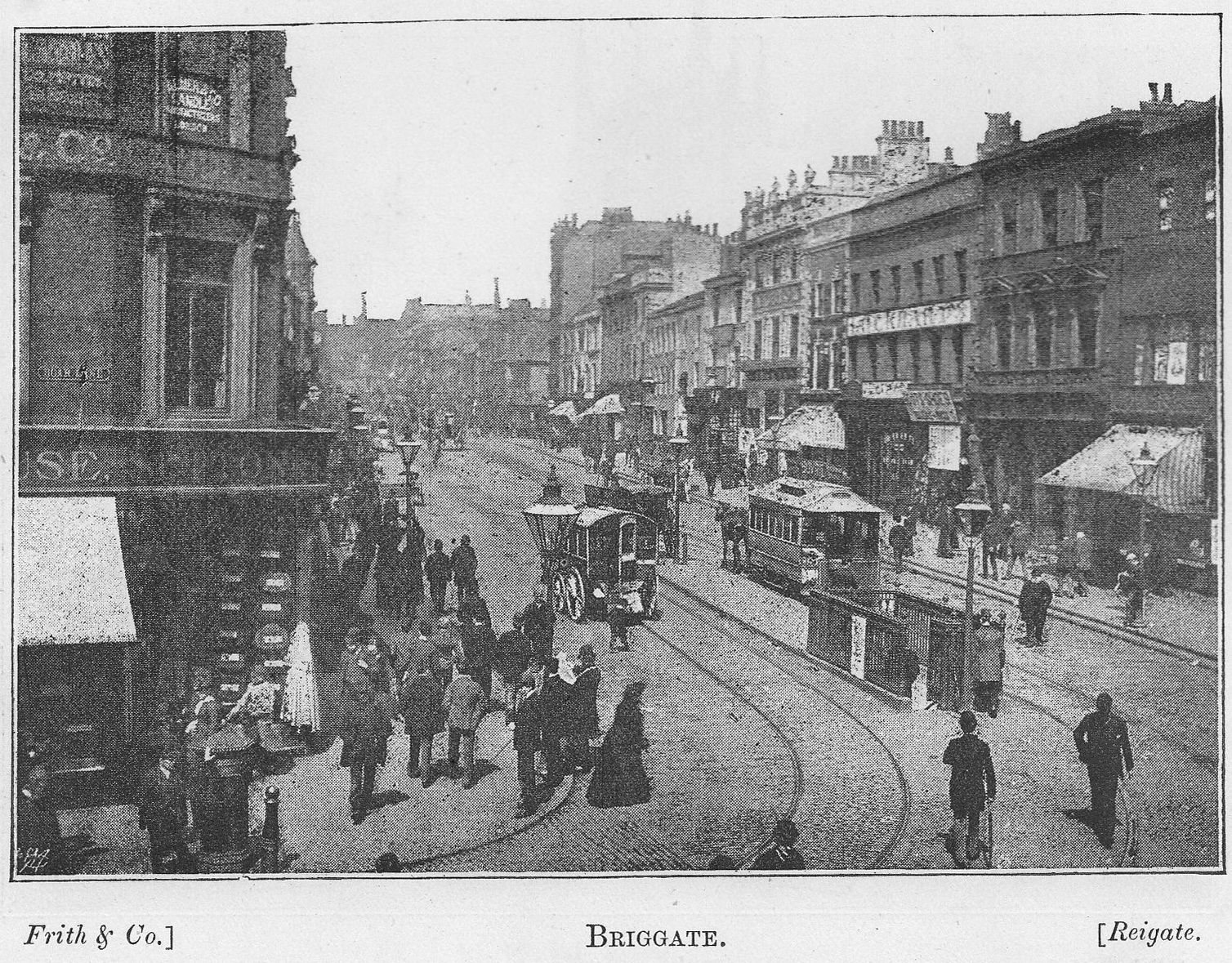
PUBLIC BUILDINGS.
All honest Leodiensians or “loiners,” as they are somewhat incontinently spoken of by persons whose bump of reverence cannot be extensive, profess a tremendous amount of admiration for such portions of their good old town as have any pretensions to architectural beauty. On the other hand, Leeds has long enjoyed a reputation for parsimony and cheese-paring in respect of her architectural undertakings, whether public or private. But in spite of the fact that a great many of her principal buildings are undeniably and unmistakably new, and in spite of the short-sightedness which some years ago permitted the City Fathers to allow what has been described as one of the finest sites in Yorkshire for the erection of a cathedral “to slip past them,” we cannot help thinking that the reproach above mentioned has never been altogether deserved. At any rate, since 1858, Leeds has been the proud possessor of one of the most imposing Town Halls in the three kingdoms, and the last twenty years have worked vast changes and improvements in the appearance of the majority of her principal streets and public offices.
The TOWN HALL, the stock “lion” of the place, although a noble edifice, and in every sense suited to the dignity and importance of the capital of the West Riding, appears to have been cradled amid some strife and unpleasantness. Even the ceremony of laying the foundation stone, placed certain members of the Council and the then Town Clerk in the somewhat awkward predicament of having to refund a sum of money which had been spent in “celebrating the occasion,” and was subsequently discovered to come under the head of illegal expenditure. The contractors who undertook the work of erection came to grief and bankruptcy before they had anything like completed their engagement, and for several years the authorities seem to have been in a state of indecision as to whether a tower should or should not be erected. When Her Majesty opened the Hall, seven years after the foundation stone had been laid, the dome or cupola was much more in nubibus than it is at present — having, in fact, no existence except as a possibility. But Rome was not built in a day, and having at length secured their Town Hall in all the magnificence of its perfection, Leeds folk soon learnt to forget the bad luck, the delays, and the heavy expenditure, which attended their first great effort in the direction of architectural grandeur. “Jackson’s Guide to Leeds” a popular shilling volume, well worth the attention of all who may be interested in the antiquities and sights of the town, gives the following details respecting Leeds Town Hall as it stands to-day. “The structure is a parallelogram, 250 feet by 200 feet, standing on an elevated platform surrounded by Corinthian columns and pilasters, supporting an entablature and attic, altogether about 65 feet in height. The South or principal facade has a deeply recessed portico of 10 columns, approached by a flight of 19 steps, 135 feet in length, with a pedestal at each corner, upon which pedestals four colossal lions, were placed in 1867. The principal entrance is under the south portico, with other entrances at the east side and north end. The tower, containing an illuminated clock with four faces, and a bell weighing 4 tons, 1 cwt., rises 225 feet from the ground, the height from the vestibule floor to that of the lantern is 185 feet, and in clear Weather a fine view of the town and neighbourhood can thus be obtained.
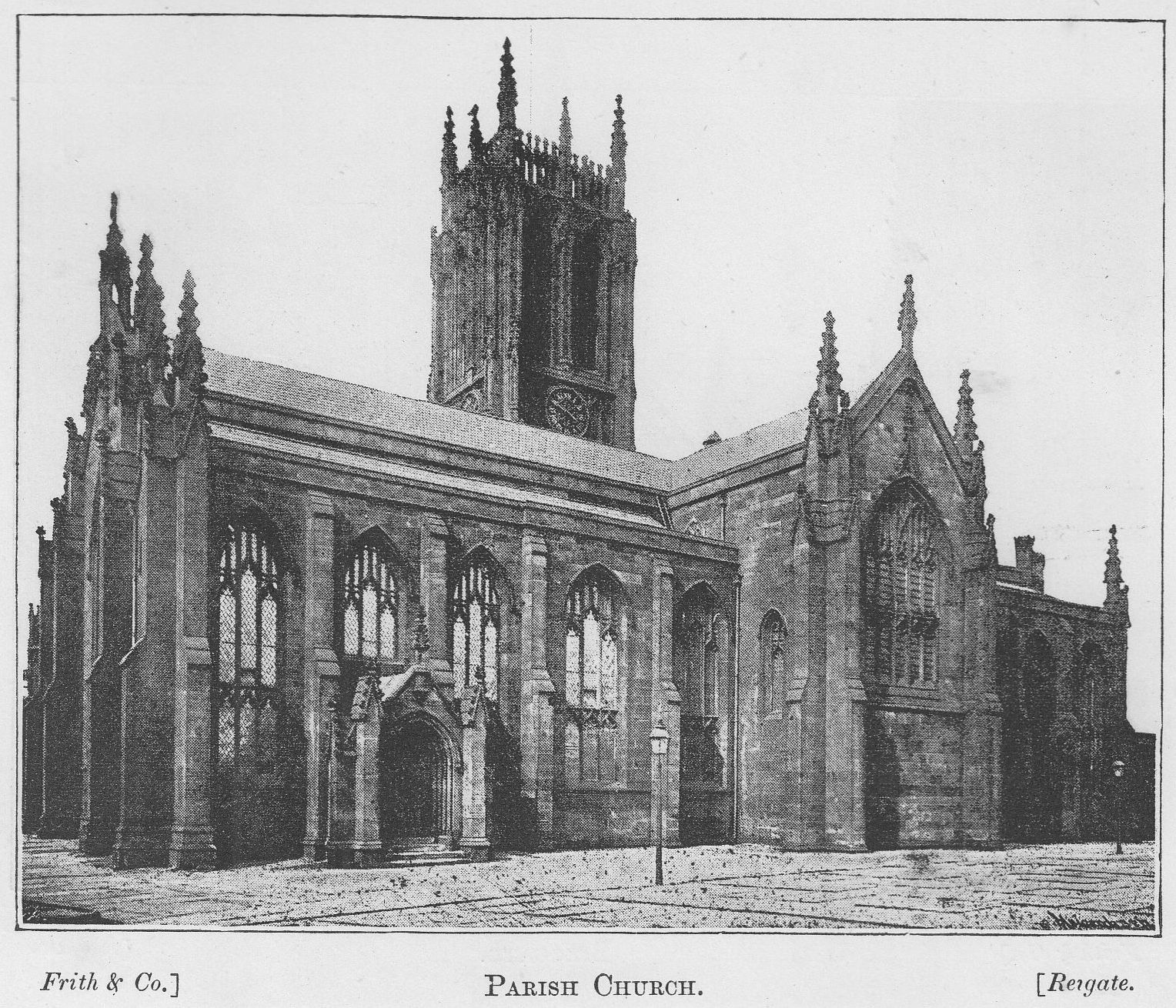
The great Hall, known as Victoria Hall, is one of the largest in the Kingdom, exceeding in size that of Birmingham Town Hall, and Exeter and St. James’s Halls, London. Within it 8,000 persons can be accommodated; its dimensions being 162 feet by 72 feet, and 75 feet in height. The hall has a semi-circular ceiling, divided into five compartment3 by massive ribs, supported at the sides of the hall by coupled Corinthian columns and pilasters. Ten large semi-circular windows, immediately above these columns, are filled with beautifully-coloured glass, which gives a very brilliant yet subdued effect to its architecture. The north end of the hall is occupied by the great organ, one of the finest in England. It is 50 feet high, and of about the same width. The fact that 14 persons have dined within the ‘swell- box,’ will give a striking idea of its colossal proportions. The plans and specifications for the organ were prepared by Dr. H. Smart, of London, and Dr. W. Spark, of Leeds, and selected by the Council from schemes submitted by many of the first organ builders, in competition for the prize of £150. The organ is supplied with wind through the various bellows and reservoirs by hydraulic engines. Since first built several additions have been made, including a carillon given by the late Alderman Marsden. At the south end of the hall is a glass screen, separating the hall from the vestibule or principal entrance. The vestibule is, in fact, the lower part of the tower, upwards of 70 feet in height and 48 feet square. The vestibule communicates, by means of corridors 10 feet wide, with the Police and Law Courts, the Council Chamber, the Law Library, Committee Rooms, Judges’, Barristers’, Magistrates’, Jury and Waiting Rooms, and between the corridors on either hand of the great hall, are a series of ante-rooms, variously used as refreshment rooms, barristers’ robing rooms, &c. The first floor, to which access is gained by four stone staircases, includes the West Riding Magistrate’s, Mayor’s, and Grand Jury Rooms, and the office of the Town Clerk and other functionaries. The basement is devoted to gaol, police and kitchen purposes, the right hand portion containing the charge and detective offices, and the left, the cells and apartments for the gaoler. There is also a commodious room immediately under the Victoria Hall. This is known as the Crypt, and is made to serve a variety of purposes.”
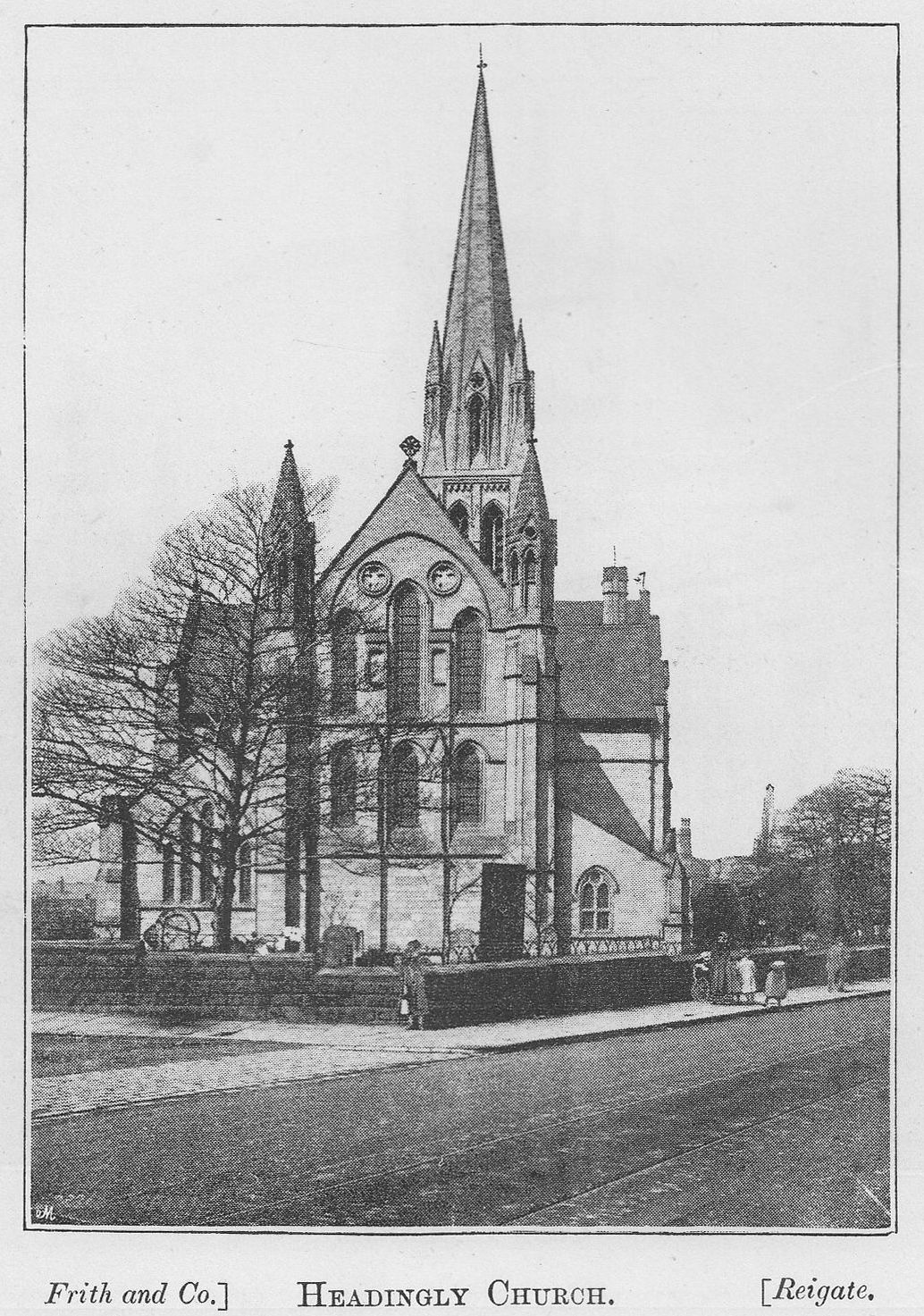
Until the School Board offices and Municipal buildings were erected, the surroundings of the Town Hall were distinctly mean and insignificant. On the north and west sides this is still the case, but the existence of a fine open square to the front of the edifice, and the width of street on the left, render these defects less noticeable than might otherwise have been the case. Much sarcasm has from time to time been levelled at the defenceless head of the fountain which is supposed to adorn the square aforementioned. The apparatus certainly does not come up to one’s ideal of fontal elegance, and we believe we are correct in stating that it spent a brief and ignominious portion of its existence as a sort of centre-piece in the local vegetable market, but Victoria Square would look decidedly bare without it, and until the public purse can bear the cost of something more in the nature of a joy for ever, it is to be hoped that this unfortunate representative of monumental aquatics may be allowed to retain its present honourable position. The only other ornament to the square is the familiar statue of the Duke of Wellington. It stands on a polished granite pedestal and was executed by Baron Marachetti. At the opposite end there has long existed a flagged platform, evidently designed for the reception of a similar memorial. Hitherto, however, no one has been appointed to share the Iron Duke’s grim watches; but this is a deficiency that time will doubtless repair, and it is undeniably better to leave the space open till a fitting occasion for occupying it arises than to give prominence to anyone merely on the ground of filling up the vacancy.
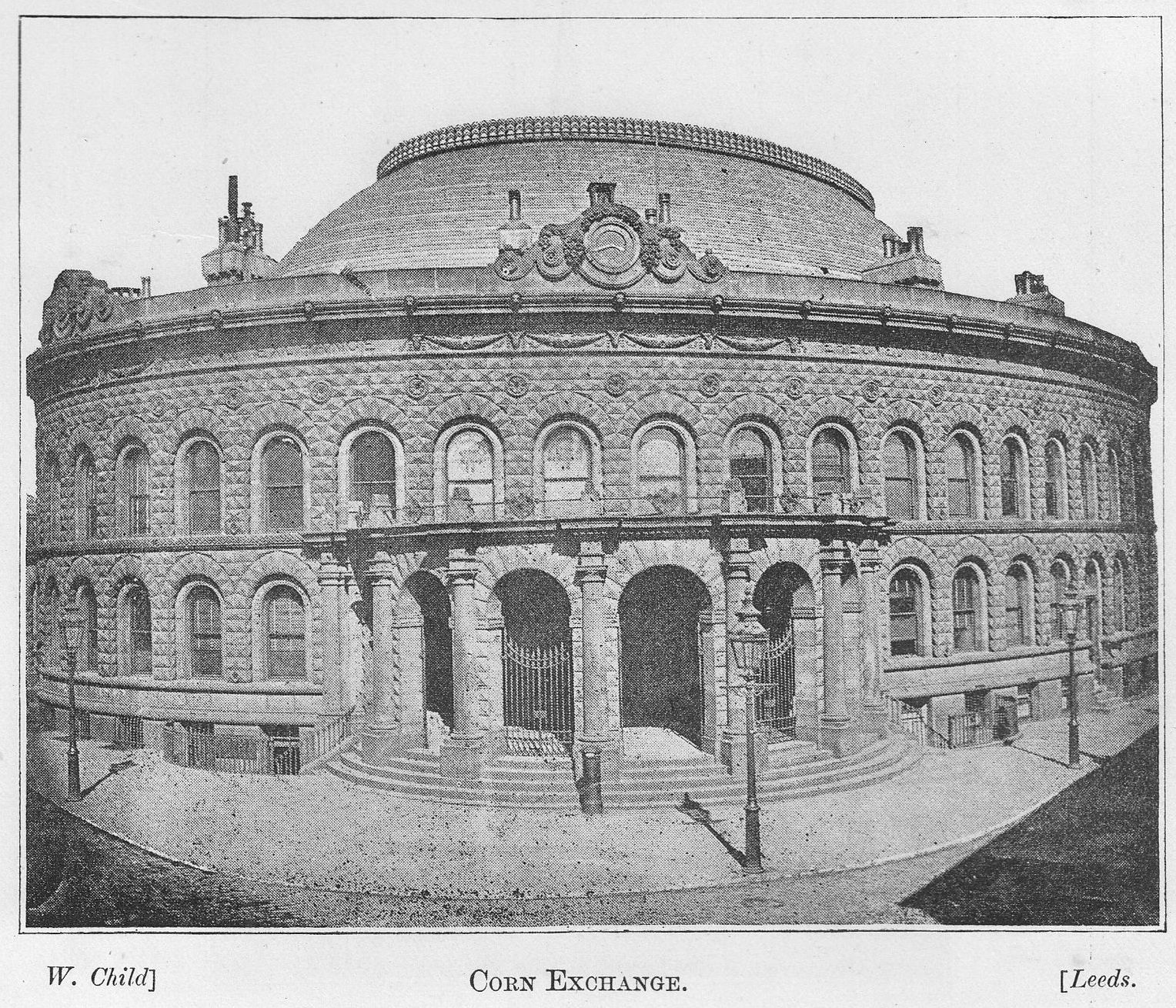
THE MUNICIPAL OFFICES and FREE LIBRAKY together form a beautiful pile of buildings fronting the eastern side of the Town Hall. They were erected from designs by Mr. George Corson, of Leeds, the foundation stone being laid by Mayor Carbutt in 1878. A very fair idea of the exterior appearance of these offices will be gained from our view. The interior, though at first sight somewhat pinchbeck and crowded, is not without beauty. A sort of Byzantine model has been followed in the treatment of the main stair-cases, which divide the edifice into two clearly defined sections, and the various styles of ceiling and wall-decoration, wainscottings, iron, brass, terra-cotta and stained glass work in some of the principal apartments, have been handled with excellent effect. Taking the Southern wing of the buildings first, i.e., the portion occupied by the Free Library, Reading Rooms, Art Gallery, Museum, etc., we find the ground-floor constitutes a particularly handsome sculpture gallery, some 80 feet long, and flanked on either side with massive granite pillars. This apartment was formerly used as a reading-room, but now forms an imposing approach to the picture galleries beyond — an annexe of more recent construction on the first floor is the Lending Library, containing some 50,000 volumes, and above the Reference Department. The Reference Library is, without doubt, one of the snuggest and most comfortably furnished in the kingdom. If it has a fault, it lies in the lack of accommodation for further accumulations of books. Perhaps this defect has hardly had time to make itself much felt as yet. When it does, the ingenuity of the Committee will no doubt find ways and means of meeting it, but it will be at the expense of the convenience of either the public or the librarians, for the structural peculiarities of the existing library almost preclude any extension being made, and it is easy to see that almost every inch of available space is already taken up. The annexe referred to above contains the main rooms of the Art Gallery and Museum and the Reading Room. It is a comparatively recent addition to the buildings, and is noteworthy by reason of its exceeding plainness as compared with the parent structure. In addition to a spacious and well-lighted Reading Room, approached by a separate entrance in Alexandra Street, it contains a fine Central Court, around which are apartments devoted to the display of pictures. Here we find, among others, Sir Frederick Leighton’s “Return of Persephone,” presented to the town by Sir Jas. Kitson, “Milton Dictating Paradise Lost” and “Retribution,” both of which latter important works lay for many years in one of the dingiest and least frequented corridors of the Town Hall, being included. What may be termed the Leodiensian Art Renaissance, dates from the opening of the first loan exhibition in these galleries. Through the exertions of the committee and the curator, examples from the brushes of some of the foremost English and foreign artists have been here exhibited, local talent has been very much encouraged, and the residents of the town and neighbourhood have had opportunities for artistic enjoyment and the cultivation of their sense of beauty, which were sadly lacking, even so recently as the year of grace, 1887.
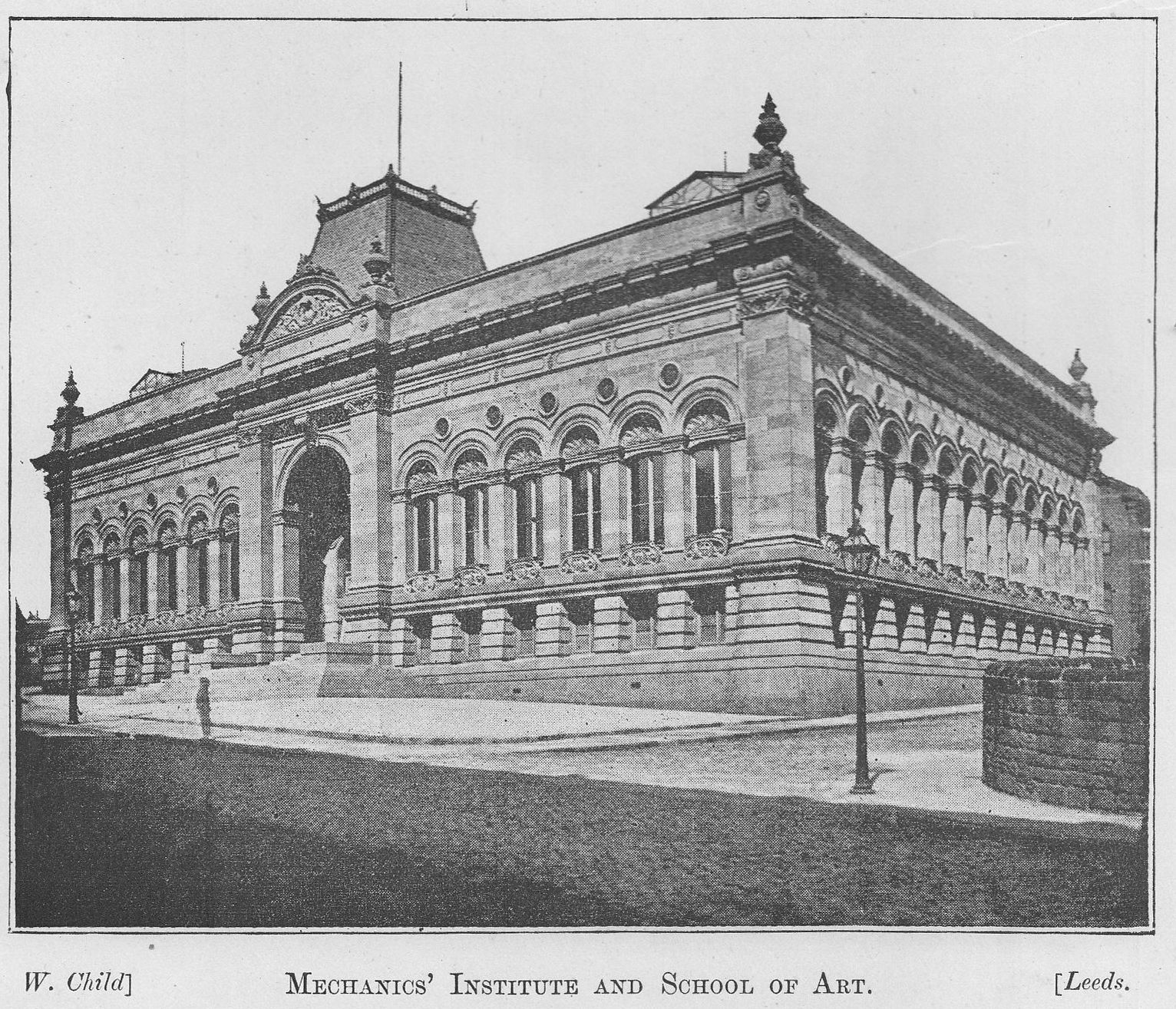
The body and northern wing of the Municipal Buildings, are taken up by the Sanitary and Borough Engineer’s departments, and the offices for the receiving of borough rates. Although not exactly the sort of places in which anybody who has to pay the Improvement Rate can feel inclined to rhapsodise, they are all of them masterpieces of substantial and even luxurious office-furnishing, and supplemented as they are by a porter in a gold-braided silk hat, and a smart uniform, confer not a little dignity upon the various sections of the public service which they represent.
THE SCHOOL BOARD OFFICES stand on the same line of frontage as the Municipal Buildings. They were built in 1881. Architecturally, they are in no degree unworthy of the sister edifice. The main entrance opens on a broad arched corridor, on either side of which are the various offices, committee rooms, etc. A large hall above is used as an examination and lecture-room. There are also a series of class-rooms, and apartments for the caretaker in the basement. The cost of this building provoked considerable outcry amongst the ratepayers, but the edifice is certainly far more in harmony with the wealth and standing of a town like Leeds, than were the cramped and inconvenient offices formerly occupied by the School Board in Park Row.
One of the finest public buildings of which Leeds can boast is THE NEW INFIRMARY. The structure is in the Gothic style of Architecture, and was built from designs by Sir Gilbert Scott, R.A. The total cost was about £120,000. The infirmary has gained a wide reputation, as many as 17,000 patients having passed through the wards or undergone treatment in one year. It is supported almost entirely by voluntary contributions, the income from this source and certain small investments now amounts to about £15,000 per annum. The old General Infirmary was opened in 1771, in a building which now forms part of Crofts Chambers. It was superseded by the new premises in 1868.
At the junction of Park Row with Boar Lane, and, in fact, right up the Row to St. Ann’s Cathedral, there is a good deal of impressive architecture, the Royal Exchange, Mill Hill Chapel and Schools, the Post Office, Beckett’s Bank, the Philosophical Hall, the Bank of England, and the Cathedral itself forming the main features of a street, which, in the matters of architectural beauty and uniformity, will bear comparison with any other in the town. Whilst in this neighbourhood, it may be as well to notice the old Cloth Hall which most persons who have visited Leeds will remember as a long, low, desolate-looking building, taking up nearly the whole of one side of Infirmary Street. Although now swept away, and its latter days a positive encumbrance to the ground, the Cloth Hall represented a distinct phase in the history of the town, and its depravation from a Cloth Market to a sort of covered show-ground and advertisement hoarding was symbolic of the decadence of the trade which gave Leeds her first taste of the sweets of prosperity. The White Cloth Hall was built in Kirkgate in 1710. In its time it has played many parts, having been successively a wine vault, an auction room, a dancing saloon and a chapel. It is now occupied as a drapery store (No. 100, Kirkgate).
THE NEW SQUARE, formed by the demolition of the Coloured Cloth Hall, is a distinct acquisition to the open spaces of the town. It cost the Corporation £160,000 to purchase, but the money has been well-spent, and with a growth of new buildings such as the Liberal Club and the New Post Offices to flank it, the Square will probably become one of the cynosures of the town.
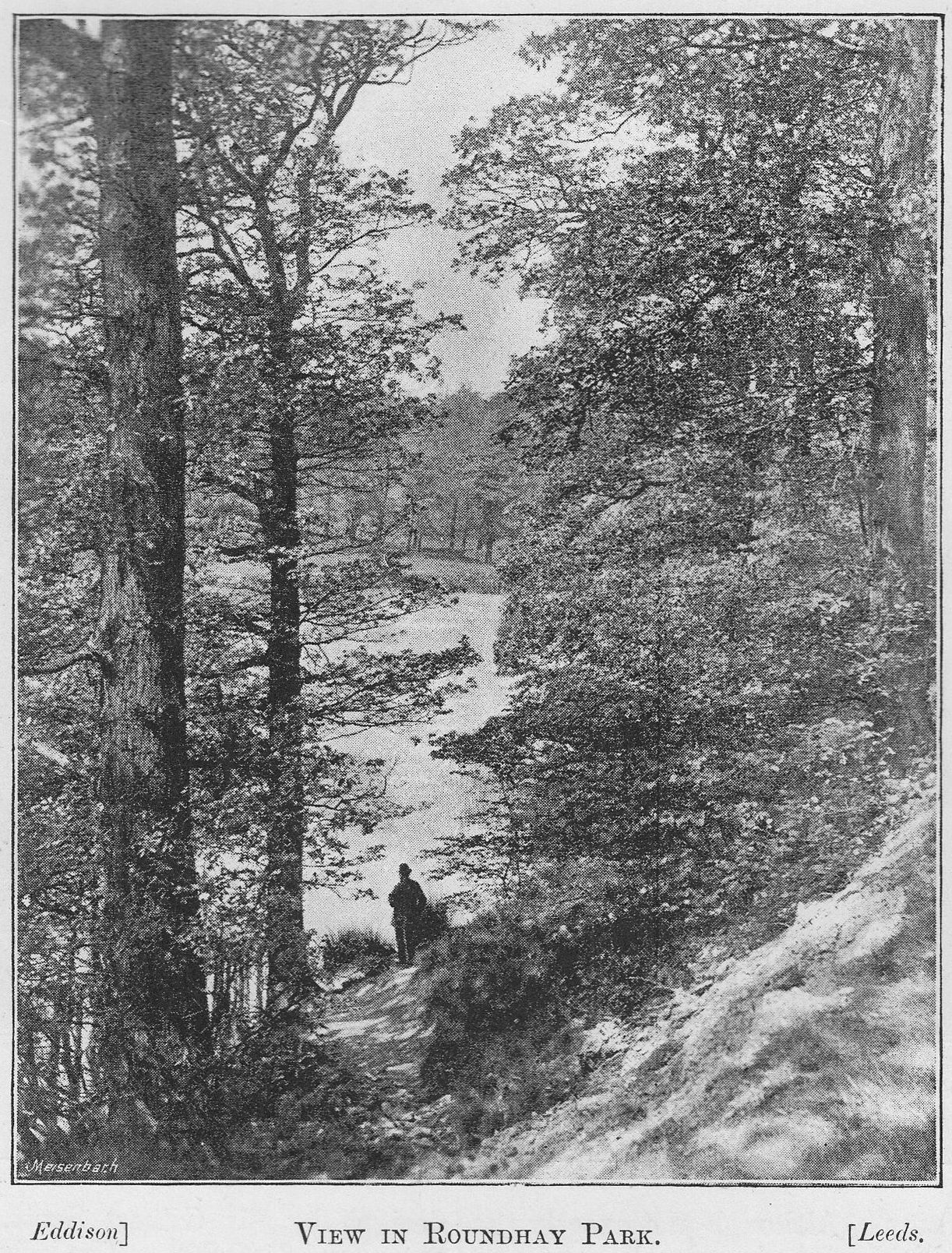
Some years ago, at the suggestion of Mr. J. F. Masser (at that time a partner in the firm now known as Massers, Ltd.), a good deal of widening, straightening, and “improvement” transformed Boar Lane into a really handsome thoroughfare. It contains some very fine ranges of shops, and the general architecture is, to say the least of it, imposing. TRINITY CHURCH, a well-known landmark at the Briggate end of the Lane, is said to have been designed by Sir Christopher Wren. It mainly owed its origin to the generosity of Lady Betty Hastings, who contributed £1,000 towards the expense of building a new church, which, it seems, Leeds was badly in need of at that period (1721). The foundation stone was laid in August, 1722, and the structure completed in 1727. The lofty tower was rebuilt in 1839, the original having been injured during a violent thunderstorm. Its situation that time was quite rural, and doubtless its imposing appearance was shown off to the fullest advantage; hemmed in as it is now by masses of business premises, and blackened by close on two centuries of exposure to the grime of Leeds factory-smoke, its light is now considerably hidden, but it yet remains one of the most noticeable examples of ecclesiastical architecture in the town, which, it must confessed, cannot boast of anything very striking in this way.
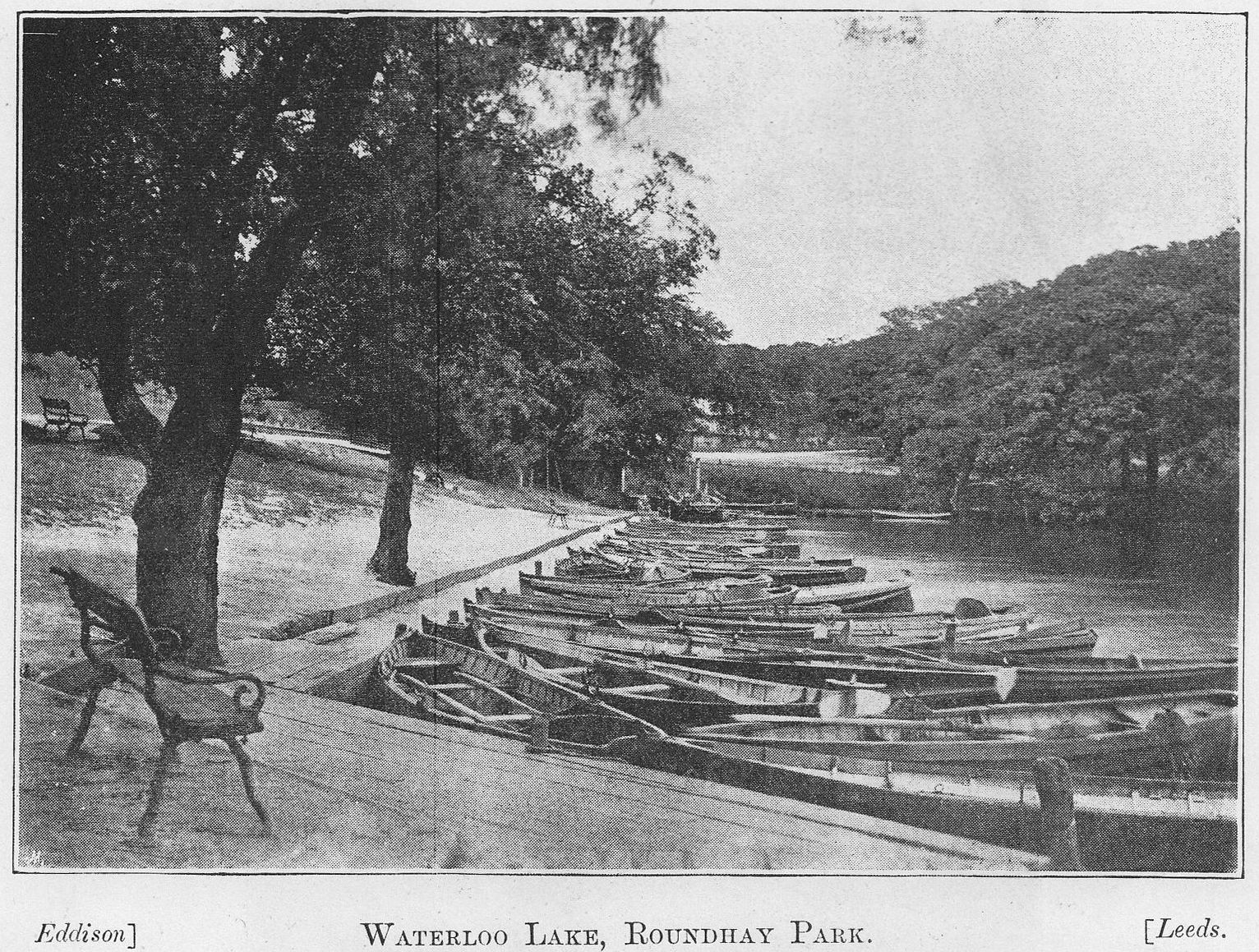
An exception to this rule is to be found, however, in what is, singularly enough, quite a modern building. We refer to Mill Hill Chapel, which stands in Park Row, opposite the General Post Office. This structure, with its elegant design, and numerous crocketted pinnacles, might easily pass as belonging to medieval times; yet, its opening only dates back to 1848. In this instance, the smoke-laden atmosphere has been rather a boon than otherwise, and has conferred upon the building an air of antiquity well in keeping with its beautiful architecture, which is in the Pointed or Perpendicular style, that prevailed in the 15th century. The chapel is used as a place of worship by members of the Unitarian body, and is interesting from an historical point of view, from the fact that it stands on the site of an older edifice erected directly after the General Indulgence Act passed by Charles II. in 1673.
While on the subject of places of worship, mention may appropriately be made of the PARISH CHURCH OF ST. PETER’S. This, like some of its contemporary edifices, is of quite recent date, it having been built in 1840. For ages, however, the ground it stands on has been occupied by a sacred building dedicated to the same patron saint. The Domesday Book makes mention of the “Church of St. Peter at Leeds,” and during the demolition of the present building’s immediate predecessor, traces of a church having been originally erected during the Saxon period were discovered. As in the case of Trinity Church, the new St. Peter’s was built to provide more accommodation for worshippers in Leeds, and though in this respect it has fulfilled its purpose, it is not, we believe, generally regarded as a very great acquisition to the architectural beauties of the town. It is oblong in shape, being 180ft. long, with a width of 86ft., and is surmounted with a tower 139ft. high, this tower containing a peal of thirteen bells. The interior in some way atones for the plainness of the exterior, being freely and elegantly decorated; it contains galleries as well as seats on the ground floor, and altogether there are about 3,000 sittings, rather more than half of which are free. The organ, which stands on the ground floor, is considered a very fine one, as may naturally be expected in so musical a town as Leeds.
The Church has some very rich stained glass windows in the ante-chapel, and also some noteworthy monuments; among others the Crimean Monument to the natives of Leeds who lost their lives in that memorable struggle. The monument was raised by public subscription, and represents a figure of Victory crowning a dying British soldier. There are also monuments to the late Dean Hook, who was chiefly instrumental in the re-building of the Church; to Captain Richard Beckett, of the Coldstream Guards, and Captain Samuel Walker, of the 3rd Regiment of Guards, both officers having been killed in the battle of Talavera; to Sir John and Lady Beckett, and several others. The cost of re-building the Parish Church was defrayed by public subscription; it amounted to £40,000, which seems to show that the Leeds townsfolk, in this instance at any rate, were anything but parsimonious.
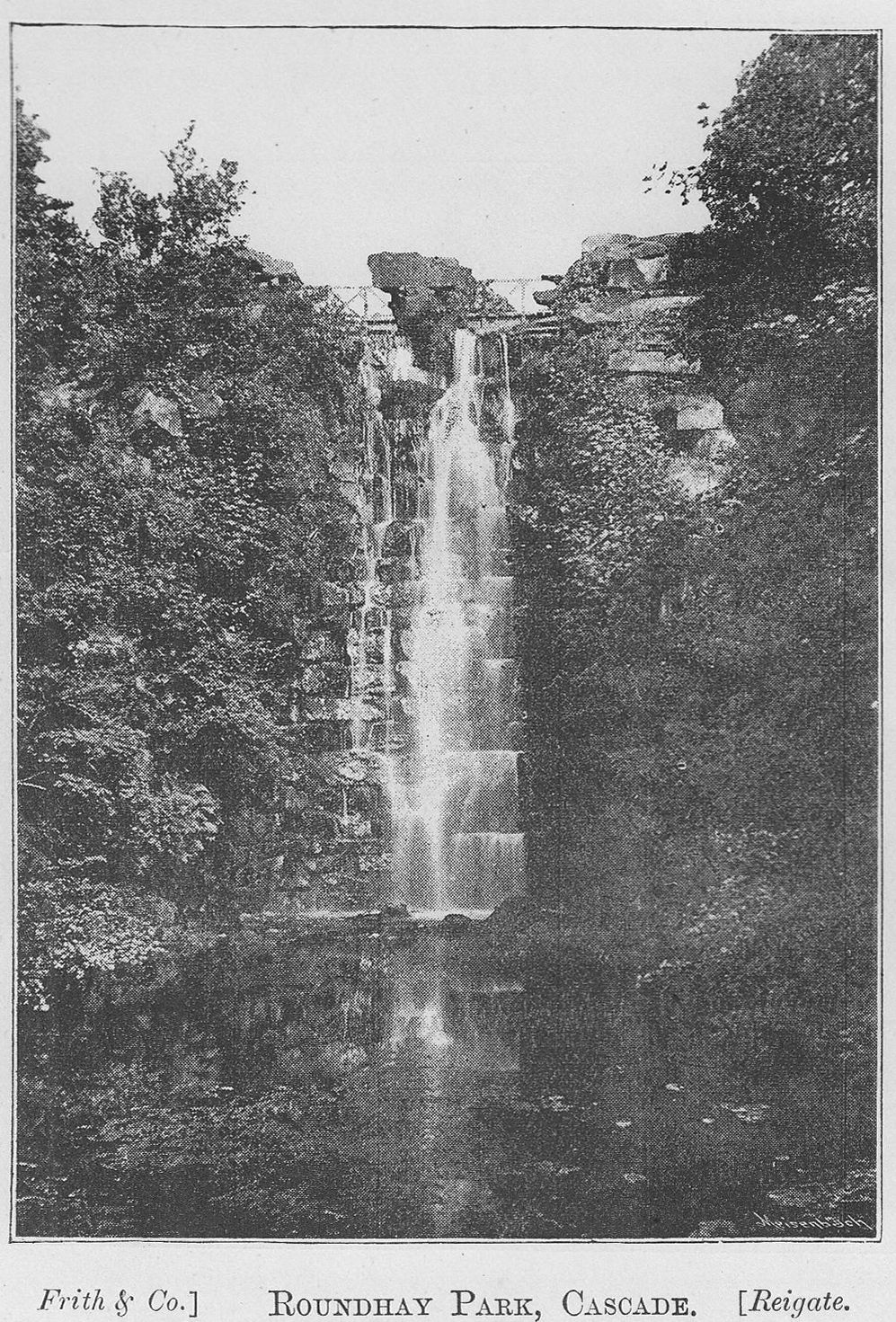
It would, perhaps, be hardly fair to Leeds to infer that its spiritual growth has not always been on a par with its physical extension, but be this as it may, it is certain that very few of the churches in the borough date back farther than about the early part of the 18th century, and St. Peter’s, we are told, was “for centuries the only Church in the town.” The next to be built was St. John the Evangelist, consecrated in 1634. Trinity, of which we have already spoken, followed in 1727, and St. Paul’s, in Park Square, opened for public worship in 1793, was the fourth. Since then the number of churches has very largely increased, Episcopalians, Nonconformists, Catholics, and, indeed, all sects, have displayed great activity in providing accommodation for the members of their various sects, and centres from which their particular doctrines may be effectively promulgated. So much, indeed, is this the case, that there are not wanting those who declare the town generally to be very considerably leavened with Puritanism, or at any rate that this applies to the powers that be. It is, however, the usual fate of would-be reformers, whatever their degree of enthusiasm, to be misunderstood, and there can be no doubt that among those who direct her spiritual and temporal welfare, Leeds can boast of a great number of earnest, zealous, and capable men, in every way worthy to help in the control of so important a social organisation as she presents.
An important institution in connection with a religious body is the Wesleyan Theological Training College at Headingly; great value is rightly placed upon this College by the Wesleyans, many of their most noted preachers having been trained here. It was opened in 1868, and is befittingly imposing ion design, as becomes the dignity and extent of its purpose. The Church of England and Roman Catholic bodies have also places in the town devoted to work of a similar character.
THE GENERAL POST OFFICE, which has had a good many wanderings, as from time to time the business of the department outgrew the premises in which it was located, has been located since 1861 in Park Row, in what was formerly the Court-house. It has once more overgrown itself, and will shortly be removed to premises which are being specially built in the New Square, quite close to its present site. There is a decided lack of accommodation for the public in the present building, but as this is being remedied as quickly as possible, it needs no further comment. Numerous branch offices exist in various parts of the town, and there are also letter-boxes in most of the principal throughfares. The Parcels Post is at present accommodated in a part of the White Cloth Hall, Quebec Street.
The OFFICES OF THE NATIONAL TELEPHONE CO., LTD., are in Commercial Buildings, Park Row, almost adjoining the Post Office. Communication by this means exists between Leeds and London, Liverpool, Manchester, Newcastle, Birmingham, Cardiff, and most of the principal towns and cities in England, and also with Paris; and almost all towns of any importance in the Yorkshire and Lancashire, Midland and Cumberland districts are connected by the same system. There is, we believe, no public means of communication by telephone provided by the Leeds postal authorities, the close proximity of the National Co.’s offices obviating the necessity of this.
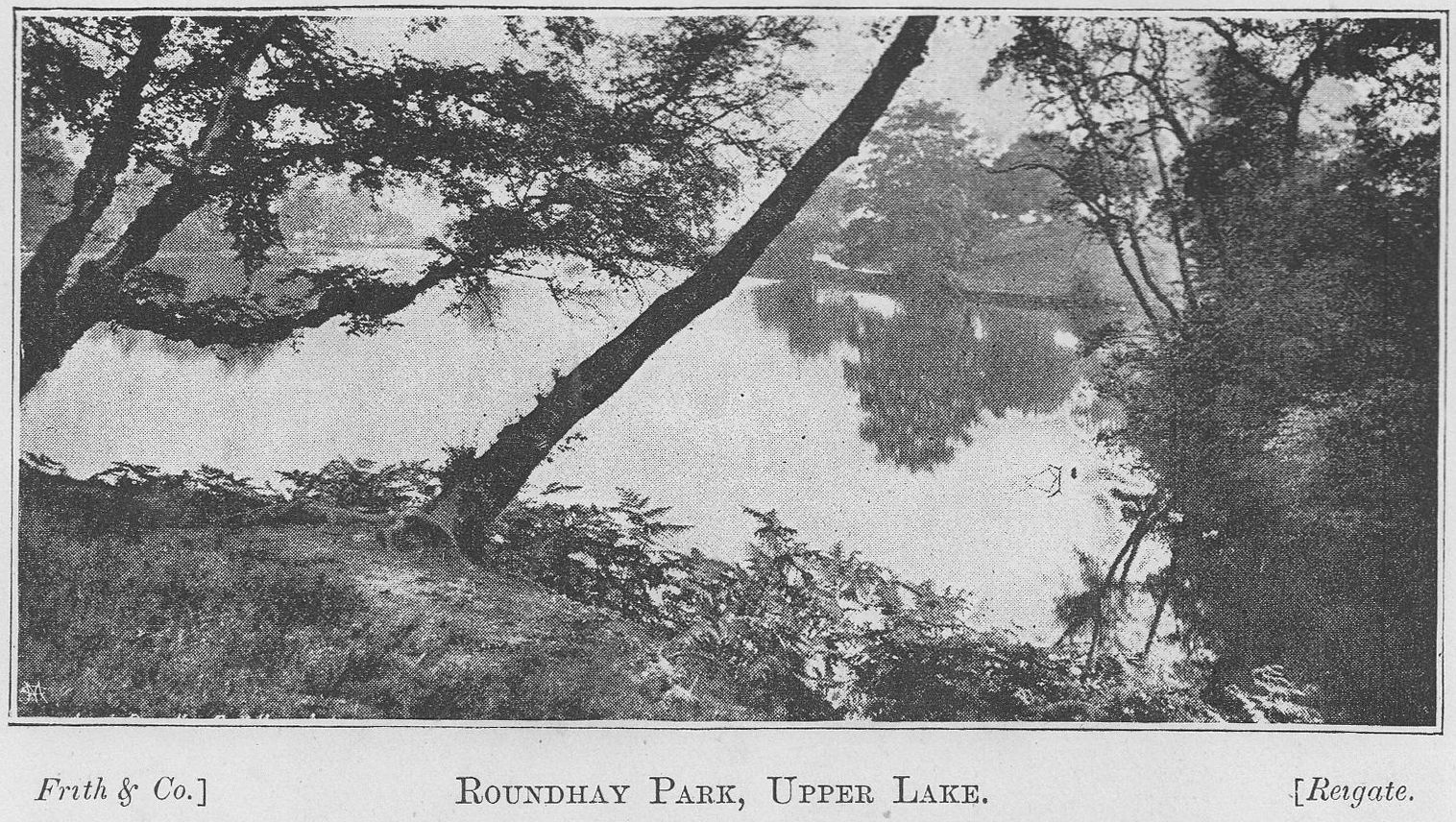
In Park Row also is the MUSEUM of the LEEDS PHILOSOPHICAL and LITERARY SOCIETY, located in the hall belonging to that body. The Museum is of considerable importance both in size and interest, especially when we consider that it owes its existence to a semi-private body, and not to municipal effort. The building, which is rendered conspicuous by a lofty portico over the entrance supported by massive stone pillars, was built in 1819, and first opened in 1820; it then included a Lecture Hall, Library, Laboratory, and Museum. It was enlarged in 1862, the present Lecture Hall, with seating accommodation for 300 persons, the new Library, and large Zoological Room, being added. The principal departments are the Outer and Inner Vestibules, the Industrial Museum, the Geological Rooms, Mineral Collection, and Zoological Room before mentioned; the whole of the collections have been formed and arranged so as to interest as much as possible the ordinary visitor, as well as the scientist and antiquarian, and in this respect the council have established a good president. The admission fee is one penny only, and lucid, if brief, guides to the whole museum or the separate collections can be obtained from the door-keeper at the same price.
THE ROYAL EXCHANGE occupies a commanding site at the south-east corner of Park Row; it is a fine building in the Gothic style of architecture, and being about the first public building the visitor sets eyes on, after leaving Wellington Station, is calculated to impress one with a favourable idea of the architectural pretensions. of the town. Entrance is gained to the Exchange proper, which is in the centre of the building, through the porch under the tower, this with its spire rising to an altitude of nearly 120 feet. The building includes besides the Exchange, the rooms belonging to the Royal Exchange Club, a newsroom, shops and offices, etc., it was three years in course of erection, the foundation being laid in 1872 by Prince Arthur, and the Exchange opened August the 31st, 1875. The tower contains a large illuminated clock.
Close at hand, opposite the telegraphic department of the Post Office, is the statue of Sir Robert Peel, representing the famous minister as addressing the House of Commons. The statue, which is considerably over life-size, was sculptured by Behnes, the whole cost, including the pedestal, being 1,500 guineas, which amount was raised by subscription. It was inaugurated on the 20th of August, 1852, ten years after the decease of the statesman it represents, the event being made an occasion for public rejoicing. The monument is further interesting as being the first statue erected in the streets of Leeds.
In this part of the town, in King Street, will be found the NEW WHITE CLOTH HALL, erected by the North-Eastern Railway Co., in 1868, in the place of the old one in the Calls which had been demolished in making the railway line. The Cloth Hall being now rendered unnecessary by the modern conditions of trade, this building is now associated with its original purpose in little more but in name, the greater portion of its space being otherwise utilised.
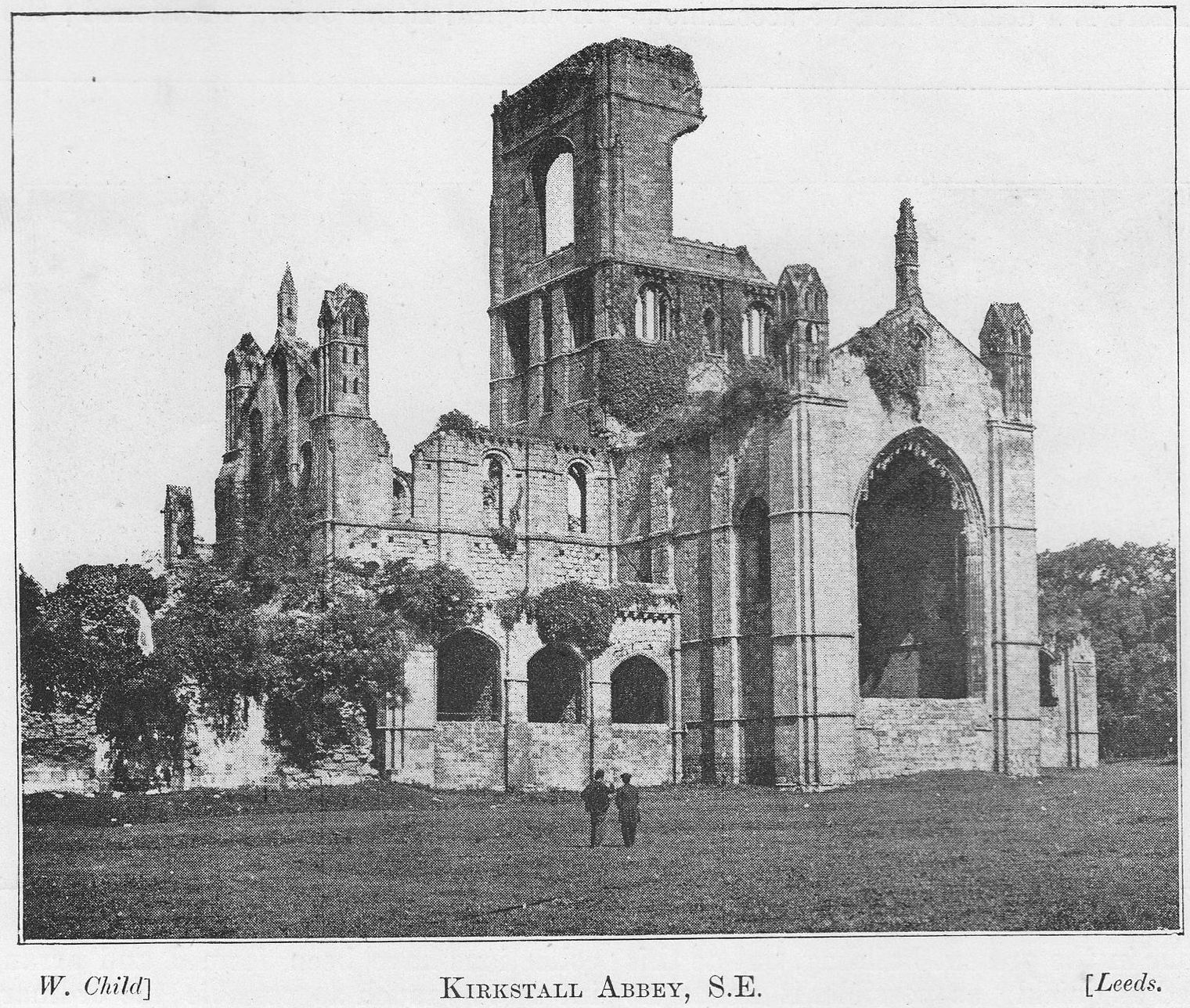
The CORN EXCHANGE, at the end of Call Lane, facing Duncan Street, is an edifice not likely to be missed by visitors to this part, one of the oldest, of Leeds. It is built in a oval form in the Italian style, and is described by a local writer as “of much more pretence than elegance.” It is not, however, without a certain stateliness of its own, and its attractions would be certainly much enhanced if its surroundings were improved. It was erected to take the place of an Exchange that formerly stood at the top of Briggate, and opened in 1868. Mr. Cuthbert Brodrick was the architect, his design being carried out in dressed stone, the interior being cased with coloured bricks. The main entrance is under a pillared portico> facing Duncan Street, approached by a flight of steps; there are besides two entrances to the buildings. A gallery runs round the interior, and besides the factors and farmers’ markets, there are numerous offices, a post and telegraph office, and various other offices connected with the building.
In close proximity is the CENTRAL MARKET, with a frontage to Duncan Street, in the Grecian style of architecture. The Market is the property of the Corporation, having been purchased by the town in 1868 for £25,000.
A little further on in Kirkgate is the COVERED MARKET. This extensive building is composed of iron and glass, the ground floor of the frontage being largely devoted to clothing stores. Vicar Lane and Ludgate Hill form two of its boundaries. The Shambles, and Open Market for fish, fruit, vegetables, etc., are all close handy, and may be resorted to in turn without inconvenience.
The LEATHER MARKET is in Meadow Lane, and Quarterly Fairs are held here on the third Wednesday in the months of January, April, July and October; intermediate Fairs on the first Wednesday in March, June, September and December. It was erected in 1824, and though first intended as a general market, is now solely devoted to the sale of leather.
The VICTORIA CATTLE MARKET and ABATTOIR, opened by the then Mayor, Alderman Gaunt (now Sir E. Gaunt), in 1886, is situated between Whitehall and Gelderd Road. Market day, Wednesday.
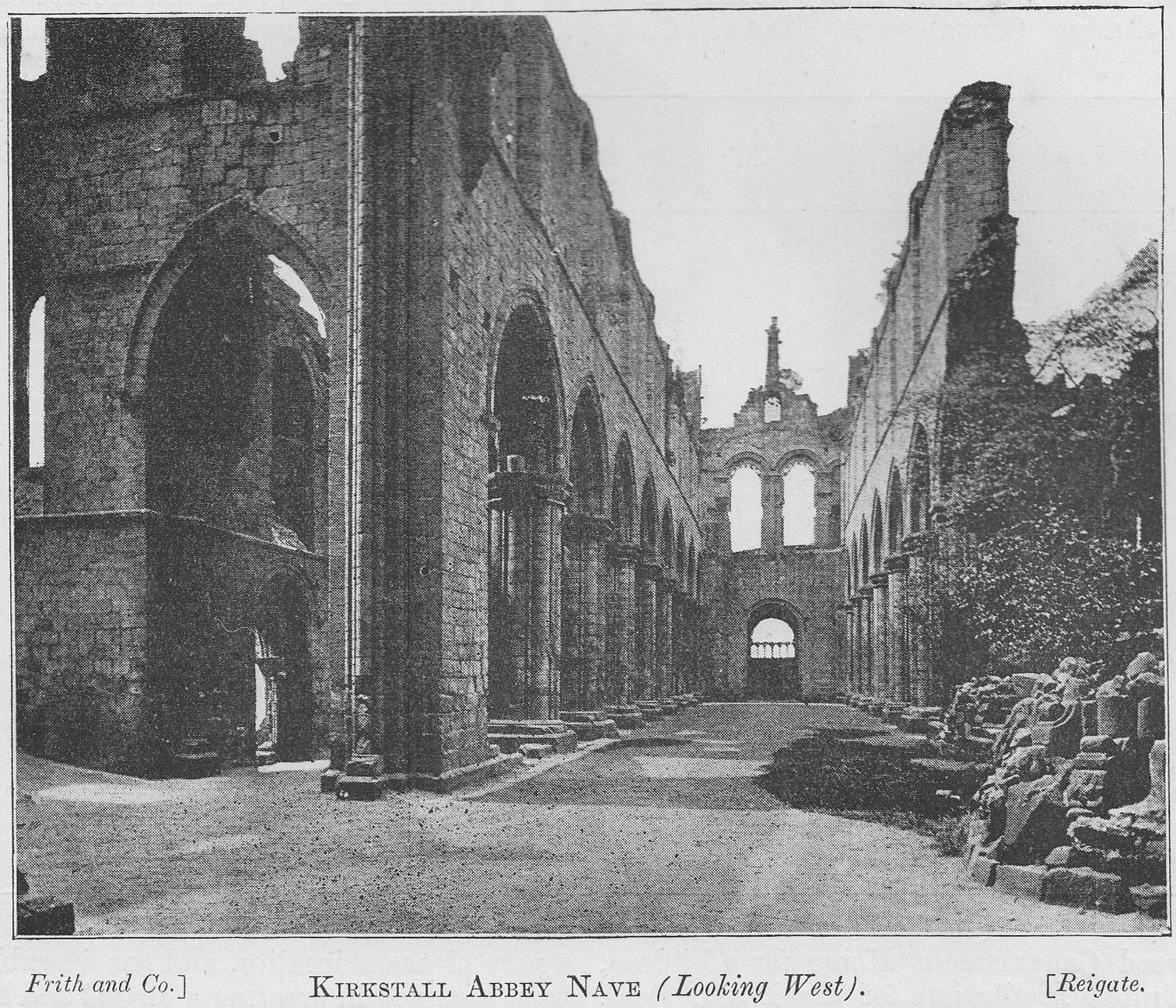
The LEEDS STOCK EXCHANGE is located at 61, Albion Street, and the WEST RIDING ASSOCIATION FOR THE PROTECTION OF TRADE at 16, East Parade. The LEEDS CHAMBER OF COMMERCE have their Council Room at 12, Royal Exchange Chambers.
The ASSIZE COURTS are held in the Town Hall three or four times a year, the police courts being held in the same building. The COUNTY COURT is in Albion Place. HER MAJESTY’S PRISON, better known as Armley Gaol, is at Armley, a little distance from Leeds proper; it was first erected in 1847, and has at least twice since undergone alterations.
There are several foreign Consuls resident in Leeds. The United States of America, Denmark, Italy, Portugal, France, Sweden and Norway, Spain, and the Argentine Republic being represented; the Consulates, taken in the same order as above given, are at 11, Bank Street: New Station Street: 7, St. Paul Street; Osmondthorpe Hall; Aire Street; 15, East Parade; and 18, East Parade.
Leeds can boast of but very inferior military accommodation, though a cavalry depot, the barracks in Chapeltown Road having been described by the Inspector-General as “the worst in all England;” under the Barracks Act steps are being taken, we believe, to remedy this deplorable state of affairs. Besides Regular Forces, Leeds possesses the 1st West Riding York Artillery Volunteers; 2nd West Riding Engineer Volunteers; and the 3rd Volunteer Battalion (Prince of Wales’ own); thus contributing her full share of “men and muscle” to our citizen army.
One of the redeeming features of the present age is the care taken in maintaining old, and in found new agencies of resource for those who have found the conditions of life too much for them to successfully grapple with.
The necessities of their suffering and needy citizens are amply provided for by the inhabitants of Leeds, and an excellent charitable institution exists in the PUBLIC DISPENSARY. The locality in which this building stands was formerly known as Belgrave Square, but it now forms part of New Briggate. The structure, which replaced an older Dispensary in the immediate neighbourhood, was opened in l867, on the 7th of June. It is built in the Italian style of brick with stone dressings, and cost £7,000. The Institution does an immense work in the Borough, all cases not able to afford payment recommended by a trustee or subscriber receiving gratis relief; it is dependent for support on voluntary contributions.
Besides the two great centres of public benevolence, the General Infirmary (already referred to), and Public Dispensary, Leeds possesses a number of other Philanthropic Institutions. Amongst these are the Hospital for Women and Children in Woodbine Place; the Borough Fever Hospital, Beckett Street; Borough Small Pox Hospital, Stony Park, Burmantofts; Cookridge Convalescent Home, Cookridge; Meanwood Convalescent Home for Children, Meanwood; United Institution for the Blind, Deaf, and Dumb, Upper Albion Street; Leeds Ladies’ Blind Visiting Society and School, St. Anne’s Street; Leeds Tradesmen’s Benevolent Institution, 5, South Parade; Leeds Charity Organisation Society, 3, Oxford Place; Girls’ Industrial Home, Windsor Street; Boys’ Refuge and Shoeblack Brigade, 29, Brunswick Terrace; and several others of a kindred character. There are also numerous almshouses, and charitable foundations for the relief of needy age.
THE WORKHOUSE, UNION INFIRMARY, and the INDUSTRIAL SCHOOL are all prominent objects in Beckett Street, a thoroughfare leading off Roundhay Road. The Union Infirmary, which was built at a cost of £18,000, and opened on the 26th November, 1874, provides accommodation for over 200 patients.
The Industrial School was opened in 1848, it is designed in the Elizabethan style, and presents a very handsome appearance. Fourteen thousand pounds were spent in its erection, and its arrangement includes a chapel with a fine open-timbered roof.
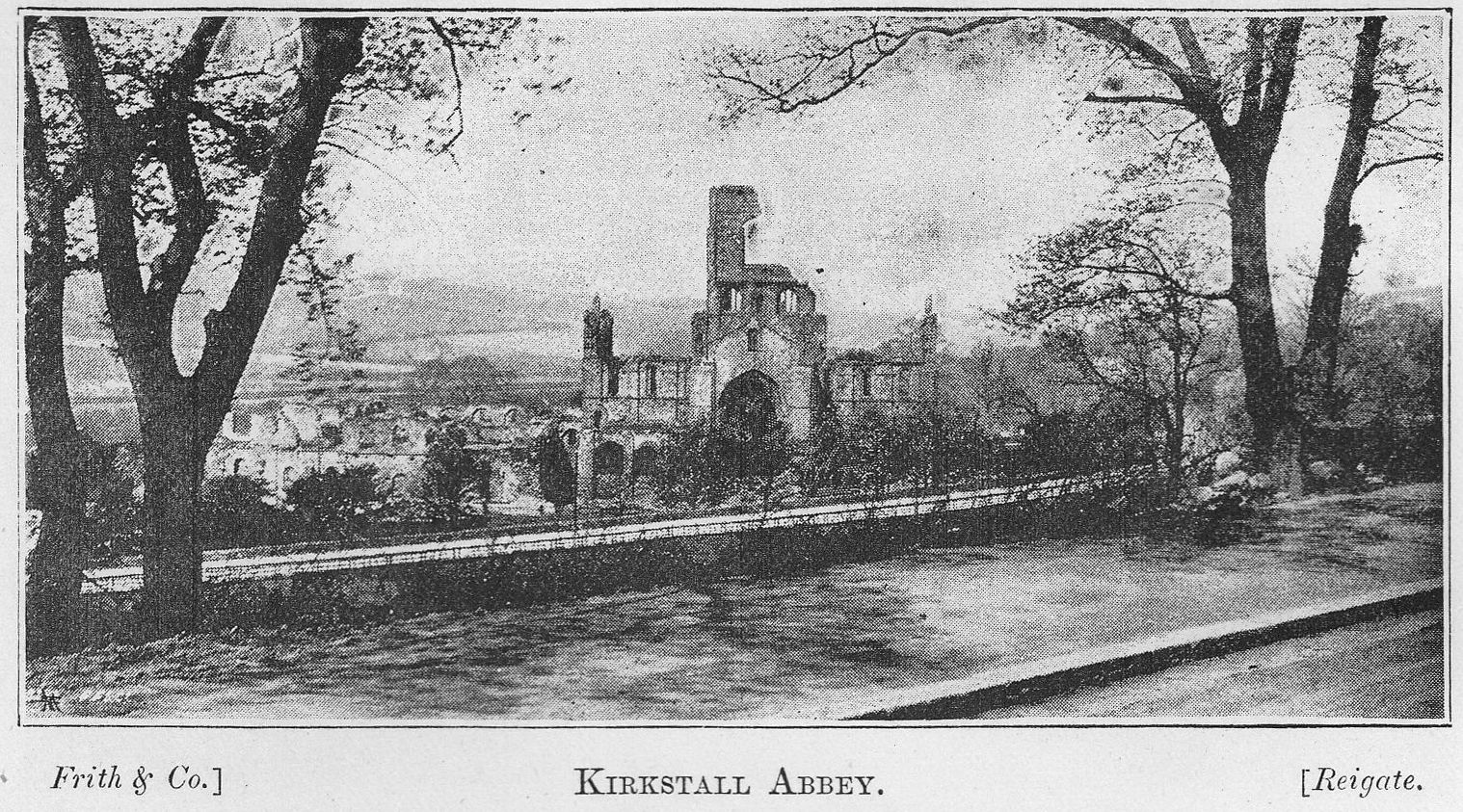
The Workhouse stands in the same grounds as, and ranges in a line with, the Industrial School, the two frontages presenting an appearance of a very imposing character. It matches its neighbour in design, the work being carried out in red brick. The cost of building was £32,000, and the foundation stone was laid on the 5th April, 1858.
In Beckett Street also is the LEEDS BURIAL GROUND: the ground is the property of the Corporation, and about 16 acres in extent. There are two entrances in Beckett Street, and chapels for use by members of the Church of England and Nonconformists have been erected, both similar in style. The grounds are neatly laid out, and well kept. WOODHOUSE CEMETERY, in Woodhouse Lane, near the Moor, is the property of a Company. It occupies a site of about ten acres, in a very pleasant locality, and considerable expense has been incurred in erecting a chapel and beautifying the grounds. The remains of the late Sir Edward Baines, M.P., lie buried here. Other places of interment within the borough are Headlingley Cemetery, Holbeck Cemetery, Hunslet Cemetery, New Wortley Cemetery, Upper and Lower Wortley Cemetery, and Armley Cemetery. With the mention of these somewhat lugubrious, though highly necessary items in the arrangements for the good of a community, we must conclude our summary of some of the most notable public and semi-public buildings and institutions of Leeds, and turn our attention to those devoted to’ the increasingly important subject of
EDUCATION.
Yorkshiremen are nothing if not shrewd and practical in their habits and dealings, and it would be singular if we did not find the “county of broad acres” taking a prominent part in the increased efforts made during the last few decades to further the spread of education, particularly of a technical kind, among the masses. This important factor in a nation’s progress has been the subject of innumerable warnings and appeals to the people of Britain, which have certainly not been in vain, if to them can be traced in any degree the existence of such institutions as
THE YORKSHIRE COLLEGE.
This fine building is situated in the Collage Road, an offshoot of Woodhouse Lane, but like many another now imposing institution, it first saw the light under much humbler circumstances. The need of its existence having been long recognised, its promoters, in 1874, saw that the time was ripe to put their design into execution, and the College was started in premises situate in Cookridge Street. From the first the scheme was as successful as the most sanguine could have desired, and after three years’ existence it was found absolutely necessary to provide more adequate accommodation.
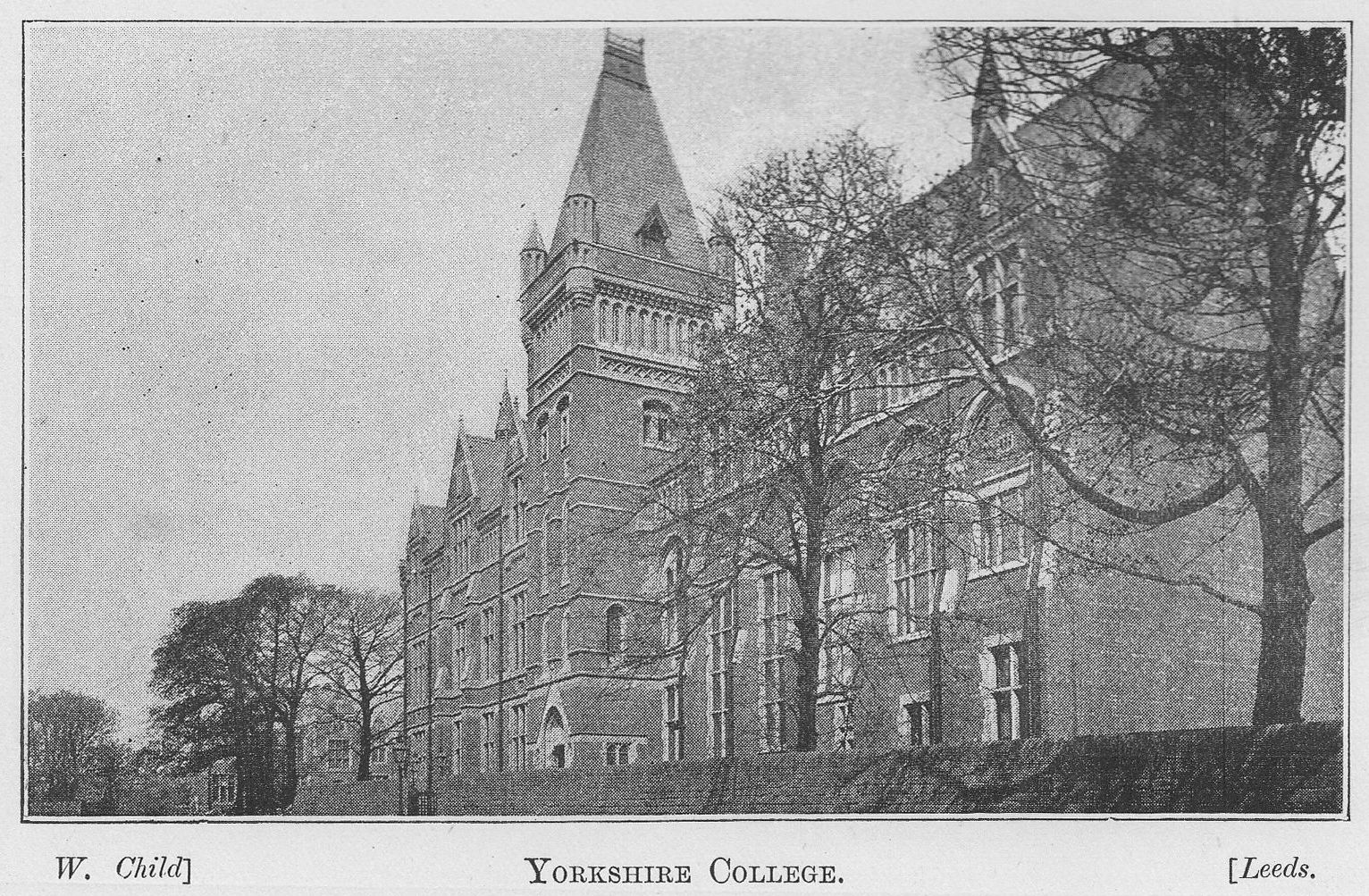
An appeal to those interested produced a most satisfactory answer in the shape of substantial donations, the Worshipful Company of Clothworkers, London, the Ackroyd Charity, and Sir Edward Baines displaying great munificence, together with a large number of other generous subscribers, and the present edifice is the outcome of their liberality.
The Beech Grove Hall estate being available, it was acquired from the proprietor, Mr. John Lawson, at a cost of £13,000, the site being about three-and-a-half acres in extent. Plans were prepared by Mr. A. Waterhouse, R.A., and on the 23rd October, 1877, the foundation stone was laid by the Archbishop of York, thus marking an event of high importance in the history of Yorkshire and Leeds particularly.
The design of the edifice is Gothic, carried out in red brick, with stone facings; the Sir Edward Baines’ memorial wing faces the College Road, and though the wants of the ever-growing population of Leeds are rendering its surroundings less and less rural every year, the grounds attached to the College retain enough growing timber to pleasantly relieve with foliage the massiveness of its construction. The internal arrangements of the building allow every accommodation for students, lecture-theatres, workshops and sheds, class and preparation-rooms, dining-hall, etc., being all provided for in the general scheme.
Agricultural and manufacturing industries are subjects receiving special attention here, but in order to set forth the objects of the College, we may appropriately quote from The Yorkshire College Calendar for 1891-92.
“The objects of the Yorkshire College are:— To found, endow, and maintain, in the County of York, a College or Colleges, and by means thereof, and by means of Lectures to be delivered in any towns or places in that County, or by such means as the Association think proper, to promote the education of persons of both sexes, and in particular to provide instruction in such sciences and arts as are applicable or ancillary to the manufacturing, mining, engineering, and agricultural industries of the County of York, and in ancient and modern languages, history and literature, medicine, surgery, law, logic, moral philosophy, and any other subjects of University or College teaching, and in such other branches of education as shall from time to time be directed by the Governing Body of the Association, subject to the following fundamental conditions, namely:— That no student, professor, teacher, or other officer or person connected with the College or Colleges, or the operations of the Association, shall be required to make any declaration as to, or to submit to any test of his religious opinions, and that the provisions of 15, 16, 17 and 18 of the Endowed Schools Act, 1869, shall form part of the regulations of the Association.
“The Yorkshire College is (with the Owen’s College, Manchester, and University College, Liverpool) one of the Colleges of Victoria University. The University has power to confer degrees on persons who have pursued a regular course of study in one of the Colleges of the University, and who submit themselves for examination.”
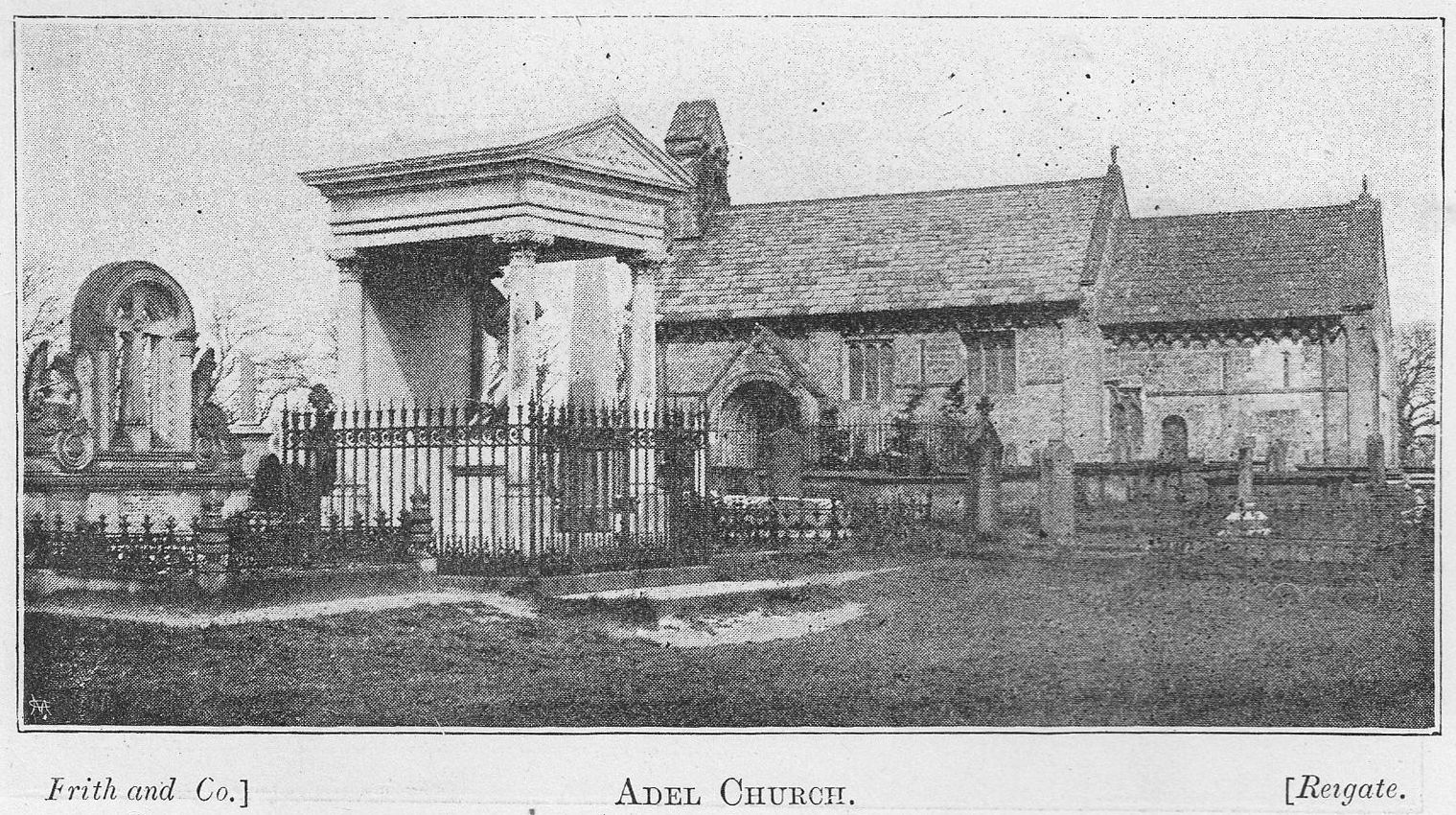
Students at the Yorkshire College can compete for the Derby, Mercer, and Gilchrist scholarships, and the Cobden prize attached to the Victoria University, and the following local scholarships are also open:—
THE CAVENDISH SCHOLARSHIP for investigation in any branch of natural science.
THE SALT SCHOLARSHIP, founded by late Sir Titus Salt, Bart., for proficiency in language and literature.
THE ACKROYD SCHOLARSHIPS for natural science — these are open to males only.
THE BROWN SCHOLARSHIPS for branches of science, applicable to industrial arts. If, in the competitions for these Scholarships, students should tie, preference is to be given to inhabitants or natives of Bradford.
THE BAINES’ SCHOLARSHIPS. Half of these to be awarded to candidates who have received instruction in Public Elementary Schools in the Borough of Leeds, and half to candidates selected by the Yorkshire Union of Mechanics’ Institutes.
THE CRAVEN SCHOLARSHIP.
THE ELMSLEY SCHOLARSHIP.
THE CLOTHWORKERS’ SCHOLARSHIPS, founded by the Worshipful Company of Clothworkers, in the City of London, for students in the departments of textile industries and dyeing.
THE LEEDS BOROUGH COUNTY COUNCIL SCHOLARSHIP, founded by the Council of the Yorkshire College out of £1,000 voted by the Leeds Borough County Council under the provisions of the Local Taxation (Customs and Excise) Act, 1890.
MEDICAL AND INFIRMARY SCHOLARSHIPS.
THE LEIGHTON TRUSTEES’ EXHIBITIONS, to enable deserving students at the Science Classes to carry on their studies at the evening classes at the Yorkshire College.
The College year is divided into three terms, the last year ending July 1st, 1892. Day students must be over 14 years of age, and those under 16 are required to pass an examination before being admitted. A residential hall for students is being prepared at Lyddon House, Virginia Road, and this, it was expected, would be open for the reception of inmates by October of the present year.
The President of the College is the Most Hon. The Marquis of Ripon, K.G., and the Treasurer, Sir Andrew Fairburn. The Governing Body consists of Perpetual Life Governors who have contributed £1,000 and upwards to the Institution; Life Governors who have contributed £250 and upwards; Governors elected by the members of the College; and Representative Governors. The noble work done by the College has long since justified its existence, and it is a monument of enlightenment and philanthropy of which the town may well be proud.
THE GRAMMAR SCHOOL,
another important educational establishment, is. pleasantly situated on Woodhouse Moor.
The foundation of this school is a very ancient one, dating back to the year 1552, during the reign of King Edward VI. It was founded by Sir William Sheafield, priest, who bequeathed certain estates yielding £4 13s. 4d. per annum towards the endowment of a school, on condition that the inhabitants of Leeds made this sum up to £10.
In 1556, this bequest was further augmented by Sir William Ermyslead, Canon Residentiary of St. Paul’s, and Chaplain to Queen Mary I., he leaving an estate, the revenue of which was to be applied to “the finding of one priest sufficiently learned to teach a grammar school in the town of Leeds,” the scholars attending at which were to pay one penny weekly, if able, but if not they could attend free. In 1580, the new chapel at the end of Lady Lane was purchased from the Crown for school premises, and 1624, John Harrison “built the school house in North Street in the middle of half an acre of his own land.”
The school was carried on here for two centuries, until in 1828, it was entirely rebuilt on the old site at a cost of a little over £1,000. In 1858, it was removed to its present location on Woodhouse Moor. The site of the building which, with playgrounds, covers about eight acres, was purchased from the St. John’s trust for £3,000, the cost of erection being about £13,000 more.

The fabric was designed by the late Edward W. Barry, Esq., architect, Westminster, in the Gothic style, and is similar in shape to a Latin cross, the class-rooms lecture-rooms, etc., occupying the two stories of the longer arm, while the shorter end is reserved for the head-master’s house. The gabled, transept is surmounted by a square turret with spire above.
A chapel, dedicated to St. Wilfred, has been added since the erection of the school, and there is ample provision made for all kinds of healthful recreation.
The curriculum is most liberal and comprehensive, and the school can boast of having trained many scholars who have made themselves famous in after years; among others, Sir Thomas Dennison, Kt., and Dr. Christopher Wilson, a former Bishop of Bristol.
There are several scholarships and exhibitions attached to the School, among its benefactors having been Lady Elizabeth Hastings. The Grammar School is of great service to residents in and about Leeds, and if not exactly fulfilling the object its original founders had in view - the free education of the poorer classes — it must be remembered that provision for this purpose, far exceeding the broadest imaginings of these departed worthies, have been made in these latter times.
The question of popular education has always received hearty support and sympathy in Leeds, and since the passing of the School Board Act in 1870, the rate of progress in this direction has not been surpassed by any town in the Kingdom.
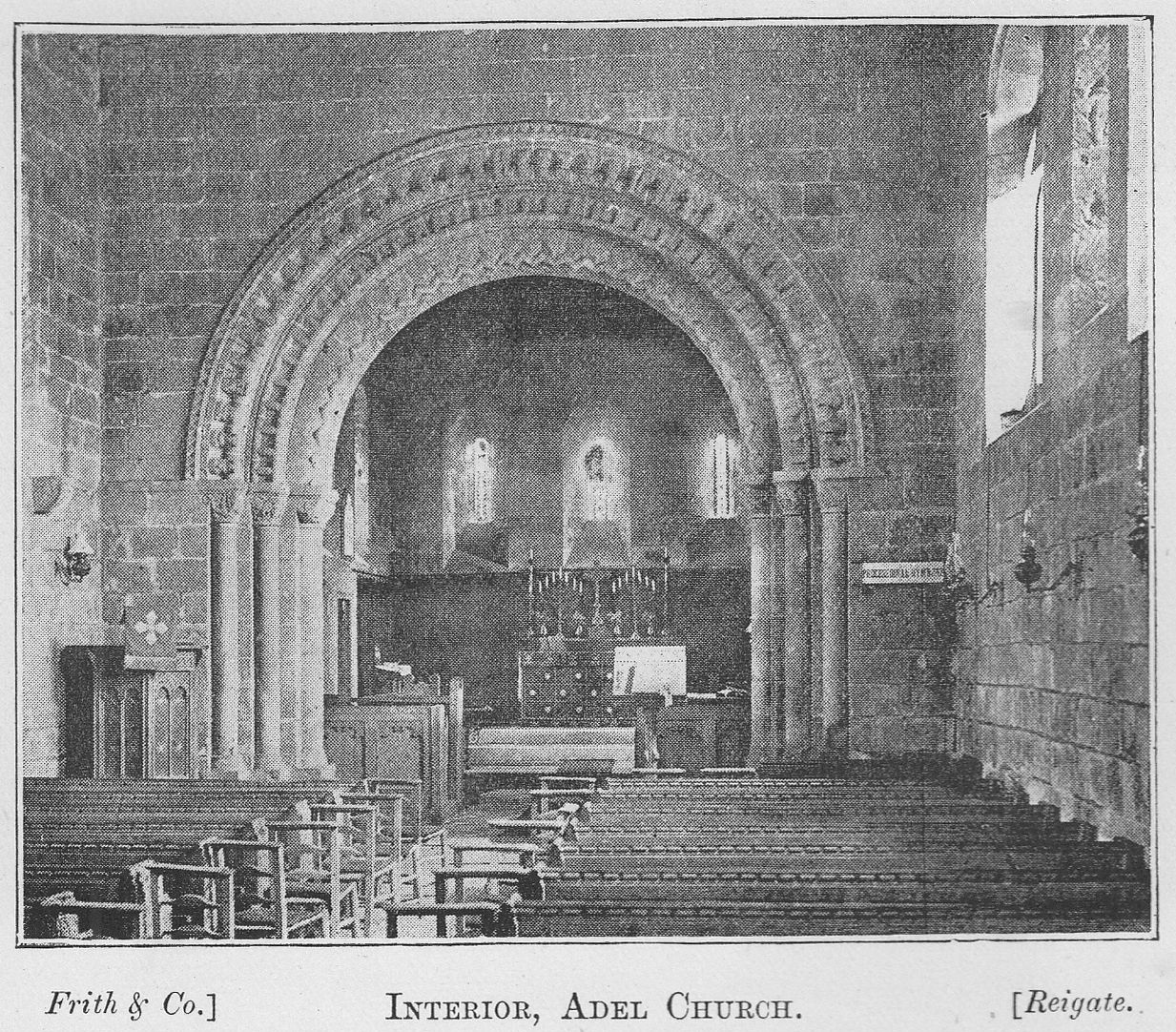
The recent legislation affecting education has also been taken advantage of to the full, and it may be opportune here to give statistics of the allotments of the “contributions for the purpose of technical education (Customs or Excise Duties) for the financial year ended 31st March, 1891.”
The Leeds County Council received, under the conditions of the Act, £5,884, out of which the following grants were made: Leeds School Board, £8,000; the Yorkshire College, £1,000; Leeds Mechanics’ Institute and Literary Society, £1,000; Evening Science and Art Classes Association, £200; Yorkshire Ladies’ Council, £100; Holbech Mechanics’ Institute, £141 10s.; Woodhouse Mechanics’ Institute, £141 10s.; Leeds Young Men’s Christian Association, £100; Armley Higher Grade School, £100: Wortley Working Men’s Institute, £50; Leeds Working Men’s Hall Institute, £50; the total sum granted being £5,888, within £1 of the sum at disposal.
Beneficent as it was in its character, the above Act was greatly surpassed in national importance by the Education Act of 1891, by means of which education was made absolutely free to those on whom the existing fees, small as they were, lay as a burden. By this Act the Imperial Government gave to all Board and Voluntary Schools, willing to accept it, a grant of 10s. per head for every scholar attending the schools. The Leeds School Board at once accepted the offer, and all schools under their jurisdiction were declared free, with the exception of the Higher Grade School, which reduced its fees from 9d. to 6d., this being the full amount of the grant obtained. The Evening Classes at the Schools, not included in the Act, were also indirectly benefited, as the Board, recognising that the abolition of fees would mean increased attendance, and consequently an increase in the amount granted, decided to return the whole of the fees paid by scholars who attended the Evening Schools every time they were open, and the greater part of the amount paid to those who attend regularly.
Under such conditions “Young Leeds” should go forth well equipped for the battle of life, and if education is the real panacea for many of the troubles and hindrances to success of the present generation, the next should enjoy a state of things to be envied.
In so brief an account as the present one necessarily is, it is impossible to go fully into the great work done by the Leeds School Board since it was first brought into existence, but the particulars we give, culled from the Seventeenth Triennial Report of the Work of the Board, will show the immense advance made between 1870 and 1891 to qualify the children of the borough “to perform justly, skilfully, and magnanimously the offices of a citizen of this great community.”
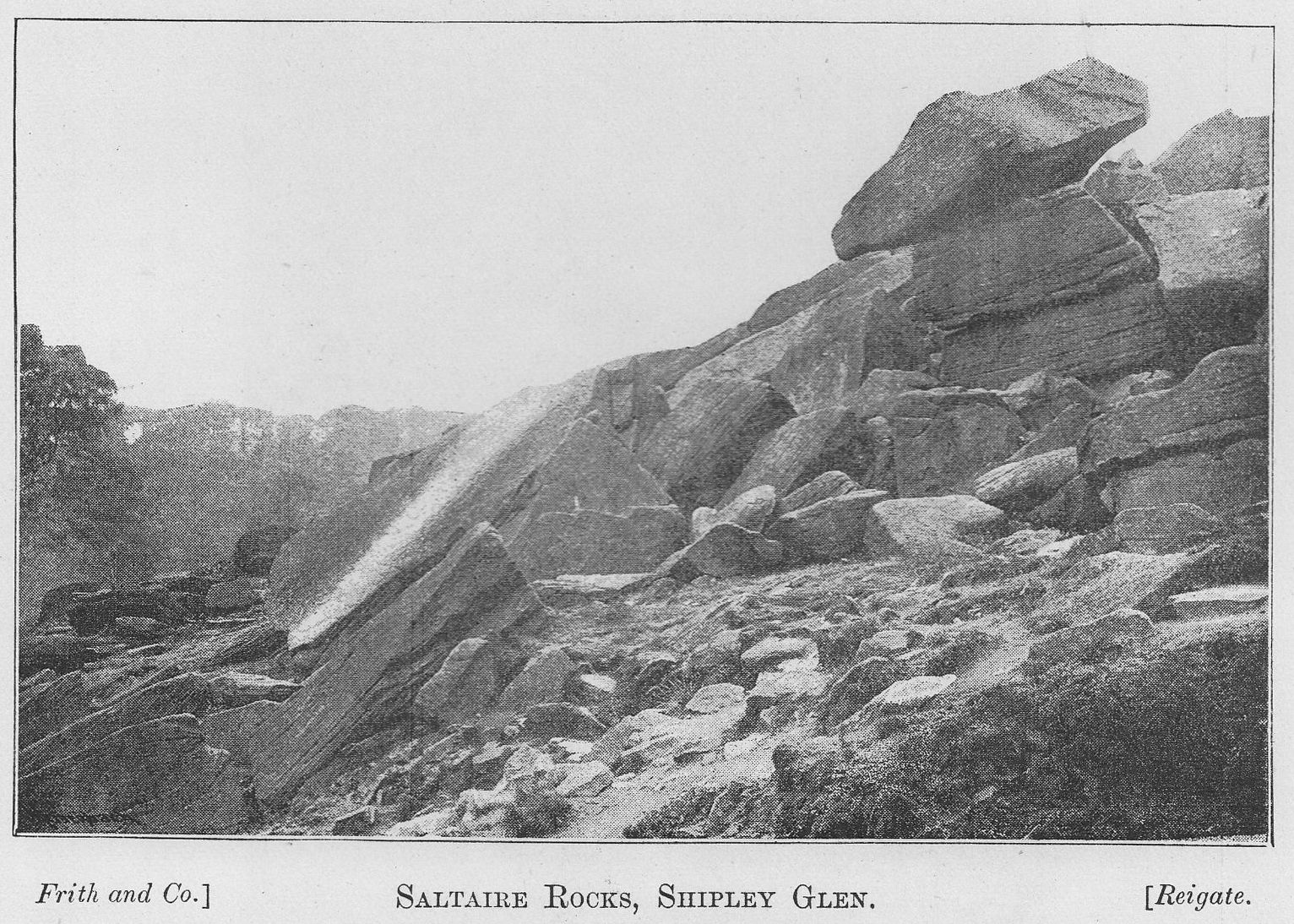
In 1870, Board Schools were non-existent in Leeds, and the number of children on the Rolls of Public Elementary Schools was 22,556; the population of the town at that time being 259,000. In 1891, when the population had risen to over 367,000, and the School Board had been in existence some 20 years, we find the Board in possession of 58 blocks of School Buildings, many of them very large and handsome structures; these, including other Board Schools in process of erection affording accommodation for 47,000 children; the grand total of children on the Rolls of Public Elementary Schools, both Board and Non-Board having increased to 58,574; a further increase having since become apparent.
This increase, far more than proportionate to the growth of the population, is satisfactory proof of the efficient manner in which the indefatigable members of the Board who have been elected by their fellow citizens from time to time have carried out the work entrusted to them. It is also worthy of note that the exploitation of personal fads which has in many instances caused the Board School system of education to be looked upon as anything but an unmixed blessing by the British ratepayer, has been conspicuous by its absence in the working of the Leeds School Board. Not that the Board have been unmindful of the necessity of providing pupils with further advantages in the shape of increased opportunity for mental and physical recreation; the schools allow of ample facility for indulging in the latter, and arrangements have just been made whereby girls and boys from the Board Schools may visit the public baths weekly and receive instruction in swimming at the nominal sum of one penny each per visit.
Many of the schools also possess libraries consisting of works on suitable and well-chosen subjects to which the scholars have access, it being, we believe, the intention of the promoters of the scheme that every Board School shall ultimately have a library in connection therewith: the said scheme has been largely helped by the practical and generous assistance of the public authorities in charge of the Borough Libraries.
Perhaps the crowning point to the work of the Board is to be found in the CENTRAL HIGHER GRADE SCHOOL, of which the Consulting Architect of the Education Department of Great Britain, E. R. Robson, Esq., F.S.A., has said that it is “the best and most completely-organized school” he has seen. The school is intended for pupils in the 6th and 7th standards. There are in all 280 Scholarships in connection with the school, 100 of which are given free to intelligent children recommended to the Board, the value of the scholarships being £18, tenable for 18 months, in lieu of wages that the scholars might otherwise be receiving. The remaining scholarships, tenable for three years, are open for competition each year to children attending any of the Public Elementary Schools of the Borough, and are of great value to those whose education might, except for this assistance, have to be terminated at a much earlier date. The Free Scholarships admit their holders to all the classes of the school, and no charge is made for text books used in conjunction therewith. The institution is altogether a model one, and well merits the praise that has been bestowed upon it as “the finest and best-equipped school in this or in any other country.” Its salient features of construction and accommodation are concisely summed up in the report before alluded to in the following words:— “Accommodation is provided for about 2,500 scholars. The utmost attention has been bestowed on the lighting, warming, ventilation, and sanitary arrangements of the building; the fittings are of the most approved designs calculated to ensure the comfort of the pupils, and to secure the best educational methods. The Chemical Laboratory is one of the largest and best-equipped in the kingdom; the Physical Laboratory is fitted and furnished for enabling pupils practically to perform what the Demonstrator has shown in the Lecture Theatre. Commodious play-grounds are provided for recreation; and pupils coming from a distance can have their luncheons, warm if desired, in comfortable dining-rooms.” The Board have also established three Industrial Schools, affording accommodation for about 700 children, and the practical results of these institutions is to be found in the marked diminution of juvenile crime in the Borough.
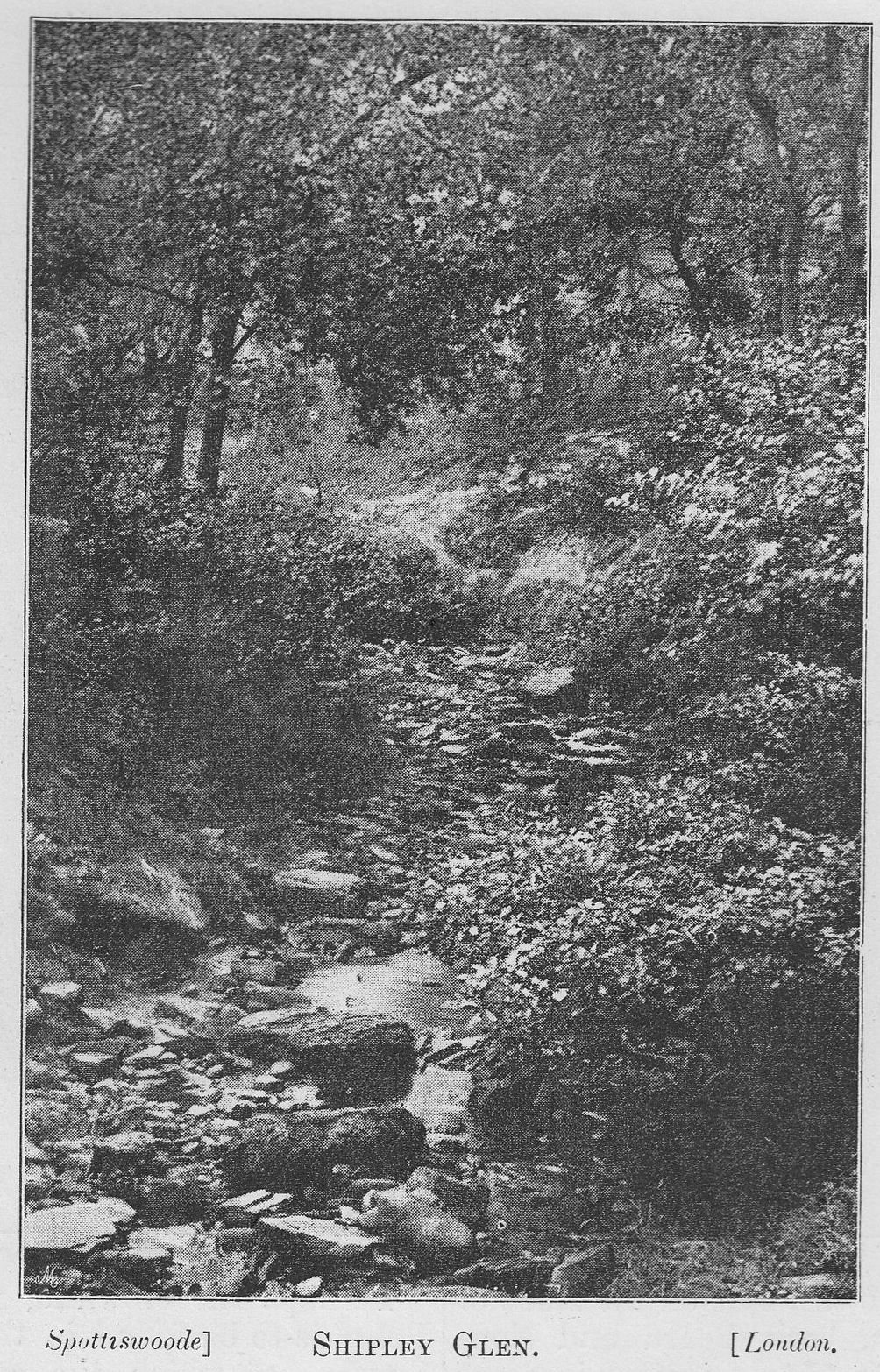
THE MECHANICS’ INSTITUTE AND SCHOOL OF ART in Cookridge is another prominent intellectual centre, and in fact there is no town in England possessing greater advantages in the way of popular education and culture than Leeds. Private schools exist in plenty, affording ample opportunity for those whose circumstances render it undesirable or unnecessary for them to take advantage of the benefits of Free Education, to give their children a course of training suitable to their station in life. The “thoroughness” with which Yorkshire men enter into everything they undertake, whether in business or social life, has long been recognised as characteristic of the men bred in the county of the White Rose; and is equally observable in their recreative pursuits as in the more practical affairs of life. Mediocrity has not much chance in Leeds; only the best is wanted, but when it comes it may be sure of a hearty welcome and support. The town has always been. noted for the interest taken in musical matters by its inhabitants, who may well be pardoned for the pride they taken in the
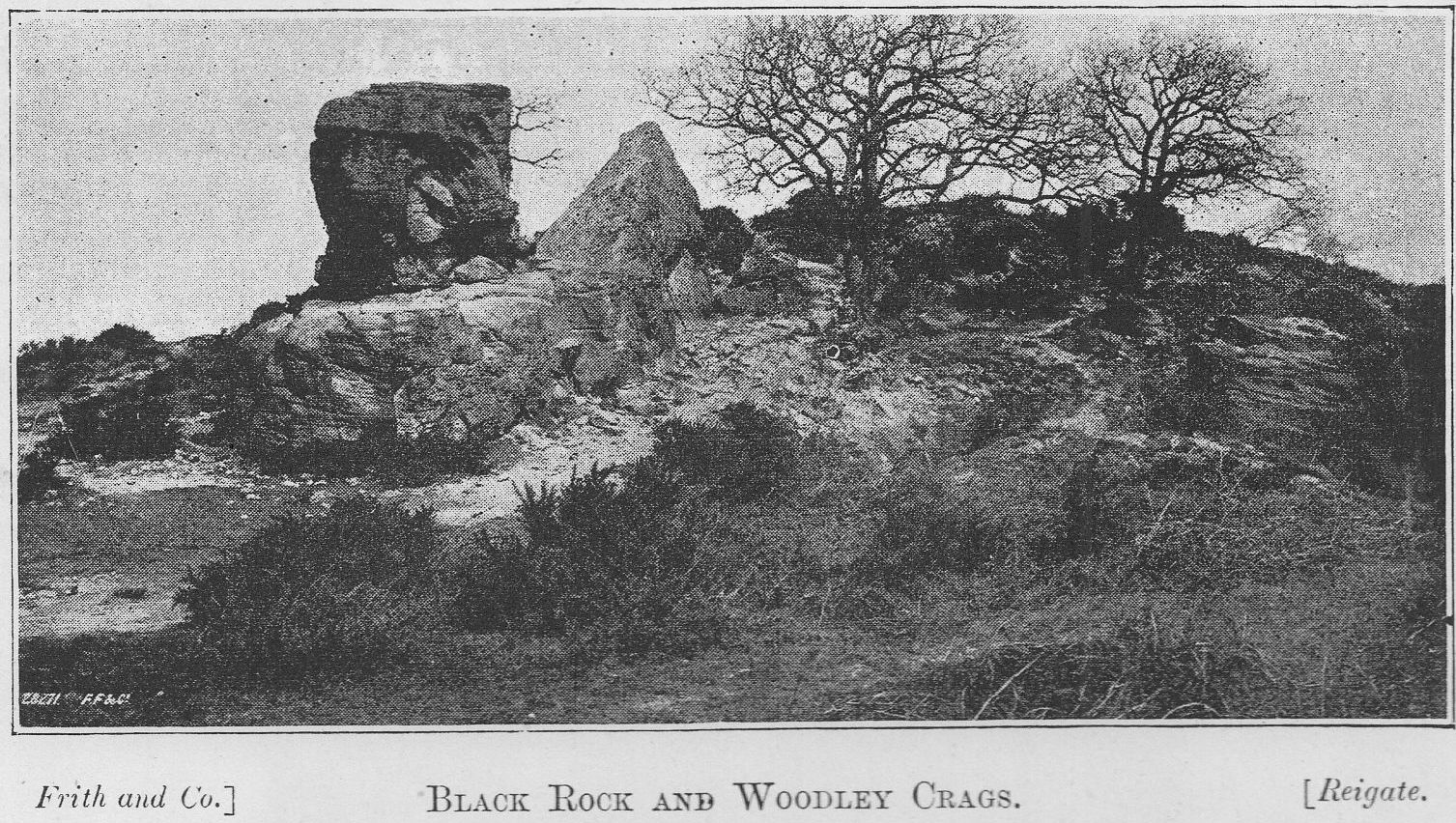
LEEDS TRIENNIAL MUSICAL FESTIVAL,
an event that may be described as of world-wide interest, attracting as it does visitors from all quarters of the globe, and to attend the eighth anniversary of which these visitors are, as we write, present in Leeds in greater force than ever.
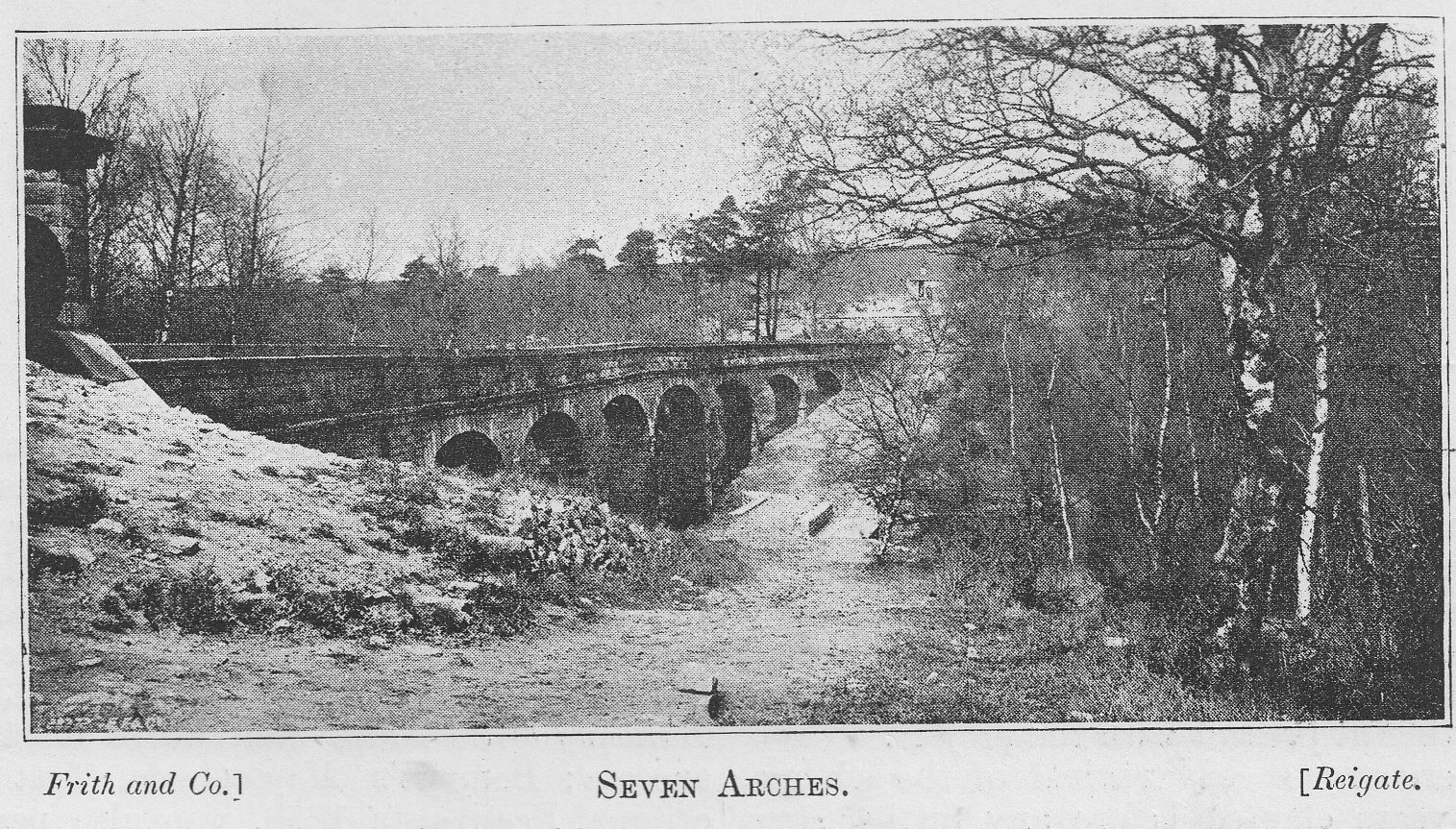
Of the fame of the Yorkshire choirs there is no need to remind our readers, they are unequalled by any similar organizations in the world both for purity of voice and the masterful interpretation of the most difficult works of the great masters. In London, at the Crystal Palace and other places, Yorkshire singers have again and again won the admiration of critical audiences, and at all events as regards choir-singing Leeds Festival can claim superiority over all other Festivals held in this country. The history of the Festival has been one unbroken record of successes from a pecuniary as well as an artistic point of view, and has been the means of introducing to the world many of the most celebrated modern musical compositions.
The first great Festival took place in September, 1858, and formed a graceful portion of the ceremonial programme mapped out in honour of the opening of the Town Hall by Her Majesty the Queen, who has been patron of the Festival ever since. The enterprise, started under such auspicious circumstances was highly successful; a brilliant programme, extended over four days, was carried out, and the Leeds Medical Charities, to which we may mention the profits accruing from the Festivals are always devoted, benefited to the extent of £2,000. Professor W. Sterndale Bennett was the conductor, and the list of chief vocalists included Mdme. Clara Novello, Mrs. Sunderland, Mdlle. Piccolomini, Miss Dolby, Mdme. Albani, Mr. Sims Reeves, Signor Giuglini, Mr. Weiss, Mr. Santley, etc., Miss Arabella Goddard being the solo pianist. The programme included “Elijah,” “The Messiah,” “Israel in Egypt,” “Mount of Olives,” “Stabat Mater,” part of Haydn’s “Seasons,” Bach’s “Passion Music,” and Sterndale Bennett’s “May Queen” which was produced for the first time.
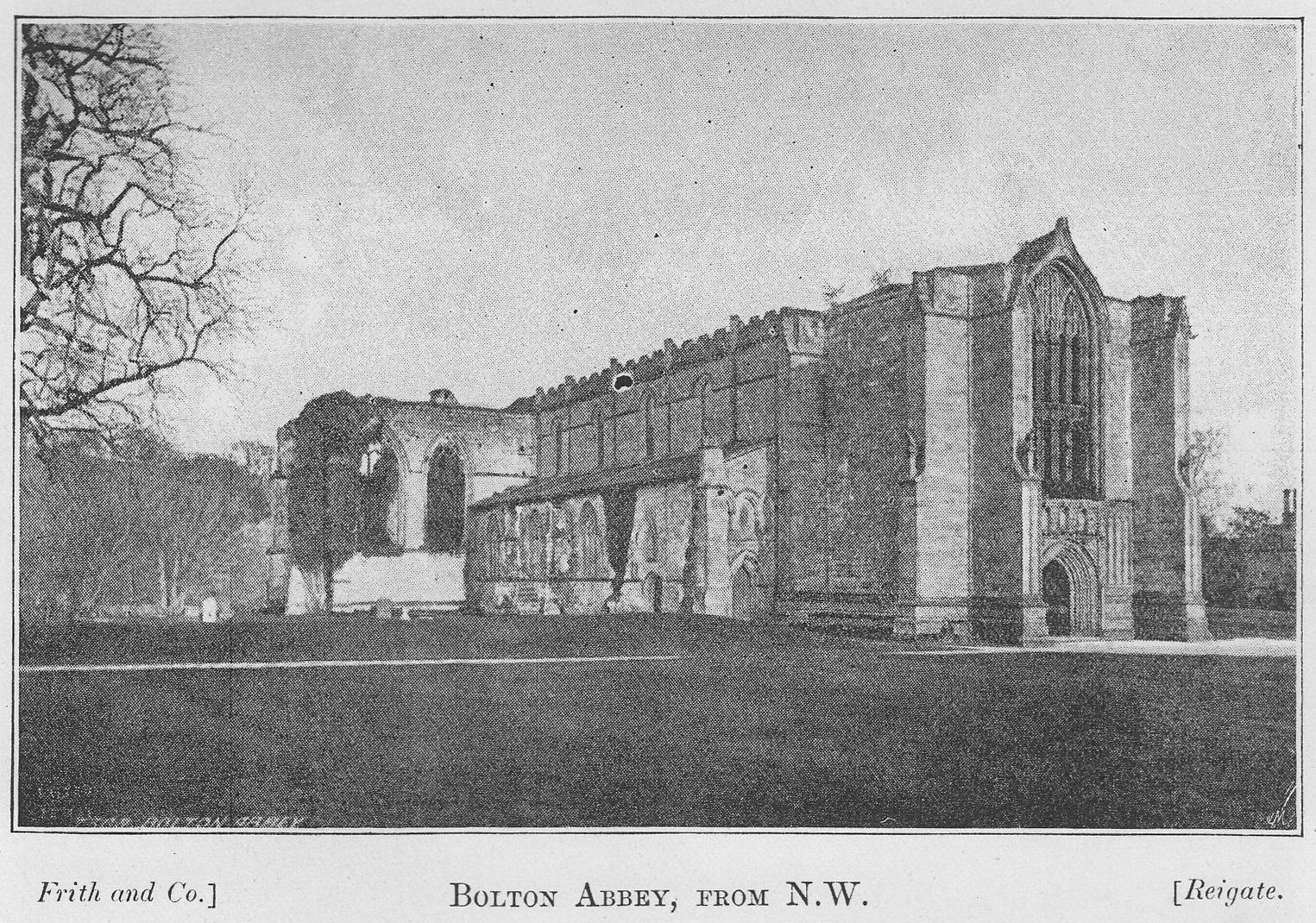
The success achieved by the Festival naturally inspired the musical portion of the community with the hope that the event should become a Triennial one, and in the January of 1859, a meeting was held by members of the first Festival Committee, and a second Festival, to be held in 1861, was decided upon. In 1860, further steps were taken: Dr. Sterndale Bennett was again invited to conduct, preliminary arrangements with principal vocalists made, and the list of works to be performed partially chosen; but from this point difficulties, which eventually proved insurmountable, presented themselves, and instead of 1861 witnessing a recurrence of the Festival a resolution was passed by the Committee to the effect that it was not desirable to proceed further at present with the project.
Nor was there any speedy revival of the scheme, and thirteen years elapsed before any further steps were taken in the matter. In 1874, the then Mayor, the late Alderman Marsden, a gentleman ever deeply interested in anything conducive to the advancement and prosperity of Leeds, was chiefly instrumental in again arousing public interest in the matter, and another Festival took place, though not before many difficulties similar to those which proved too much for the former attempt had been overcome. Sir Michael Costa was the conductor on this occasion, and the artistes engaged represented as before the very best talent procurable, Mr. Sims Reeves, and Mr. Santley again taking part in the productions. “St. John the Baptist,” by Professor Macfarren, and the “Bride of Dunkerron,” a cantata, by Henry Smart, were performed for the first time in Leeds; the remainder of the programme being made up of standard works. The receipts of the Festival amounted to £7,609, of which £1,000 was given to the Medical Charities.
Since that time Leeds Festival, to use a trite expression, has never looked back. In 1877, the undertaking was attended with even greater success, and was signalised by the production of Professor Macfarren’s oratorio, “Joseph,” a work specially-written for the occasion. Sir Michael Costa was again conductor. In 1880, arrangements for the Festival were made on a much larger scale, the chorus and band being brought up to 420, and Sir Arthur Sullivan (then Mr.) engaged as conductor. Two important compositions W9re specially written for the event, these being Mr. Sullivan’s “Martyr of Antioch,” and Mr. J. F. Barnett’s “Building of the Ship,” both works meeting with great success; Bennett’s “May Queen,” first given at the original Festival in 1858, was also performed. The resulting profits this year were £2,830, of which £2,000 was given away, and £330 kept in hand as a Reserve Fund.
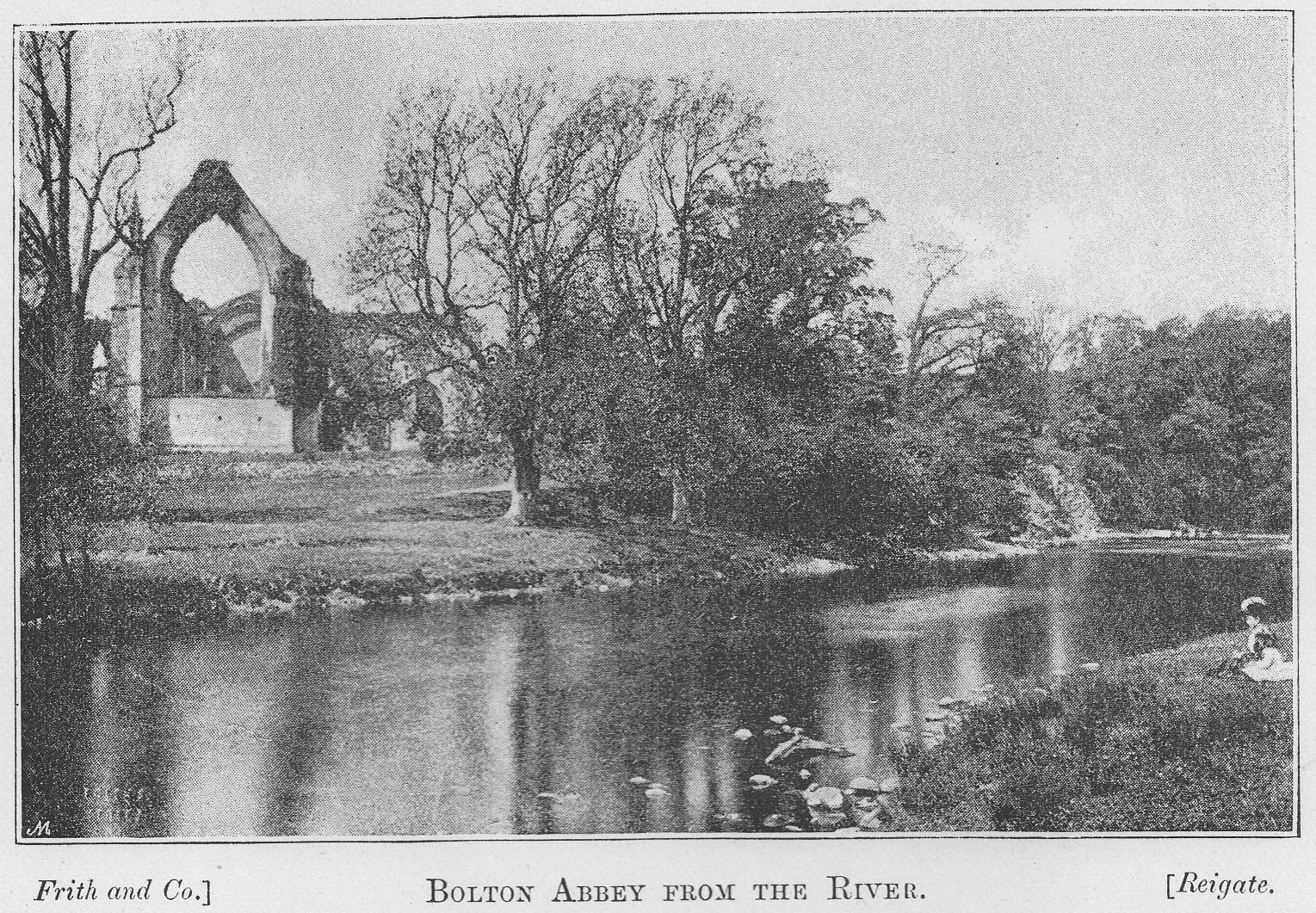
The Festival of 1883, saw the production of three new English works, these being an Oratorio by Sir G. A. Macfarren, entitled “King David;” “Gray’s Elegy,” a cantata, by Mr. Alfred Cellier (now deceased); and a setting of the “97th Psalm,” Mr Joseph Barnby. The “End of the World,” an oratorio, by the late Joachim Raff, was also produced for the first time in England. Sir Arthur Sullivan again filled the post of conductor which he has continued to do down to the present time (1892). The Medical Charities were benefited on this occasion to the extent of £1,950, and the reserve fund increased to £1,100. The Festival of 1886 will long be memorable as the date of the production of Sir Arthur Sullivan’s “Golden Legend,” a work that achieved an instantaneous success, and is at the present time one of the most popular of modern classics. Besides this work three other specially-written English works were given: “The Story of Sayid,” by Dr. A. C. Mackenzie; “The Revenge,” by Dr. Villiers Stanford; and a concert overture by a Leeds musician, Mr. F. K. Hattersley. The financial result was most gratifying, the Medical Charities again benefiting to the extent of £1,950, while the reserve fund was largely added to.
The programme for 1889, included specially-written works by D. Hubert Parry, and Mr. F. Corder, these being the “Ode to 8t. Cecilia,” and the “Sword of Argantyr;” the “Golden Legend” was repeated; also another new work by Dr. Villiers Stanford, entitled “The Voyage of MacDune.” The Festival was marked by the same success as has hitherto attended it, and of which happily there seems no prospect of abatement. For the present year, 1892, very complete preparations were made, and two novelties, a symphony, by Mr. Frederic Cliffe, and a cantata, “The Arethusa,” by Mr. Alan Gray, have been given. The Festival opened on October the 5th, and continued on the 6th, 7th and 8th. According to arrangements, Sir A. Sullivan again conducted. The severe illness from which this popular and talented musician has just recovered had caused grave misgivings in the minds of his many Leeds friends and admirers, and his return to work is naturally a matter of great congratulation. It is most gratifying to everyone connected with the Festival that he has been able to occupy his customary position in connection therewith, and it is to be hoped that he may yet be present at many recurrences of a Festival he has so much helped both by his skill as a composer and as a conductor. The Festival just over has been as successful as those that have gone before it, and those who have laboured long and earnestly for its permanent establishment are justly proud at seeing it one of the very foremost of English musical events. The Festival is managed by General and Executive Committees, of which Alderman F. R. Spark is the indefatigable Honorary Secretary: this gentleman has just published a history of the Leeds Musical Festival, the work dealing in the fullest manner with the workings of an institution in which every educated inhabitant of Leeds takes a deep interest. The Festival Offices occupy part of the basement of the Municipal Buildings.
Besides the more serious business of the Festival, music is held in high estimation by the people of Leeds: there are several choral societies and institutions of a similar character in existence in the town, and the majority of the public entertainments given are of a more or less musical character.
The Leeds Theatres are two in number, these being the Grand, in Briggate, and the Theatre Royal, in King Charles’ Croft.
Of athletic pursuits generally, and football and cycling in particular, the youth of Leeds are most ardent supporters. Cricket is, of course, no less popular, and hopes ran high at the commencement of this year’s season that Yorkshire would make a bold bid for the County Championship; unfortunately, these hopes were not destined to be realised.
The Borough returns five members to Parliament, namely, The Bight Hon. W. L. Jackson, M.P., Mr. W. Balfour, M.P., Mr. L. Gane, Q.C., M.P., Mr. H. J. Gladstone, M.P., and Mr. J. L. Walton, M.P. The result of the 1892 elections left the representation of the Borough the same as after the elections of 1886; but, by the elevation of Lord Lyon Playfair to the Peerage, a vacancy was created and filled by Mr. J. L. Walton, M.P.
THE ENVIRONS OF LEEDS.
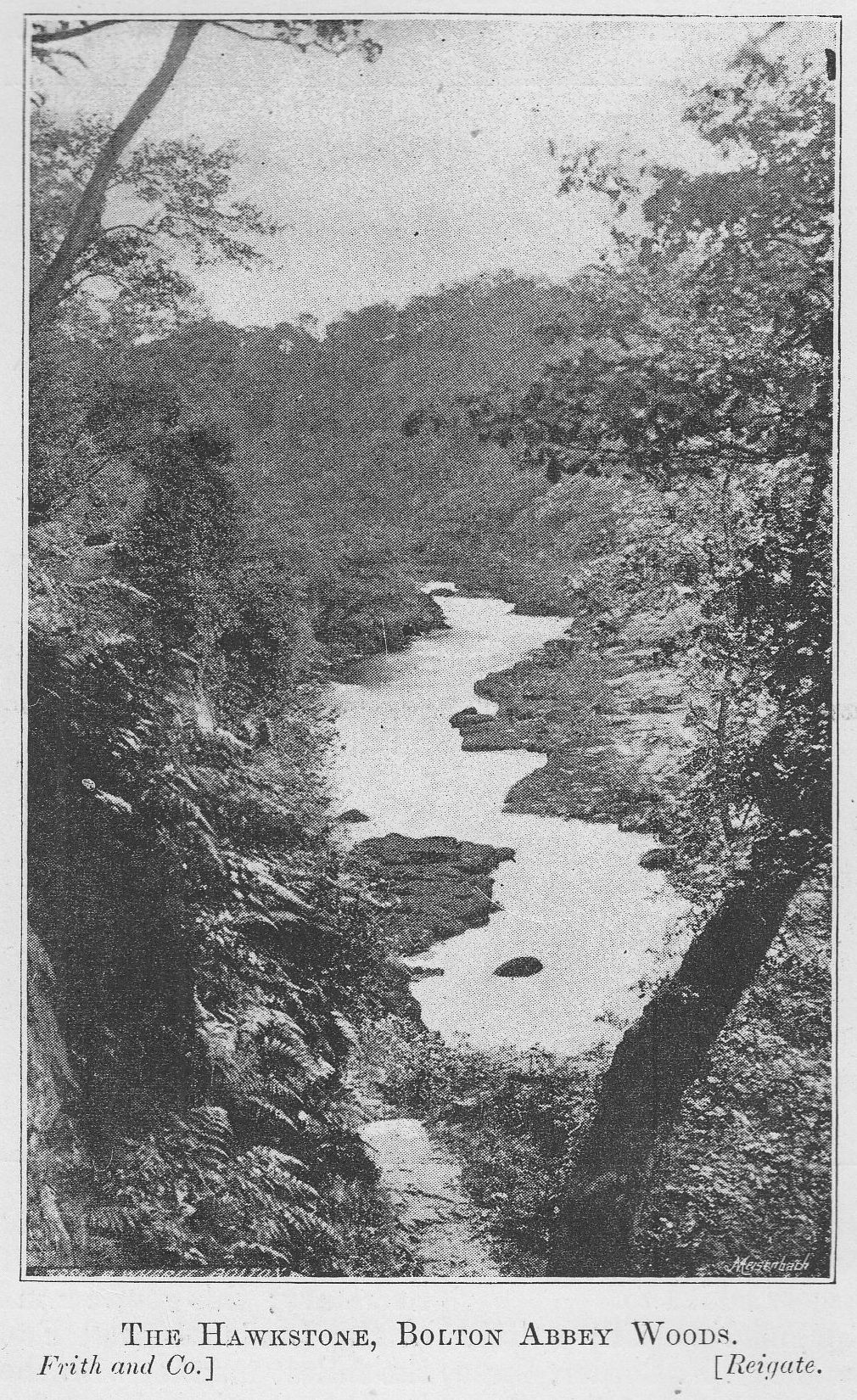
Leeds is not beautiful; this, we think, will be freely acknowledged by all who live in, or have any acquaintance with the place. In many respects it is desirable enough, but those who wish for beauty and rusticity must go outside, and, in some directions, far enough outside, the town boundaries. Hunslet, Holbeck, and Armley way, huge forges, factories, and works extend for miles, and not until well past Wakefield does the passenger journeying southward emerge from the smoke and grime into anything like real country scenery.
Towards Kirkstall it is nearly as bad, but here all trace of beauty is not lost, and the grand ruin of Kirkstall Abbey, presented to the people of Leeds by Colonel North, still stands in magnificent decay, surrounded by enough rural scenery to form a pleasant frame to the beautiful picture it presents.
In North Leeds, a most popular resort is Woodhouse Moor, a fine open space which Nature and artificiality combine to make a most agreeable promenade. The greater part of the moor is simply common, but other portions of it are tastefully laid out with flower-beds, shrubberies, and asphalted paths, ample seating accommodation being provided. A capital band performs here during the summer months. Further on is Headingley, a pretty suburb in which the recreation-ground mentioned before is situated.
But the crowning glory of Leeds possessions has yet to be mentioned; we refer to Roundhay Park. Boundhay is the lung through which an enormous number of human beings inhale the fresh and uncontaminated breezes of heaven; and pleasant indeed must the blue water reflecting the cloud-flecked sky, the rustling foliage of many tints, the soft springy turf, and the songs of birds be to those whose existence is mainly spent in the fierce heat of the foundry, or amidst the ceaseless whirr and rattle of machinery. There are several ways of reaching Roundhay, either on foot (the journey from Briggate is about three miles), on a cycle, by ’bus, wagonnette, or electric tramcar. Once in the Park there is plenty to see and admire, the most striking object being the Waterloo Lake, a sheet of water thirty-five acres in extent, and over half-a-mile in length.
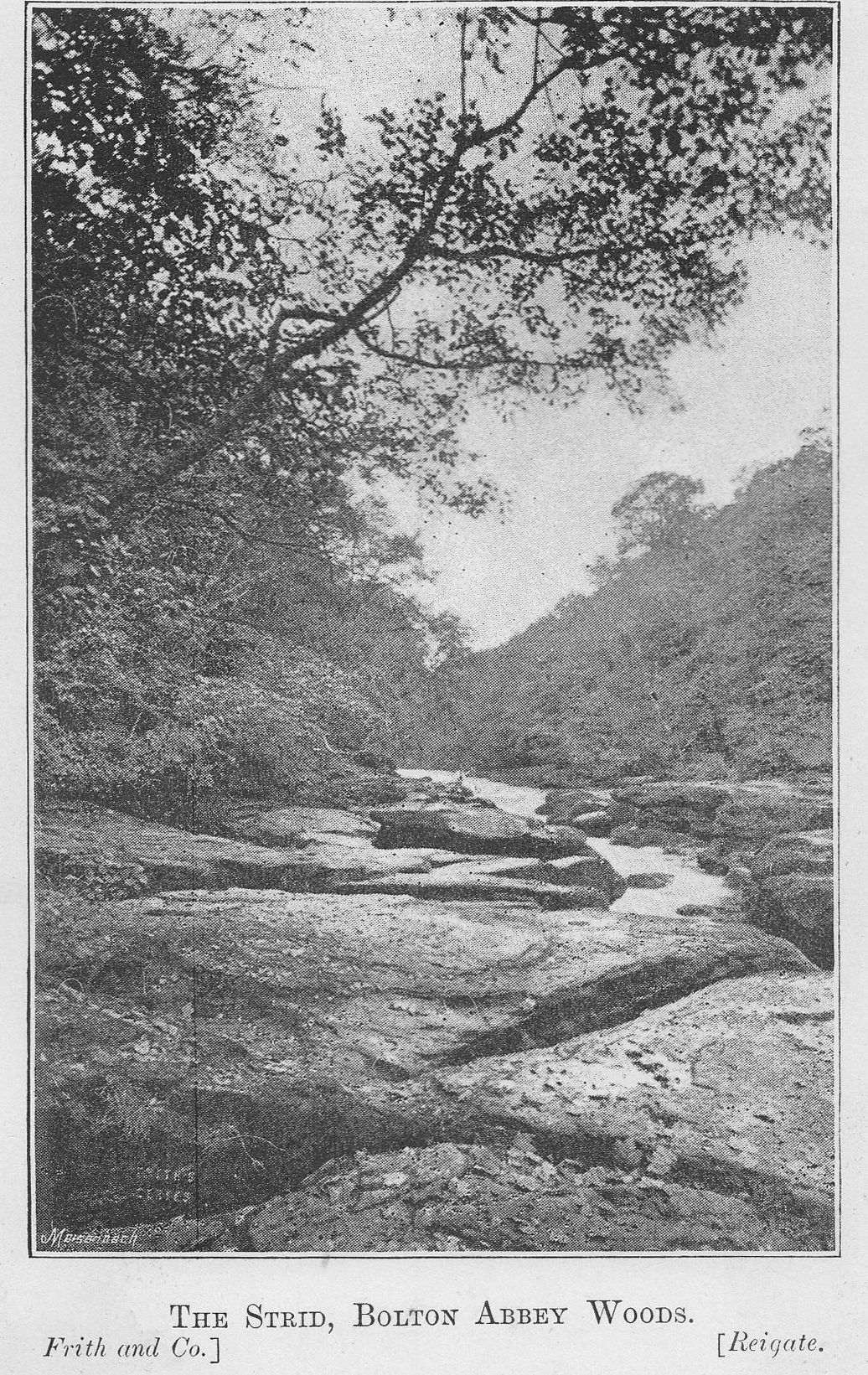
Passing from the upper portion of the lake into the Gorge, beautiful, if not actually romantic views of wooded hill and purling brook may be enjoyed, the ground being covered in the early summer with a rich purple carpet of wild hyacinths, plentifully besprinkled with the white stars of the Anemone.
On higher ground is the Upper Lake, a much smaller pool than the Waterloo Lake, but equally beautiful on a smaller scale. On the crest of the hill is the Mansion, the one-time residence of the Nicholson family, from whom the property was bought by the Corporation. It is now used as Refreshment Rooms. We should, before quitting the Park, mention the Fountain, which was presented by Mr. J. Barran, M.P.: it is a graceful structure of the classic order, having a domed roof supported on eight columns. Another object of interest is the Waterfall, over which the surplus waters of the large lake discharge themselves.
PORTRAITS OF LEADING MEN.
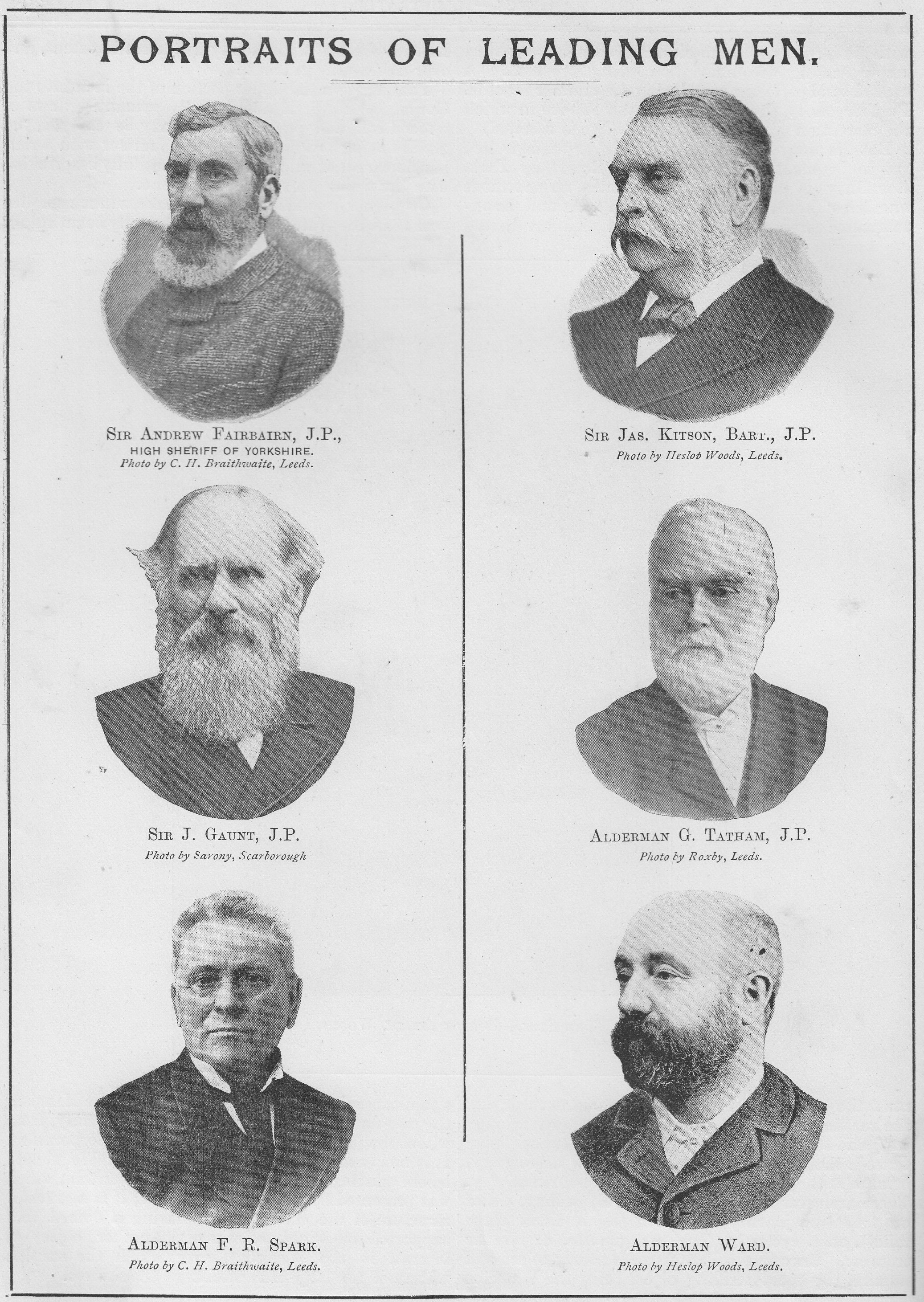
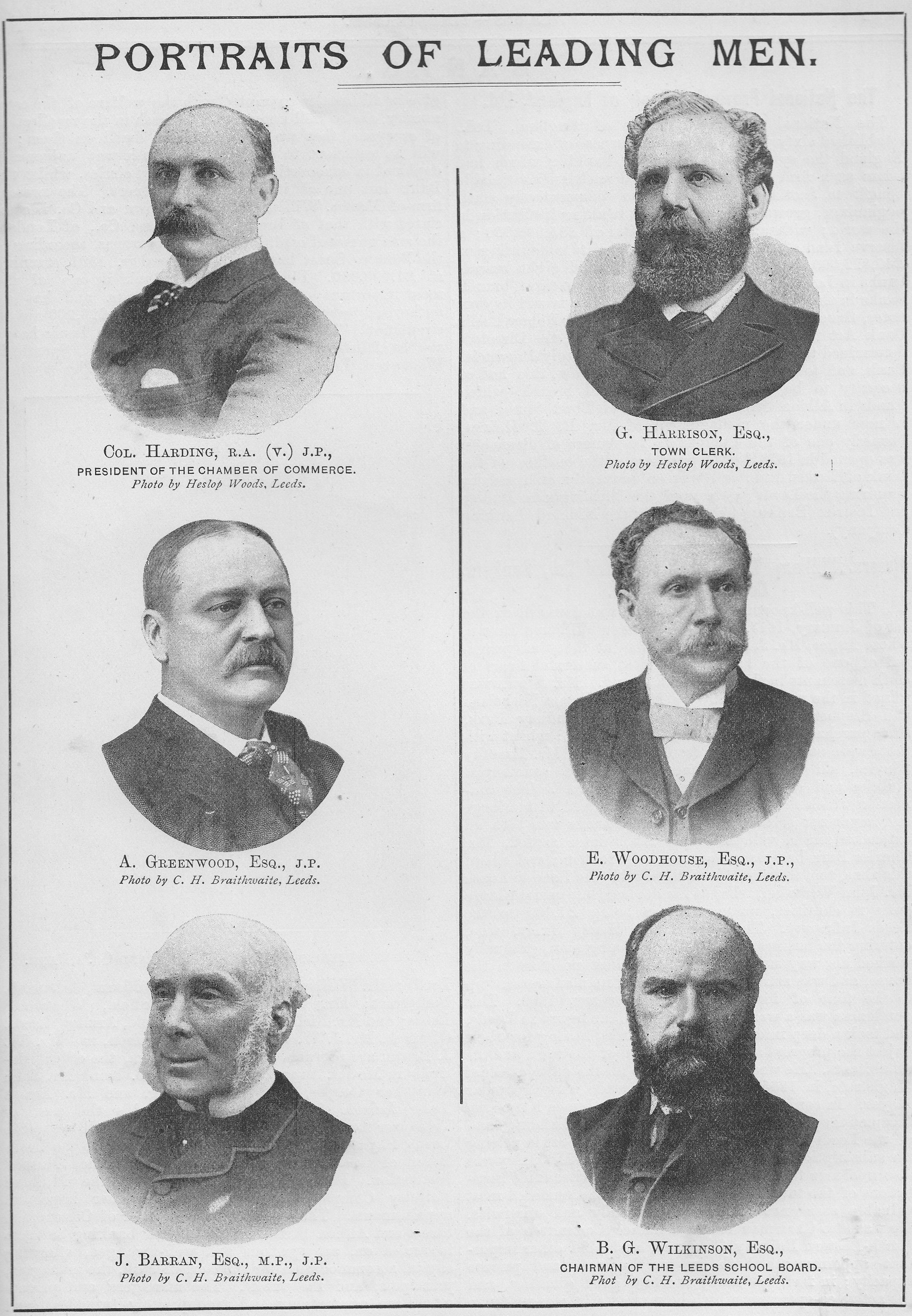
BANKS.
THE NATIONAL PROVINCIAL BANK OF ENGLAND, LTD.
The National Provincial Bank of England, Ltd., established sixty years ago for the purpose of extending to England the system of joint stock banking which had taken such firm root in, and proved such an inestimable benefit to, Scotland, has now, from comparatively small beginnings, grown to be the largest banking institution in the world; with a subscribed capital of £15,900,000; a reserve fund of £1,725,000; and deposits amounting to £40,822,000; and having a head office and eight branch banks in London, and one hundred and fifty-eight branch banks in the provinces. Formerly the Bank issued its own notes, the circulation being limited under Sir Robert Peel’s Bank Act to £455,000; but when, in 1866, the Directors determined to abandon the position of a purely Provincial Bank, and to open public offices in London, this had of necessity to be abandoned. The local branch, which stands in Albion Street at the corner of Bond Street, and is now under the management of Mr. R. T. Haines, formerly one of the Company’s Inspectors of Branches, was opened in 1878, by the purchase of the business of the Bank of Leeds, Ltd., and was subsequently enlarged by acquiring the Leeds business of the Birmingham, Dudley and District Banking Co. (formerly the Midland Banking Company).
MESSRS. WILLIAM WILLIAMS BROWN AND CO., BANKERS, COMMERCIAL STREET.
This well-known banking house was founded on the 1st of January, 1813, by Mr. William Williams Brown, whose father, Mr. James Brown, was at that time principal of one of the largest and most successful firms of cloth merchants in the north of England. Mr. Brown was joined in the proprietorship by Messrs. Thomas Nicholson and Stephen Nicholson (formerly of Roundhay Park, since purchased by the Corporation of Leeds); whilst with them were associated Mr. Joseph Janson and Mr. Timothy Rhodes, all being gentlemen of shrewd commercial abilities and considerable financial resources. The connection which the Bank thus at once formed with a large and important section of the woollen trade was both an extensive and a valuable one. At a later period, Mr. Charles Barr became a member of the firm, and about this time, too, there was associated with the London house Mr. John Whitaker, who, at his decease, left various large sums to charities, amongst, these being £1,000 to the Leeds Infirmary. Then came Mr. Henry Oxley, who, entering the business in 1823 as a young man, gradually worked his way upwards to the highest position in the house, and was actively identified with its management up to the time of his decease in February, 1890. This gentleman was a well-known and familiar figure in Leeds, and took a deep interest in many works having for their object the progress and general good of the town and its inhabitants. He was twice elected to fill the office of Chief Magistrate, in 1865 and 1872, and made a most popular Mayor. In conjunction with the late Mr. James Kitson, he accepted the post of honorary treasurer to the building fund of the Leeds Infirmary, and took an active part in raising the subscriptions necessary for its erection. Mr. Oxley was also treasurer to many other public and charitable institutions of the town, and on many occasions rendered most valuable assistance to them, financially and otherwise. He was also Chairman of the Finance Committee of the North-Eastern Railway Company, and held other important appointments both in his business and private capacity; in fact, his many sterling good qualities, and the active co-operation which he was at all times ready to give in all matters connected with the welfare of the community, are so well known and so fresh in the recollection of everyone, that we need not here dwell on them; it will be sufficient to say that his death was universally deplored in commercial as well as social circles, whilst the Bank lost one of its most able partners. The present firm of Messrs. William Williams Brown and Co. is associated with that of Brown, Janson and Co., of London, the amalgamated capital of the two concerns, according to the Balance Sheet issued 31st December, 1891, standing at £1,000,000. Financially, the Bank is one of the most important of private establishments, and has an authorised issue of notes, of which about £28,000 are in circulation.
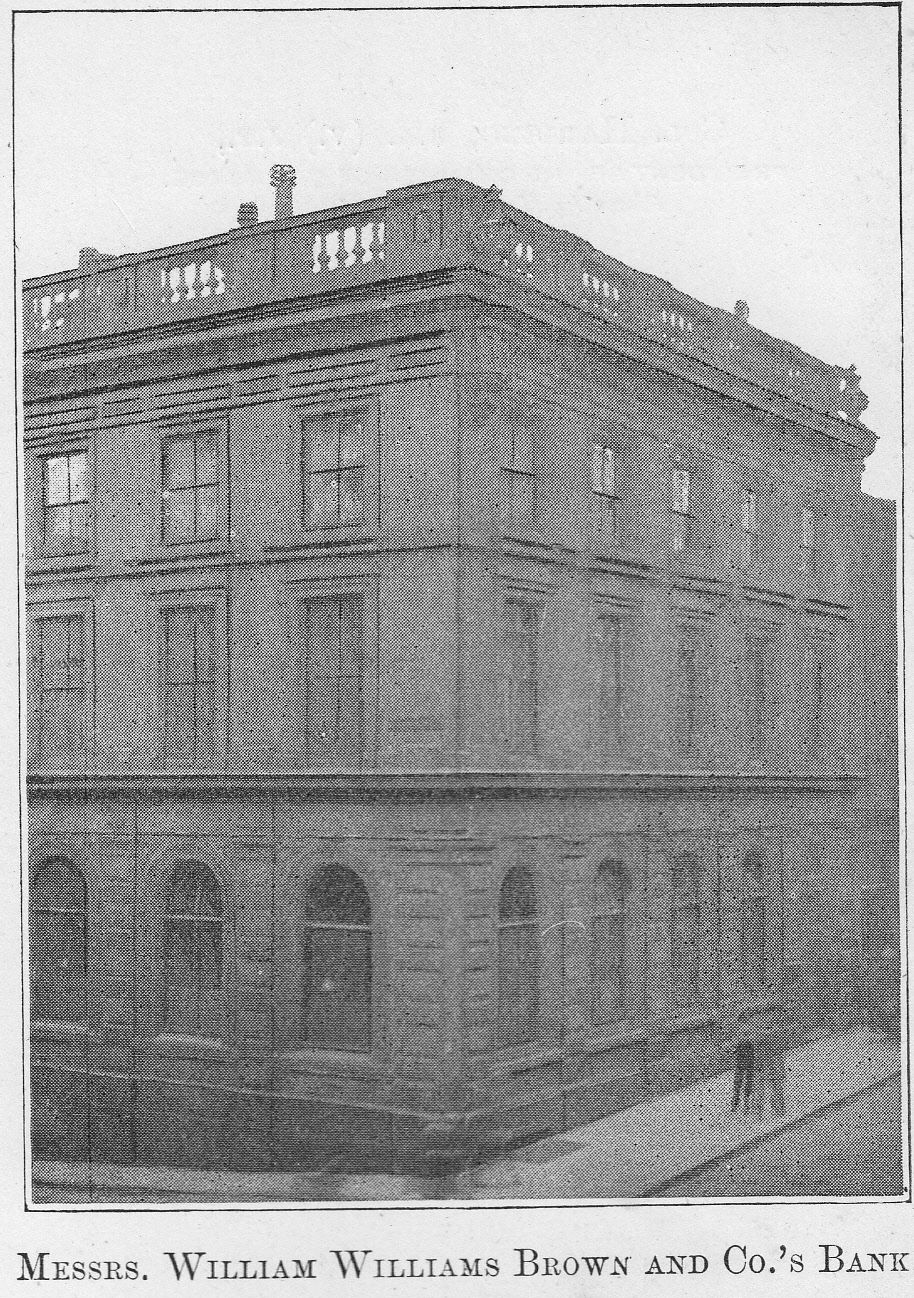
The present proprietors of the Leeds house are as follows:— Mr. James Walker Oxley, Spenfield, Weetwood, Leeds; Mr. Thomas Harrison, The Wyther, Leeds: Mr. William James Brown, The Mount, Ackworth, Pontefract; Mr. Henry Oxley, Spenfield, Weetwood, Leeds; and Mr. Richard Wilson, Westfield, Armley, Leeds. Of these, Mr. J. W. Oxley, Mr. T. Harrison, and Mr. W. J. Brown are partners in the London firm, the other principals in Messrs. Brown, Janson and Co. being Mr. John Whitaker Cooper, Mr. James Greig, and Mr. Ernest Tozer Janson. Mr. J. W. Oxley holds the post of Treasurer to the Leeds School Board, as well as to the Leeds, Skyrack, and Morley Savings Bank, to the Leeds Board of Guardians, and to the Leeds Trained Nurses’ Institution. He is also a Director of the Midland Railway Company, and fills several other important appointments.
The premises at the corner of Commercial Street and Albion Street, in which the banking business is carried on, are spacious and well-arranged, affording capital accommodation for the clerical staff, the managers, principals, and the public. The managers’ and private offices are comfortably and appropriately furnished, and are in communication with the Telephone Exchange; whilst, like the rest of the apartments, they are lighted by means of electric incandescent lamps. There may be seen here two portraits, one of Mr. William Williams Brown, the founder of the Bank; the other of the late Mr. Henry Oxley (father of the present head of the firm), by whose influence and application the building up of the firm to its high commercial status was mainly due.
MESSRS. BECKETT AND CO., PARK ROW.
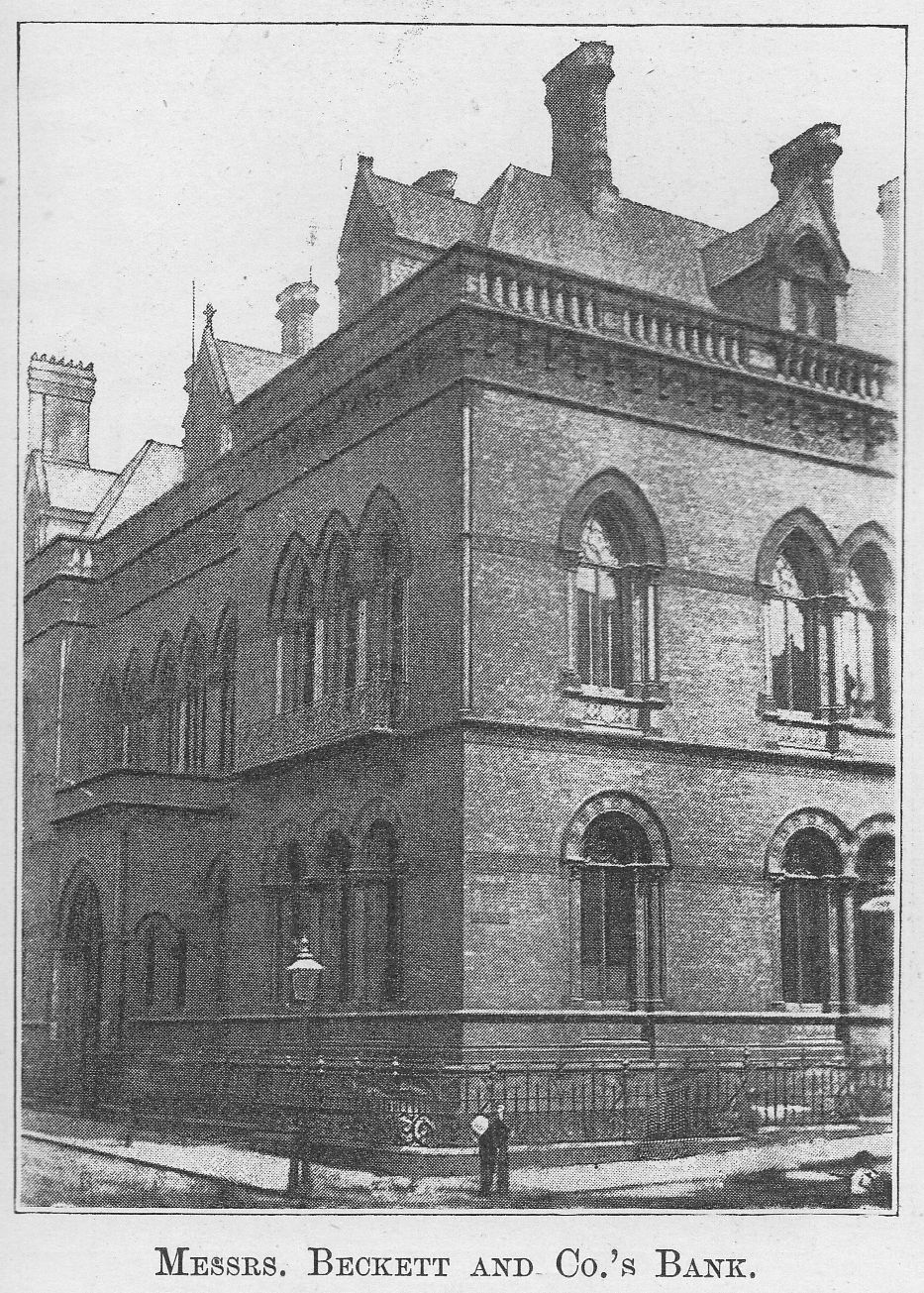
One of the most important and best known banking houses in Yorkshire is that of Messrs. Beckett and Co., whose handsome premises in Park Row form the principal architectural feature of that essentially business thoroughfare. “Beckett’s Bank,” as the establishment is familiarly denominated, was founded in the year 1750, and is therefore approaching its third half-century of existence, always having been in the hands of the same family, who have been identified in many ways with the county, and always popular with its inhabitants. The business has been successively and successfully carried on by the first Sir John Beckett, Baronet; Sir Thomas Beckett; Sir Edmund Beckett, formerly Edmund Beckett Denison, (who represented the West Riding of Yorkshire in Parliament for a number of years); then by Mr. William Beckett, sometime M.P. for Leeds and afterwards for Ripon; Mr. William Beckett, formerly William Beckett Denison, of Nun-Appleton, M.P. for the Hundred of Bassetlaw, Notts; and by Mr. Christopher Beckett Denison, M.P. for the Eastern Division of the West Riding of Yorkshire. The business of the bank was, prior to June 1867, conducted in Briggate, being in that month transferred to the present fine premises in Park Row. The new building was erected from designs by the late Sir G. Gilbert Scott, R.A. the foundation stone being laid in 1863, by Mr. Ernest William Beckett, the present M.P. for Whitby, and heir presumptive to the Barony of Grimthorpe. The structure, like most of those designed by the celebrated architect, is somewhat ornate, and presents a fine frontage to Park Row; it is three storeys in height, including the dome roof, the façade being relieved by a frieze of terra cotta, whilst the windows which are lancet shaped are opened on to extremely graceful open ironwork balconies, the railings below being picked out with gold, and giving an enlivening appearance to the background of red brick, with which the building is erected. Passing in by the arched doorway we come direct to the well-arranged general office, the partners’ private rooms being situated to the right, and we cannot help admiring the beauty of the interior embellishments of the building, the handsome and tastefully-arched windows being particularly noticeable, whilst the tesselated pavement gives a solid appearance to the flooring, besides according admirably with the other features of the interior. The fittings and furniture of the offices are, of course, solid and handsome, and the whole establishment is thoroughly adapted for its important character. Messrs. Beckett and Co, have a most extensive business and private connection, and conduct every description of the usual banking business. The partners are Messrs. C. E. S. Cooke, E. W. Beckett, M.P., E. Beckett Faber, G. W. Beckett, R. E. Beckett, G. Brown: and the London agents of the firm are Messrs. Glyn and Co.
THE YORK CITY AND COUNTY BANKING COMPANY, LTD.,
Is the oldest of the Joint Stock Banks carrying on business in Leeds, having been established in York in the year 1830, though the Leeds Branch was not opened until 1883. There are 40 branches and 22 sub-branches of the Company in various towns in the North of England. The subscribed capital of the Company is £1,117,680, of which £335,304 is paid up. The reserved surplus fund amounts to £371,202 and the number of shareholders are 1443. The local manager of the bank is Mr. J. Kinloch Greig. The Company have just erected handsome new premises at the junction of Park Row and Bond Street. The exterior of the building, which is of imposing appearance, is being carried out in cleansed Bradford stone. The ground floor is treated externally with quoined courses, the windows being circular-headed, and the entrance to the bank is placed at the angle of the building, the frieze and pediment being carried by polished red granite columns. The architecture of the first and second floors is of a Corinthian order, having coupled columns, and the whole is crowned by richly carved frieze, cornice, and vase terminals. The interior arrangements will, both in design and finish, and completeness of equipment, be carried out in a style consistent with the external appearance of the building. The basement contains porter’s house, strong rooms, heating and dynamo rooms. On the ground floor, and facing Park Row is the bank-room, lighted at the back by a lantern light, and opening out of the public room are the manager’s and waiting rooms, strong room, &c. The walls of the bank will be lined internally with Burmantoft’s faience. All the counters, desks, &c., will be in half-polished oak, having brass fittings to special design. There will be a fine suite of offices on the ground floor, with separate entrance from Park Row, which will be occupied by the Scottish Provident Life Office. The first and second floors, which will be entered from Bond Street will also be fitted up as offices, having strong rooms on each floor. The works are being carried out by Messrs. Nicholson and Son, of Hunslet, from the designs, and under the superintendence of Messrs. Smith and Tweedale, 12, South Parade, Leeds. Mr. Appleyard, of Leeds, has been intrusted with the execution of the carved work. In addition to their chief office in Park Row, the Company have sub-offices at the Corn Exchange, and at the Leeds Cattle Market.
THE LONDON AND MIDLAND BANK, LTD.
This well-known banking concern was originally founded in the year 1836, under the title of the Birmingham and Midland Bank, being incorporated in 1873, and turned into a limited liability Company in 1880. By its amalgamation in 1883, with the Union Bank of Birmingham, and again in 1889, with the Coventry Union Banking Company, Limited, and the Leamington Priors and Warwick Banking Company, Limited, the house acquired most valuable additions to its business: whilst, by still further unions in 1890, the Derby Commercial Bank, Limited, the Leeds and County Bank, Limited, and the Exchange and Discount Bank, Limited, became the property of the concern. In 1891, the Central Bank of London, Limited, also became absorbed, and the name of the Bank was altered to that under which it has since conducted its operations. Recently, however, the London and Midland Bank has also taken over the business of Messrs. Lacy, Hartland and Co., and the Manchester Joint Stock Bank, thus forming one of the strongest combinations it is possible to imagine, and greatly widening the importance and area of the transactions throughout the country. This policy of the directors is undoubtedly a wise and well-considered one, and is in true keeping with the best traditions of safe banking, the spreading of the interests of the business into other than purely local channels, minimising the risk attending any declension of trade in a particular quarter.
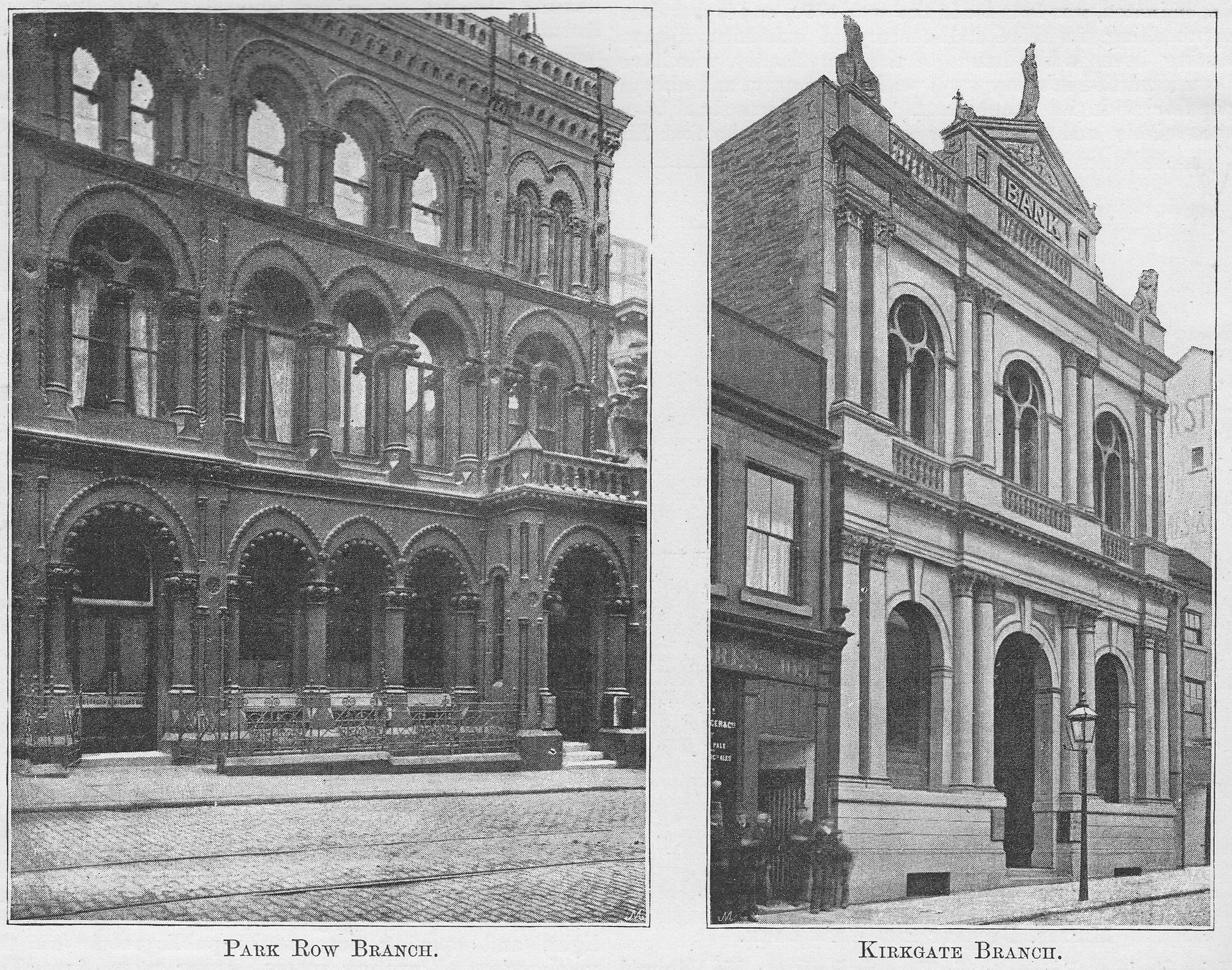
The head-quarters of the Bank are in London, and it has now over 80 branches dispersed in favourable positions throughout the country. The nominal capital is £6,000,000, with a subscribed capital of £3,653,400, of which £761,125 is paid up, the reserve fund standing at £575,000. An eminently safe business has at all times been transacted, which fact is most conclusively proved by the statement that a dividend of 15 per cent, is generally declared to the 2,500 share-holders; indeed the management in the past has been most thoroughly satisfactory, and we look for even a still greater success in the future, owing to the progressive nature of the policy pursued by the directors and managers. The very handsome premises of the Kirkgate Branch of the London and Midland Bank cannot fail to draw forth admiration.
The old local habitat of the business having proved utterly inadequate to the ever-increasing volume of the bank’s transactions, designs were prepared by Mr. William Bakewell, F.R.I.B.A., the well-known Leeds architect, and the present building was opened in the early part of this year. It is of decidedly classical character, with fine Corinthian columns and pilasters ornamenting the facade, which is constructed of stone from the quarries at Idle and Morley. A statue of Midas crowns the pediment surmounting the first floor central window, and this is supported on either side by the lion and the unicorn. Internally, the Bank is fitted and furnished in an extremely rich and solid manner; whilst the decorations are in every case tasteful and appropriate. The floor is of Mosaic pavement, and the counters, desks, and fittings generally are executed in solid walnut. Ventilation and sanitary arrangements have been most perfectly attended to, the most modern and improved principles having been followed out, and heating is effected by means of hot air pipes disposed in coils throughout the building. The basement is connected with the main offices by means of a hydraulic lift, and here are placed the strong-rooms, practically removed from the slightest danger of either fire or burglary. Our engravings represent both the Kirkgate and Park Row premises belonging to the Company.
THE LEEDS JOINT STOCK BANK,
For which premises are now being built at the lower end of Park Row, will probably be the handsomest banking office in the county. The Bank was formed at the close of 1891, by a number of influential local gentlemen, who were impressed with the fact that, while the great expansion of the trade of the town and district had resulted in a continuous and progressive prosperity, the banking facilities of such an important centre were less than those afforded in most smaller towns. The public subscribed liberally, and the Bank was successfully inaugurated, Mr. George Bray, the well-known gas-lighting engineer, being Chairman of Directors, and Mr. Thomas Evan Pritt, General Manager. The premises at present occupied are in Boar Lane, but are much too small for the rapidly-growing business, and the move to the new building, which is to be ready in November, 1892, will be very welcome, both to the officials and the public.
The new offices are designed in classic style, and will have a frontage of 36ft. 3in. to Park Row, extending back to Basinghall Street, a distance of 107ft. The central entrance with vestibule, 10 ft. square, will lead into a lobby of similar dimensions, and from thence into the main office, which is to be 54 ft. long, 33 ft. wide, and 36 ft. high. Adjoining this will be a strong room, 20 ft. by 12 ft., surrounded by thick brick and concrete walls, and lined throughout with half-inch plate of tested steel, bolted together with iron stanchions and suitably ventilated. Alongside of this room a passage, 4 ft. 6 in. wide, will lead to the directors’ room, lavatories, &c., and back entrance. In the basement a large cellar and plate-room for the accommodation of customers’ boxes is being provided, together with a room for storing papers, and a heating apparatus department. The caretaker’s apartments will be over the back portion of the building, which will be fitted throughout with electric arrangements to give immediate alarm in case of fire or attempted burglary. The front elevation will be built of Idle Moor cleansed stone, and the principal entrance will have a circular arch rising from mounted imposts, and surmounted by moulded cornice and pediment, with carved tympanum and ornaments. It will be flanked on either side by two columns of polished red granite, 18 ft. high, resting on pedestals with moulded bases; the capitals of the columns are of the Corinthian order. The apex will be surmounted by a large figure of Britannia in a sitting posture, and the windows flanked by granite pilasters, with carved festoons between the capitals.
The interior of the bank is to be divided into bays by twelve detached polished scagliola columns, with Corinthian capitals; there will be a cone ceiling, supported by large enriched cantilevers over each column, the space between the cantilevers being filled in with moulded panels and diaper work. The daylight will be admitted through a ceiling-light of richly-ornamented glass of special design. The floors will be covered with Italian mosaic work, and all fittings are to be of polished Spanish mahogany. The architects of this fine building are Messrs. Ambler and Bowman, of 9, Park Place, the details of the work being carried but by various contractors.
THE YORKSHIRE PENNY BANK, 2, EAST PARADE.
As the head-quarters of the Yorkshire Penny Bank, the town of Leeds becomes the centre of a widely-spread and interesting institution. Established for the encouragement of thrift, the number of its depositors, the amount of its funds, the extensive character, together with the special features of the business, make this undertaking one of the most important of the kind in the kingdom. The Central Bank, which serves as the head-quarters of the Yorkshire Penny Bank, occupies premises conveniently situated at 2, East Parade, in immediate proximity to the junction of Infirmary Street, King Street, St. Paul Street, and Bond Street. The present building, a fine substantial stone structure of a most commodious description, has been long found inadequate to the demands of the rapidly-increasing business; new premises, accordingly, are now being constructed nearly opposite the present building, in Infirmary Street, at the corner of Toronto Street. On the erection of these, of which Messrs. Perkins and Bulmer are the architects and Mr. William Nicholson the contractor, the directors intend to expend the sum of £50,000, and although the foundation stone will shortly be laid, the building will not, it is believed, be completed for at least two years. One of the prominent and useful features of this imposing erection will be a central tower containing a lift for passengers. These additional premises, by providing increased accommodation for the depositors and other business which now crowds the doors of the present building, will do much to relieve the pressure at present experienced by the executive.
The Yorkshire Penny Bank has run a remarkably prosperous career from the beginning. Its foundation in 1859 was chiefly due to the exertions of the late Colonel Akroyd, still long to be remembered in Yorkshire as one of the county’s most prominent philanthropists. In the December of 1856, a meeting attended by the magistrates, clergy, and gentry of the West Riding was held at the Philosophical Hall, Leeds. The general outline of the scheme having there been decided on, and the details being afterwards satisfactorily settled, the Bank, in May 1859, first opened its door for business. Started thus in a small way, the institution has since then grown year by year until it has attained to its present remarkable dimensions. To realize this growth, we must contrast the facts given in the first annual report, presented in April 1860, with the details of the last, which, as we write, has not been published. The first general meeting was held after the bank had been in existence a twelve-month, when a full report of the year’s business was presented. It was then found that 58 branches had already been inaugurated, and that at the end of March the accumulated deposits amounted to the sum of £9,777. Satisfactory as these results were, the figures look small indeed compared with those given in the report for the year 1891, after the bank had been in existence a little more than 30 years. In 1891, 75 new branches, having been opened, it was found that this brought up the total number in existence at the end of that year to 884, and we are informed that this number has since been increased to 920. The number of deposits received during the same year was 2,068,141, while the amount deposited was £3,905,895. The withdrawals, on the other hand, were satisfactorily few, 420,310, in number, and in amount £3,329,945. Of open accounts, the number existing at the end of the year was 307,182, and to the credit of depositors the sum then standing amounted to £5,748,755, which total has been since increased to upwards of six millions, while in the same year £151,636 was paid as interest to depositors or added to their accounts. The figures we have quoted make clearly apparent the great progress made since its foundation by this flourishing institution, and demonstrate in the most convincing way that the object purposed to be accomplished at its establishment has been abundantly effected.
To afford further facilities for that cultivation of thrift which was the intention of the founders of the bank, an additional feature not contemplated in the original scheme has been added. We refer to what is known as the School Transfer Bank Department. This comparatively recent extension of the business has been established especially for the benefit of children, and is conducted during hours at the various schools throughout the county. Since the Free Education Act came into operation, 150 new branches have been opened in this department, and the officials at head-quarters now estimate the number of depositors at more than 54,000. Referring, in this department, again to the more comprehensive figures furnished by the report for 1891, we find that the number of deposits made at these branches, during that year, was 699,561, while the sum deposited amounted to £l9,481. Of withdrawals there were 30,480, and the amount withdrawn was £13,832, but, of this sum, the transfers, which are included, account for £5,745. The total number of depositors then on the books was 54,147, and the amount standing to their credit at the end of the year was £9,664. To this department we have referred at length as in our opinion a most interesting feature of the institution, and as shewing, moreover, that the business is still carried on in the interests of those whom its founders intended to benefit.
The branches at which operations are carried on, including eight daily banks, situated at Bradford, Halifax, Sheffield, Keighley, and Middlesbro’, as well as Leeds, and the evening branches established for the convenience of workpeople, now numbering, as we have said before, 920, are scattered all over the county. Branches are inaugurated at places where a demand for them is likely to be experienced, and thus we see that in Leeds, besides the Central Bank at East Parade, a Market Branch is established at 9, New York Street. At all these different places the principles on which business is conducted are the same. The interest allowed on deposits, calculated at the rate of three per cent, on each pound, is identical in amount everywhere; any sum, small or large, may be deposited, while £20, or any smaller sum, may be withdrawn without notice, and on giving one day’s notice, larger amounts. Still, after all we have said, some reader may ask what place the Yorkshire Penny Bank occupies which might not be satisfactorily filled by such an institution as, for example, the Post Office Savings Bank. In reply, we would explain that it undoubtedly has a raison d'être of its own. There is a gap between the commercial and the ordinary Savings Bank, and to fill this is one of the aims of the present institution. As one means of attaining this object, cheque books are issued to depositors having balances of £50 and upwards at the Central Bank and other daily banks. This special feature, not to mention other peculiar advantages, would, in itself, justify the existence of the institution, and that it is a great convenience to the community, and has been, and now is more than ever, an encouragement to thrifty habits, the extent of its operations and conspicuous prosperity demonstrate. Much of this success, to turn now to the financial management of the institution, is due to the marked ability with which its affairs are administered. A genuine and laudable economy is practised in all details, while the directors are assiduous in their efforts to obtain safe and profitable investments for the funds at their disposal. Remunerative securities of the best and most reliable class are sought out, and, in this connection, it may be specially mentioned that, on mortgage of freehold and copyhold estates, the directors will be found ready to make advances. These, which are limited to a figure not exceeding two-thirds of the value of the property, are repayable by annual instalments, or at any time during the year in sums of not less than £5. The results of these efforts on the part of the directors and other officials of the bank is that a considerable profit is yearly made. This, which, during 1891, amounted to £15,667, is invested in 2-and-three-quarters per cent Consols, and added to the reserve fund, which, an important guarantee of the stability of the institution, was raised at the end of that year by this addition, to a total of £160,109.
This brings us to a consideration of the character of the constitution of the Bank. In the Memorandum of Association the objects for which the institution has been established are declared to be the receiving of deposits for safe custody and investment, the keeping and investment of the same, and the repaying the amount with interest to the depositors. Further, it was provided that the income and property of the institution should be applied solely towards the promotion of these objects, and that no portion should be paid in any form whatsoever to the persons who are members of the association. Not having been established, then, for the private profit of its promoters, but for the furtherance of public good, and being a joint stock company, limited, by guarantee, and not having a capital divided into shares, the Yorkshire Penny Bank, by license of the Board of Trade, is permitted to omit after its title the word “limited,” the addition of which is in other cases compulsory.
To pass to the members and officials of this association, the body is composed of noblemen and gentlemen of high standing and ability. The Eight Hon. the Earl of Harewood, who is supported by a numerous and influential body of Vice-Presidents and Directors, is the President of the Bank. The Executive, at whose head, as General Manager, in succession to the late Mr. Bent, who had been associated with the scheme from its outset, and to whose untiring energy and perseverance the success of the Institution is mainly due, is now under the control of Mr. H. B. Sellers, who, in his responsible position, conducts the business with energy and ability. All enquiries on details of the business will be courteously answered by the officials, and everything is done to keep the institution in touch with the people.
In this short sketch we have been obliged to pass over without remark many interesting features of the business, but above everything, it has been our endeavour to present a clear, if succinct, view of the most important points. Of this institution, thus officered and equipped, keeping in view its excellent management, together with the laudable object of its foundation, Yorkshire has just reason to be proud, while an increased success, if possible, and further usefulness must be wished for it by all who have the welfare of the community at heart.
The premises occupied by the banking companies of which we have just given some account are undoubtedly among the best examples of commercial architecture in Leeds, and it is largely owing to the extensive building operations which many of these firms have instigated that the main thoroughfares of the town can shew such ornamental structures as they do; and in this respect improvement is taking place every day. The prosperity and vitality of these institutions is also an eloquent testimony to the commercial stability of Leeds, and also to the thriftiness which characterizes the bulk of her population. Another feature of the town which exemplifies the wisdom and forethought exercised by the majority of the inhabitants is the existence of a large number of insurance companies doing business here, particulars of some of the leading ones of which we give herewith.
INSURANCE OFFICES.
THE LIVERPOOL AND LONDON AND GLOBE INSURANCE CO., 48, ALBION STREET.
Chief Offices: 1, Dale Street, Liverpool, and 7, Cornhill, London.
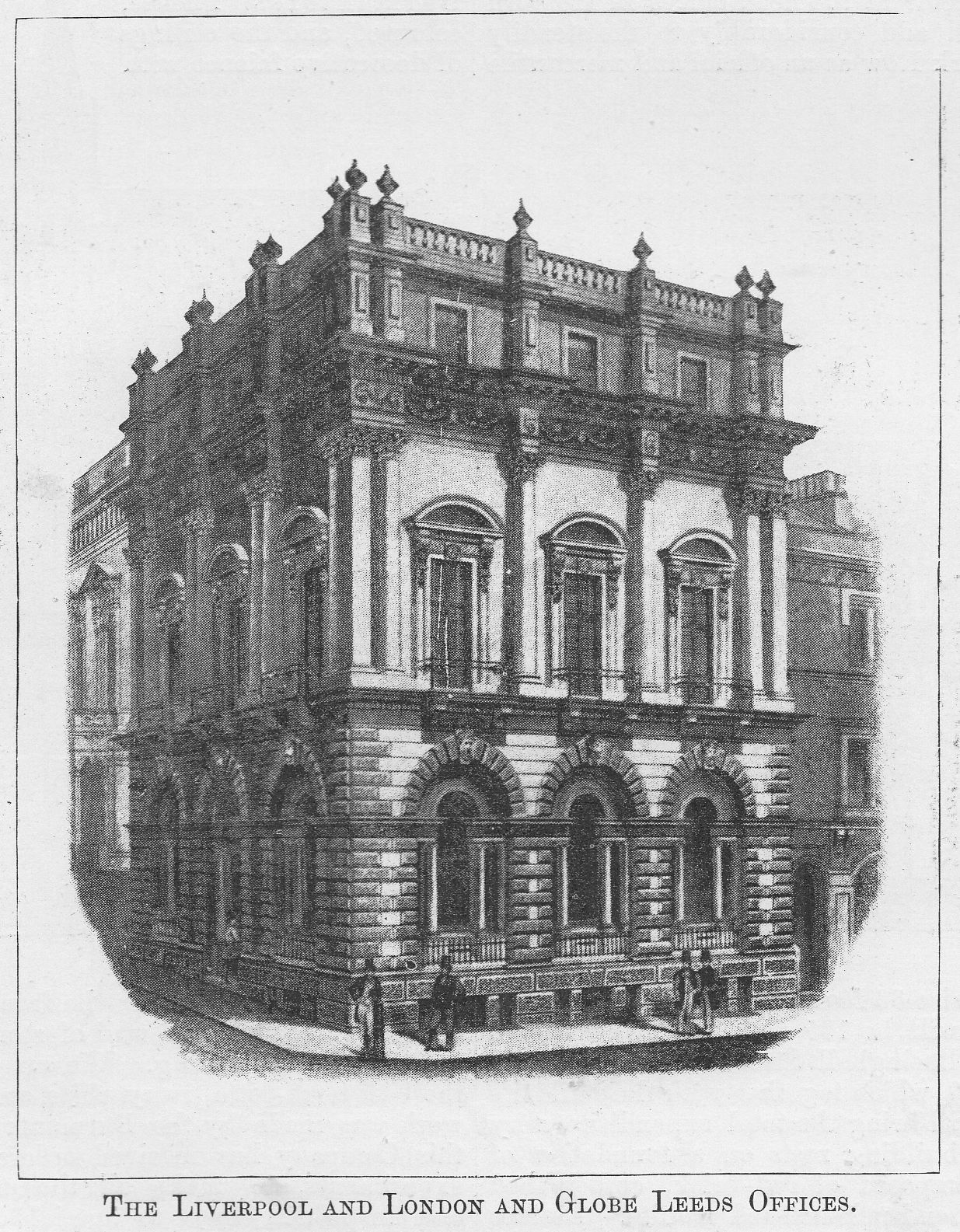
The future Historian of England will possibly characterise the reign of Her Majesty Queen Victoria as being singularly prolific in the establishment of commercial undertakings, which, under the management of Englishmen, have proved such gigantic successes as to become at once the envy and admiration of all other nations. Of such a character is the Liverpool and London and Globe Insurance Company, founded in 1836, quietly, but on a foundation of the utmost solidity, and guided throughout by men who have always had at heart the permanent prosperity of the Company, and who, notwithstanding clamorous share-holders, have deliberately refused to divide all the profit made in good years; it has now reached a very prominent position in the very front rank of Insurance enterprise. Many of our readers will not soon forget the great fires at Chicago on the 8th of October, 1871, when property to the value of £30,000,000 was destroyed; and at Boston on the 9th of November, 1872, when the damage amounted to £14,000,000, and the consternation in insurance circles which culminated in a failure to meet their engagements of so large a number of the offices accepting risks in those cities. For these two fires alone, the L. & L. & G. paid about £1,000,000 in hard cash, but its name thereby became a household word throughout the world, and Phoenix-like it arose from the ashes of these two cities purified by the ordeal through which it had passed, a monument to the foresight of its directors in accumulating in good years reserves for use in bad years.
The operations of the Company which are world-wide are controlled by the head offices in Liverpool and London, through home branches in Leeds, Manchester, Newcastle, Bristol, Birmingham, Dublin, Glasgow, Edinburgh, and foreign branches at New York, Chicago, New Orleans, San Francisco, Montreal, Sydney and Melbourne, by agencies in every direction all through the various Continents. The office is extremely popular in Leeds and throughout the whole county of Yorkshire, therefore it will no doubt be of interest to give our readers a few particulars of its standing and position, which we have chiefly taken from a perusal of the last report and balance-sheet issued to the shareholders as at 31st December last. From this we find that the Company puts forward indisputable evidence of a large increase in all the classes of business undertaken, viz., Fire and Life Insurance of all kinds, Endowments for children and adults, and the sale and purchase of Annuities, Reversions, etc. The Company’s total funds are as follows:
Capital Paid up - £245,640
Globe Perpetual Annuity Fund - 1,102,800
Life and Annuity Funds - 4,278,525
General Reserve Fund - £1,300,000 )
Fire Re-Insurance Fund 670,000 ) = 1,970,00
Balance to Credit of Profit and Loss - 552,864
TOTAL = £8,149,829
Total Assets as per Balance Sheet December, 1891 - £8,888,113
The Total Claims paid since its commencement by the Company, after deducting Re-Insurances, amount to £27,834,866
These figures speak for themselves, and we have only to say that the Liverpool and London and Globe Insurance Company has always adopted a most fair and equable mode of rating, based upon the law of average, and that in consequence, the fire premiums are in most cases exceptionally low. The Company’s Polices cover almost every class of fire risks —special or ordinary — including mills, shops, warehouses, and dwelling houses: machinery, stock-in-trade, furniture, and general effects; farm buildings, produce, implements, and stock, and in this latter connection we may mention that cattle killed by lightning on the insured farm are compensated for without extra premium. The business is world-wide in its operations; foreign risk being accepted as well as British. We unfortunately have not space to detail all the good things which await intending insurers in the Life Department, but as indicative of the spirit of liberality which pervades the whole management may mention, that although policy-holders have no liability whatever (the Company being a strictly proprietary one), those in the participating classes are entitled to nine-tenths of the profits arising therefrom. Many tables of different modes of life assurance, either with or without participation in the profits have been arranged, and these, should be carefully perused by would-be insurers, for they contain particulars of numerous advantages which have from time to time been introduced by the Company. In each case the rates of premiums will bear the most favourable comparison with those of other offices, and we have, therefore, much pleasure in recommending them to the notice of the public as being formulated on the soundest of principles.
PRUDENTIAL ASSURANCE CO., PARK ROW,
The handsome offices of the Prudential Assurance Co., in Park Row, are the Leeds branch of the fourth business corporation in Great Britain. Of the whole population of these islands, one in every four is a policy-holder in this Company, and the nine and a-half million policies represent a capital of over £15,000,000. In the Borough of Leeds alone, there are some 120,000 policy-holders. For the purposes of this gigantic business the country is divided into twelve geographical divisions, each presided over by an inspector, a superintendent and his assistant superintendents, and employing altogether more than eleven thousand agents. The local management is under the supervision of Mr. T. Woods, assisted by a staff of 150 agents and clerks.
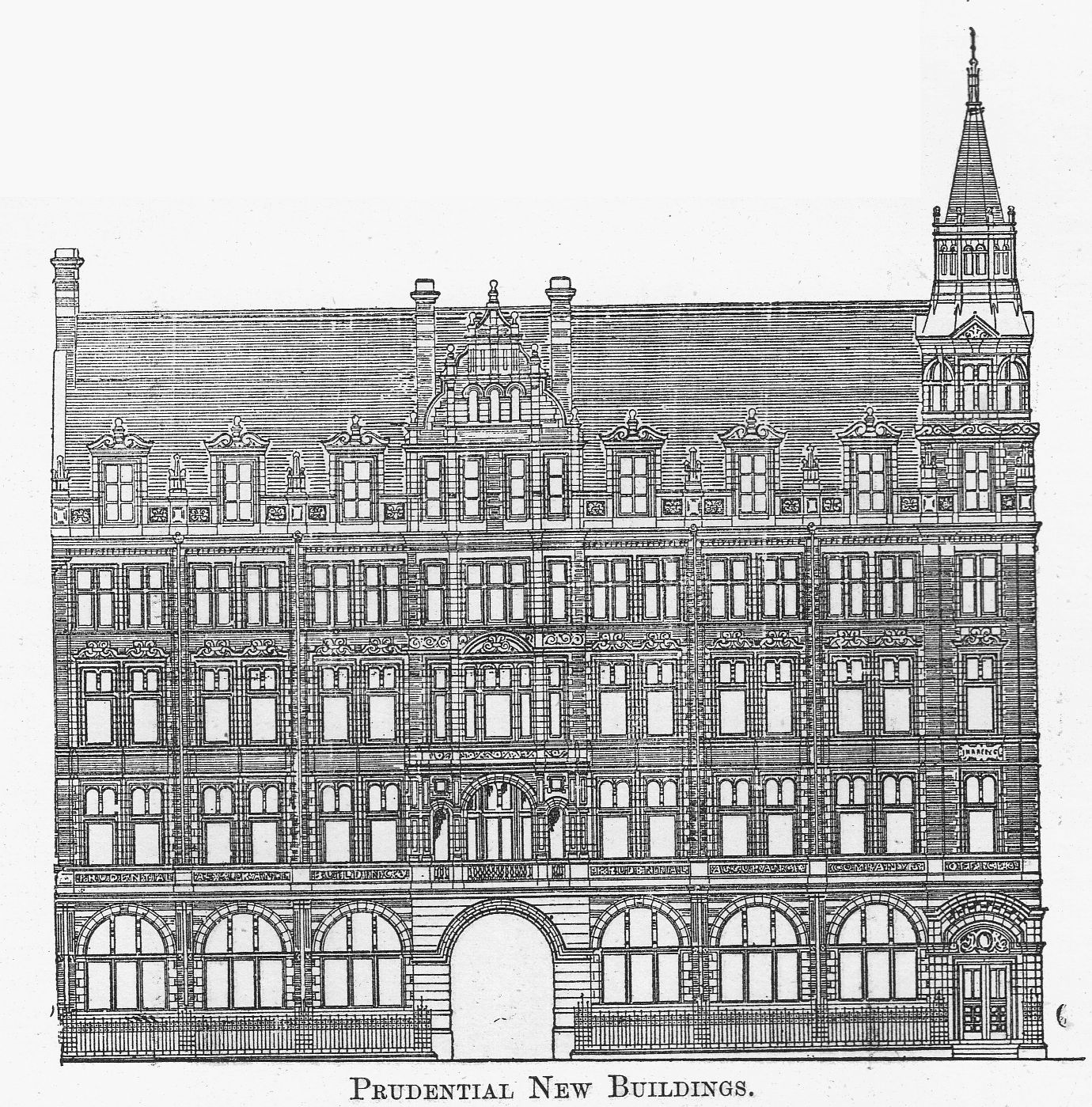
The Park Row edifice, of which we give a view, was designed and planned by Mr. Alfred Waterhouse, R.A. It is of the same character as the head offices in Holborn Bars, London, and will add considerably to the steadily rising attractions of Park Row as an official and mercantile thoroughfare. It will rise 83 feet from the pavement; the frontage to Park Row will be 105 feet, and the premises will extend through to Basinghall Street. The price paid for the site was £16,000, which together with the builder’s contract for £40,000, will bring the total expenditure very near to £60,000. The building rests on a foundation of concrete, and will be composed of red brick, embellished with terra-cotta facings and polished red granite. Besides those portions reserved for the Prudential Co.’s business, there will be a handsome art gallery, 100 feet long and 18 feet high, with a well-lighted central area, and 73 other rooms to be sub-let as offices. There are plenty of store-rooms, lavatories, and eleven separate strong-rooms: and the corridors leading to these are roomy, and well-lighted from each end by large windows, into which light is reflected from walls of white glazed brick. Each floor is fire-proof, nine inches thick, and covered with pitch pine wood block flooring in the herring-bone pattern. Access is gained to each floor by a passenger lift, which is being constructed on the most approved safety principles; it will be handsomely upholstered, and quite noiseless in action. A resident engineer will be in constant attendance, always travelling on the lift. A good waiting-room is provided, where passengers may conveniently spend the necessary intervals between its ascent and descent. The entrance to the Prudential offices proper is through a porch on the ground floor of the tower in the centre of the building. The public office is 41 feet by 36 feet, and lofty. Adjoining this is the Manager’s private room, and on the same floor are waiting-rooms, lavatories, and the strong-room. In the basement beneath is the large store-room for books, stationery, &c., and the heating-chambers. The offices are to be furnished with Burmantoft’s faience, richly moulded and coloured, and the ceilings formed into panels of decorative faience with ribs of polished walnut. The staircase in the front block will be finished with an arcaded newell wall of stone and marble columns, and faience wall tiling. We are pleased to add that all the buff terra-cotta, ivory white, and coloured brick faience work was made by the Burmantoft’s Company, and that this Company has received orders, after many tests and experiments, to make all the traps, pipes, manholes, and inspection eyes to special, designs. The sanitary arrangements will be as perfect as modern science can make them. We need say nothing more to explain the just popularity of this gigantic enterprise, and it is certain that the mind of a highly-reputed architect, and the resources of science and art have combined to produce in the Prudential Assurance Company’s offices a building which will add immensely to the importance and beauty of Park Row.
THE LEEDS AND NORTH OF ENGLAND BOILER AND ACCIDENT INSURANCE CO., LTD.,
9 South Parade.
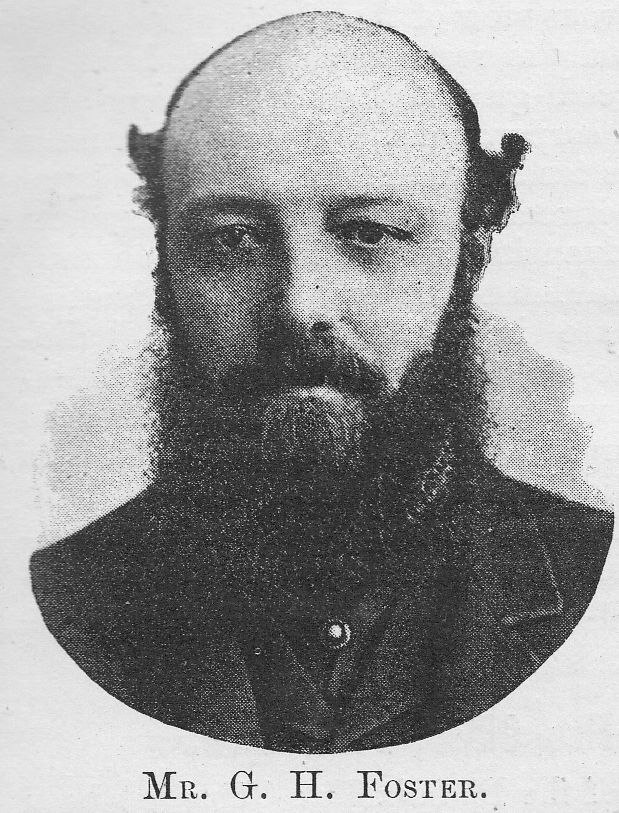
This Company is eminently the outcome of local requirements. Few people could even roughly estimate the quantity of ponderous and delicate ’machinery standing in the various mills and factories of this town and its environs; all of it possessing peculiarities and liabilities which require as much careful guardianship as the human physical constitution; nor is much thought given to the responsibility of owners in case of injury to any of their employes in consequence of an accident. It should he born in mind that since the Boiler Explosions Enactment, the owner of boilers is liable to very heavy penalties in the event of a mishap; and so stringent are the rules that an accident, consequent upon insufficient inspection, might even result in a verdict of manslaughter. The possibility of accident, and the pecuniary penalties inflicted when they do occur, are both provided against by this Company. Competent inspectors make regular periodical examinations of all boilers and engines on the lists of the Company, and give timely warning of any discernible weakness, and owners can provide against possible liability by the payment of very moderate premiums, In addition, insurances are effected against personal accident, or the breakages of plate glass, and the Company also guarantees the fidelity of employes. In fact it covers the entire liabilities against which employers or employed can insure themselves except that of fire. Under such circumstances it is easy to understand that its operations are now very extensive.
There are, besides the head office in Leeds, branches in London, Birmingham, and Liverpool, and agents in all the principal towns. It is true that the Company has recently experienced heavy losses in connection with its London third party business, which fact has been used by irresponsible critics as a reflection upon its transactions, but it has been wisely decided to discontinue this kind of business; and there is not the least doubt that the present efficient directorate and the able management of Mr. G. H. Forster, will not only sustain, but largely increase the confidence already displayed by both shareholders and policy-holders. Many improvements have been already effected in the operations of the Company, one of great importance being the increase in the staff of engine inspectors under the direction of Mr. J. Clark Jefferson, A.R.S.M.Wh.Sc. With regard to the general conduct of the business, Mr. Forster’s name is in itself a safeguard, and he has had a long experience in this class of insurance. He was originally apprenticed to a trade which he abandoned to become a traveller and collector for the Manchester Boiler and Steam Power Insurance Company. So successful was he that the board appointed him to take charge of their operations in the Yorkshire district, where he built up a very valuable connection. The necessity of establishing a local office for undertaking the insurance and regular inspection of boilers, soon became apparent to him, and in 1883 he did establish an office of the kind on the mutual principle. As the company started with a very influential directorate, no difficulty was experienced in allotting the shares when it became advisable to re-register it as a proprietary concern. Mr. Forster has pioneered the Company through these changes in such a manner that he has become essential to its vitality, of which there can be no possible doubt. At the head of this article will be found a portrait of the energetic manager, who may be seen by appointment at any time, and consulted on all matters of business connected with the Company at the Head Offices, No. 9 South Parade.
THE MUTUAL LIFE INSURANCE COMPANY OF NEW YORK.
Leeds Branch: “Yorkshire Post” Chambers.
MR. HUGH FLETCHER CAMPBELL: Superintendent for Yorkshire.
MR. FRED W. TENNANT: District Manager.
Head Office for the United Kingdom, 17 and 18, Cornhill, London, E.C.
This Company was established in 1843, its accumulated fund at the end of that year being £6,731. Its subsequent success may be gathered from the fact that it is now the largest Insurance Company in the world, the accumulated funds exceeding the gigantic total of £33,000,000 sterling; giving a surplus after providing for all liabilities of over £2,500,000. Being a purely mutual company, these funds are the exclusive property of the policy-holders, who are at the same time by special charter exempt from any liability beyond payment of their premiums. The securities are scheduled in the statements annually rendered to the insurance department and published for general information. Offices have now been opened in London, Belfast, Bradford, Bristol, Dublin, Edinburgh, Glasgow, Liverpool, Manchester, Newcastle, Norwich, Nottingham and in Leeds at “Yorkshire Post” Chambers, Albion Street. In Leeds and Yorkshire generally, the Company has met with great support, as it is undoubtedly the case that insurers who are cognizant of the benefits and inducements offered by the Company, are ready to avail themselves of them - especially with regard to the investment advantages and guaranteed cash surrender values. All policies issued in England are payable in sterling at the London office, and the whole of the profits from the American and British business are divisable alike amongst all the policy-holders. We may here state as an instance of the unparalleled success of the Company, that during the 49 years since its establishment, the Mutual received in premiums, £88,744,016, and returned in death claim and bonuses, £68,215,248. It now holds in trust for its members the enormous sum of £33,156,995, being an excess over receipts of £12,628,227, after providing for all expenses during that time. Cash bonuses alone paid to policy-holders have been upwards of £17,000,000. These are indeed marvellous figures, and speak volumes for the good management and ability of the executive. Amongst the many advantages offered to insurers the following may be mentioned
(1) No restrictions as to residence, travel, or occupation after two years.
(2) Perfect protection.
(3) Privilege of carrying insurance only so long as it may be necessary.
(4) Guarantee of a large cash return during life.
(5) Claims paid immediately on a proof of death and title.
(6) Moderate premiums for all classes of insurance.
It is a remarkable fact that at the end of 49 years, the amount of outstanding insurance in force is 42.7 per cent of the entire amount issued. The membership of the Company at the end of 1891 was 224 815, representing £144,892,533. Last year’s business was the largest transacted in the United Kingdom, and the whole amount issued by the Company aggregated more than any previous year.
THE SCOTTISH PROVIDENT INSTITUTION, FOR MUTUAL LIFE ASSURANCE, PARK ROW.
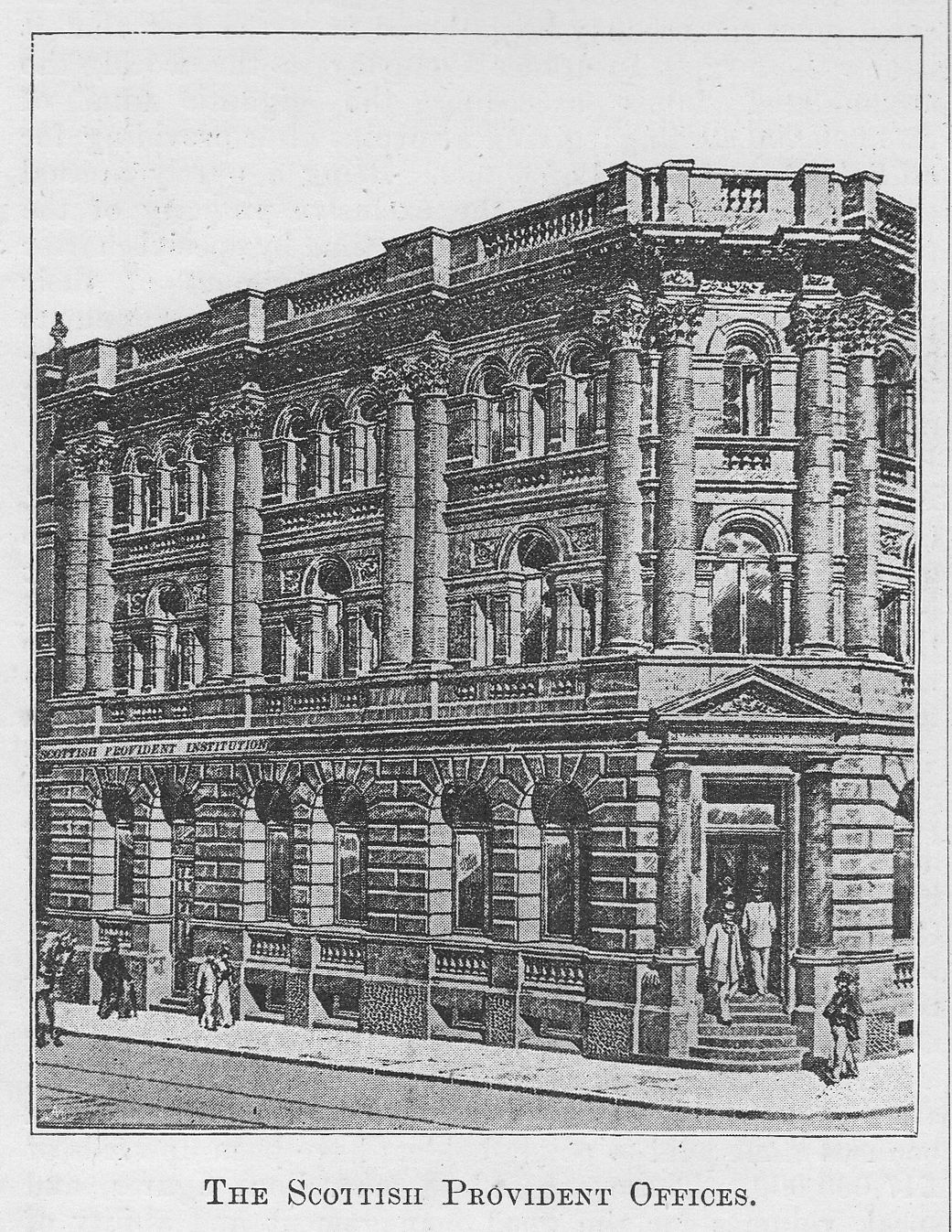
Among the foremost of British Life Assurance Organizations, the Scottish Provident Institution has for over half a-century maintained a position of ever-increasing prominence and influence. It was founded in 1837 as a mutual society, with the object of giving to the assured the full benefit of the low, non-participating premiums hitherto charged only by a few proprietary companies, without any sacrifice of the surplus. Experience has proved the wisdom of the system thus inaugurated, and has shewn that with economy and careful management, low premiums will not only secure much larger assurances from the first, but that by the simple expedient of reserving the surplus for those who live to secure the common fund from loss, may in many cases provide eventual benefits as large as can be obtained under the more usual rule of high premiums. The rates of premiums are so moderate that an assurance of £1,200 or £1,250 may generally be secured from the first for the yearly payment which would be charged in most cases for £1,000 only. The extra £200 or £250 is thus an immediate and certain bonus, as large as can be looked for in good offices only after many years. It is a significant fact that for eighteen years in succession, the new assurances annually effected have exceeded in amount £1,000,000 sterling. It is not surprising, therefore, that the new assurances completed in 1891 amounted to £1,208,287, while the premiums amounted to £609,293, and the total income to £936,723. The claims paid during this year, including bonuses, amounted to £368,000, and the bonuses themselves averaged close upon 50 per cent on the assurances which participated. At the close of the year the realized funds had risen from £7,356,619 to £7,801,431, shewing an increase of £444,812, and the working expenses had turned out to be less than 6 per cent of the income.
The institution has always taken a generous view of the rights of its policy holders, and has modified the restrictions which have in the past afforded a good ground for challenging the dealings of insurance corporations. Its own business transactions have always tended to emphasize the unity of interest which exists between it and its clients, and its place in the van of advancing institutions has thereby been maintained. The head-quarters of the Scottish Provident Institution are in a fine block of buildings on the south side of St. Andrew Square, Edinburgh, and are fully worthy of the high standing of the Association. The branch office in Leeds is located in a portion of the splendid building erected for the York City and County Banking Co., of which we give an illustration above. The local branch was open in 1870, and is at present under the management of Mr. Patrick Munro.
THE PHOENIX FIRE OFFICE, PARK ROW.
The Leeds Branch of the Phoenix Fire Office has been established about ten years, and occupies a portion of the handsome building in Park Row, belonging to Messrs. Beckett and Co., bankers. Mr. Edward Bagshaw, a gentleman well-known in insurance and commercial circles throughout Leeds and district, is manager, supported by an efficient clerical staff: and an extensive business is transacted with the woollen and other mills, the warehouses, shops, and private houses for miles around. The Phoenix Fire Office was one of the very earliest Insurance Companies, having been founded in London in 1782, and it has been always considered one of the soundest, most reliable, and thoroughly high-class concerns in the kingdom. Its Board of Directors contains the names of many representative men — peers, professional gentlemen, wealthy merchants, and others — in themselves a guarantee of the high standing of the Company, were such required; but it is quite unnecessary to say more than that the Phoenix is perhaps the best known of all the offices transacting fire insurance, that it has paid in claims for losses no less a sum than over nineteen millions sterling, and, that the most prompt and satisfactory settlement of such claims is characteristic of the concern.
The Company covers the buildings, contents, and rent of premises connected with almost any description of manufacturing business, trade, or amusement, and also insures ships and vessels of every kind whilst building or repairing in dock or harbour. The insurance of dwelling houses is undertaken at low rates, the conditions of all policies being most fair and reasonable, covering against lightning and explosion of gas, as well as damage by fire. Farms, and farming stock and implements, including steam threshers and other machines let on hire are also insured; in fact, every risk is taken by the Company, unless of specially hazardous nature, and operations are by no means confined to this country, but extend to the Colonies and abroad as well. Electric lighting is looked upon with great favour by the Phoenix Office, being permitted without any extra premium, provided certain precautions are taken, which are suggested by the Company in a published pamphlet, obtainable at any of their offices. This pamphlet has already run into nineteen editions, and we recommend all users of electricity, whether for power or illuminating purposes, to secure a copy.
The London offices of the Phoenix are at 19, Lombard Street, E.C., and 57, Charing Cross, S.W.; and there are branch offices at Birmingham, Bristol, Dublin, Edinburgh, Glasgow, Hull, Leeds, Liverpool, Manchester, and Newcastle-on-Tyne.
GENERAL TRADE
TAYLORS’ DRUG COMPANY, LTD.,
18, Guildford Street & Upper Fountaine Street.
It must be admitted that in no case is absolute purity so essential as in the case of drugs and all matters connected therewith. It is with an adequate conception of the importance of this subject that we call attention to a house whose very name is identified with absolute reliability, and whose productions are known far and wide as the best that money can obtain. Moreover, the aim of Taylors’ Drug Company, Ltd. — for to this house we refer — is to produce absolutely pure goods, and to take care that in all the manifold departments of this enormous concern only those goods are used which the Company are in a position to guarantee to their customers. The Registered Offices of the Company are at 18, Guildford Street and Upper Fountaine Street, Leeds, but the branches in Leeds, London, and other places, are very numerous. In Leeds, besides the head-quarters, the Company have places of business at Nos. 5 and 7, Albion Street; 14 and 16, The Arcade; 16, Boar Lane; 14, Queen’s Arcade, Hunslet Road; 53, St. George’s Street; 5 and 7, Otley Road, Headingley; 180, Roundhay Road; and Woodhouse Street. In Bradford the Company have depots at 83, Kirkgate; 4, 6 and 8, Millergate; 372, Manchester Road; and 190, Leeds Road. In Blackburn the Company are well represented by their large establishment at 20, 21 and 22, Thwaites Arcade; and they have four branches in Hull, viz., 27, Market Place; Devon House, Hessle Road; Beverley Road; and Paragon Arcade. The other country branches include one at 24, Westgate, Dewsbury; one at 15 and 15a, Beulah Street, Harrogate; and two others at 72, Low Street, Keighley, and Market Place, Pudsey, respectively. The London establishments at 94, High Street, Stoke Newington, N., and High Holborn, are very well known, especially the large store at 26 and 27, High Holborn, W.C.

All these places are worked on the same lines, and are equally well supplied with all the requirements of the trade carried on by each. Here we may mention that the Company are fully conscious of the importance of their Dispensing Department. All prescriptions and family recipes are dispensed by qualified pharmaceutical chemists from the establishment of Messrs. Savory and Moore, chemists to the Queen, and other eminent London and Provincial firms. All the drugs used are guaranteed to be fresh and of standard excellence, each prescription being properly numbered in case of any future reference.
The business is worked from the head establishment at Leeds, all postal communications to which should be addressed, “Box D. 49, Leeds”; the telegraphic address being, “Balm,” Leeds, and the telephone, No. 248, Leeds. The concern has now been established for about fifteen years, the Managing Director and leading spirit being Mr. W. Barker Mason, who has worked up a very large wholesale manufacturing concern of his own, which has recently been amalgamated with the Company; he is the inventor and proprietor of many medicinal preparations, to which we shall presently draw special attention. Mr. Mason has been connected with the drug and medicine business for upwards of 25 years, and it is no wonder that, with his acknowledged ability, he has attained to such an eminent position in the trade.

It was our good fortune to obtain permission to personally inspect the manufactory, offices, laboratories, and store-rooms of the Leeds premises, as well as some of the retail establishments of the Company, under the directions of Mr. Judson, the energetic buyer and cashier at head-quarters. The Company have lately acquired spacious and well-arranged premises adjoining their handsome retail store in Guildford Street. These new premises extend down the Street opposite the Green Dragon Hotel and Messrs. Brown, Carson and Co.’s stores, and backwards to Upper Fountaine Street, and then form a large quadrangular block of buildings, four stories high with a basement, with a square courtyard in the centre having an entrance from Upper Fountaine Street. The various departments are of extensive dimensions; and have been fitted-up specially under Mr. Mason’s personal direction. They consist of stores and laboratories devoted to the storing and preparation of (1) drugs, chemicals, and pharmaceutical preparations; (2) patent medicines and proprietary articles; (3) druggists’ sundries and surgical appliances; (4) perfumery; (5) groceries and dry goods; (6) brushes; (7) paints, varnishes, and colours; (8) filters; (9) teas; (10) fancy goods. These departments are all stocked to repletion, and for the information of intending customers a voluminous price list is issued by the Company, which gives the prices and all other items of interest connected therewith. We may mention that these charges are of the most moderate and reasonable character, and we believe that in many cases they are lower than those which prevail at the large London and other stores.
In the commodious offices, which consist of the Counting-houses, Manager’s offices, Cashiers’ rooms, and Correspondence room, there are employed a number of type-writers, shorthand clerks, &c., carrying on the work which necessarily attaches to the head office of so large a Company. The rooms are also fitted with telephones, duly connected with the various Telephone Exchanges. Adjacent to the offices proper, are the buyers’ rooms, travellers’ rooms, and check-order department. There is also a large library of medical works of reference, and the multitude of ledgers, journals, and letter books, which cover the whole period of the Company’s existence, also occupy the space of a respectable library. On passing to the square yard, which we have already mentioned, we find a number of temperators erected; these are used in those details of manufacture in which the liquids are required to be maintained at a certain temperature for any given period. There are also in this yard, the large water-tanks and boilers which supply the horizontal steam-engine on the ground floor, as well as a number of steam and hydraulic lifts and hoists for the carriage of goods from floor to floor.
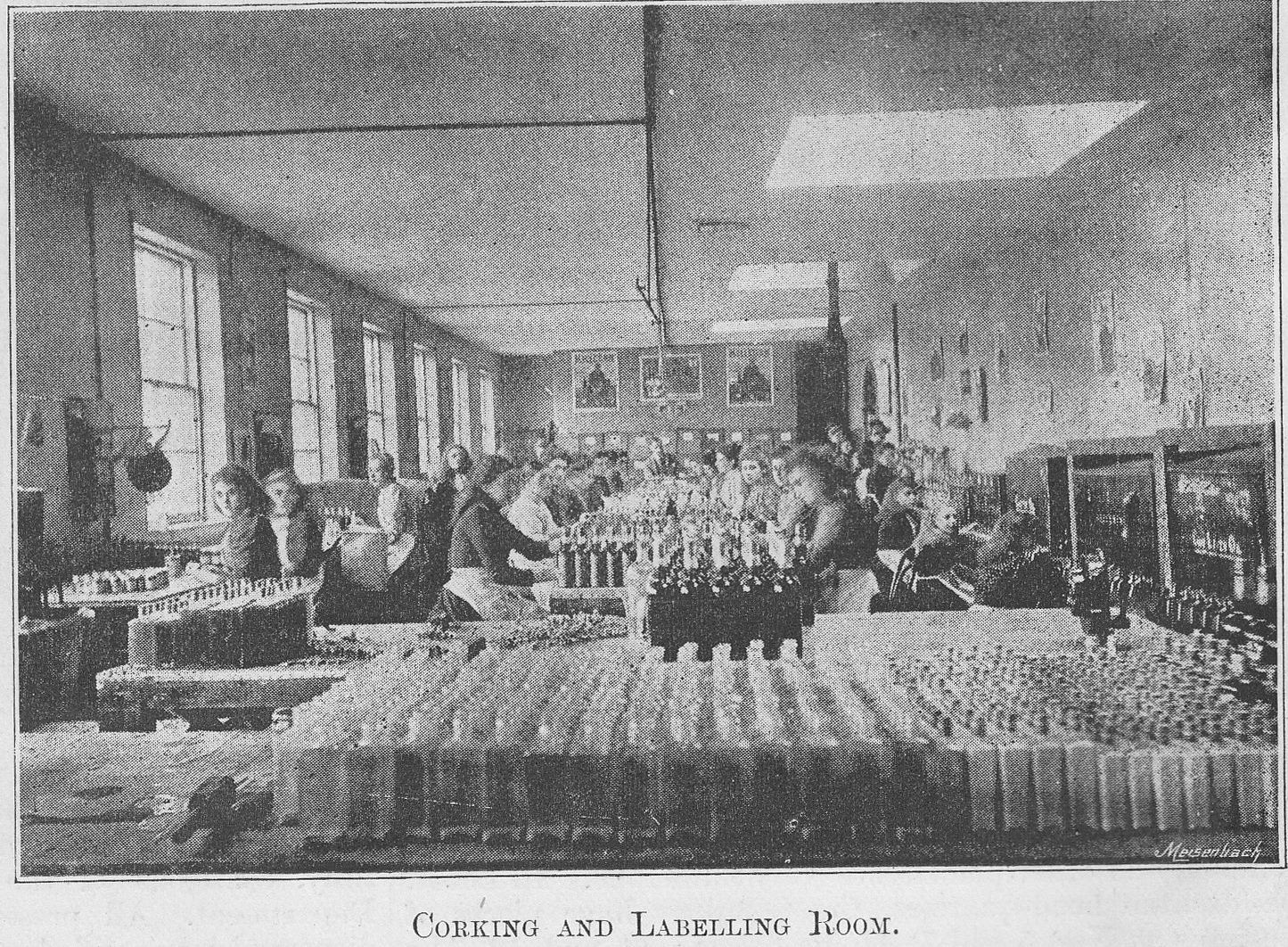
In the large receiving department we witness a busy scene, for here all the goods are received, unpacked, checked, and dispatched to their respective rooms. Next to this, is the department charged with the opposite duty, viz., that of despatching the various goods in response to orders received. All the goods are collected here from the producing departments and stores, and are then checked, and sent out to the Company’s branches or customers, as the case may be, the re-checking of invoices and forwarding notes being done in the office. We now take a look at the Printing Department, where a great portion of the Company’s printing is done, and, for this purpose, a staff of compositors and printers are constantly employed: a capable and practical printer being in charge of the branch.
In the Patent Medicine Stores, we see a large collection of the Company’s own manufactures, as well as other specialities, for which they have an enormous sale. Noticeable in this stock are such items as the popular corn remedy, “Mason’s Killcorn,” “Our own” brand of lavender water, the famous Clifford hair restorer, Dr. Brown’s cough cure, Dr. Butler’s tic and toothache cure, Taylor’s herbaline, and an immense variety of articles equally well known, and as highly-appreciated as these. Adjoining this room is the store for pills and ointments, infants’ necessaries, candies, tapes, night-lights, &c., and further on again, we come to the department dealing with filters, seltzogenes, syringes, &c. Here, a very diversified stock is kept, including the best makes of fitted seltzogenes, wire-covered; glass and metal syringes for all purposes, and filters on the best modern principles.
The Brush Department is one to which the Company attach special importance. The stock here is, undoubtedly, one of the most varied and extensive in the kingdom, and the Company claim to sell at from 25 to 30 per cent, under retail prices in this department, and there is every reason to believe that such is the case. The hair brushes, of which the Company have an immense variety, are all of the best quality bristles, and range in price from ls. 6d. to 14s. Cloth brushes, hat brushes, crumb, nail, flesh and tooth brushes, and every kind of carpet brush, bottle brushes, dish brushes, lamp, jewellers’, scrubbing, stove, spoke, water, whitewashers’, bath brushes, are equally good and moderate in price. This department is managed by Mr. Hobkinson, who is certainly to be congratulated on its general efficiency, and the capital stock which is kept on hand. We now pass on to the sweet department, which includes such items as medicated wines, perfumery, and are next to the ticketing and labelling departments, and the room where packing in wrappers, bottling and boxing are carried on.
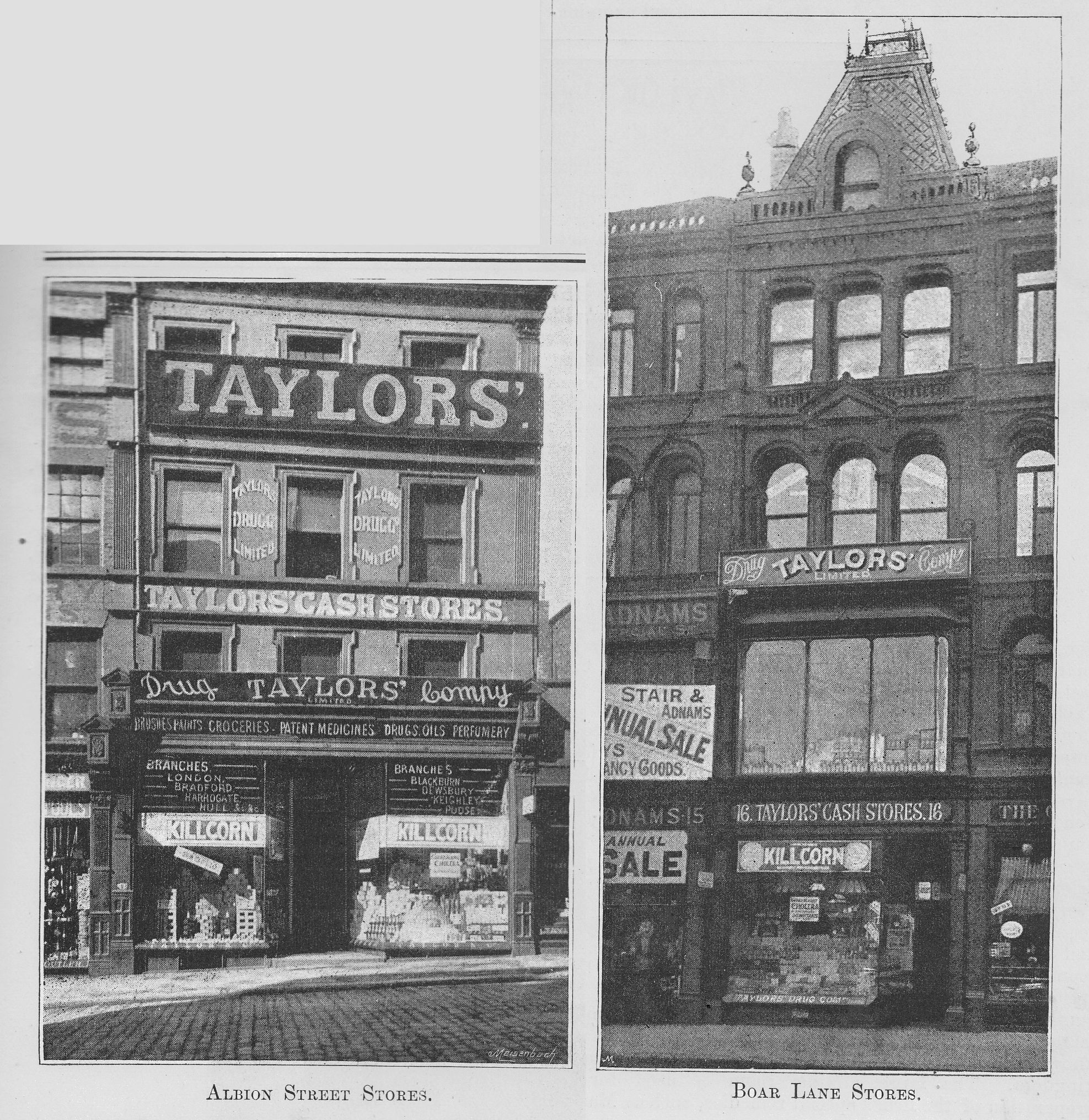
The next department to which our attention is directed, is that dealing with tea. This is a department of the business to which very great attention has been paid by the Company. The teas are chiefly Ceylon and Indian, but they are blended in such manners that some splendid samples of what we may almost term ideal teas are obtained. There are quite a number of sub-divisions in this branch of the business. There are the rooms for mashing, tasting, blending, breaking, mixing, packet filling and packing, both by machinery and by hand. The management of this department is entrusted to Mr. Moss, whose success is attested by the extraordinary amount of business which is done in tea by the firm. Mr. Moss also acts as the tea taster to the firm, and is an acknowledged expert in this difficult work. A peep into his office discovers his modus operandi, for the visitor here sees a row of tea cups, which may excite his curiosity, but which, in reality, serve as the crucibles in which the several varieties are tested. Every kind of tea, before finding its way into the general stock, is subjected to the ordeal of Mr Moss’s critical examination, so that the Company are enabled to guarantee the quality of each blend which they recommend to their customers. Among the various blends which Messrs. Taylor make a speciality of, one, at least, should be mentioned. This is the “Tea of Health,” and it certainly deserves all the good which can be said of it, for it combines in itself all the valuable characteristics of delicate flavour and aroma, as well as the additional recommendation of a very moderate price.
In another portion of the building we come to four rooms, which are used as laboratories. These are fitted with stills, boilers, pans, driers, stoves, tanks, and bottling apparatus, and are in every way equipped in a most suitable manner to their requirements. There are also here, oil tanks, analytical and test appliances of every description, powder-making rooms, &c., and all of these are presided over by a specially qualified manager, Mr. Richardson. This gentleman has served in the various capacities as manufacturing chemist in a large chemical works, and in well-known laboratories of leading drug manufactories in the kingdom. The large mixing room is used for the preparation of the firm’s special remedies, such as Mason’s Killcorn, Mason’s compound syrups of the hypophosphites, pills and powders, manufactured from special recipes, seidlitz powders, baking powders, &c. Further on we come to the room where the noted lavender water and other perfumery is manufactured, and adjoining this is a huge department for storing the reserve stock of bottles. This is rather a marvel, and shows the vast extent of the company’s requirements. Many thousands of specially-made and shaped bottles, vials, and phials are stored here, the racks filling a large portion of this floor. The remaining stores include departments devoted to dry-saltery, groceries in bulk, veterinary medicines, wet rooms for liquids, oils, &c.; paints and varnishes, dry goods, soaps, two large ante-rooms containing cotton wool, &c., rooms for sponges and lofahs, Italian warehouse goods, spices, dried fruits, rice and similar goods. As an illustration of the great care the Company take in order to ensure purity of their goods, we may mention that the room for currants, &c., is fitted with a patent cleanser, which effectually removes all impurities, &c. Many millions of corks, of assorted sizes, are stored in a room devoted to this purpose, and, indeed, everything is arranged on a large and even lavish scale, with all the most approved modern accessories.
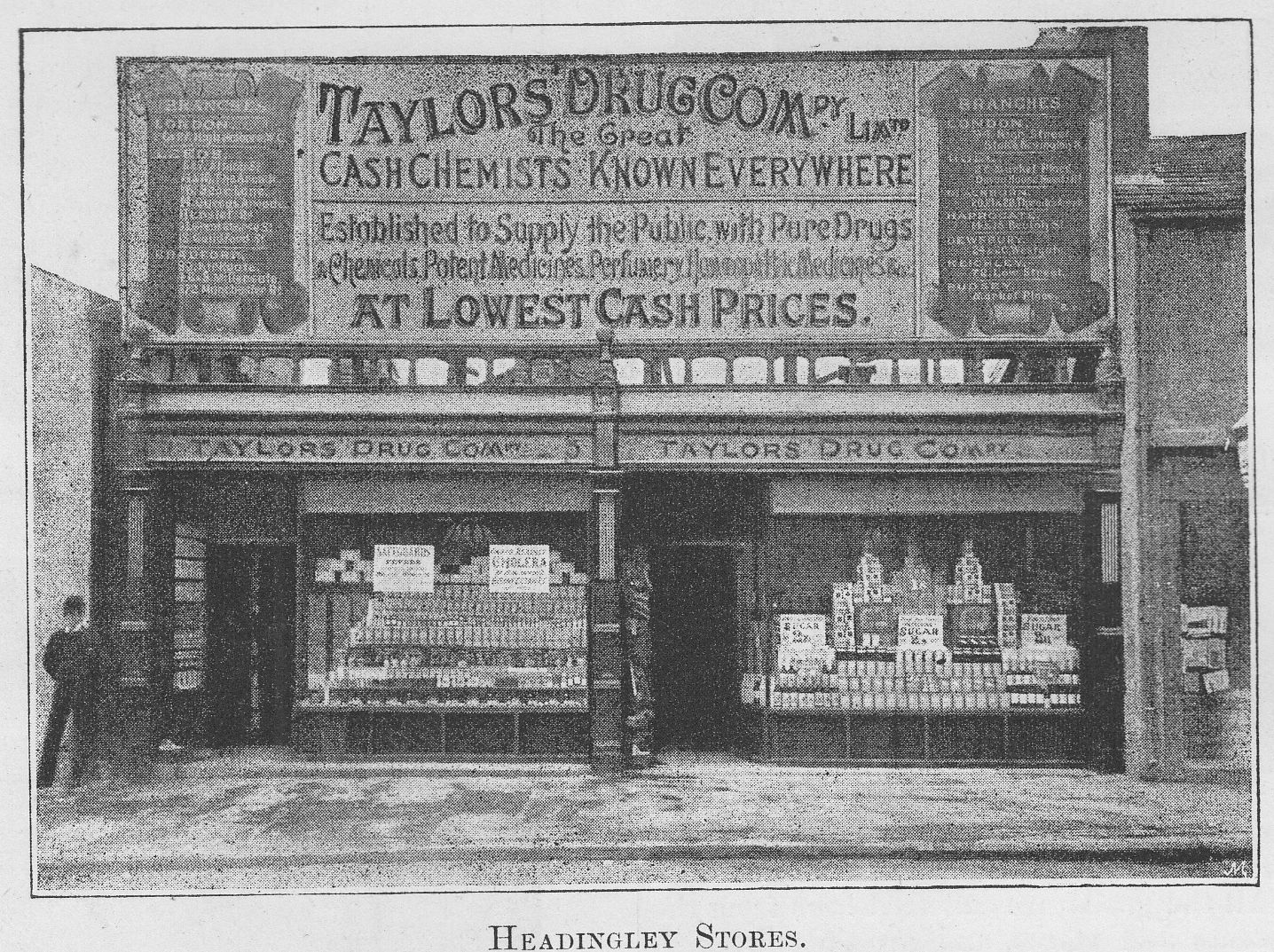
There are, in all, some 200 hands employed on these premises, and the cleanliness and perfection of all the sanitary and other arrangements make this place one of the most healthy and agreeable industrial establishments in Leeds. The greatest precautions possible are taken in order to ensure against any accidents with poisons, all of these goods being kept under lock and key in a separate enclosed department. As we remarked with reference to the dispensing of medicines, we may also say of all the articles compounded here, they are, without exception, made from the very purest and best ingredients which can be procured, and owing to the large quantities used, the Company may be said to enjoy the pick of the market in drugs and other items of their business. Mr. Mason himself is indefatigable in his attention to business, but he also finds distraction from the cares of business in the exercise of his many social engagements. His power of organisation and commercial enterprise need no other testimonial than already exists in the magnificent and widespread business which he has built up.
MR. W. R. WHITELOCK, ENGLISH AND FOREIGN PIANOFORTE AND ORGAN WAREHOUSE,
Boar Lane and Albion Street.
There is, perhaps, no trade or profession of so high an importance as pianoforte and organ dealing that has so much to contend with in the shape of unpractical, and too often unprincipled, persons endeavouring to obtain a share of the profits that legitimately belong to the bond fide pianoforte warehouseman whom years of study and experience have made acquainted with the details of his intricate calling. It is not very difficult to understand this, however, when the fact is realised that comparatively few people who purchase musical instruments have any knowledge, beyond the most superficial, if even that, of what constitutes a good piano or organ, or whether it will retain the tone and quality it apparently possesses when first bought. A handsome appearance and temporary brilliance of tone cover up any defects of construction, and the phenomenally large reductions made on the nominal price hinting at a great bargain being secured, the purchaser is often tempted to take an instrument that, in a very short while, is practically a useless piece of show furniture in the house. Side by side with this certainly unsatisfactory state of affairs is the fact that the taste for music among the general public has vastly increased of recent years, and that pianos, once almost exclusively to be found in the homes of the wealthy, are now possessed and used by almost all classes of society. We are now, undoubtedly, in a musical age, and though there is a danger of their not going the right way to achieve their object, it is naturally the wish of everyone purchasing an instrument to secure one that will turn out satisfactorily.
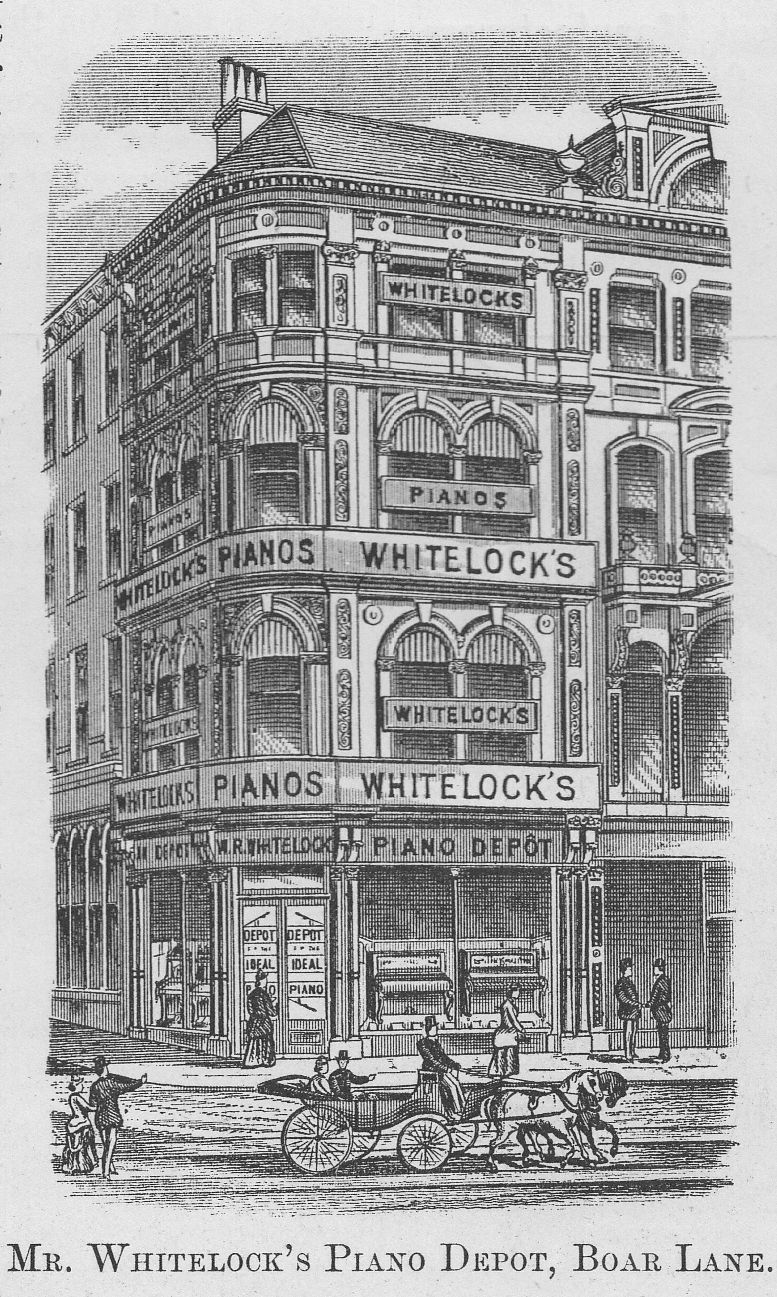
Can there then be any doubt that the person best calculated to supply such an instrument is one having a practical as well as a theoretical knowledge of the trade? Not much, we imagine, and it is with pleasure, therefore, that we introduce to our readers’ notice the name of Mr. W. R. Whitelock. He is the representative of a family which has been engaged in the musical instrument trade for a period of over eighty years; he has studied the business himself, and after mastering the practical part of the pianoforte trade, commenced business at Armley in 1877, whence he removed to New Station Street, Leeds. Finding his premises too small for the purposes of his trade, a move was made to the central and commodious four-story building now occupied at the corner of Boar Lane and Albion Street, in the ground floor windows of which beautiful specimens of the pianoforte manufacturer’s art may always be seen. The warehouse stands in a splendid position for business, and as the whole of the four stories are utilized for showing stock, the space at Mr. Whitelock’s disposal is even more than it appears at first sight; large as it is, however, more could be done with, and as it is the establishment is supplemented by an extensive stock warehouse, and mechanical and repairing department in Gascoigne Street.
In the showrooms at Boar Lane and Albion Street pianos by some of the best English makers may be tried and inspected, and there is, besides, certainly one of the best collections of Foreign makers’ instruments that we have seen. Here we may mention that instruments by any maker may, if not in stock, be promptly procured for customers at very liberal discounts off list prices. There is plenty to admire among the various English and foreign instruments, but our attention may with profit be diverted to Mr. Whitelock’s great speciality, the “IDEAL” piano. The title borne by these instruments is a capital epitome of the many good qualifies they present. It had long been Mr. Whitelock’s aim to place before his patrons, the public, a pianoforte that should realise the ideal of the accomplished musician and connoisseur, and at the same time one that would stand the strain both of hard work, and of our variable climate. This, be it said to his credit, he has succeeded admirably in doing. Having his own ideas as to what such an instrument should embody, he entered into negotiations with Messrs. E. Gors and Kallman, the celebrated manufacturers of Berlin, and the result was an instrument that has been pronounced by the highest authorities as well as the general public, a perfect one, in fact, an “IDEAL,” and that has brought to its ingenious originator a share of success perhaps never before achieved by one particular speciality of the kind. We may digress for a moment to notice also that Messrs. Gors and Kalleman have in their general manufacture of pianos enjoyed a very large measure of success in all parts of the world, more so perhaps than any other maker during the last decade. Nor does Mr. Whitelock’s connection with the excellence of the “Ideal” end merely with its origination; every instrument, as soon as received from the manufacturer, is gone thoroughly over at the warehouse and toned and regulated to the utmost nicety, so that the purchaser receives it in the very best possible condition. These pianos have made Mr. Whitelock’s name familiar through the whole of Yorkshire and in many other parts of the country, and he may well be proud of the success they have achieved. The testimonials received from those to whom he has sup- plied them are highly flattering, will be seen on perusing the beautiful catalogue issued, which will be sent gratis on application. It is almost needless to say that the “IDEAL” piano has encountered considerable opposition from interested quarters, but it is an undoubted satisfaction to the proprietor to know that its sterling qualities have proved their own worth, and that the sales of the instruments are increasing every year. The pianos are in some instances very handsomely ornamented, and every one contains the most recent improvements and perfect workmanship throughout, as is evidenced by the extraordinary durability.
While still in the pianoforte department, we may mention a very handy little novelty we saw here; this is a piano of five octaves, intended for children’s practice, it is a most convenient little instrument, and in its size is particularly suited for juvenile students, while possessing a good tone, and all the advantages of a full-sized piano. The stock of American organs kept is also worthy of note; Mr. Whitelock is sole agent for the Estey organs, and also keeps the productions of such firms as Bell, Smith, and others. These instruments have a showroom to themselves.
A very large business is done in all branches, an immense number of pianos, etc., being let out on the hire purchase system. Very advantageous terms are. offered to purchasers under this system, and liberal discounts are also given for cash. Any instrument not giving entire satisfaction may be exchanged free of cost within twelve months, thus allowing customers ample time to be perfectly assured of the value of the instrument selected. We specially note that every instrument is marked in plain figures, so that in case of exchange it is not an easy matter to add anything to the price of the new piano, a practice very much in vogue at present.
Mr. Whitelock employs a staff of thoroughly-skilled tuners and repairers, and all work of this kind is carried out most conscientiously, a feature that those who have had instruments injured by incompetent men will appreciate. A practical man himself, the proprietor of the business sees that those who work under his direction are thoroughly competent to carry out the tasks allotted them, and his reward is seen in the confidence reposed in him by his patrons. As we stated in our opening remarks, the pianoforte trade has all the evils of unscrupulous competition to contend with, but it is some consolation to know that practical merit does not, after all, go unrewarded; there is little doubt but that Mr. Whitelock will long be able to look with unconcern on the efforts of mere piano sellers to attract the eye of his customers by offering them apparently cheap goods, inasmuch as it is quite impossible for them to offer at any price whatever the sound guarantee that his skill and experience gives.
Z. BARRACLOUGH AND SONS, GOLDSMITHS, SILVERSMITHS, DIAMOND MERCHANTS, WATCH AND CLOCK MANUFACTURERS, SILVER CUTLERS.
Established 1805.
Commercial Street and Briggate.
For nearly a century the position at the junction of Briggate and Commercial Street has been occupied by a high-class goldsmith’ s business, and it is perhaps one of the best known business corners in Yorkshire. In the large range of windows, and inside are always to be seen an immense, stock of artistic, and in many cases, rare specimens of the goldsmith’s art, in addition to some of the choicest gems, and finest examples of horology. From what we have seen and heard of this house, we should say that it is the best establishment that intending purchasers can possibly visit, as they will receive every attention and consideration from the proprietors, and, at the same time, have the full benefit of their experience and knowledge of the various branches of the business. In addition to their already large stock, there are always prepared to submit designs, and make anything specially adapted to the wants of their numerous connection. In this department, they have executed some very special pieces of plate for presentation purposes, such as large trays, dessert services, dinner services, large bowls, tea and coffee services, etc. One of the last things they produced was the silver cradle, which was very generally admired, presented to Alderman and Mrs. Boothroyd (the Mayor and Mayoress), to commemorate the birth of their daughter during his Worship’s year of office.
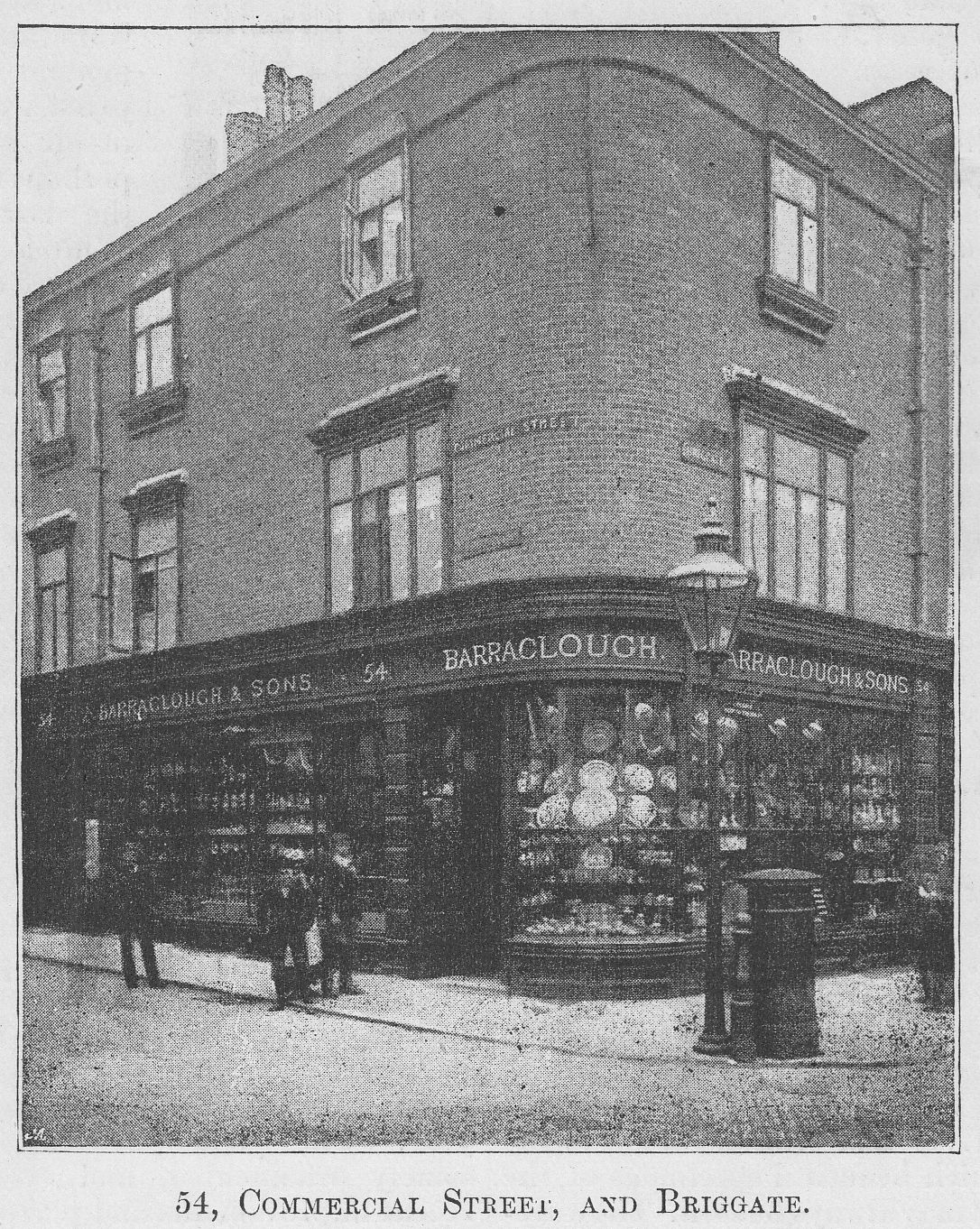
Some of the specimens of chasing and engraving shown to us were really perfect examples of the silversmith’s craft. The fashion of giving wedding presents has very much to do with the development of this branch of the business, and from the stock here displayed, we think no one could experience any difficulty in making an appropriate selection. Even the cases in which these goods are frequently sent are worthy of note. Their style and quality we have never seen surpassed.
In the purchase of diamonds and other gems, it is wise to have the advice of a competent jeweller who has made them a special study, to ensure getting something that will be satisfactory and always looked upon with pleasure. The gems here are mostly purchased direct, and specially mounted to designs of Messrs. Z. Barraclough and Sons, who, we may add, are licensed valuers. We were shown some very fine specimens, both mounted and loose, and specially admired the profusion of fine rings, pendants, brooches, bracelets, etc. Their stock of adjusted watches, some of which have taken very high awards at Kew Observatory, is all that could be desired. Clocks of every description, from the small carriage clocks to the large English chiming clocks suitable for the hall, or dining-room, are here in good array also. Table cutlery of every description, which has all been specially manufactured, so that it can be thoroughly relied on. Choice ivory hair-brushes, cloth and velvet brushes and mirrors, toilet boxes, etc., silver and ivory fitted dressing bags, and fine leather goods are largely dealt in.
In workshops specially adapted to their particular business are carried on repairing in all its branches, engraving, etc. In conclusion, we would add that every detail of the business is under the personal supervision of the proprietors, Mr. James and Mr. Herbert Barraclough, who deal only in the highest class of goods, and by their energy and taste have rendered their business one of the most attractive in Leeds.
THE GRAND RESTAURANT.
Proprietor: Mr. A. E. Ives,
Boar Lane.
The convenience afforded travellers and business men by the establishment of first-class restaurants, can scarcely be over estimated; and it is not too much to say that the presence or absence of high-class places of this nature goes far to render the existence of a man, compelled to remain in town the whole day, tolerable or otherwise. The size of Leeds renders it inevitable that a large number of persons are forced to defer the principal meal of the day till towards its close, or else to partake of it away from home. In addition there is always a very considerable floating population visiting the town for the day either on business or pleasure, and to each it is a matter of great importance that there should be within reach a restaurant that fulfils in every respect its claim to be a house of refreshment and repose. Such is the Grand Restaurant in Boar Lane, the best example of its class in the whole of this populous centre; and, that it stands so in the estimation of the Leeds public, we are sure, ample proof of this existing in the numbers who patronise it regularly the year round. It possesses a great advantage from its situation, being in the centre of the principal commercial thoroughfare of Leeds, and within two minutes’ walk of the joint railway stations. Structurally, it is one of the most imposing edifices in Boar Lane; it is solidly-built of stone, and, as each of its three stories are lofty, its height is considerable.
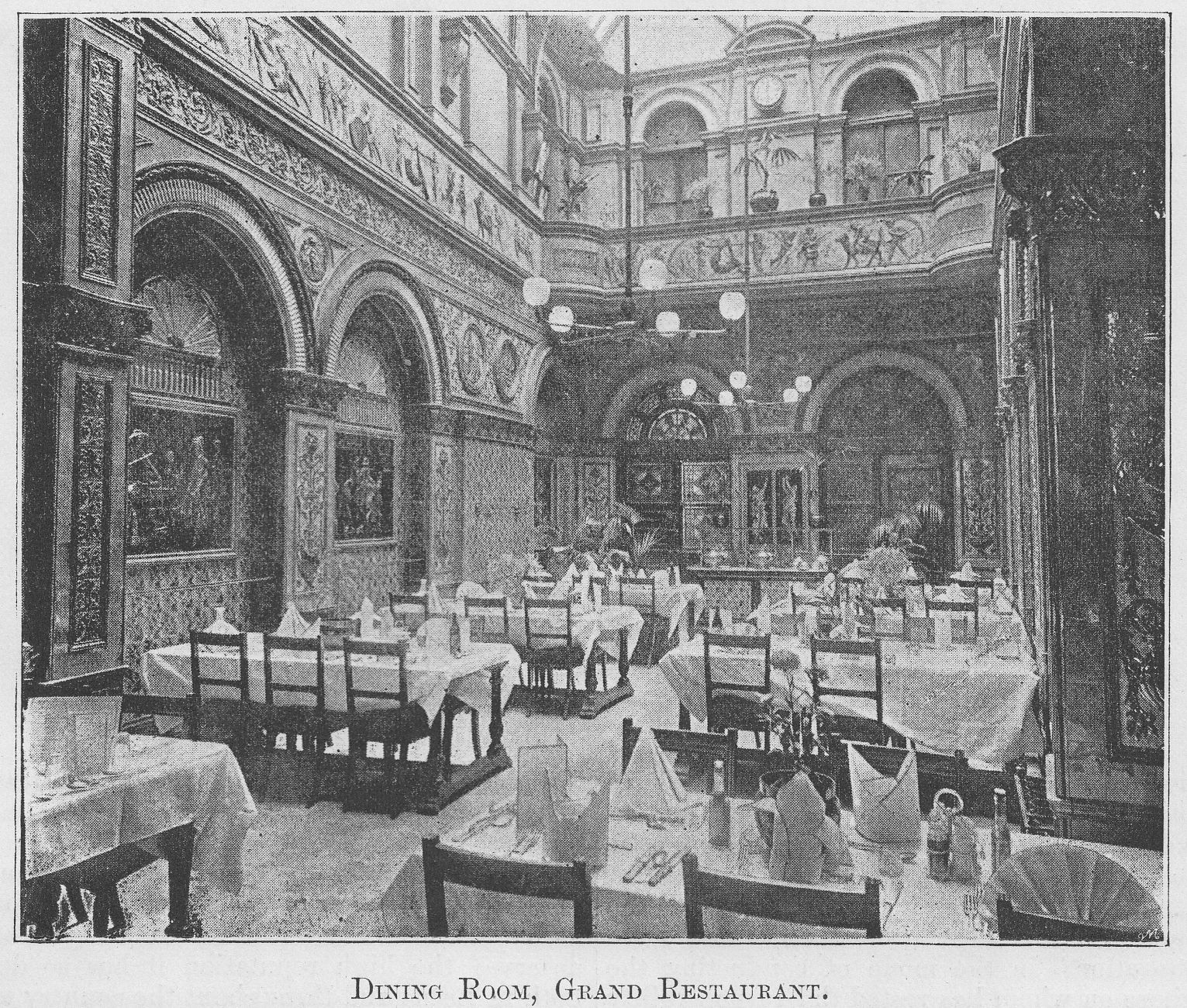
Entering by the main entrance in Boar Lane, we are in a corridor flanked on the left-hand by the principal dining-room, and on the right by the bars and a wide stair-case leading to the rooms above, while at the end is a noble apartment used as a smoke-room. There are also two entrances from Alfred Street, giving access to the bars and to the grill-room, and one of the billiard saloons in the basement. The principal dining-room is a splendid chamber, one-half of it being open to the roof, from which light is admitted through a skylight. The walls are handsomely decorated with Burmantoft’s faience of exceedingly artistic and appropriate design; and an ample sufficiency of greenery, in the shape of growing palms, ferns, etc., being judiciously arranged about the room, an admirable general effect is obtained. The furniture and accessories are of a correspondingly high-class, and a more comfortable if, indeed, we may not say sumptuous place to dine in, one could not desire. As for the edibles provided, they are of the very best description, and whether we choose to dine a la carte, to participate in the marvellously reasonable 2/- table d'hote, or to rest content with a steak or chop from the grill, we have the certainty of being served in as satisfactory a manner, and at as cheap a rate as at any place in the kingdom.
Supposing, too, that our thoughts lie not in the direction of dinner, or that we desire a reposeful half-hour after dining, we shall find in the fine smoke-room accommodation which may truthfully be described as luxurious. Easy lounges, comfortable chairs, papers representing almost the whole gamut of the daily and weekly press, and electric bells within easy reach to summon willing attendants, are here; while the extensive proportions of the chamber are too great to permit of the devotees of Nicotiana being inconvenienced by the incense arising from their own offerings. Adjoining the smoke-room is a perfectly-kept lavatory, where the luxury of a wash and brush-up may be indulged in.
Ascending the stairs, of which there is a flight at each end of the building; we reach another corridor, at each end of which is a fine billiard-saloon, the space on one side being occupied by private dining or supper-rooms, while, on the other, large windows look on to the dining-hall beneath. The billiard-saloons, including the one in the basement, contain two tables each by a first-class London maker, every necessary appointment for the game being at hand. The saloons are lofty, well-lighted, and comfortably-fitted and efficient attendants are in charge. The top story is devoted to the use of those of the large staff of attendants who reside on the premises, and here also Mr. Ives, the proprietor, has a private suite of rooms. The grill-room, in the basement, is much patronised by those who prefer a steak or chop in the day-time to a more substantial meal, and its arrangements are fully in keeping with the rest of the house. The wines, spirits, malt liquors, aerated waters, cigars, etc., sold are necessarily of the best quality, and this is all the more appreciable, as the prices are based upon anything but a prohibitive scale; in fact, the charges made here are below what we have met in any establishment of similar standing. Mr. Ives fully recognizes the fact that a demand exists for accommodation of a superior class in this line, and that which he has provided is as different from the ordinary restaurant, too often met with, as can be imagined; as a consequence, "The Grand” is well patronised, and is certainly one of the most popular institutions connected with every-day life in Leeds.
MESSRS. MARSHALL AND SNELGROVE, SILK MERCERS,
Bond Street.
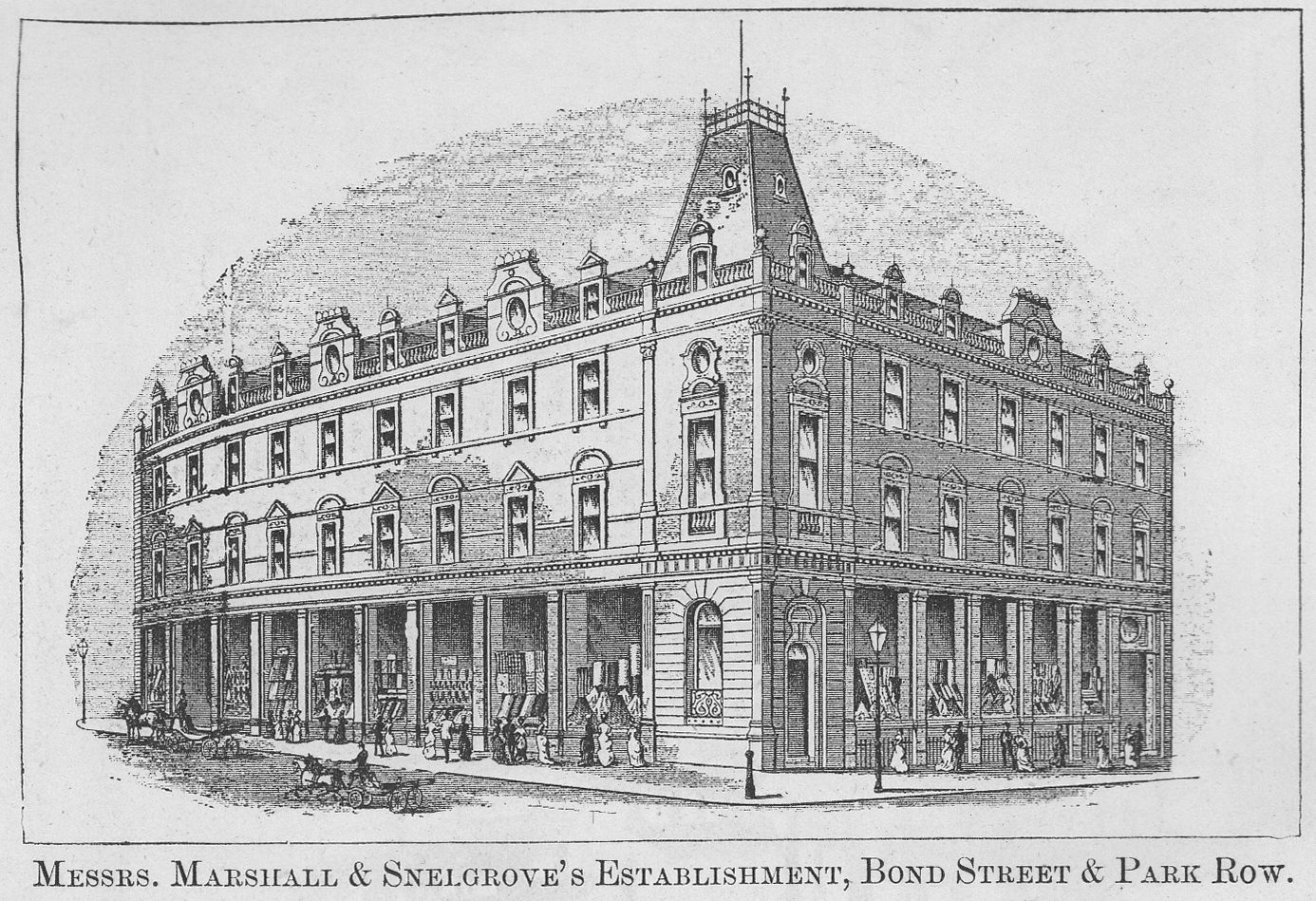
The firm of Marshall and Snelgrove has a history dating back half a century or more, during which lengthy period of time it has not only made exceptional progress, but has contributed in some degree to give Leeds a distinctive prominence as a shopping centre among the leading towns in the North of England. The block of buildings occupied by the firm has two entrances, one in Bond Street, and one in Park Row, and are nearly opposite the General Post Office, and within a minute’s walk of the Central Station. During the fifty years in which the operations of the house have been carried on, there have been many innovations in the mode of conducting the business; but those on whom has rested the responsibility of controlling its affairs have never been slow to keep pace with the times, and to take advantage of the latest and most fashionable styles. There are, of course, many different departments constituting the business — silks and drapery; family and complimentary mourning; family and household linen; carpets, shawls, cloaks and ribbons; millinery and dressmaking; ladies’ outfitting and baby-linen: besides numerous others of lesser note, combine to form one of the most complete and attractive shows of general drapery in the Kingdom. To control this large business the same system as laid out for the government of the London house is in vogue, and the wisdom of this is seen in the perfect manner in which each department works under its individual head. In every sense the concern deserves the high reputation it has so deservedly made both in Leeds and throughout the country generally.
MR. W. R. GARD, MILITARY, CLERICAL, AND CIVIL TAILOR,
22, Commercial Street.
Mr. Gard’s business has the advantage of being situated in one of the best and most central thoroughfares of the town, and is of a character calculated to maintain for Commercial Street its claim to be a fashionable shopping centre. The premises are in no way obtrusive, though of substantial appearance, but of agreeable design and harmoniously decorated, and in all respects handsomely appointed. Mr. Gard’s clientele is of a thoroughly high-class and permanent character, raising him above any great anxiety to catch the casual visitor, and leaving him at peace to conduct to perfection his business operations. At the same time we have no doubt that Mr. Gard is at all times ready to extend those operations to all who require good quality in their materials, the best workmanship, and an adviser with regard to matters of dress — who is thoroughly acquainted with the latest styles and fashions. This high character has been maintained for over 20 years by the use of the best materials, the employment of the best cutters and the most experienced workmen. He is at all times cognizant of the slightest change in fashion, and may be relied upon to produce the very latest style of garment. His customers are kept at all times en rapport with these changes by brief circulars announcing the receipt of new patterns and the arrival of new materials. He makes special features of military and clerical outfits and liveries, in which workmanship of a very high-class is shown. This is indeed the case with all work done, and these qualities, together with an ample stock and every convenience, combine to make Mr. Gard’s business one of the best and most fashionable in the town, and one, moreover, patronised by the best classes of society.
MESSRS. HIRST AND LEECH, GENERAL FURNISHING AND BUILDERS’ Ironmongers,
70, Briggate.
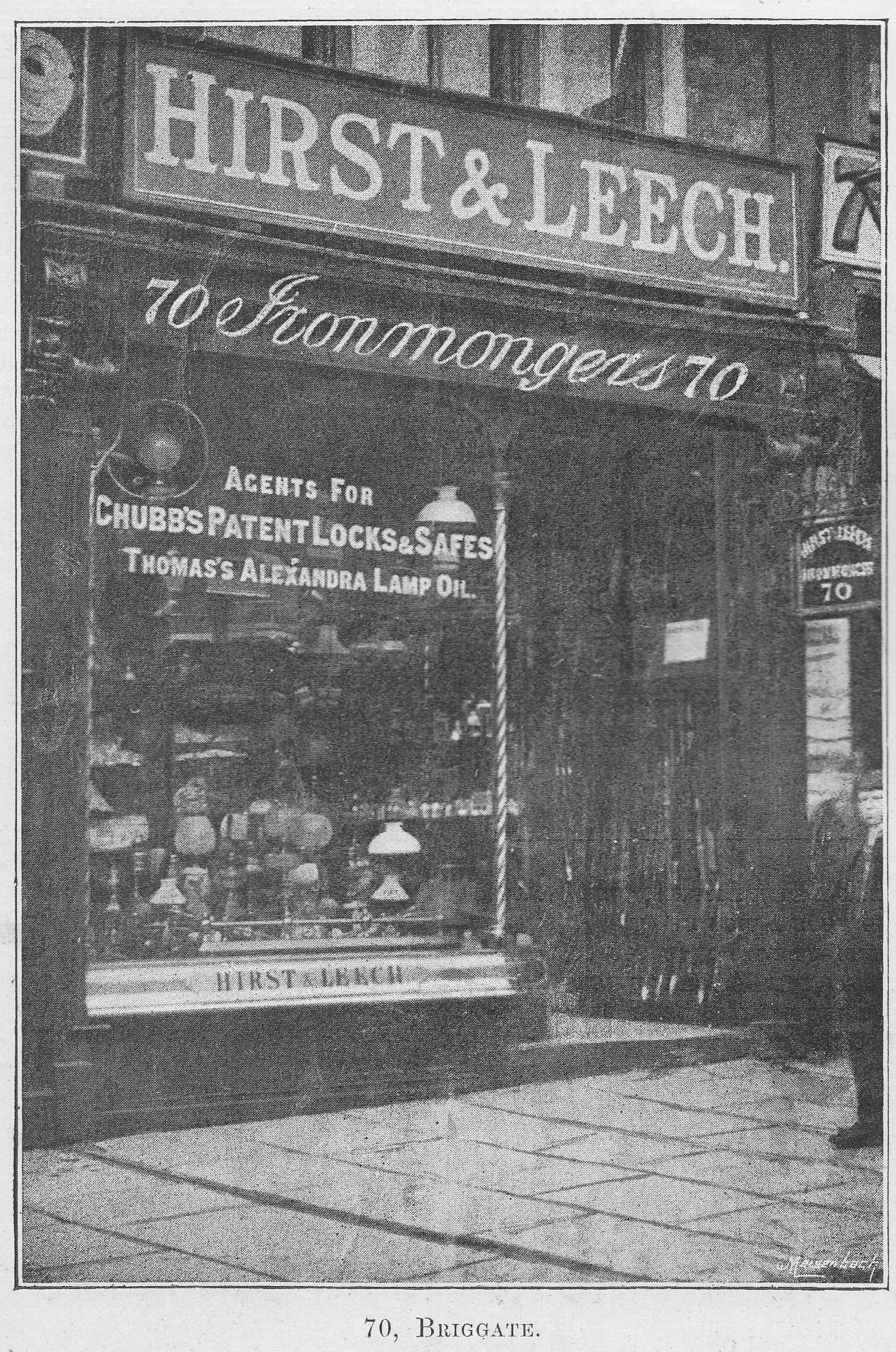
We could hardly choose a better representative of the general ironmongery business than the firm whose name heads this article, and, as our engraving will show, the appearance of their premises is fully in keeping with the position the house holds in the commerce of Leeds. Though the firm has only been in existence for three years, it offers to patrons all the advantages that old-established houses are generally credited with, while it is conducted on the most advanced lines of modern trading in such matters as heavy and comprehensive stocking, moderate prices, etc. The success of the business in a town where so much competition exists, is, of course, chiefly due to the enterprise and good business experience of the two partners, Mr. Hirst having been seventeen years with the late Mr. John Tennant, of 38, Briggate, whilst Mr. Leech was for eleven years associated with the late firm of James Nelson and Sons, 47, Briggate. With so favourable a start, and with the advantage of possessing good business premises in a leading thoroughfare of the town, in which a large and high-quality stock is kept, it is not at all surprising to learn that a first-class business has been built up in the retail department, whilst a good wholesale connection has also been secured.
Messrs. Hirst and Leech endeavour to keep, and, we may add, succeed in keeping their stock up to a pitch of completeness that renders it fully equal to all demands likely to be made upon it. The show of better class of ironmongery goods is remarkably good, and from a merely spectacular point of view, the show is especially attractive through the free display made of goods of an ornamental nature, of which so many examples are constantly being introduced, in which connection we may draw special attention to the stock of beautiful lamps and shades which are prominent objects in the window. There are large showrooms on the first and second floors which are well set-out with the leading and most important articles in the trade. Amongst these, kitchen ranges, marble and enamelled slate mantels, stoves, fire-grates and tile-hearths occupy prominent positions, and ornamental hall, and other lamps are very strongly in evidence. Many of the fancy coal-vases shown are very handsome, and there is also, a well-assorted stock of table and general cutlery, and all kinds of culinary utensils, and other household ironmongery. It must not, however, be supposed that the business is of a purely ornamental character, or is confined to domestic ironmongery; on the contrarv, the firm caters largely for builders and other tradesmen, particularly in the important items of locks, brass-foundery, workmen’s tools, etc.; the heavy goods belonging to this department being stored in the basement. The firm are the sole agents for Leeds and district for Chubb’s celebrated safes, steel doors, locks, and other articles.
MESSRS. C. HOLLIDAY AND CO., ARTISTS’ COLOURMEN, AND PICTURE FRAME MANUFACTURERS,
62, New Briggate.
Mr. Holliday, who was formerly manager for Mr. Bogg, of Woodhouse Lane, has recently opened this establishment. The site chosen is an excellent one, and opposite the old Church of St. John the Evangelist, and the shop is arranged and stocked in a thoroughly business-like manner. Mr. Holliday has had a lengthy experience of the trade, which will naturally stand him in good stead during his business career, He relies for support upon the production of reliable work, keeping fully up to date, and moderate charges. The stock of mouldings is a large one, in best English gold, Cologne and German gilt, oak, silver, ebonised, etc., from which materials frames in all styles and designs are manufactured. Mounting boards, glass and every requisite for the picture-framing trade, are also sold. The stock of artists’ materials is very complete, embracing colours, brushes, pencils, crayons, etc. Oil and water-colour pictures are on view, and the latest designs in flower and landscape studies are obtainable here. The proprietor attends to all details of the business, and the house should have a prosperous career.
MR. FRED. DIXON. THE CYCLISTS’ LIVERY STABLES,
19, King Charles Croft.
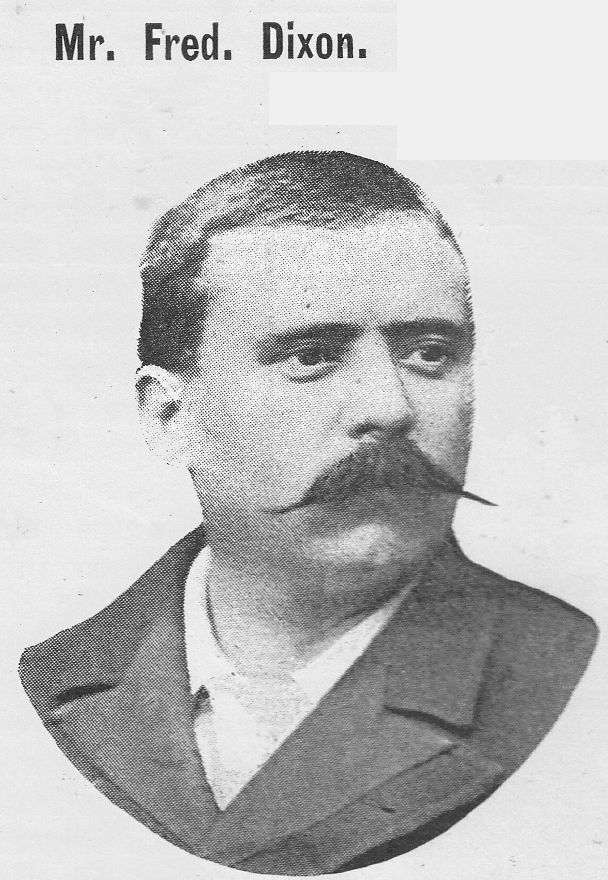
It is always pleasant to witness the nursing of a bright idea and watch its development under the hands of a determined and enthusiastic man. This has been our experience during some visits to Mr. Fred. Dixon, who is about to assume the position of the Cyclists’ Indispensable Friend. He has recently entered into possession of extensive premises in King Charles Croft, near the Theatre Royal, which were originally erected for auctioneers’ offices and sale-room and until recently occupied by a wholesale grocer. In front the building is two-storied and contains rooms suitable for offices and waiting-rooms; and behind this is the building which has taken Mr. Dixon’s fancy and our own. It is about 70 feet long and 30 feet wide. The roof, which is well-lighted, is supported by decorative wooden arches, somewhat ecclesiastic in character, and the floor is evenly concreted. This Mr. Dixon has turned into a Cyclists’ Livery Stable and comfortable resort,
Along the centre are elevated platforms on which about 30 bicycles are placed in movable iron stands. These are made by the firms which Mr. Dixon represents — these being Messrs. Turner, Fellows and Co. (Limited), of Dudley, the Tower Cycle Co., of Wolverhampton, the North-Western Cycle Co., of Manchester and Coventry, and the Leicester Cycle Co. From amongst them he called our attention to a beautiful little machine weighing 26 lbs., made by Messrs. Turner, Fellows and Co., and warranted for 12 months. It has tangent wheels, light cranks, rat-trap pedals, ball bearings, Dunlop Pneumatic tyres, and is up to date in every respect. Its cost is £17 10s, net. He recommends this as a marvel of quality for the money. He also pointed out a heavier machine, made by the Tower Cycle Co., weighing 421bs., upon which he has himself ridden 4,000 miles. Its tyre is still in excellent condition and not a single spoke loose. Mr. Dixon himself weighs 13st. 41bs. and has ridden it over the roughest roads, not hesitating to jerk the machine, while riding, from the roadway over the curb-stone on to the side walk. It has, therefore, stood the roughest test, and cost only £14 when new.
A machine which seems to be a particularly good speciality is the Seddon Pneumatic Tyre Bicycle, made by the Tower Co. and costing £14 10s. Another very favourite machine is “The Commodore,” which is manufactured by the North-Western Cycle Co., of Manchester and Coventry. The rapid advance of this firm in the Cycle World is a matter of surprise until one inspects their machines. The workmanship is of the very best, and the design of the popular Humber pattern, whilst the comfortable position and easy running is all that can be desired by the most fastidious cyclist. The tubing is all of the finest light gauge, Credenda steel, and the fact that the Company was awarded the gold medal at the Sportsman’s Exhibition held in Manchester on May 5th, 1892, for “excellence of design and workmanship” is alone sufficient proof of their sterling qualities. The No. 4 Light Roadster scales 29 lbs. and is one of the finest machines ridden.
Lastly we may mention a very noted machine, notably “The Peregrine.” The manufacturers of this cycle are the Leicester Cycle Co., and it is built on the most modern Humber lines. The tubing is all of the finest Credenda steel, of light gauge, and for beauty of design, excellence of workmanship, and finish, few machines in the market are equal, whilst it is excelled by none. The extraordinary performance by Mr. T. A. Edge, of Manchester, in June last, when he rode from Land’s End to John O’Groats in 4 days and 40 minutes (beating record by 10 and a-half hours) and the 1,000 miles in 5 days 11 and a-half hours by the same rider, alone speaks volumes as to its easy running, splendid construction and workmanship, and fully warrants its place in the front ranks of cycle manufacture. The semi-racer scales 29 lbs. and the roadster, 36 lbs., both with pneumatic tyres,
The platform upon which these rest is covered with red cloth and fitted with proper supports, and the clear space round them used as a track for trying the speed and effectiveness of any machine. The spaces round the walls are to be covered with the advertisements of bicycle manufacturers and vendors of special appliances. The entire hall is to be decorated and made attractive by the addition of foliage plants, settees, &c., our illustration giving a good idea of what is intended, and the lavatory, which is already in existence at one end, is to be much extended and fitted with every possible convenience. Added to this, light refreshments will be always at hand, and Mr. Dixon has just taken out a cigar and tobacco license with the object of meeting every requirement of purchasers who come to inspect machines, or of cyclists fatigued with a long ride.
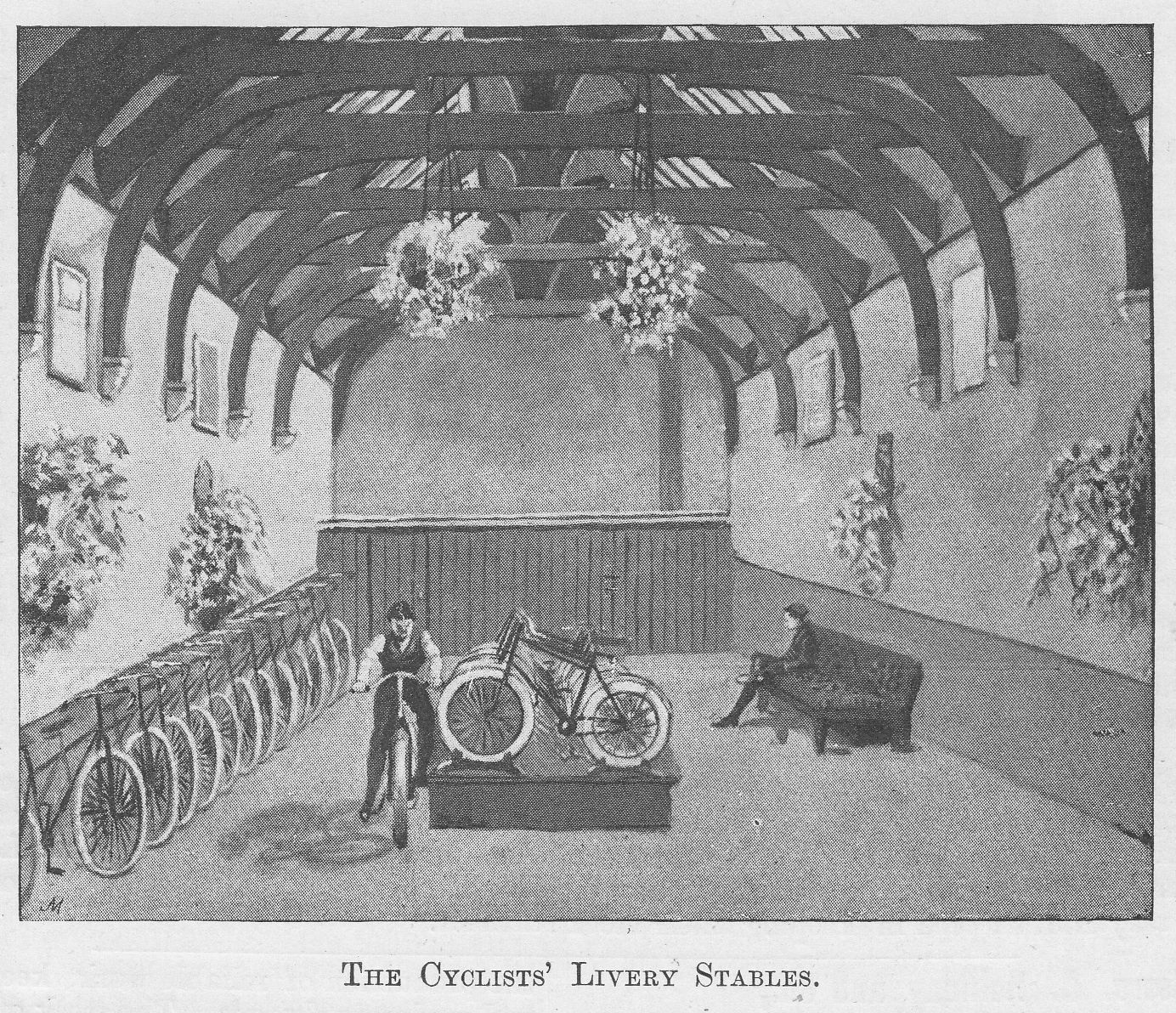
All cycling papers will be found here and other literature even remotely interesting to cyclists, as well as information respecting roads, hotels and the topography of the neighbouring counties. Any cyclist visiting the town can bring his machine here, get a wash and brush up, every information he may require, and a lounge for the charge of 6d. He can have his, machine thoroughly well-cleaned and oiled by experienced hands for a further charge of 6d., or can leave it in “stable” for any number of days at the rate of 2d. per day. Machines may be left here all the winter, when they will be properly looked after and frequently moved, as the continual standing in one position injures the tyres. Special terms are offered to clubs, and contracts arranged by the month or year. Every purchaser of a machine at the “stable” will receive a free Insurance Policy under the Accident Insurance Co., which guarantees £100 in case of death from a cycle accident and 10s. per week for total disablement under the same circumstances. The scheme is quite an original one, and Mr. Dixon, being himself an experienced rider, a traveller in other countries beside his own, and a well-informed business man, is naturally fitted to develop such an enterprise; and make himself an indispensable friend to cyclists. He is determined on the success of his scheme, and we think, with him, that it requires only to be well-known. Although not long started the Cyclists’ Livery-Stables already promise to be not only a very useful organization, but also a luxurious and entertaining place of repose.
MESSRS. J. O. WALKER AND CO., PROVISION DEALERS,
107, Briggate.
This is one of the oldest businesses of its kind in Leeds, its foundation dating back more than half-a-century, and though in external appearance it is not very pretentious, its repute as a reliable source for obtaining provisions of all kinds, extends far and wide. Its career has been one of gradual progress, and the accession of Messrs. J. O. Walker and Co. to the proprietorship about five years ago, marks an epoch in its existence, and gives a date to one of the most important events in its career. The members of the firm are possessed of wide experience and sound practical knowledge of the details of each department, and they have long-standing connections with the leading Wholesale houses from whence sound and reliable household provisions come; and during their management of this business they have confined their attention exclusively to the highest phases of the provision trade. The premises are situated at 107, Briggate, about the centre of this leading thoroughfare. The shop is comparatively small, but we do not suppose we are giving news when we say it is the centre of the highest class of trade in Leeds. From this establishment many of the leading hotels and restaurants in the town obtain their supplies, and among their patrons Messrs. Walker and Co. number many of the most influential residents.
Purity and freshness are the features Which most particularly recommend the productions of the establishment. Prime well-cured hams and bacon, cheese in the different varieties of Cheddar, Stilton, Gorgonzola and other specialities, lard, butter and eggs from the best dairy farms, potted meats, fish, &c., from the leading houses and in the most popular brands are on hand, and in short, throughout the entire business there is a manifest desire to provide none but the best and most commendable goods. The members of the firm exercise a personal supervision over every matter connected with their business, and spare no pains to render the establishment worthy of public support. Not the least pleasing characteristic of the place is its appearance, which is always bright and appetising.
MR. KNIGHT HARDY, CARVER AND GILDER,
74, Woodhouse Lane.
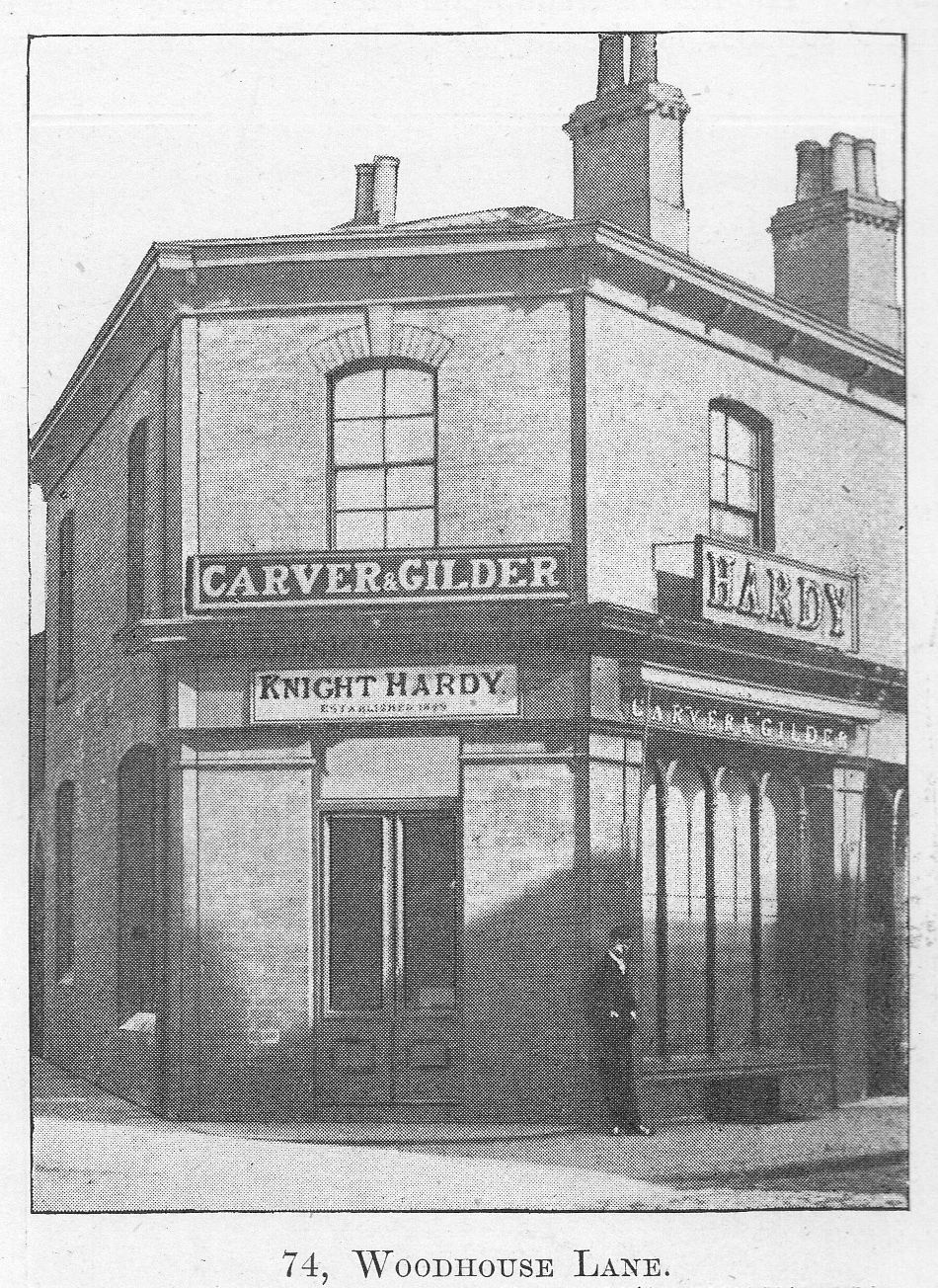
In modern days there has been a great revival of artistic taste in England, and, in no respect is this better exemplified than in the general advance made in recent years in beautifying our homes and our furniture with carvings, gilding, or the works of art. In the carving and gilding trade, the houses in Leeds are well above the average, and in this article we wish to refer particularly to a shop which has a special interest for artiste, professional and amateurs, as for the general public. We refer to Mr. Knight Hardy’s establishment, carver and gilder, of 74, Woodhouse Lane, near the Marble Works (corner of St. Columbia Street). The present proprietor has the advantage of reaping the benefit of his late father’s life-experience in the business; he is painstaking and practical, but his work is more a labour of love than of mere business. This is the true secret of his success, for, with his great experience, and early training, and well-known skill and delicacy of workmanship, anyone who entrusts him with artistic work may feel certain that neither pains nor industry will be spared in its perfect execution.
The business, which was established by Mr. K. Hardy in the year 1849, comprises various branches, each detail being supervised by the proprietor. A large business is done in making all descriptions of plain and artistic picture frames, and many well-known artists living at a distance regularly send Mr. Knight Hardy their works to be framed and mounted. In gilding and re-gilding he does a large business, re-gilding Picture and Looking-glass frames being a speciality; he also executes the gilding of Chairs, Console Tables, and other artistic furniture in a highly creditable manner, only the best English beaten gold being used throughout. He has had a long and varied experience in cleaning and restoring valuable Family Portraits, which, with the back-lining, cleaning, restoring, and re-varnishing oil-paintings by the old masters, as well as the bleaching and renovating of old and valuable engravings have always been objects of special study with Mr. Knight Hardy, and we know of no place where such work is more likely to be carried out with success and at a reasonable cost than at his establishment.
MR. BENJAMIN B. SNELL, GENERAL AND FURNISHING IRONMONGER,
59, New Briggate.
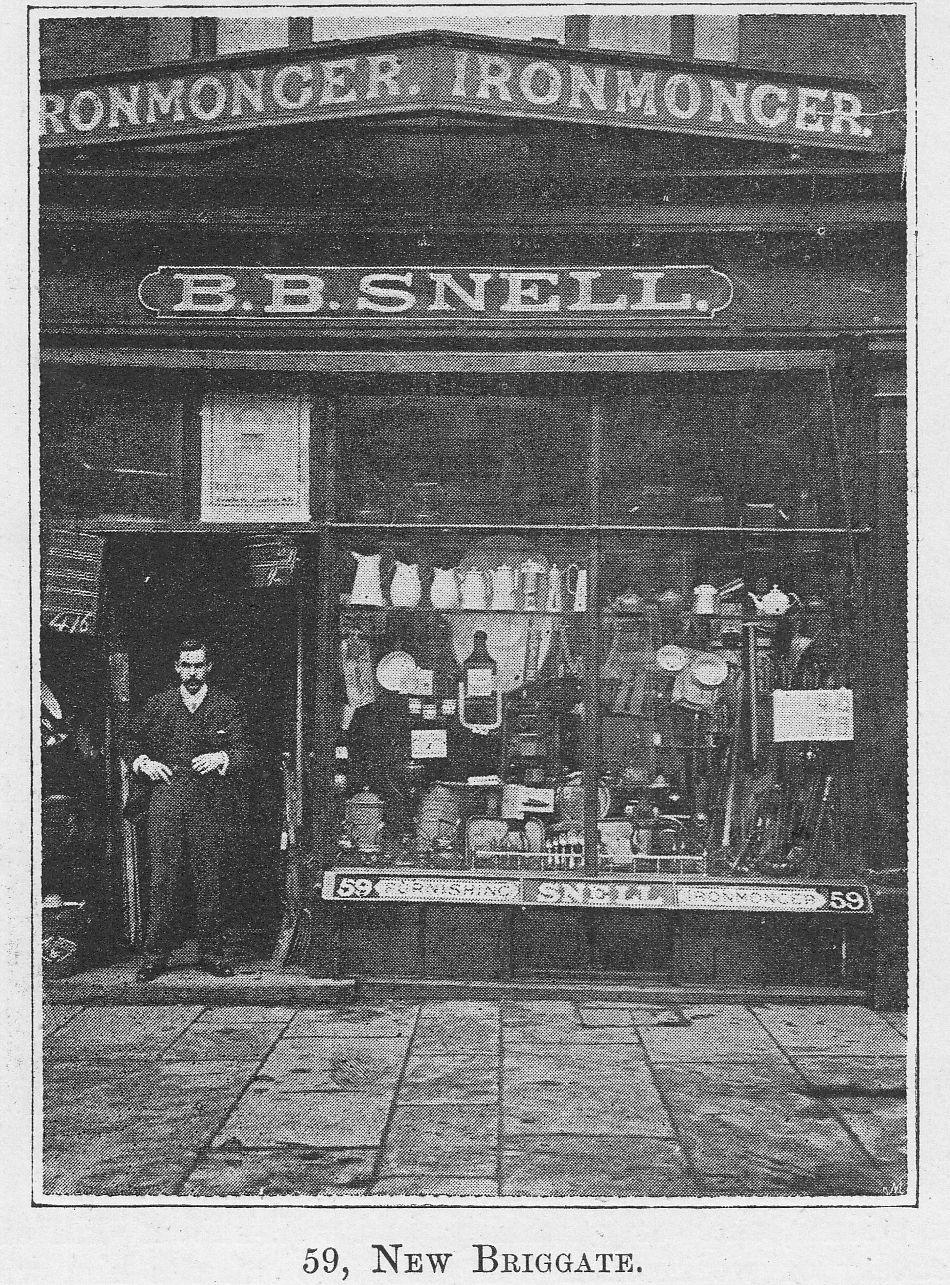
Mr. Snell, who for many years was with the late Mr. John Tennant, of Briggate, has within the last few months started business for himself in suitable premises in the New Briggate, nearly opposite the Grand Theatre; and as he brings to bear upon his undertaking good experience it may be confidently predicted that his commercial venture will meet with a return commensurate to the enterprise displayed. The line of trade upon which he chiefly relies for public support is the supply of household and domestic ironmongery of both a useful and ornamental description. Articles of this kind are so numerous and so constantly in request that, given a good stock such as we find in this establishment, a business may be well kept going. Though household ironmongery is the leading line of the business, it does not form the exclusive feature of the stock, which includes a good supply of joiners’ ironmongery, trade requisites, workmen’s tools, and articles of that description. Nor is the business confined to the sale department only; the proprietor is himself a practical worker, and he has the assistance of a good staff of competent workmen, who are sent to all parts of the town and district to execute repairs, which are promptly attended to, the work being done either on the premises or at the residences of the customers. Brass-work is cleaned and re-lacquered and restored equal to new, and all kinds of ironmongery work promptly and efficiently executed. The special features among the goods supplied at 59, New Briggate, which we have not previously noticed, are the stock of mixed enamels and the large collection of travelling trunks of all sizes.
MESSRS. E. MILLER & CO., LTD., THE NORTH OF ENGLAND FURNISHING DEPOT,
42, North St.
We have here one of the largest furnishing manufactories and depots to be found in the North of England. Providence House, as the establishment is called, covers an area of 32,549 square feet, and the number of work- people employed is over a hundred, whilst the stock is the largest and most varied to be found in any part of the kingdom. This includes drawing-room specialities of the most artistic kind in rosewood, walnut, and mahogany, and for style and finish these can scarcely be surpassed. A number of the chairs, settees, and other articles are very beautifully finished in tapestry, plush, frieze, embossed and Genoa velvets, in accordance with the taste of the present day. A special attraction is to be found in the bamboo and Japanese articles. The dining-room, hall, library, and bedroom furniture have all their special excellences. The suites of the latter are in every known wood, and the bedsteads, in brass, iron, and enamel, present an immense stock for selection. There is also to be found a splendid stock of carpets, rugs, and linoleums. The premises are well-situated in North Street, at the junction of that thoroughfare with Briggate, within a stone’s-throw of the Grand Theatre, and seven or eight minutes’ walk from the Station.
A prominent feature in the structure is the clock-tower, with its illuminated clock, which stands at the angle facing North Street and New Briggate, and which is of great service to the public, and is greatly appreciated. The sky-sign, which stands 70 feet above the building — being the highest in Yorkshire — can be seen from most parts of Leeds. The two showrooms on the ground floor have a frontage of over 100 feet of plate glass. The premises behind these rooms are used for packing, and at the back there is a large hoist to the top of the building, where the work-shops are situated. Behind the main building is a large open space, surrounded by warehouses and Workshops belonging to the firm. There are also in the yard sheds for stacking timber. Adjoining these is a workshop for furniture painting, and, in another part, housing for 14 vans of very large size, used for the removal of domestic furniture.
From this yard we enter the basement by a slope, and find ourselves in the stockrooms for unpolished furniture and bedsteads. On the left is the engine-house, with one of Crossley’s 16-h.p. gas engines, which drives the saws and other machinery in the cabinet-makers’ workshops at the top of the building, the communication being established by means of shafting; here, also, is the powerful dynamo for the electric lights. Still farther in the recesses of the basement, and beneath the roadway, is a store for the more valuable sorts of veneers, such as pollard oak, rosewood, walnut, and mahogany. Ascending to the ground floor, we find, at the rear of the shop, stores for grates, fenders, fire-irons, etc. Adjoining this is a large hall, with spacious stairway leading to the showrooms, and on the sides of this are placed articles of furniture. A room at the foot of the stairs contains every article of office furniture, while at the top of the stairs are other storerooms for valuable furniture of small size, stationery, printing, and pictures. On the right of the landing is the showroom, containing a fine collection of bric-a-brac, pianos, and other musical instruments, and on the left a room for polished furniture made on the premises.
We then enter the large showrooms over the shop. In the first of these, which is in the angle of the premises, is a fine large stock of cabinet goods, and in the false roof are stored frames for drawing and dining-room suites. In the adjoining showroom, which, like the first, is very lofty, are shown bedsteads, bedding, and mattresses of every kind; also a splendid stock of tapestry, Brussels, Scotch, Wilton, Axminster, and velvet-pile carpets, also linoleums, skins, rugs, etc., and in another part, draperies, curtains, blinds, and general materials for upholstery. At the back of this room is the polishing-room, in which about 25 polishers are constantly engaged; numerous articles being stacked at one end awaiting the operation. Another flight of stairs leads us to the cabinet-making-room — the largest cabinet work-room in Yorkshire, and lighted by electricity — containing 25 or 30 benches. The machinery consists of two circular saws, band saw, moulding machine, morticing and boring machine, glass-papering machine, and veneering machine. Another flight of stairs brings us to the top of the premises, where the upholstery-room, which is well-lighted and fitted with electric lights, is situated.
MESSRS. WILLIAMS AND CO., COURT, NAVAL AND MILITARY TAILORS, HABIT MAKERS, AND LADIES’ COSTUMIER,
75, Briggate.
There exists a very wide difference between the various grades of the tailoring trade; in its lower branches it is simply a commercial speculation, in carrying out which the manufacturer neither sees nor knows anything of the ultimate possessors of the goods he makes, but simply bases his operations on his opportunities of producing articles at the very lowest remunerative rates. On the other hand, in its higher developments tailoring becomes essentially a fine art, and in the skilful operator’s hands the most successful results are achieved. It is our agreeable duty in this article to treat of professors of the sartorial art who are capable of holding their own and producing garments fully equal to those turned out by any London house. We refer to Messrs. Williams and Co., Court, Naval and Military Tailors, Habit Makers and Ladies’ Costumiers, of 75, Briggate, whose business, during the thirteen years it has been established, has been one of the leading ones in Leeds.
The list of specialities for which the house is noted is very lengthy, but we may particularly mention gentlemen’s riding breeches and hunting coats, ladies’ tailoring, and liveries and uniforms. Riding breeches are cut so as to give the greatest comfort to the wearer when in the saddle, either in the close or loose fitting style, and are made either of doeskin, Bedford, or velvet cords, tweeds or leather according to order. Hunting coats of scarlet or black treble-milled Meltons, and waterproof covert coats of every shade are also made. In ladies’ garments Messrs. Williams and Co. have had wide experience, and turn out riding habits, ulsters, military jackets, tailor-made dresses, etc., in the latest styles introduced by the leaders of fashion.
Naval and Military uniforms are made strictly in accordance with regulation patterns. Dies are procured and crests are stamped or engraved on buttons. Dress suits also receive special attention here. The material the proprietors keep in stock is all of first quality, and most varied in style, tweeds, Meltons, English, Scotch and Shetland homespuns, diagonal and livery cloths, and many more besides these, including the latest novelties brought out by leading manufacturers. A branch at 1, Queen’s Arcade, has been open about three years, and the premises are uniformly attractive with the rest of the Arcade. The window is dressed in a very effective manner with a variety of tailoring goods, specimens of trouserings being hung over the rail at the back, and various samples of cloths arranged at the bottom of the window. Mr. F. H. Appleby successfully manages both branches of the business for Messrs. Williams and Co., his efforts giving satisfaction to a very large number of patrons.
MR. JOHN CRAIG, HATTER,
2, Royal Exchange Buildings, Boar Lane.
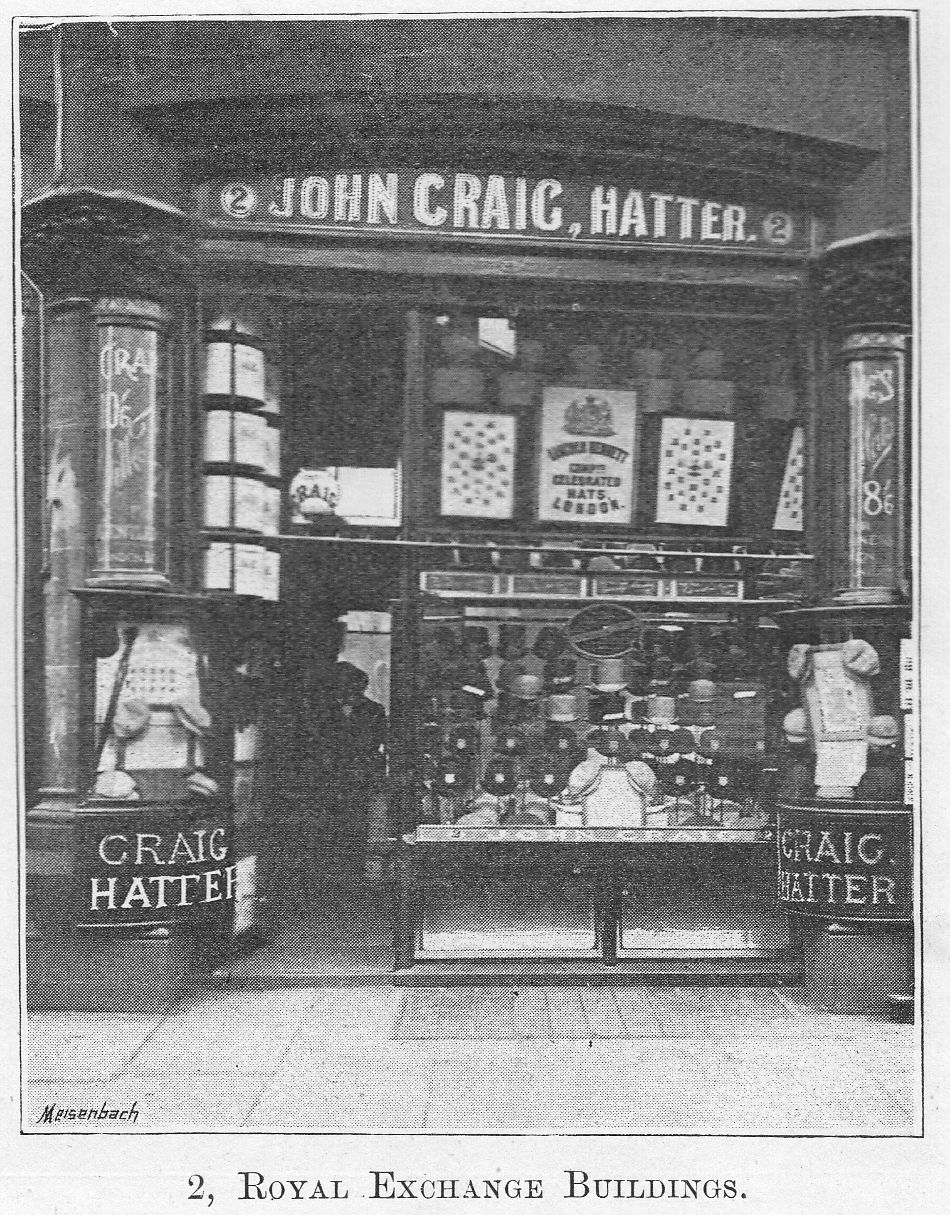
There is, it will be allowed, a very marked difference between the capabilities of various tradesmen to successfully conduct the businesses in which they engage. Some are mere salesmen of certain classes of goods, while others are specialists in their particular lines, and it is to one of this latter class, Mr. John Craig, of 2, Royal Exchange Buildings, that we desire to draw attention here. He carries on business as a hatter, and anyone coming in contact with him will soon understand that he regards his vocation in a light that but too few of his contemporaries do. Mr. Craig believes that a large majority of people pay but little attention when choosing a hat, to the general suitability of the article; as long as it “fits,” i.e., feels comfortable, they trouble little whether it be too high or too low, too broad or too narrow in the brim to suit their style and expression of countenance, and on this account, many, either because of carelessness, or in some cases because of a slavish following of fashion, cause themselves to look somewhat ridiculous. Here it is that Mr. Craig’s art as a hatter comes into play to the customer’s advantage, and if his patrons will, as most of them do, place themselves entirely in his hands, and rely on his discretion to provide them with suitable head-gear, they will have very little cause for complaint. He has been in business in the above premises since 1877, and has always succeeded in meeting the demand for hats of the best quality in a most satisfactory manner. The premises are situate nearly opposite the Midland Station, near the Post Office and Park Row, and on train and ’bus route to all parts of the district.
MR. HENRY CLARKSON, WHOLESALE AND RETAIL PASTRYCOOK, ETC.,
Claypit Lane, Woodhouse Lane.
The name of Mr. Henry Clarkson, of Leeds, is widely- known in connection with the manufacture of his celebrated pork pies, and an inspection of his premises in Claypit Lane attests the fact that his reputation is not unmerited. The business was founded by the father of the present proprietor in 1858, the memorable year in which H.M. the Queen publicly opened the Leeds Town Hall. In fact, this gentleman, Mr. Edward Clarkson, was the pioneer in inducing the licensed victuallers of Leeds to make the sale of pork pies one of the staple commodities of their trade. The frontage of the premises abutts on Claypit Lane, near its junction with Coburg Street, both thoroughfares running into Woodhouse Lane, at a point where Cookridge Street terminates, and consequently near the Colliseum, the Mechanics’ Institute, and the Turkish Baths. The manufactory is a two-story building, on the ground floor of which is the bakehouse, 45 feet by 15 feet, and 12 feet in height. In the well-built oven, 12 feet square, 150 large pies are frequently baked at one time. Besides pork pies, veal and ham pies, beef pies, fruit pies, pastry of all kinds, and even wedding cakes are produced ad libitum.
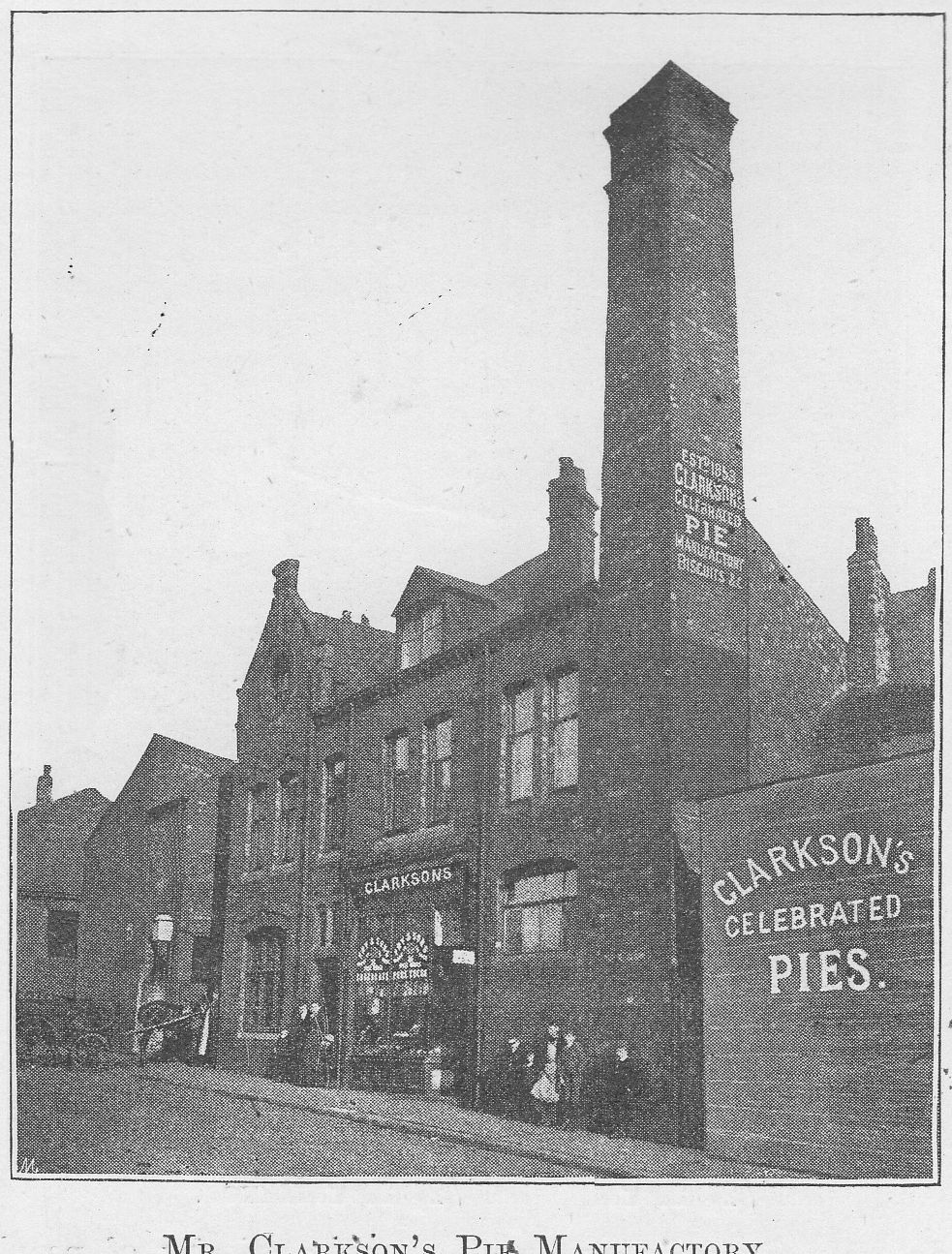
The premises throughout are scrupulously clean, and everywhere order reigns supreme. Beneath the bakehouse, in the basement, is the chopping-room, where a patent “Enterprise” meat-cutting machine cuts up the meat, which is of prime quality only, at the rate of 60 lbs. per hour. Adjoining the chopping-room is a pie store-room, and a cool apartment for making pastry during the summer months. On the first floor, over the bakehouse, is the storeroom, and the office. Sacks of flour are hoisted into the storeroom by means of the strong crane placed outside the doors, thus enabling millers’ carts to draw up in the yard underneath the crane doors and discharge their loads. Two well-fed horses are to be seen in the stable close by, and in close contiguity, a cart and van, by whose joint aid the produce of the establishment is delivered throughout the town and neighbourhood.
Some idea of the extent of the business carried on may be gathered from the fact that 300 dozen small pies are made every week, besides 50 doz. of the celebrated excursion pies. The retail shop adjoins the manufactory; also the residence of the proprietor, who by means of speaking tubes is in prompt communication with every department of his premises. We may also mention that Mr. Clarkson’s premises are connected with his butchers’ establishment in the Shambles by telephone. The trade is of a Superior and general class, being well-established among the licensed victuallers of Leeds and in different parts, of the county of Yorkshire. Parties and schools are also catered for.
Telegrams should be addressed “Pies, Leeds.”
At Kirkstall Abbey, within easy distance of the town by tram-car, Mr. Clarkson has a refreshment room, where, during the summer time, his celebrated pies and pastry are sold in large quantities to the numerous visitors to the interesting and historic abbey; and the refreshment room at Headingly Athletic Grounds, occupied by Messrs. Brown, Carson, and Co., of the “Green. Dragon,” is also supplied by him.
MESSRS. PICKLES AND CO.,
Confectioners, 6, Boar Lane.
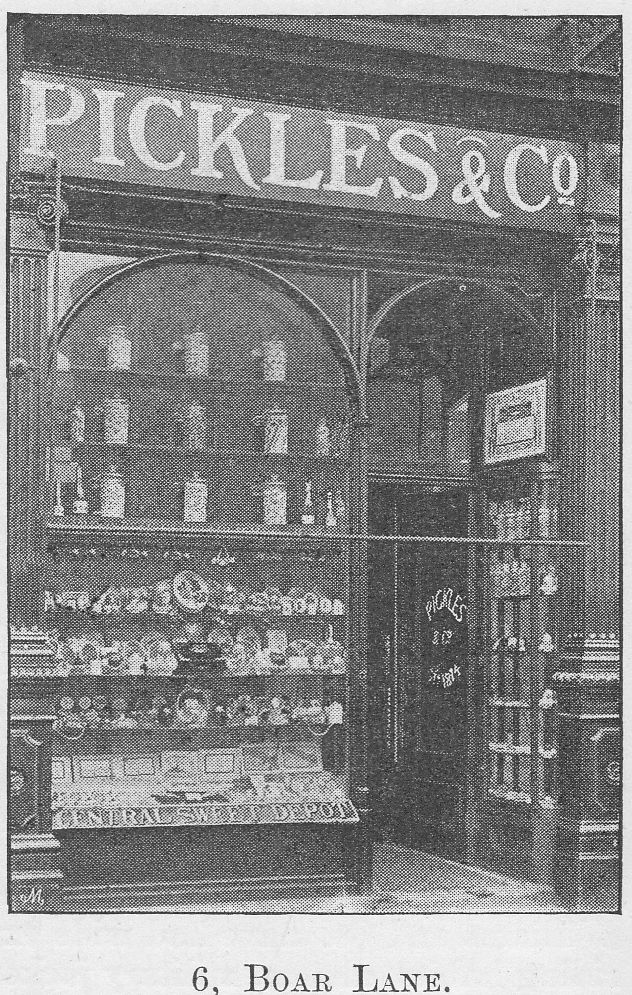
As confectioners, Messrs. Pickles and Co., of 6, Boar. Lane, hold a prominent position in Leeds, which they have sustained from the foundation of their business twenty years ago, their place being one of the leading shops for pure sweets, in consequence of the excellence of the goods they supply. The premises are well-situated for trade, in one of the principal business quarters of the town, next door to the entrance to the Trevelyan Hotel, while being close to the train terminus, they are handy for people coming in from the country. The shop is bright, cheerful and handsome, the effect being greatly enhanced by the electric light which has recently been installed, and while the goods are of a superior class, the prices are exceptionally moderate. The firm deal extensively in English and foreign delicacies of every description, chocolates and bonbons by Cadbury, Fry, and other well-known makers, while they have a large assortment of French and Swiss goods of choice and delicate flavours.
A special feature is made by the firm of chocolate, sweets, &c., packed in handsome boxes and packets, and ranging in price from one penny to a guinea. The latter-priced boxes are really splendid works of art, and are both useful as well as ornamental when the contents have been consumed. The Parisians found out long before we did that sweets were often judged by the same standard that men and women apply to their fellows, that is to say, they are judged not unfrequently by the external appearance; sweets carefully packed in artistic and attractive boxes and packages commanding a quick sale. Messrs. Pickles and Co. recognise this to be the case, and have given almost as great attention to the outward appearance of their, sweetmeats, as they have care and thought to the selection of the conserves themselves.
JOSEPH BROADHEAD, CARVER, GILDER, PICTURE FRAME MAKER, FINE ART DEALER, ETC.,
89 and 91, Albion Street.
The display of oil paintings and art treasures in the windows of Mr. Broadhead’s handsome shop having recently arrested our attention, we acted upon the notice on the door, “Inspection invited,” and invited ourselves to inspect. We found the proprietor a most courteous guide, and were soon busy examining the many treasures which his extensive establishment contains. First we may mention the important collection of oil paintings by modern artists on view amongst them were to be found choice works by T. S. Cooper, R.A., J. F. Herring, George Cole, Edwin Douglas, J. S. Noble, B. W. Leader, A.R.A., Edwin Ellis, L. J. Pott, James Peel, Ernest Crofts, A.R.A., Wm. Hemsley, James Webb, J. B. Pyne, J. C. Dollman, R. W. A. Rouse, H. Moore, P. E. Morris, A.E.A., W. P. Frith, R.A., W. F. Yeames, R.A., and a large selection of others too numerous to mention. Excellent in quality and moderate in price we think it would be difficult for art patrons to find such a variety out of London.
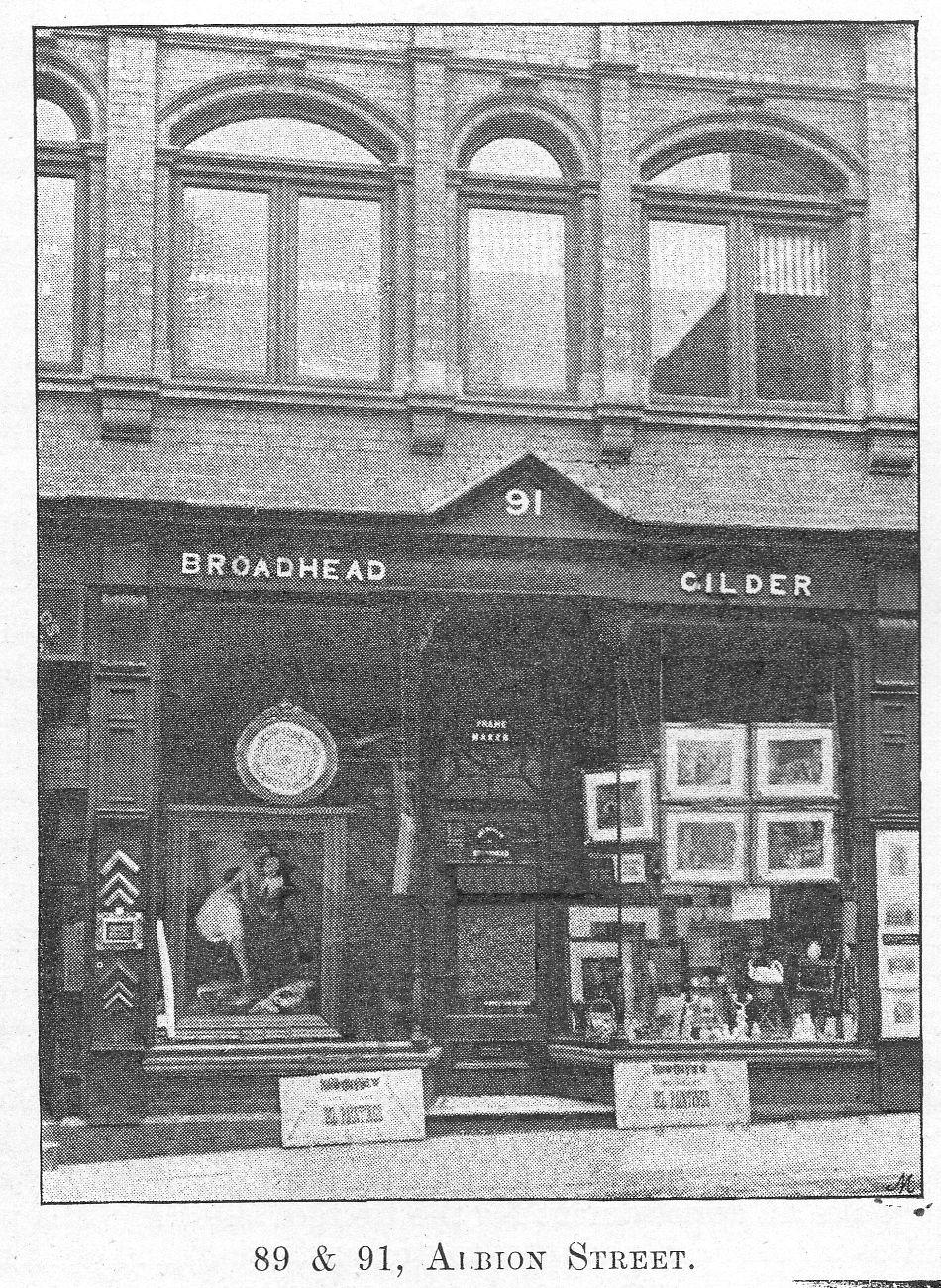
Many examples of picture frames are also shown here, and it is evident that high-class work is aimed at throughout, the most careful workmanship being observable in the gilt and other frames which have been made for mirrors, pictures, etc. At the rear of the front shop are three admirably-arranged and well-lighted picture galleries, where works of art of all kinds in oil, water colours, crayon, steel and other engravings are exposed to view, and in this especial capacity Mr. Broadhead supplies the wants of many patrons, his connection extending over a wide area.
The building is a fine three-storied, commodious one, the upper floors being occupied as storerooms and workshops, and herein skilled workmen are engaged in the manufacture of cornices, picture frames of every description, pole and cheval screens, candelabras, tables, brackets, looking-glasses, etc., for both a wholesale and retail trade. Mr. Broadhead has been engaged in the business — which was founded 60 years ago — a long period. He transacts one of the largest businesses of its kind in the town. For picture-frame making in all its branches, all the latest designs of mouldings in gold, black and gilt, oak, walnut, and white enamel, suitable for oil paintings, water-colour drawings, engravings, etchings, photographs, etc., and oak Oxfords of all sizes are kept in stock. In re-gilding, every description of picture frames, window cornices, glass frames, brackets, candelabras, furniture, etc., are repaired, altered, and regilt equal to new; plush frames are also made to order. In picture cleaning, special attention and care is taken in the removal of varnish, cleaning, restoring, back-lining, and re-varnishing valuable paintings; drawings cleaned and mounted; engravings cleaned, mildew removed, etc. Competent men are sent to all parts for cleaning, re-arranging and hanging collections of pictures, and for packing them. Removals are made by road or rail.
The business is connected with the telephone exchange — telephone No. 865.
MR. JOSEPH STAINES, FAMILY GROCER, WINE AND SPIRIT MERCHANT,
Guildford House, 1, Woodhouse Lane.
Branch Establishment: 77, Woodhouse Lane.
Mr. Staines’ business premises form a most conspicuous feature of the locality in which they are placed. They occupy the vantage-ground of a corner site, and the establishment has a really fine appearance, forming quite an improvement in the neighbourhood. The trade is of an exceedingly high-class character, it being the idea of the proprietor to supply his customers with the best goods. The business having been carried on for many years, has grown into great repute, and possesses and influential and extensive connection both in the town and surrounding districts. Whilst due provision is made for the supply of every description of article included in the line of general grocery and Italian warehousemen, very special attention has been concentrated on the two most important items of tea and coffee.
Concerning the former, perhaps it may not be out of place to explain that Mr. Staines, owing to the residence of personal friends in one of the chief Assam tea districts, has special facilities for procuring a selection of the finest pickings, which he imports direct. These teas are of exceptional richness, producing a fine liquor in the cup, and of the utmost value for blending purposes whilst, for many persons who prefer a pure and unsophisticated Indian tea, their equal will not readily be found. China and Ceylon teas are also selected with very great care, and these are, when necessary, blended and mixed in a manner which cannot fail to please. The Indian teas can be most thoroughly recommended, either blended or unmixed, and it may truly be said that they come direct, with all their freshness, “from the plant to the cup.”
It has been often said that it is a matter of difficulty to obtain good coffee in England; but this seems to be a reproach which is by no means merited, and one which is easily disproved. To ensure the retention of all the native aroma and flavour in coffee, it should be roasted as required. Mr. Joseph Staines has adopted the use of special machinery for this purpose, and for grinding it immediately, so that every customer may procure it perfectly fresh. At No. 1, Woodhouse Lane establishment, the customer may see the pound of coffee placed in the roasting cylinder and ground whilst waiting.
In all classes of goods sold by Mr. Staines, it will be found that good quality has been the primary consideration; at the same time, prices have been kept as low as is consistent with a moderate margin of profit. On glancing at a recently-issued edition of the price-list, it will be found that the figures quoted will bear comparison with those of most stores — Civil Service or ordinary co-operative societies; in many instances prices are fully ten per cent, lower, based upon cash payments or strictly monthly accounts. Mr. Staines delivers goods in Leeds itself and in Chapeltown, Potternewton, Burley, Headingly, etc., every alternate day, whilst weekly deliveries are made to outlying neighbourhoods. A large stock of fine wines and spirits is maintained by Mr. Staines, who is also a bottler of Bass’s ale and Guinness’s stout, agent for Max Greger Co., Ltd., and Schweppe’s soda water.
MR. S. TIMMS, HATTER,
128, Kirkgate.
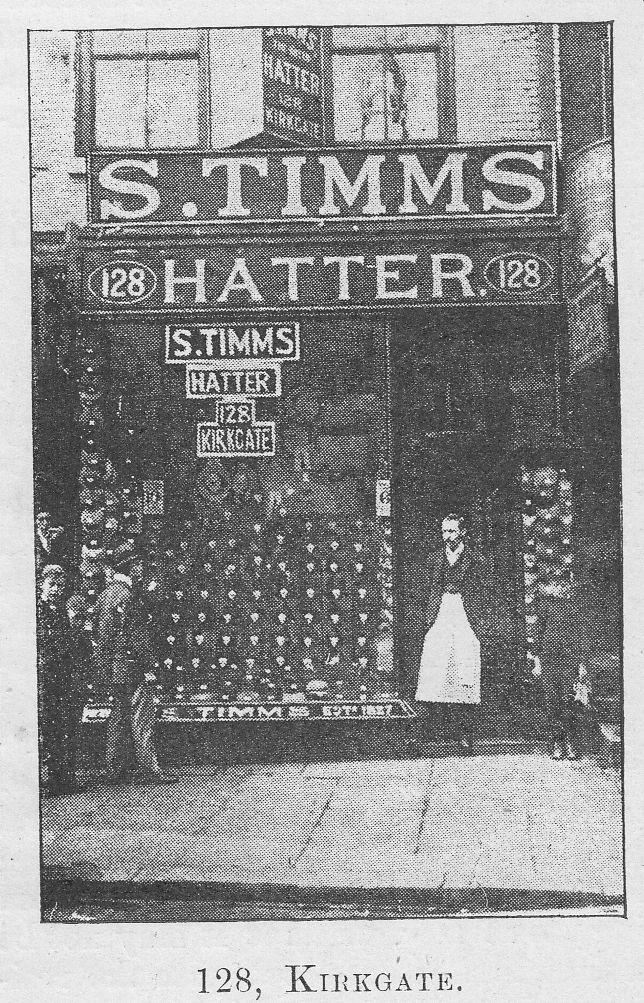
Pedestrians and others in the busy thoroughfare of Kirkgate, cannot fail to have noticed the various signs of the hatter’s business at number 128. “Timms, the noted hatter,” “Timms’ 10/6 silk hats,” and “Specialite, 4/6 felt hats,” have become familiar to the eye of the passer-by, but it is not, however, solely upon advertisement that Mr. S. Timms depends for his trade. His business has been established over 60 years, and is one of the oldest in Leeds. About two years ago, Mr. Timms removed from 112 to 128 Kirkgate, and in his new premises, as in the old he pins his faith upon the reputation gained by selling nothing but first-class hats at moderate prices. The premises are well-suited to the requirements of the business, as they present a good frontage, and their internal accommodation leaves little to be desired.
Ample facilities exist for holding a large stock of goods, and Mr. Timms avails himself of this to the utmost; his stock representing the leading hat and cap manufacturers and wholesale houses in the country. In silk hats he has a large and well-selected stock, embracing the newest shapes by the very best makers which for actual value have no superiors, if any equals in all Leeds. Of hard and soft felt hats also, there is a large assortment, and the whole stock for variety, price, and quality may fairly be said to challenge the town. School caps, cricket and football caps, cycling and other caps are also on hand, and in this miscellaneous department, Mr. Timms is enabled to offer special attractions. He has had a long experience in the trade, and the secret of the success which he has achieved may be said to be his recognition of the fact that in order to gain a constant patronage, good value must be given for whatever amount of money is spent. The individual requirements of customers are particularly attended to, and especial pains are taken to suit each in the matter of style and fit, a task rendered somewhat easy from the extent and variety of Mr. Timms’ stock-in-trade.
In a word, customers invariably find themselves well-suited at 128, Kirkgate, and their patronage and recommendation has secured for the proprietor a steady and increasing connection.
MESSRS. TILL AND SON, TAILORS, & MAKERS OF LADIES’ ULSTERS, COATS & JACKETS,
123, Albion Street.
There are very few who can afford to dispense with the good offices of the tailor, the old saying, “one must not judge by appearances,” being daily and hourly ignored. Granted, then, that we are all dependent upon the tailor to some extent, it will be wise to choose a good one while we are about it. But how shall we judge? One way is plain enough: long existence is an infallible sign of commercial success, and this, in its turn, is generally built up upon a good reputation. Therefore, an old-established business like that conducted by Messrs. Till and Son, of No. 123, Albion Street, has many claims upon the patronage of the town in which it is located. The customers of to-day would be in many cases sons of the original patrons of the house, and as their fathers did so do they, that is, stick to an establishment where they have always been well-served, well-treated, and well-dressed.
The business was founded in 1845, thus, for 46 years, Messrs. Till and Son have carried it on successfully, giving their customers the best material, the best workmanship, and the best fit that could be obtained; and charging moderate prices, taking into consideration the superior quality of the goods supplied. The proprietors still aim at keeping up a good connection in a legitimate manner, and though their trade is limited to a certain class (no ready-made goods being kept), it is particularly select, and can vie with any in Leeds in regard to the quality of the goods turned out. Their shop is neat and compact, the window is dressed in a business-like manner, while the shelves in the interior offer to the eye a stock of cloths, upon the selection of which Messrs. Till and Son have used their experience and knowledge of their customers’ requirements to the best effect. The assortment is very complete, West of England cloths being well represented, while trouserings, suitings, English, Scotch and Irish tweeds, etc., offer patrons a good opportunity for selection.
MR. DONALD MACLVER, PHOTOGRAPHIE ARTIST,
Bond Street.
Among its many other advantages, Leeds is amply provided with photographic artists, and prominent among these is Mr. Donald MacIver. During the five or six years that he has been established, his success has been remarkable, the connection having steadily grown, so that Mr. MacIver finds it absolutely necessary to request his patrons to make an appointment for the time of sitting. His premises are admirably adapted for the profession, and are fitted and furnished with much taste and elegance, the reception-room in particular being handsomely equipped throughout. The roomy studio is fitted with every convenience, pretty and original properties, and the finest apparatus, which enables Mr. MacIver, to produce artistic pictures of a very superior order, and to take life-size portraits direct from the sitter. Work is executed by carbon and other recent methods, and besides being beautifully finished, is of a permanent character, and does not change colour. There are some fifteen or sixteen competent hands employed, these being under the special supervision of the principal. In addition to the business just described, Mr. MacIver has a branch establishment at 3, Victoria Road, Headingly; which is proving a great success. In the reception-rooms, many handsome specimens of Mr. MacIver’s art are to be seen, and amongst them an excellent likeness of Mr. John L. Toole, from whom he recently secured a sitting.
MESSRS. CATTANEO AND CO., WATCHNAKERS, JEWELLERS AND SILVERSMITHS,
29, Commercial Street and 1, Bank Street.
Founded more than three-quarters of a century since, and conducted for many years at 135, Briggate, next door to the Bull and Mouth Hotel, the well-known business of Messrs. Cattaneo and Co. has in no way suffered by its recent removal to the present very handsomely-fitted premises in Commercial Street. The latter thoroughfare, containing as it does many of the best and most fashionable shops in the town, is certainly in every way more suited to the high-class trade carried on by the firm; whilst, at the same time, greater space and better facilities are afforded at the new establishment for the display of the tasteful and very valuable stock. It is perhaps worthy of remark, and certainly of some interest to note, that the Commercial Street shop stands on the site occupied twenty years ago by a similar business conducted by Mr. Carr, a former apprentice of the old firm of Cattaneo and Co. It is placed in a most conspicuous corner position, central and convenient, and close to the banking house of Messrs. William Williams; Brown and Co.; but the building has now been transformed into a fine large double-fronted one, its general internal arrangements being in every way admirably adapted for the conduct of an extensive and important business. The new promises have been fitted with an electric installation of the most modern type, which adds largely to the beauty of the display formed by the splendid stock.
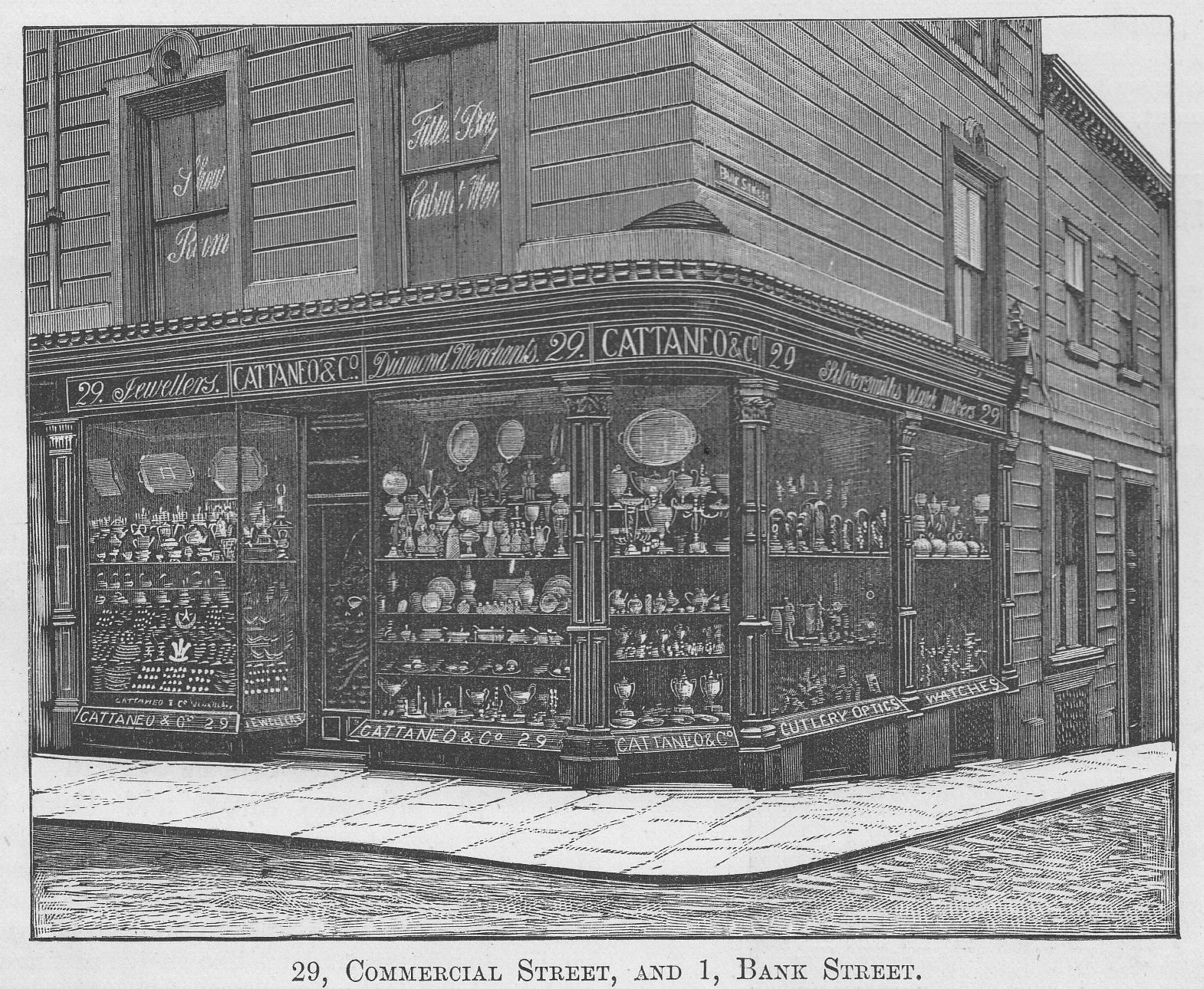
The firm of Messrs. Cattaneo and Co. has long since acquired an enviable reputation for the supply of superior jewellery, and many are the excellent and extremely beautiful specimens that are shown to advantage in the windows; whilst within the shop itself may be seen a most complete and representative assortment of watches, chains, rings, brooches, pins, bracelets and bangles, together with innumerable other delicate and artistic specimens of the goldsmiths’ art in the shape of articles of bijouterie suitable for every purpose and occasion. In silver and electro-plated goods, the firm is fortunate in holding one of the best and largest selections in Leeds, and as these are of the most reliable quality manufactured, besides being most elegant in appearance, we are not surprised that the demand is both steady and considerable enough to warrant a special department being devoted to this branch of the business. Clocks of English and Continental workmanship, and in some very chaste and unique designs, as also handsome bronzes and tazzas, are stocked in great numbers, and we do not lay ourselves open to a charge of exaggeration when we add that many of these would form fitting ornaments for the most expensively furnished rooms. China, glass, cutlery, and cabinet ware, to say nothing of a choice collection of most recherche fancy articles of the very type most sought after for wedding and other presents, are also to be found in great variety; we know of no more thoroughly reliable establishment than that of Messrs. Cattaneo and Co. in which to purchase any of these goods.
The cutlery department should receive special attention, as the firm have for many years dealt largely in all branches and classes of these goods, obtaining their stock from the most noted Sheffield manufacturers. A special feature is also made of optical goods, a full supply of spectacles, eye-glasses, pince-nez, etc., being always kept on hand. These are all of carefully selected quality, and persons requiring their sight tested may rest assured that they will obtain the particular form of lenses best suited for their vision, and at most reasonable prices. Opera and race-glasses of superior make are also kept, as well as every other item connected with this branch of the business. An excellent show of bags of various kinds, including ordinary bags, bags furnished with fittings in electro plate, silver, silver gilt and gold mountings, and stocked with ivory-backed brushes, combs, etc., is also made, the firm having been always noted for this class of goods.
Besides the capitally-arranged shop on the ground floor, Messrs. Cattaneo and Co. have also further show-room accommodation upstairs, affording customers plenty of space in which to view the collection of valuable and beautifully manufactured goods; there is, therefore, none of that over-crowding of objects, which, in so many jewellers’ establishments, greatly detracts from the general effect of the stock and the individual appearance of special articles. Services of silver or electro-plate may be manufactured to order, or engraved with any device, heraldic or otherwise, at very short notice, and repairs are executed in all departments by experienced and trustworthy workmen retained by the firm for this purpose. During the eighty years, or thereabouts, that this fine old business has been carried on under its present title, Messrs. Cattaneo and Co. have invariably won the thorough and complete confidence of the public, an important and very influential connection having been long since acquired, and it therefore goes without saying that the utmost reliance may be placed on all goods emanating from the establishment, which, in itself, is certainly a credit to the firm.
MR. EDDISON, ARTIST AND PHOTOGRAPHER.
14, New Briggate.
Photography has, in common with every other branch of art, altered much under the influence of time and invention. Year by year new methods of re-production have been introduced, each an improvement upon its predecessor, until we may be said to have arrived at what seems the acme of perfection in this respect. The mere uninteresting black upon white is now a thing of the past, and we are supplied with veritable images of ourselves thrown out in bold relief and with every mark of delineation faithfully transferred to card-board, canvas, porcelain, panel, etc. The effects of light and shade are good, and the tedious but successful process of “stippling,” or touching up, beautifies the picture beyond the most expectant dreams of the earlier exponents of photography.
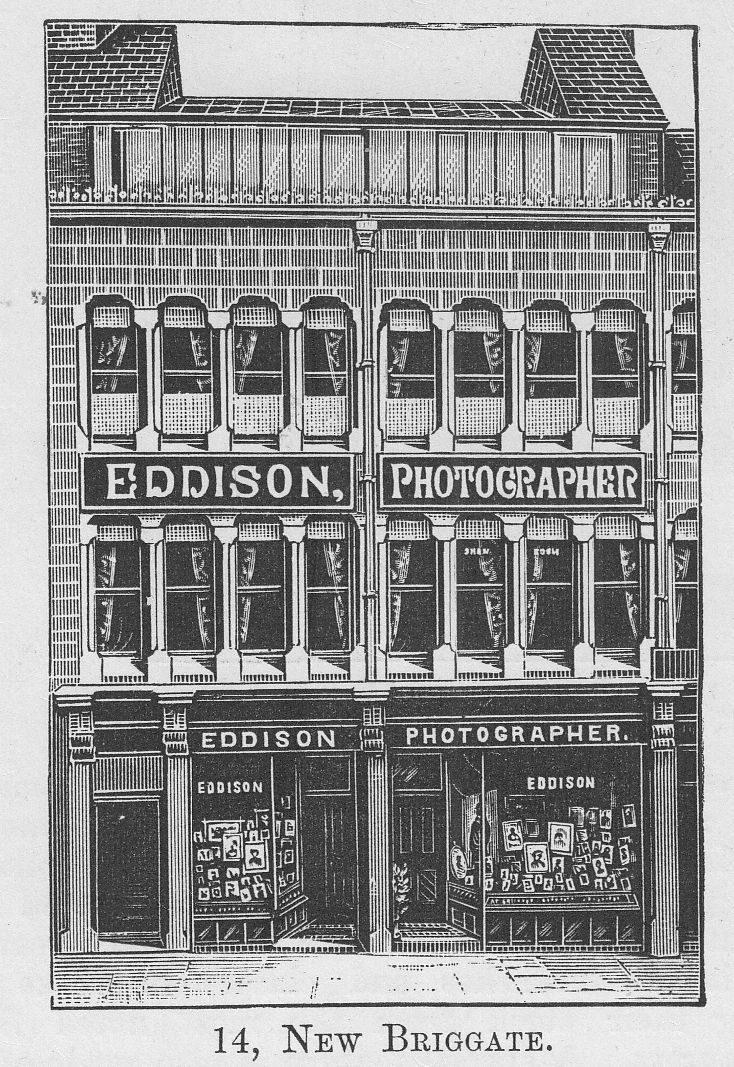
Among the many art photographers in Leeds, Mr. Eddison has quickly gained a prominent position. For many years he has been held in high repute in various parts of Yorkshire, and so comprehensive is his business that he employs the largest staff of artists and workpeople in the county, in every branch of the profession. He has various studios, viz., at Cambridge Street, Moorhead, Sheffield; 2, Sheffield Road, Barnsley; and Carlton Street, Castleford; and large photographic and picture framing works at Albert Buildings, Barnsley. These have au been established some years, and have been conducted to a most successful issue. The Leeds branch was established in December last, and during the few months which have elapsed, Mr. Eddison has gained a connection which gives promise of exceeding by far those in the other towns named.
The local premises, which are prominently situated at 14, New Briggate, are large and well-suited for a high-class business. On the ground floor is the shop, where may be seen tastefully-arranged specimens of every class of photography undertaken, and as this includes the entire field opened to the camera of professors of the art, the exhibition is always of a varied and highly-interesting character. On the first-floor is another showroom, while the second floor is devoted to dressing-rooms. Every convenience for customers, who will find comfortable waiting-rooms at their disposal, is here. The studio is at the top of the house where the advantage of a good natural light is obtained. The processes adopted in taking and developing the photographs, are the best dictated by a thorough knowledge of the art, and by a wide experience, and the productions of the establishment are of the highest degree of excellence.
Mr. Eddison is the only photographer in Leeds who prints photographs in the permanent chromo-type process, which is the only reliable process by which photos can be warranted not to fade. Whether in cartes-de-visite, cabinet portraits, cabinet groups, cabinet Rembrandts, promenade portraits, panel portraits, or children’s portraits in vignettes or Rembrandts, the touch of the master hand is discernible. Appointments are made for wedding parties, cricket and other groups, and in whatever branch of his calling Mr. Eddison’s services are enlisted, complete satisfaction is always given.
MESSRS. HEELES AND SONS, “YORKSHIRE ESTATES GAZETTE” OFFICE,
14, Infirmary Street and Bond Street.
The perfect management of a good estate agency business requires, we should say, a vast amount of business tact and an all-round comprehension of the world and its ways. In this business the proprietor’s versatility must be as wide as his connection, and his knowledge of finance of no mean order, while, as the depository of his neighbours’ secrets, he must be as trustworthy and reliable as the family lawyer or physician. The standing of the firm of Messrs. Heeles and Son is thoroughly well-known, not in Leeds alone, but throughout the district. They have a widespread reputation as estate agents, and operate extensively in the letting and sale, by private contract, of estates, houses, business premises, etc.; the letting of furnished houses, management and receivership of estates, negotiating advances upon mortgage, life policies or reversionary interests. The business was founded in 1844, and has always borne a first-class reputation. It is conducted to-day with an equal amount of energy and enterprise as that displayed during the earlier years of its career; and in the discharge of their duties the members of the firm spare no effort to render their establishment worthy of a continuance of that support which it has always received, and which, it may well be said, it has always deserved. The Yorkshire Estate» Gazette is, in every respect, a most desirable medium for all who wish to purchase or dispose of property.
MADAME MARION ET CIE., FRENCH MILLINERY SALON,
20, Commercial Street.
There can be no doubt that the ladies of Leeds are at a considerable advantage, compared with those in many towns, in having in their midst such an establishment as that conducted by Madame Marion et Cie., which is typical of Parisian houses of the best kind. It is situated in the most fashionable shopping thoroughfare in the town, and has done its full share in retaining for Commercial Street its aristocratic reputation, by the tasteful appointment of the window, of which our illustration will convey an idea, and of the show-rooms, and its just claims to be a French millinery salon.
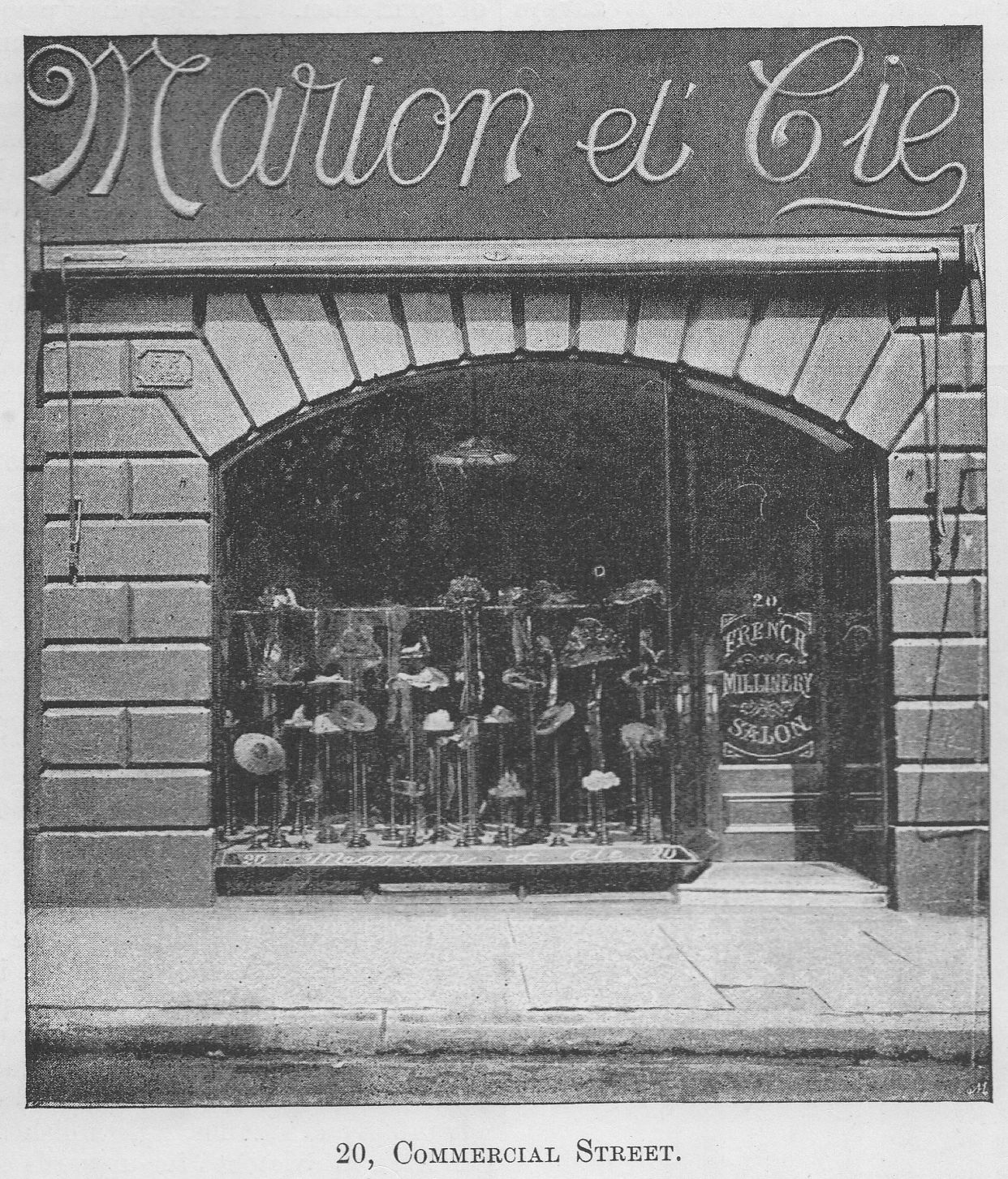
Madame Marion has an agency in Paris connected by important transactions with all the best houses in that city, which enables her to secure the latest fashions in the best materials for transmission to the Leeds workrooms. In addition, she makes frequent visits to Paris for the purpose of purchasing the latest patterns over which she secures the sole right of reproduction frequently at the cost of from 100 to 180 francs per model. It is only by such a course she can secure for her customers that individuality of style which ladies are so anxious to preserve, and which is rendered almost impossible when many milliners are making-up from the same original patterns. So far as we are aware, no other house in Leeds adopts such effectual measures to attain this end. By frequent visits and continual correspondence, Madame keeps herself en rapport with the latest modes, and her regular customers may consider themselves literally in the latest fashion of the day. The Leeds establishment bas its own staff of experienced milliners (very largely increased during the season), who are eminently fitted, by the aid of French patterns and French materials, to put upon the finished article, the inimitable cachet of French styles.
We must not omit to mention our surprise, after inspecting the pretty specimens of head-gear in the window, to find that they but poorly represented the much more select stock within, which we are sorry to hear has to be hidden from the eyes of professional copyists. Here are tiers of drawers containing many really exquisite productions which any lady would be charmed to see, and no doubt be strongly tempted to purchase.
Madame Marion’s business is by no means confined to Leeds — it extends all over the West Riding, and there is no reason why it should not ultimately spread to all parts of the country. It is certain to operate largely, wherever good quality and finished style are in demand.
MR. A. R. HICKS, ARTISTS’ REPOSITORY,
23, Upperhead Row.
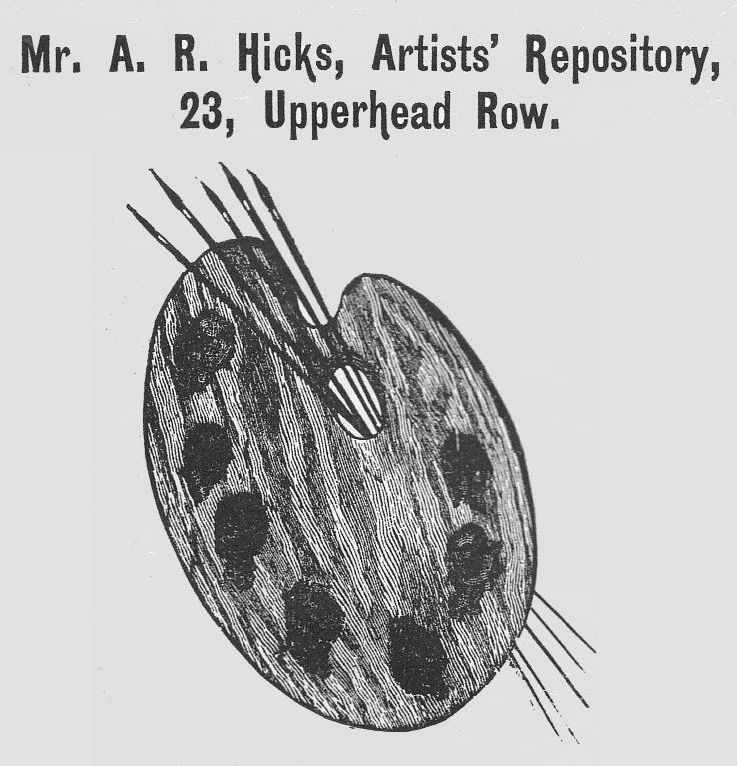
Art has made such rapid strides in England during the past few years, that we may justly claim to be among the foremost nations in the cultivation of painting, etching, sculpture, engraving, &c. Leeds takes a prominent place in this connection, and has its schools of art, its galleries, and its army of artists and art students. The artist however, would be helpless without reliable materials and tools, and probably the quality of the requisites at the artist’s command exercises one of the most important influences on the quality and success of the work produced. One of the recognised high-class sources of supply in Leeds for this line of goods, is the establishment of Mr. A. R. Hicks, well-known to amateur and professional artists as the Artists’ Repository, 23, Upperhead Row. The business has grown up with the growing requirements of the place, and Mr. Hicks has a long and valuable experience in all branches of his business, so that he is able to offer his patrons the best articles of their kind in the market. It is now about half-a-century since the business was first established, but it is more particularly during the last decade or so that it has come so rapidly to the front. Mr. Hicks aims first and above all things, at quality in all the goods supplied, and he has succeeded in gaining a commanding position in the trade, and securing the confidence of artists, students and teachers.
The premises afford excellent accommodation for the display of a large and varied stock. The shop is admirably arranged, and contains about everything a modern artist can require. Every description of colours, oils, varnishes, models, copies, fancy frames, easels, seats, drawing and cartoon papers, brushes, prepared canvas, mounting boards, blocks, &c., are on hand, besides a large selection of fancy frames. A large assortment of chromo-lithographs and studies of various classes are kept for lending purposes, and a well-selected series of publications on the fine arts also forms a characteristic feature. A good business is done in restoring paintings, maps, and art works of all kinds. This work is always executed in the greatest perfection, including re-lining, mounting and varnishing of the work, and the repairing, re-gilding and renovating of the frames. Special care is taken in framing pictures to any pattern that may be ordered, and all the work is executed in an artistic and business-like way. Special arrangements are made for supplying schools and colleges at reduced prices. The business is high-class throughout, none but the very best classes of goods being kept, and all the work being turned out in the very highest style of modern execution.
BOND STREET LUNCHEON ROOMS.
Proprietor: Mr. Brayshay.
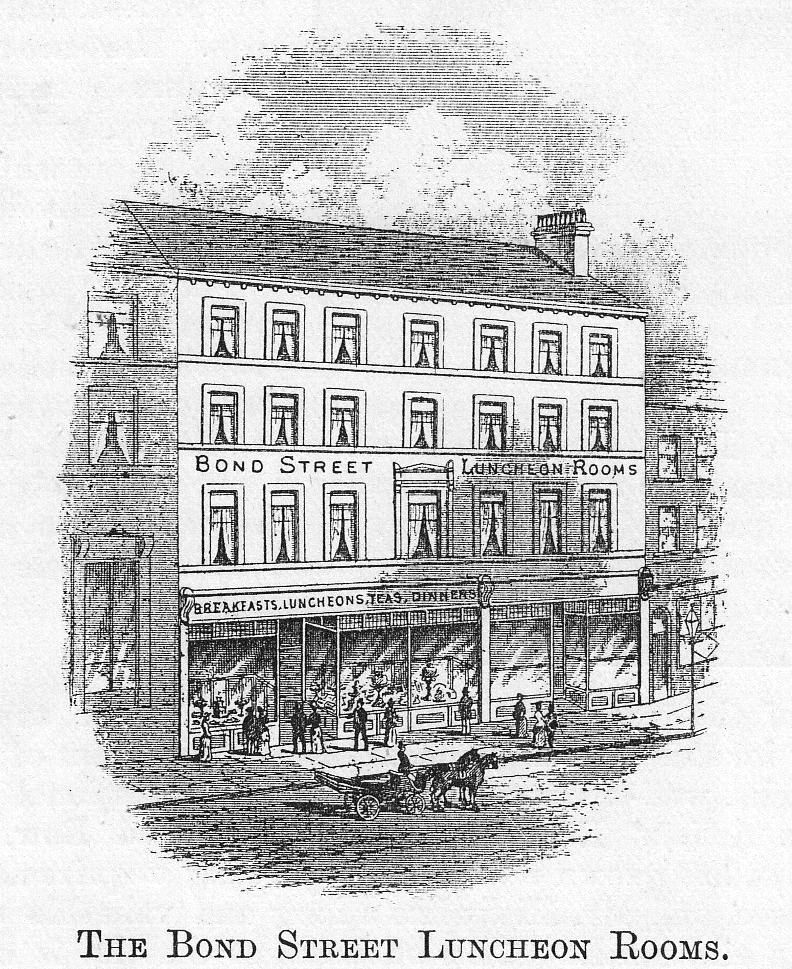
Leeds being so important a business and county centre, a number of high-class establishments are to be found here, designed for the comfort and accommodation of visitors and travellers, whose duty or pleasure brings them into the town from day to day. Among the most noted of such establishments, we find the Bond Street Luncheon Rooms, opened in one of the best positions in Leeds, about twelve months ago. This fine establishment is situated close to the Park Row end of Bond Street, and is peculiarly convenient for country gentlemen’s families and business-men visiting Leeds. It has a first-class appearance, with large, handsome, and well-fitted plate-glass double-front facing the main street, and the interior fittings, furnishing, and decoration is in the most modern high-class style. Every provision is made for the convenience of ladies, gentlemen, family parties, etc.
The front shop is devoted to the display and sale of confectionery, etc., of which a splendid selection is always in stock. Wedding cakes, birthday, christening and other cakes of a special kind are made to order, and ornamented in any design; and a tempting show of Madeira, seed, pound and other cakes, buns, rolls, scones, biscuits, etc. French and English sweets and confections, ices, jellies, fondants, fruits, creams, etc., is made. At the back of the shop is a cosy and well-furnished ladies’ luncheon and tea-room. Over the shop, on the first floor, is a handsome dining-room, designed to comfortably seat at least 120 guests, and to the rear of this, on the same floor, is a very large tea and coffee-room, which has an excellent floor, and is much in request for select dancing parties. A snug and well-appointed smoke-room is also provided for the convenience of gentlemen.
Mr. Brayshay personally superintends all the arrangements of the establishment, having under his orders a large number of experienced waitresses and attendants. Hot dinners, luncheons, etc., are provided every day, and the promptest attendance is a feature of the house. The catering is of a superior class, only the very best qualities of viands being allowed on the premises, an experienced head cook, with reliable assistants, being employed to prepare these. Miss Brayshay supervises this department, and largely owing to her able management the Bond Street Luncheon Rooms have become a favourite resort for the leading business men and country families. Banquets, wedding breakfasts, balls, and parties of all descriptions are catered for, reliable and experienced attendants being sent out, and plate, cutlery, table linen, china and glass being lent. The business is essentially high-class trade, and the great expenditure that has been incurred in adapting and furnishing the house has been more than justified by the gratifying success which the undertaking has achieved already.
MR. T. W. FARRANT, AFRICAN IVORY, TRAVELLING BAG AND FANCY LEATHER GOODS WAREHOUSE, UMBRELLA AND WALKING STICK MANUFACTORY,
4, Boar Lane.
Mr. T. W. Farrant is in a good way of business as an African ivory, travelling bag, and fancy leather goods merchant, etc. His promises at No. 4, Boar Lane are centrally located in a favourable situation for business, being in a main thoroughfare, immediately under the “Trevelyan” Hotel. The shop is provided with two plate-glass windows, which, besides presenting a very handsome appearance, sufficiently light the interior, and serve to show off the large and valuable stock of goods in an advantageous manner. Established in 1869, this business has been in existence for upwards of 22 years, and during that period the proprietor has necessarily gained a vast amount of experience, while the stock he holds has obtained a wide-spread reputation for its good qualities, and for their moderate price.
Among the articles in stock we may mention ivory brushes, ivory mirrors, paper knives, button hooks, etc., dressing bags, dressing cases, kits or knock-about bags, Gladstone, brief and Lorne bags, writing desks, cabinets, and cases, silver-mounted and other purses, pocket-books, letter and card cases, etuies, pocket cutlery, jewel cases, work boxes, glove and handkerchief cases, purse and handkerchief bags, and many other useful and ornamental goods. A speciality is made of high-class umbrellas. The goods manufactured by Mr. Farrant are of a graceful design, and of sound construction. Mr. Farrant, being a manufacturer, is in a position to supply any special design to order, having at the same time a choice assortment of ladies’ and gentlemen’s finished and mounted goods always on hand. Every branch of the trade is represented, and in each instance good value is given. The frames used are strong and durable, the coverings in silk and other materials are of the best kind, while the handles are in every variety of fashionable design. Re-covering and repairing is largely carried on, and in each branch of this department the large patronage enjoyed shews the value placed upon the work. A large stock of walking-sticks, natural and mounted, in every variety, suitable for presentation and other purposes, is also kept, and no detail is wanting to make the business a thoroughly reliable and representative one of its kind.
MR. GEORGE HALL, PAINTER, PAPERHANGER, DECORATOR, AND CONTRACTOR,
63, Woodhouse Lane & 58, Cookridge Street.
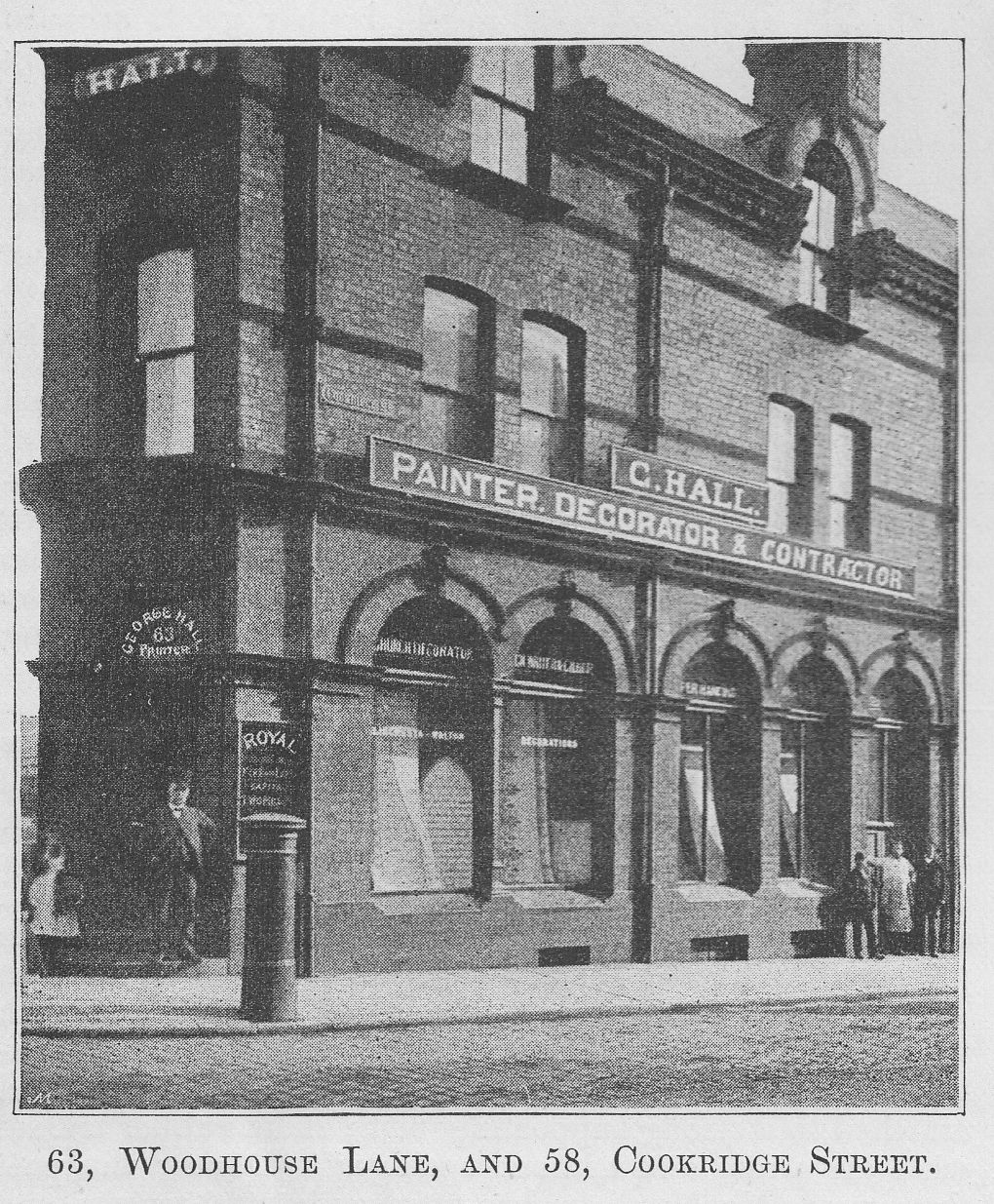
The great improvements that have, of late years, been made in the work of decoration in the interiors of our residences, is almost of the nature of a renaissance. Previous to that time we were sadly deficient in the matter of decorative art, but now the work is accomplished with an amount of artistic ability seldom before witnessed in this country. Not that anything outre or extravagantly gorgeous is the fashion nowadays, because modern processes and modern powers of imitation are such that brilliance and elegance of effect are to be obtained at a tithe of the former cost. One is strongly impressed with these facts by an inspection of the stock, designs, and work of Mr. George Hall, of Leeds, who, amongst other commissions, designed and carried out the decoration of the Council Chamber of the Leeds Town Hall, in a way that has excited general admiration, especially amongst persons of genuine artistic knowledge and taste, and who are looked upon as authorities in such matters.
Mr. Hall has devoted himself to the development of this high-class decoration in which his work is supported by artists of the most approved taste, whilst he has constantly in stock a splendid assortment of the best home and foreign goods, in the form of art paper-hangings, dadoes, borders, centres, corners, medallions, figures, gold mouldings, and Japanese paperhanging. Amongst other things he has a rare supply of the universally-admired Lincrusta-Walton wall decorations, embossed, plain or coloured, and exceedingly useful for dadoes or stair-cases. Mr. Hall applies himself to the production of good work at a reasonable charge, and as a consequence has, we believe, secured for his business a very considerable amount of public support. His work, indeed, is of that character that it deserves to be extensively known; it includes painting, graining, marbling, paperhanging, gilding of all kinds, glass-embossing, decorating, stencilling, whitewashing, colouring, etc. He is prepared to decorate either house, church, or public building in any style, and to furnish designs and estimates for the work.
MONS. ROSEMONT (DE PARIS), HIGH-CLASS PHOTOGRAPHY,
6, Bond Street.
Art in its various branches is both well represented and patronised in Leeds, and in the photographic branch, particularly, there are established here professors of the art of the highest standing. One of the principal of these is Mons. Rosemont (from Paris,) who is an artist of high repute, whose paintings have been admitted to the Paris Salon, whilst in portraiture he obtained the gold medal of the Exposition Universelle Internationale, 1878. He has reconstructed under his personal direction a magnificent suite of apartments at 6, Bond Street, Leeds, which have been opened as a studio for the finest class of photography. The rooms consist of a spacious, elegantly-furnished reception-room on the first floor, in which a collection of his artistic productions form quite an art gallery, embracing various types of portraiture. Cabinets, promenades, boudoirs, and larger panel pictures abound; specimens of oil paintings and crayons executed by Mons. Rosemont’s patented process, by which the umbra, or projected shadow, of the photograph is produced on a canvas, by the aid of a lantern, and then hand-painted or drawn, are also exhibited; whilst numerous styles and methods of finish on ivory, china, porcelain, or canvas are to be found. On the top floor most convenient glass-enclosed printing rooms have been erected, enabling the process to be carried on in all weathers: and on a lower level is a series of rooms for working, enamelling, printing, re-touching, and finishing.
The studio is most admirably arranged; the much-desired north light is obtained direct and naturally, by means of an ingenious arrangement of screens, specially-fixed blinds, shutters, and reflectors, and this light can be maintained in any condition of the weather. The instruments used have been specially-constructed for Mons. Rosemont on the Continent, by the most renowned makers, to his own designs. Some of the cameras are 24in. by 20in. in size, whilst the chief one, which is believed to be the only one in England, is capable of taking a photograph life-size direct from nature. This is a marvel of scientific ingenuity, and to give an idea of its cost, we may mention that upwards of three hundred guineas were given for the lense alone. Everything else in the studio: scenery, furniture, pictures and drapery, testifies to the good judgment and taste of the proprietor, who has even provided novel playthings to attract, or distract, the attention of children when they come to have their portraits taken. Adjacent to the studio are capitally-furnished waiting-rooms, and a suite of dressing-rooms and lavatories for both ladies and gentlemen.
On the second floor there is also a workroom of spacious dimensions, where a staff of clever artists, specially trained by M. Rosemont himself, are employed in the drawing, painting and finishing of pictures. The ornamentation of the principal rooms, foyers, and stair-cases throughout has been paid particular attention to, and Parian statuary is prettily arranged among ferns, palms, and flowers with a beautiful effect. Referring to the special process of portrait painting, of which we just now spoke, we may say that it is a patented invention of M. Rosemont’s and bids fair to revolutionize portrait painting. Portraits can be painted from photographs, however old or faded with a fidelity that ordinary painting cannot guarantee, and the tedious necessity of long and many sittings is avoided. Specimens of this work can always be seen in M. Rosemont’s studio.
MR. R. BROWN, SADDLER, HARNESS MAKER, ETC.,
Rockingham Buildings, 54, Woodhouse Lane.
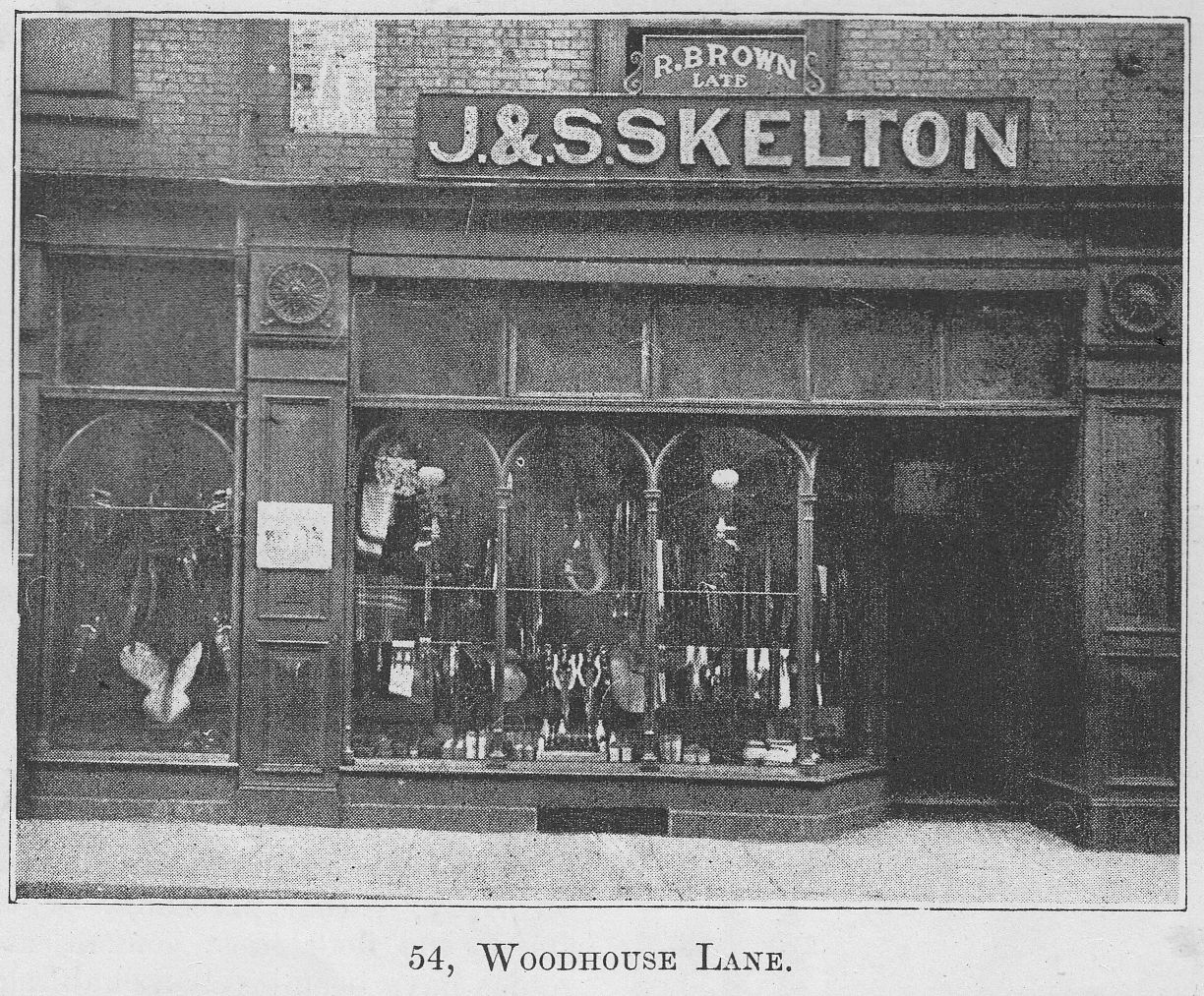
Feeling it our duty to pay due attention to this business, we made a special call upon Mr. R. Brown’s saddlery and harness business at Rockingham Buildings, 54, Woodhouse Lane, which has been established for upwards of 55 years; it was for many years under the proprietorship of Messrs. J. and S. Skelton, before coming into the hands of its present owner, and is known throughout a very large district. The shop is well-fitted throughout, and contains a thoroughly good stock of all articles proper to the trade. Whips, saddles, harness, collars, spurs, bits, bridles, cleaning-paste, brushes, sponges, curry-combs, horse-clippers, whip-sockets, lamps, etc., are kept in great variety, and the manufacture of goods to order is constantly going on, Mr. Brown being a practical man, and able to turn out work in a thoroughly good style. As with human beings, horses require good-fitting trappings, and to this matter, Mr. Brown pays particular attention.
Every article is made of good material and finished in a workmanlike manner, which is evidenced by the length of time the goods last. The various plated and japanned articles that are in profusion about the shop, set off the rest of the stock admirably, the whole presenting a very attractive appearance. Horse clothing of every description
will be found here in large quantities; hunting saddles of any weight are made to order, saddles of every description being a speciality with Mr. Brown, many of the leading gentry of the town and neighbourhood patronising him for these articles. Harness, and other leather goods are also neatly and promptly repaired. The shop is well-situated, being opposite the Higher Grade Board Schools, the workshops being at the rear, and in them a large staff of skilled workmen are constantly employed under the practical supervision of the proprietor. Mr. Brown enjoys a large and influential patronage in Leeds and the surrounding district, and has customers even in the Metropolis itself, to whom he is constantly despatching sets of harness, etc.
MESSRS. NEEDHAM BROTHERS, DISPENSING CHEMISTS AND SURGICAL MECHANICIANS,
17, North Street and Meadow Lane.
This business has been established over half-a-century, and at the present time, under the management of Messrs. Needham Bros., the establishment at 17, North Street constitutes one of the most important premises devoted to chemistry and pharmacy in the neighbourhood. No effort has been spared to render the dispensing department thoroughly efficient; in making-up prescriptions and family recipes great care is observed, and regular supplies of fresh drugs, as well as patent medicines and proprietary articles are received almost daily to replace those used in furnishing the requirements of customers. Reliable Wholesale houses are dealt with, and every parcel upon arrival is subjected to careful scrutiny ere its contents are placed in the dispensary. This close supervision naturally must necessarily be a source of satisfaction to the numerous patrons of the establishment, and accounts in no small measure for its good position and extensive patronage.
Messrs. Needham Brothers have also a department devoted to all classes of surgical instruments, besides bandages, bed-pans, air and water beds, pillows, india rubber sheeting and every requisite for the sick-room or nursery. Water-beds and cushions are lent on hire, and this is undoubtedly a great boon to those whose means are limited. The manufacture of trusses is here of great importance, Needham Brothers having had great experience in this branch: they are the publishers of a little pamphlet entitled “Rupture, and How to Treat it by Needham’s Improved Trusses;” from which we gather that “Among the new trusses recently introduced are the following: Needhams’ ‘Perfect’ and ‘Imperceptible,’ made in various shapes, the total weight being less than 3 oz.; ‘Celluloid Trusses,’ especially suitable for the tropics, for bathing, or for children; they are non-absorbent, smooth, extremely durable and probably more effective in promoting a radical cure than any other form of truss, from the fact of the pressure continuing hard and firm. The Philadelphia Truss Company’s new truss, improved ‘Moc-Main’ with web belt, and india rubber pad; the ‘Excelsior,’ a modification of the ‘Moc-Main,’ with spiral springs and attached to a strong supporting belt; india rubber trusses with air pads, and without springs.” During the past three years Mr. Needham has fitted over 1,000 trusses, and scores are ready to testify to the comfort and efficiency derived from his appliances. The proprietors supply crutches, artificial human eyes and limbs, and appliances for deformities; elastic stockings, bandages, knee caps, anklets, thigh pieces, leggings, and a large assortment of ladies’ and gentlemen’s belts are included in the stock, which is in every way complete. The proprietors have for many years enjoyed the confidence of the medical profession of the town and district.
MR. EDWARD SWALLOW, PRACTICAL STAY MANUFACTURER, ETC.,
54, North Street.
An old-established house, having a very high reputation among ladies resident in Leeds and district, is that of Mr. Edward Swallow, the well-known stay and underclothing manufacturer, of 54, North Street. The business was established about sixty-two years since, by the gentleman whose name it still bears, and two years ago passed into the hands of the present proprietor, Mr. Alfred Swallow, under whose management it has fully retained the high name it has always enjoyed. The premises are centrally situated in North Street, opposite to New Briggate. A large and choice stock of stays, corsets, and ladies’ underclothing of the best manufacture, affording a good selection is held. The speciality of the house lies in stays, and more particularly real whalebone corsets, which are made on the premises. They are made in various colours and qualities, but are all equally excellent in style, and justly noted for their durability. Other articles of ladies’ apparel are made at the establishment, only the best materials being used; and every garment is noted for its tastefulness and the excellent work put into it. A large number of experienced lady-assistants are employed, and all orders are executed with the greatest promptitude. The connections of the house are of the most extensive and valuable description, including leading residents in the town, and for miles round.
MESSRS. KIRK AND CO., LTD., GOLDSMITHS AND JEWELLERS,
153, Briggate.
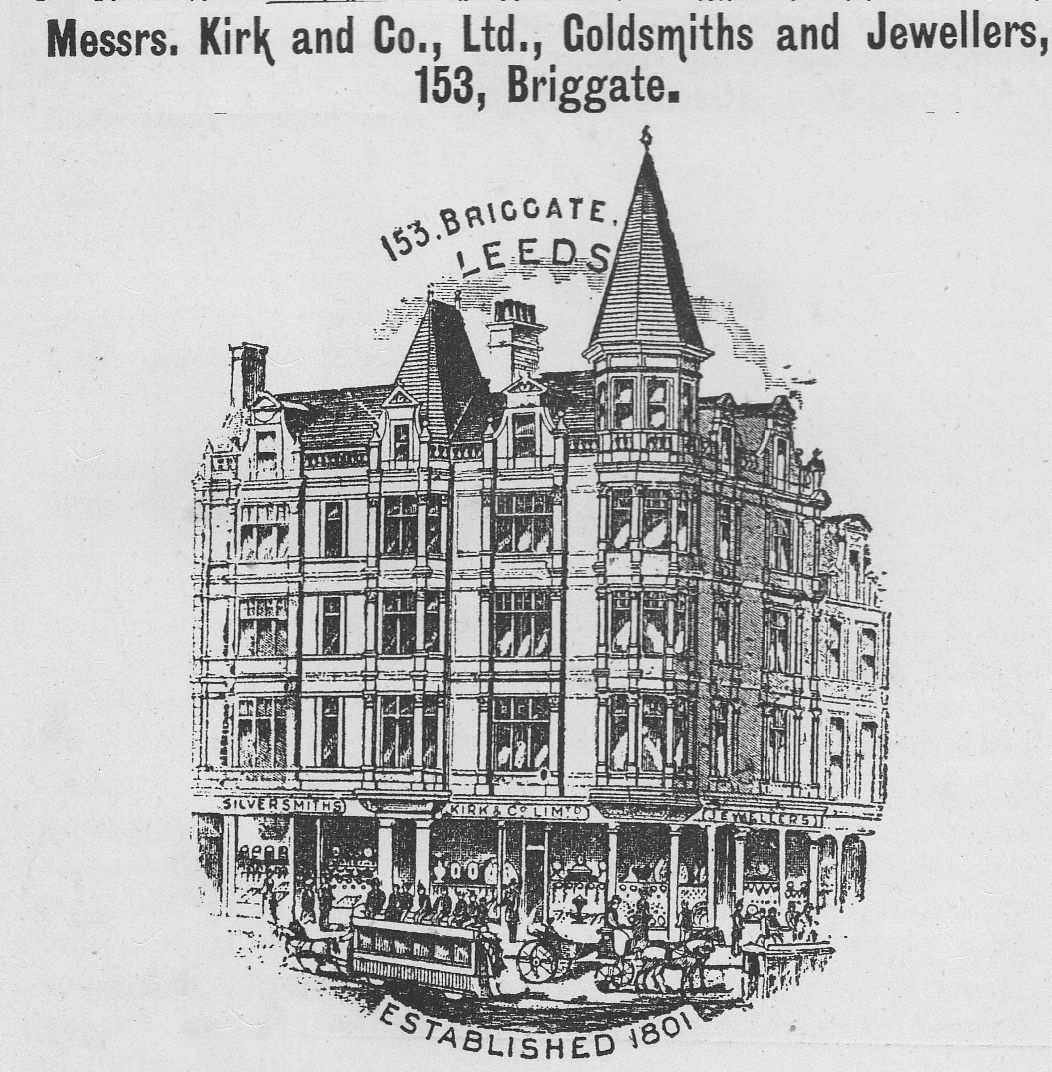
Messrs. Kirk and Co.’s business, now converted into a limited Liability company, has been established in Leeds for 90 years. This firm have branches at Hull and Liverpool, but the Leeds premises are by far the most handsome; occupying as they do a corner position in the leading thoroughfare of Briggate. The building is of five stories, surmounted by towers, and its design is an excellent specimen of the street architecture of the period. The frontage to the two streets is very extensive, and presents one of the most brilliant arrays of choice and elegant goods to be seen in the provinces. The stock, certainly one of the largest in Leeds, is displayed in the several windows in distinct groupings. One window is devoted to clocks and bronzes of every description, especial prominence being given to oak quarter and chiming clocks; the next presents a really dazzling show of silver and silver plate from which one might select wedding presents without end, so tempting are the articles and their prices. Then comes a pretty show of silver novelties for the occasional table, and watches at prices so low that one wonders how anyone can be without a watch, since even watches that have gained a Kew certificate for their splendid time-keeping qualities are here procurable at lower prices than such desirable accuracy has hitherto been attainable at. Lastly there is a window full of gold and gem jewellery, including choice half-hoop diamond rings from four to one hundred guineas, gold bracelets, brooches, albert chains, etc., in infinite variety of pattern. The interior displays still further diversity in every department of the immense collection, which includes fine specimens of Doulton, Crown Derby, and other high-class makes of artistic pottery. The mere enumeration only of these luxurious necessities conveys but an imperfect idea, actual inspection is needed to realise the effect of this leading goldsmith’s and jeweller’s emporium, and we can ensure our readers a courteous reception even if their visit be only one of inspection.
MR. ROBERT SCOTT, OPTICIAN, JEWELLER, ETC.,
5, Woodhouse Lane.
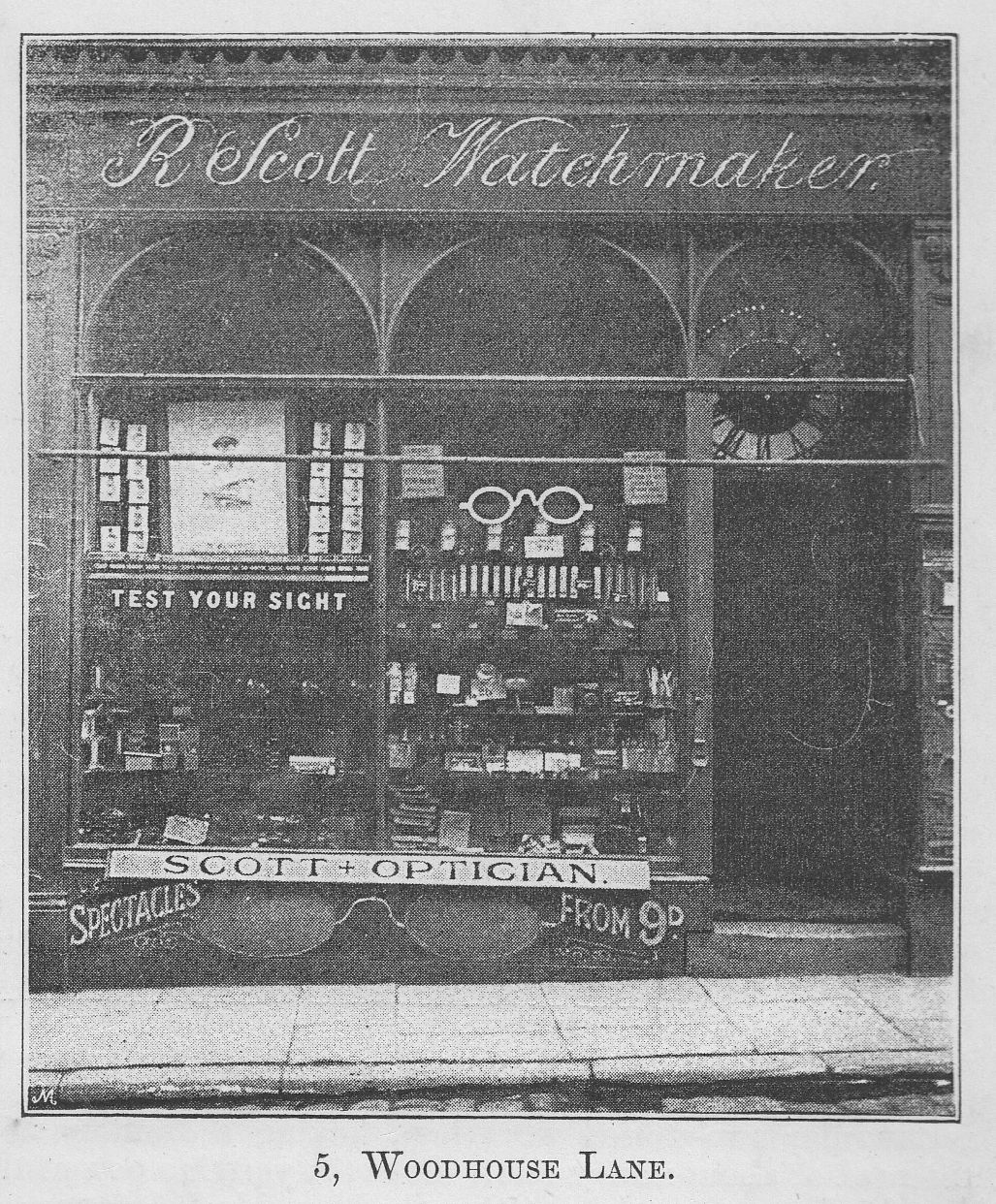
Since the application of photography to the production of lantern slides, there has been a great impulse imparted to entertainments embodying admirably-produced transcripts of nature, by which the scenes of foreign countries are reproduced on a large scale, with the utmost exactness and brilliant effect. The number of lectures now given in connection with Temperance Societies, Bands of Hope, and Sunday Schools, have also still further increased the demand for slides, generally of different classes, and this great demand has led to the formation of agencies, amongst which Mr. Scott’s occupies a prominent position. The business has been carried on by him at the above address for five years, he having been for twelve years previously practical lantern exhibitor with Messrs. Scott and Co., a well-known firm, of Leeds. The chief part of his business is now the lending out of lanterns and slides. The lanterns are either for oil or lime-light. Screens and all kinds of apparatus are also let on hire, and operators and lecturers supplied if required. Mr. Scott, jun., gives entertainments with lime-light exhibitions, in public or private. The slide-lending department is one of much importance; they are lent in sets to town or country customers at an almost nominal charge, and as they include a great variety of Arctic, African, and other scenes, picturesque towns in England and the Continent, religious stories, temperance tales, whimsicalities, poetry, prose, and history, and being generally accompanied by illustrative lectures, are an immense convenience for affording amusement to children or adults at any class of entertainment. Besides this special feature of his business, Mr. Scott is also an optician and a dealer in all kinds of photographic appliances. His shop, which contains a large stock, has a good single-frontage, and is situated in the centre of the town. The charges in all departments are very moderate.
MESSRS. W. IRWIN AND CO., BUILDERS AND CONTRACTORS,
Burley Road.
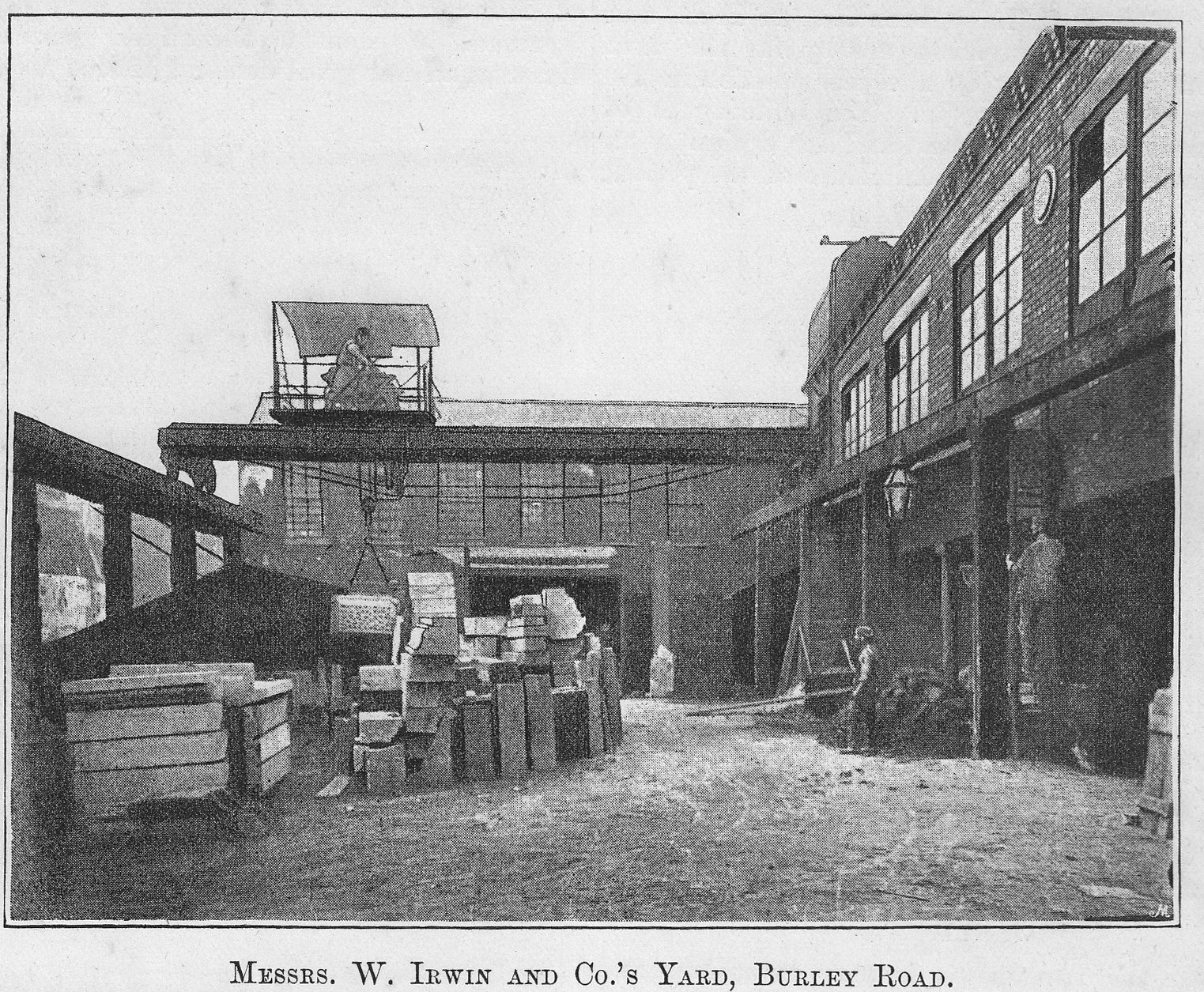
The well-known firm of Messrs. W. Irwin and Co., of Burley Road, was founded as far back as the year 1869, by the present proprietors, and during the whole length of its public career has evinced a continuous progress that is only associated with intelligent and enterprising administration. Few branches of commerce exercise so potent an influence in so many varied ways upon a large community as the trade of the builder and contractor, and of this characteristic Messrs. Irwin’s business possesses its full share. The premises consist of a large yard, having suitable general and private offices at the entrance to the right. On the other sides, the yard is confined by a long rectangular two-storied workshop, having a frontage to the road of about ninety feet. Over the yard is a powerful travelling crane, used for lifting the large blocks of stone, granite, &c., which in the course of their business are dealt with. In the yard and under part of the workshops, which is left open, is a crushing machine driven by steam power, for making mortar. All the mortar used in the operations of the firm is prepared here, and in common with all other materials used, is of the best quality procurable. At the back of these premises there is a large timber-yard covering an area of about 1 and a-half acres, in which there is a huge drying shed of two stories, for drying and seasoning timber, and three or four smaller sheds. In the yard is stored about two thousand pounds’ worth of timber, for all purposes required by the trade, as well as the working plant, consisting of mountains of poles, movable cranes, tons of stone, huge waggons, etc. The works always present a busy appearance, the travelling crane and mortar mixer being always at work, whilst drays are continually coming and going between these central premises and the sites of outlying operations.
Messrs. W. Irwin and Co. are extensively engaged in every branch of a large contractor’s business, and have successfully executed important contracts for the Municipality, Charitable Organizations, the Police, and Mercantile Firms. Amongst other examples we may mention the Headingley Police Station, and Public Library, recently completed; the West Riding Police Offices, Park Street; the Small-Pox Hospital, Burmantofts; the handsome warehouse and factory of Messrs. Arthur and Co., Ltd., Park Square and other warehouses, factories and chimneys to a very considerable number. Indeed, we are informed that Messrs. Irwin and Co. are principally engaged on mercantile edifices of various kinds. All kinds of sanitary engineering are undertaken, draining operations have been carried out in all parts of the town, and the sanitary arrangements at the Town Hall recently improved. The firm is quite at home in some of the largest and most difficult operations of the building trades, such as heavy stone work, factory chimneys, tunnelling, etc., and its numerous public and industrial edifices will stand as monuments of honest, substantial and durable work. Mr. Irwin is himself much interested in the social improvement of his employes, and is a Guardian of the Poor for the West Ward, in which his business premises are situated.
MR. WILLIAM WELLS, FAMILY BUTCHER,
65, Woodhouse Lane.
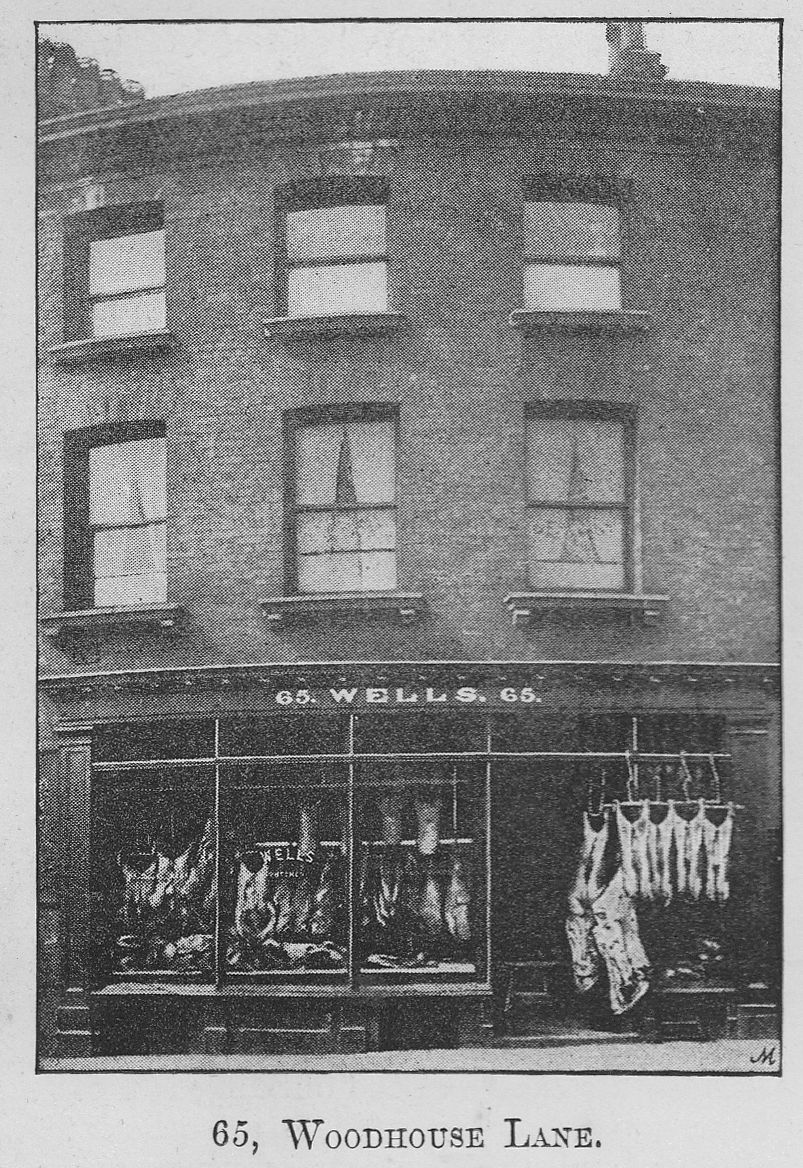
Mr. Wells is fortunate, in the possession of an exceedingly fine corner site for his business. Standing at the corner of Woodhouse Lane and Cookridge Street, on the Headingley tram route, his fine premises occupy a commanding position, and the proprietor conducts a good and influential trade. He is a first-rate judge of cattle, and able to choose those animals which will produce good and tender meat. The large double-fronted shop always contains a fine show of meat, and every joint of beef, mutton, veal, or lamb that is offered for sale by Mr. Wells, will be found of consistent good quality — the best. This establishment is fitted up in a superior manner, every regard having been paid to the sanitary arrangements and ventilation. Mr. Wells, who was formerly at 33, Great George Street, and still has a branch shop in Fleet Street, has always enjoyed a reputation for supplying the best meat, and has long been the recipient of patronage from the most influential families connected with the town and adjacent country. He also supplies some of the principal clubs, hotels, and restaurants. He employs smart assistants, who wait upon customers for orders. This is a noted house for pickled beef and tongues. If the reader requires any further proof of Mr. Wells being a first-class butcher, the fact that the Corporation of Leeds are among his patrons, should suffice.
MR. R. GREENWOOD, IRONMONGER, INVENTOR, PATENTEE, MANUFACTURER, AND GENERAL HARDWARE MERCHANT,
95, Dewsbury Road.
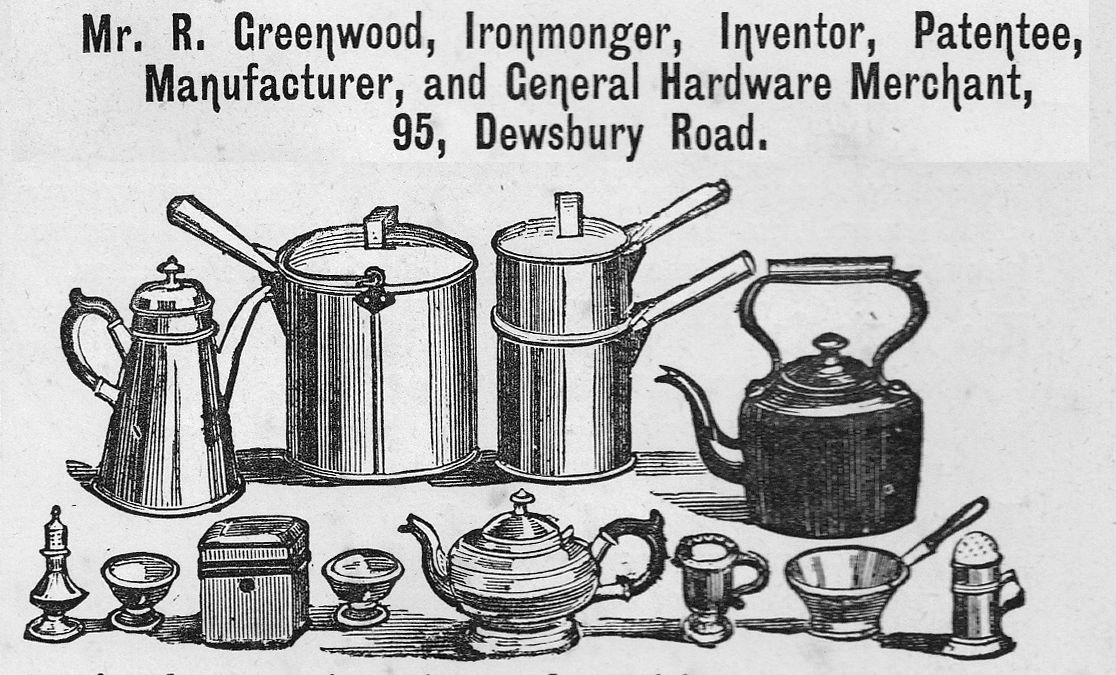
Mr. R. Greenwood’s business, which has been established for upwards of thirty years, was lately under the proprietorship of Mr. Peel, from whom it was acquired by Mr. Greenwood, eight years ago. The premises have the advantage of a good corner position, one window facing Dewsbury Road and two facing Gaskill Street. The selection of such a stock as is brought together here, is no slight task. Lamps in endless variety, shades for the same in the newest shapes and colours, gas brackets and chandeliers, cutlery, and electro-plated goods of the best Sheffield makes, garden tools and requisites, joiners’, carpenters’ and masons’, tools, stoves and grates, domestic utensils, washers, wringers, &c., enamel wares, ranges, tile hearths, baths, travelling trunks, iron and brass bedsteads, &c., the whole forming a list from which no detail is missing, and which it is well nigh impossible to improve upon. Mr. Greenwood employs a competent staff of iron and tinplate workers, bellhangers, gasfitters, locksmiths, &c., for the manufacturing and repairing of all kinds of tin, iron, copper, and zinc goods for the trade or private buyers. There is not the least necessity for people furnishing, to go out of the district to buy, as Mr. Greenwood supplies best quality goods at store prices, and furnishes estimates for all kinds of work free of charge. He has also recently taken up an agency for the sale of bicycles — notably the “Rathwell,” this being his speciality, which can be had on the easy payment system, or at a liberal discount from the catalogue prices for prompt cash.
MR. A. T. PLUMMER, WINE AND SPIRIT MERCHANT,
“King’s Arms,” Lowerhead Row.
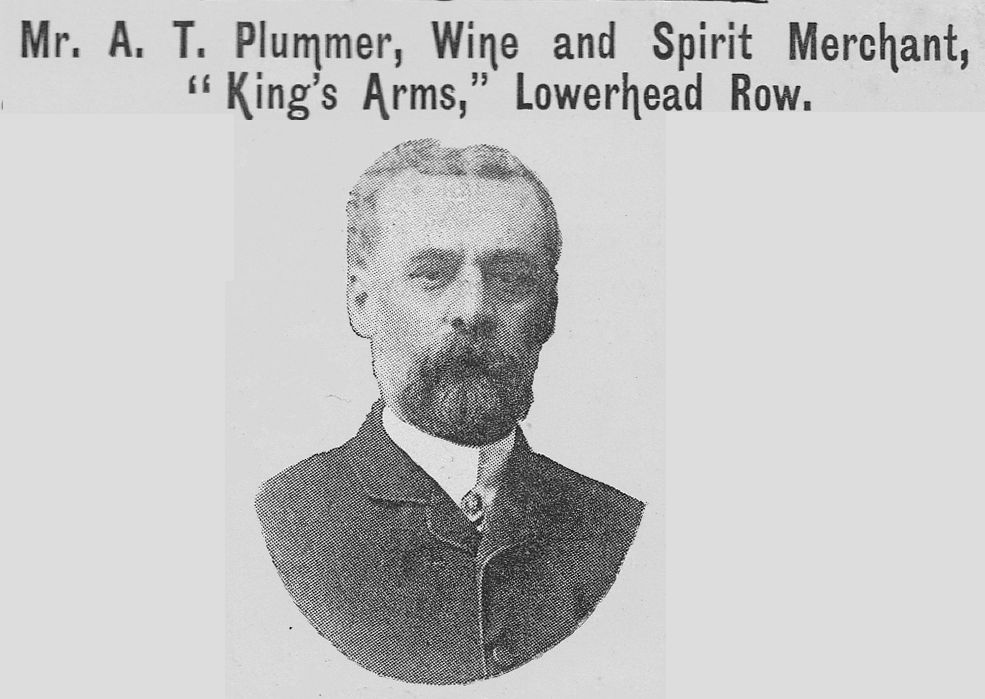
One of, if not the oldest, hostelries in Leeds is the “King’s Arms,” which appears to have been built by one Crosby, a Leeds man, whom Charles II. made chief bailiff in Yorkshire shortly after his succession to the throne — and doubtless so christened in honour of that sovereign. Being well-situated, just out of the Briggate, the chief thoroughfare of the town, the house rapidly sprung into notoriety and importance. Having large stables and yards, accommodation was available for almost any number of packhorses and fly-waggons, and hand-bills are still in existence announcing the departure of sundry of those heavy vehicles, which, “God willing,” would make the journey from Leeds to London, “with passengers and merchandise,” in fourteen days.
About 1740 the roads around Leeds, and particularly London-wards, were considerably improved, Pikes being erected to defray the cost, and from this period the present-day history of the “King’s Arms” dates. In 1750 riots occurred consequent upon these pikes, and the rioters who were arrested were brought to the “King’s Arms,” where the Borough Magistrates were assembled. The mob assailed the house, the military were called out, and 37 were killed and wounded, a military guard being afterwards stationed at the “King’s Arms,” the Mayor’s, and Recorder’s houses for weeks afterwards. Eleven years later we find the following announcement: “Safe and expeditious travelling, with machines on steel springs, in four days, to London, from the old “King’s Arms,” in Leeds, every Monday and Wednesday. These were the first coaches seen in the town, and the importance of this Inn may be gathered from the fact of their starting from its portals. In 1768 we find that two coaches ran from the “King’s Arms” to the “Saracen’s Head,” London, in two days and a-half, and in 1791 a coach was advertised to run the distance in thirty-nine hours. Although other houses came into opposition, this one always held the leading position until coaches were replaced by the rail, and the old “King’s Arms,” oft-times re-built, has never ceased to share in the growing prosperity and importance of the town, and is not likely to forfeit any of its ancient prestige under the management of Mr. A. T. Plummer.
THE LEEDS COMPRESSED AIR CARPET CLEANING CO., LTD.
23, Grace Street (Telephone, No. 410.)
Managing Director: Mr. Charles Thorpe.
The above business was founded by Mr. Charles Thorpe 11 years ago, and formed into a limited liability company about two years since; Mr. Thorpe holding the responsible position of managing director. This gentleman has had a long experience in carpet cleaning, and being familiar with all the various kinds of machines at present in use, is fully competent to speak as to their respective merits. Mr. Thorpe is exclusively in favour of the “Warsop” pneumatic carpet-cleaning machine, which is used by his company, as, in his opinion, it is the only machine which can efficiently extract the dust and dirt without injury to the material. By means of this patent, compressed air machinery, carpets, curtains, wool and skin mats of all descriptions are cleaned and freed perfectly from dust and dirt without the slightest risk of damage of any kind; the dust, in fact, being blown out of the carpet, taken away through a shaft by a “Blackman” air-propeller, or fan, and emptied into the boiler flues and consumed.
Whilst able to clean in a manner superior to any other system the thickest Turkey or Axminster carpet, the process is equally applicable to materials of the finest texture, damask curtains, etc., which can be passed through the machine without any fear of damage. No beating or shaking of any kind is necessary by the “Warsop” process, and as each carpet is passed through the machine separately, and cleaned entirely by the application of pure air, the sanitary advantages attaching to this system are obvious.
Previous to the Company taking over the concern, the work used to be done by the old-fashioned method of shaking and beating, but they at once discarded the old machines, and entirely equipped the works with the new “Warsop” compressed air machines, at an expenditure of over £2,000, besides paying £1,250 for the patent right of the machines for a radius of 25 miles from the Leeds Town Hall, so that these are the only works of the kind within that distance, in fact, there are none of the machines in use nearer Leeds than Manchester. In addition to the above outlay the Company expended a large sum of money in altering and adapting the premises; which extend right through from Grace Street to Somers Street, Park Lane, with an office entrance in the former thoroughfare, and goods entrance in the latter. The whole three-storied building belongs to the Company, but as they require only the ground-floor, which is 150 ft. long by 62 ft. broad, they sub-let the two upper floors.
In the engine-house, which is near the Somers Street entrance, there is a 75-h.p, horizontal engine, with a driving wheel 9 in. broad and 9 ft. in diameter; here also is an air pump worked at a pressure of 60 lbs. to the inch, the air being pumped into two large receivers or shell boilers, 26 ft. by 6ft 6in. diameter each. The cleaning of carpets is undertaken at the shortest notice, a letter to the works ensuring prompt attention; and all goods are collected and delivered at the Company’s expense. We would recommend a visit to the works of the Leeds Compressed Air Carpet Cleaning Company, Limited, 23, Grace Street, Mr. Charles Thorpe being always pleased to explain to visitors the working of the methods adopted by the Company.
MR. SAMUEL HIRST, WHOLESALE AND RETAIL GLASS MERCHANT, ETC.,
“The Crystal Palace,” 4, 5 and 6, Mill Hill.
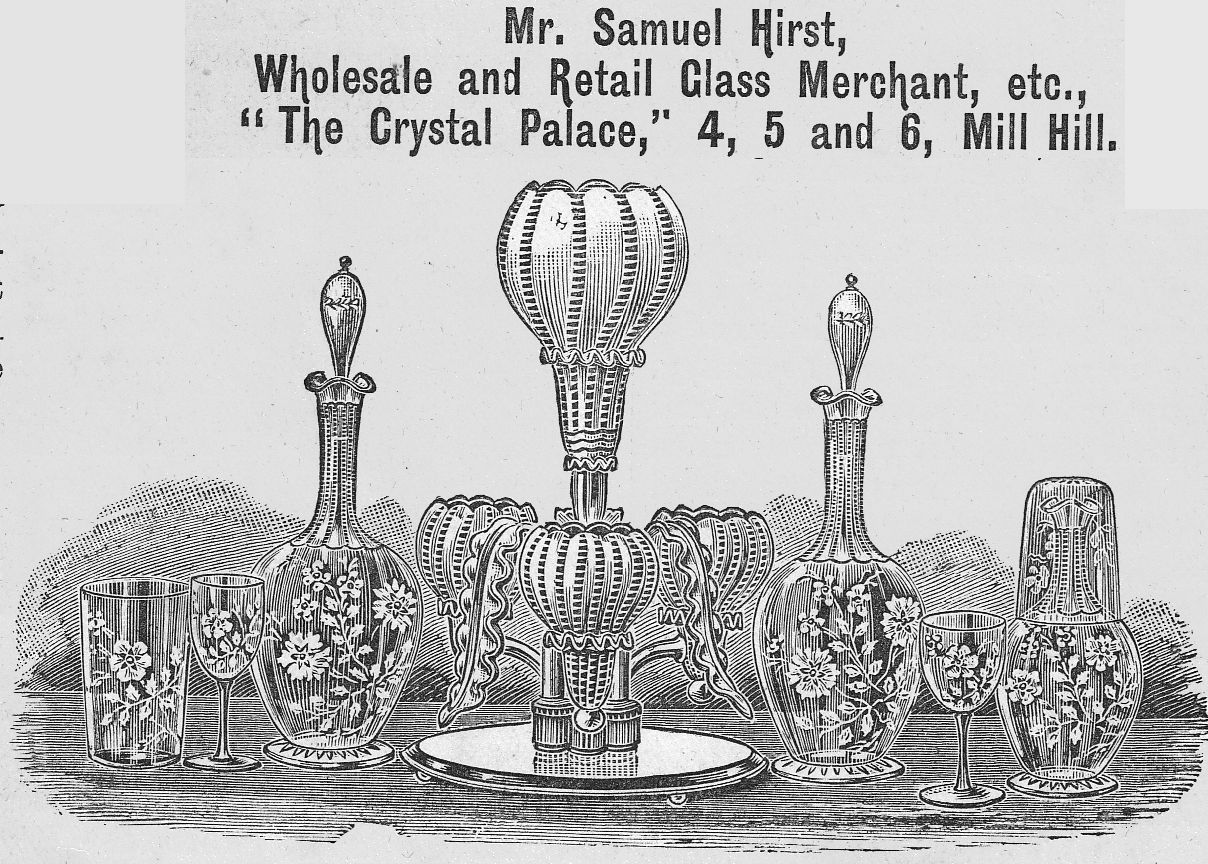
Without making invidious comparisons, we may remark that the business conducted by Mr. Samuel Hirst, at 4, 5 and 6, Mill Hill, Leeds, is unexcelled by any similar establishment in the town. It was founded in 1868 and is carried on in a large three-storied building, the shop, or warehouse, being double-fronted, and the exterior of the premises very suitably decorated. On the ground-floor are the offices, store-rooms, etc., with the yard and stables at the rear. On the first-floor is another office, a large show-room for every description of glass-ware, and at the rear several other store-rooms, and the engraving room. Here a very skilful designer and engraver is at work with his engraving lathe, etc., and many of the firm’s most beautiful designs originate from this department. There are, in all, on this floor seven rooms, and these are principally stocked with a large and varied assortment of glassware of both home and foreign manufacture. On the top floor there are five other stockrooms, and a spacious case-room, where a very great number of cases of glassware are unpacked every week. In the centre of the building is fitted a hoist running from top to bottom.
There are about 18 rooms in the building, and the contents of these include cut and engraved decanters, wine glasses, tumblers; gas globes of all shapes, sizes, patterns, and colours, and many varieties of ornamental glassware. Mr. Hirst, however, makes a speciality of engraving, and does a large business in all kinds of engraved glass. He keeps a very large stock of claret, Champagne, liqueur glasses, &c., gas bell-shades, flower-stands, cake-stands, baskets, and every domestic and business requirement. We might remark that confectioners especially, will find an immense variety of goods expressly adapted to their trade, at this establishment. Mr. Hirst is also sole agent for Leeds for an extensive glass bottle factory, called “The Crown Bottle Works,” at Hunslet, a few miles outside Leeds, the property of Mr. William Brooke. This business was established as far back as 1800, and is still a thriving concern, over 200 hands being employed there.